[Moderator's note: We have been a bit remiss at splitting this off into a new thread for 2012, but here it is, finally!
Lori]
A mix of things flowering or looking interesting in the garden at the moment. The garden is waking up with hellebores and many bulbs soon to come.
Narcissus panizzianus grown from Archibald seed. The flowers are small but always very early.
Muscari pseudomuscari, ditto. This is a lovely tidy species, growing here with a selection of Cyclamen hederifolium.
Cyclamen coum. Two forms with very silvered leaves from Tilebarn Nursery.
Corydalis quantmeyeriana 'Chocolate Stars' growing with cyclamen and Astelia nervosa. The corydalis is new to me and I haven't yet seen the flowers, but what foliage! I rather like this combination.
Sarcococca confusa. An unassuming shrub but one of the most delightful and scented winter flowers, and usefully tolerant of dry shade.
Comments
What do you see on your garden walks? 2012
OMG, that superb clump of cyclamen coum, WOW, those leaves are drop-dead gorgeous.
And Rick, I'm glad you provided the link and called attention to the Corydalis leaves; I had come to the same conclusion that I was seeing dew droplets. What an unusual and attractive Corydalis. Tim: not fair you have all this going on now!
What do you see on your garden walks? 2012
A mix of things flowering or looking interesting in the garden at the moment. The garden is waking up with hellebores and many bulbs soon to come.
Narcissus panizzianus grown from Archibald seed. The flowers are small but always very early.
Muscari pseudomuscari, ditto. This is a lovely tidy species, growing here with a selection of Cyclamen hederifolium.
Cyclamen coum. Two forms with very silvered leaves from Tilebarn Nursery.
Corydalis quantmeyeriana 'Chocolate Stars' growing with cyclamen and Astelia nervosa. The corydalis is new to me and I haven't yet seen the flowers, but what foliage! I rather like this combination.
Sarcococca confusa. An unassuming shrub but one of the most delightful and scented winter flowers, and usefully tolerant of dry shade.
nice to see the flowers, but especially like the Cyclamen leaves!
What do you see on your garden walks? 2012
I like all those plants! But if I could get only one and had to choose, I had chosen the Corydalis, no doubt! I have a soft spot for that genus! However, love Cyclamen too - a hard choice :-\
I had hoped that our mild weather should continue but no luck. Today is our first day this winter with temperature below 0oC all day and night. And more is to come :( The forecast says down to -10oC during the week :o >:( and almost no snow :'(
What do you see on your garden walks? 2012
A mix of things flowering or looking interesting in the garden at the moment. The garden is waking up with hellebores and many bulbs soon to come.
Cyclamen hederifolium[/i].
Cyclamen coum. Two forms with very silvered leaves from Tilebarn Nursery.
Holy crow!! Those Cyclamen are gorgeous!! :o :o :o
Would you consider trading Cyclamen seed for Primula seed?? Please oh please? ;D
What do you see on your garden walks? 2012
Cyclamen coum. Two forms with very silvered leaves from Tilebarn Nursery.
:o Tim - those are some very stunning cyclamen coum. Very unfortunate Tile Barn Nursery has closed.
Like Amy, I'd be willing to trade for some seed.
Julie
What do you see on your garden walks? 2012
Beautiful, Tim, and always a shock to see plants in bloom in the "middle of winter"! ;) ;D
I see that Corydalis quantmeyerana 'Chocolate Stars' is available again this year from Fraser's Thimble Farms. I bought it a couple of years ago from them but had no success with wintering over... actually, I'm not even sure if it survived the summer. Your photo is a powerful temptation to try it again!
What do you see on your garden walks? 2012
I missed the Cory first time round, till Trond mentioned it (with my dodgy internet connection, I don't always enlarge all the pics) but it is very cool-- always love non-green foliage :)
What do you see on your garden walks? 2012
A belated Happy New Year everyone as I catch up with posting some pre-Christmas pics.
First up, Erythronium 'Ruapuna Dawn', a revolutum hybrid raised by Joan Whillans in New Zealand, and thought to be the same parentage as Ian Young's 'Craigton Cover Girl'.
Next a clump of seed-raised Lilium mackliniae . One plant has flowers with a dark red eye so I'm hoping to get some seed from that.
I've always had a soft spot for buttercups, and Ranunculus parnassifolius does well for me in a polystyrene trough. It seems to need lots of sun and lots of water though to stop it getting long and leggy.
Then a plant I used to cossett in a pot in the UK but which grows and spreads happily outdoors here under a dogwood bush, the Canadian bloodroot Sanguinaria canadensis 'Multiplex'. Many years ago when I first got my hands on this plant, I was told not to be frightened of chopping it up and moving it around, even "arranging" nice little noses in a clean pot to take to a show a couple of weeks away. Just ignore it bleeding red sap, it's tougher than it looks, and the foliage is pretty too.
What do you see on your garden walks? 2012
Doreen - that Sanguinaria is spectacular! We used to have a group nearly as good but I have not kept it going. I think regular division is the answer. i have the single version which seeds around but never makes clumps like this.
What do you see on your garden walks? 2012
Doreen your photos are so wonderful to see on this cold and slightly snowy day! I woke up to just a dusting and we need so much more on the ground here!!
You're right about the Sanguinaria...I wacked up a patch at work last fall and potted the pieces for sale this spring! So easy!
Here is a photo of a patch of the single flowered form at the end of my road last spring! It's huge and interspersed with Trillium erectum although you can't see them. :P
What do you see on your garden walks? 2012
Super images everyone ... Happy New Year Doreen.
What do you see on your garden walks? 2012
Wonderful images of excellently grown plants, Doreen!
The way Amy shows wild Sanguinaria canadensis growing is the same way they colonize here in Minnesota. Larger single clonal clumping is not rare, but one to three noses per plant is the norm. However, these same plants grown in a garden setting would likely have a great propensity to form large clumps.
What do you see on your garden walks? 2012
Doreen, now I know what to aim for! My plants never grow like that :(
Amy, interesting to see how the bloodroot grows naturally. My second goal is to copy that in a patch in my woodland!
Does the bloodroot need another clone to set fertile seed?
What do you see on your garden walks? 2012
Great flowers, Doreen- the Ranunculus is lovely..
Amy- love the patch of Sanguinaria.. this is another one I'd love to establish here (its not native) I could give it a nice place to spread out like the patch you show .. haven't got any yet (on the list...lol)
What do you see on your garden walks? 2012
When these set the copious amounts of seed they always do....I'll let you know and perhaps we can do some swapping! ;)
I don't know if you need two clones for pollination...but everywhere I have planted them they always set lots of seed. I have to get in early to clip off the seed pods, otherwise they would take over large areas of my garden...and I don't have the space to let them go. But I love the look so I keep them in check and let smallish patches spread.
Here's a close-up of the Bloodroot and of the Trillium erectum growing in the same area.....
What do you see on your garden walks? 2012
Fantastic pictures Doreen. Thanks for posting.
In general garden alpines do not look as good as wild plants. However I have seen Ranunculus parnassifoliuis growing wild in the Pyrenees and it did not look as gorgeous as your garden plant.
What do you see on your garden walks? 2012
Glad to have brightened up your wintry days up in the northern hemisphere! Thanks for all your kind comments.
Amy: lovely to see your pictures of the bloodroot growing wild. Glad I'm not the only one carving up my plants!
Did anyone see Hilary Birks' photo of a stunning ribbon of the single form growing in immaculate condition in her garden in Bergen, Norway, on the UK AGS on-line show that just ended in December? Well worth a look.
Trond: I had just one plant of the single form in my garden 3 or 4 years ago but lost killed it. But just this spring I noticed three or four little seedlings had popped up where the parent had been, so it looks as if it's self-fertile, at least to some degree.
David: I agree with you about cultivated plants generally being poor imitations of the wild plant. Would love to see the ranunculus in the wild (especially the Nuria form) and if a few seeds might happen to drop into my pocket ... ;)
What do you see on your garden walks? 2012
Wow! I'm just joining the chorus of admiration for your plants, Doreen! It seems that growing in rock garden conditions really brings out the best for Ranunculus parnassifolius... I must remember to move some seedlings into similar conditions!!
How wonderful to have a woodland full of bloodroot and trillium, Amy! It's lovely!
What do you see on your garden walks? 2012
Eight Candles - Sanguinaria canadensis
If it looks like an old photograph, it is! Scanned from 1980.
What do you see on your garden walks? 2012
Eight Candles - Sanguinaria canadensis
If it looks like an old photograph, it is! Scanned from 1980.
Rick, same alluring attitude as 32 years ago!
What do you see on your garden walks? 2012
Rick, it just looks like you've intentionally done an artistic soft-focus sepia portrait! Love the clasping leaves.
What do you see on your garden walks? 2012
We've had a couple dreary winter foggy days in this snowless winter, and the frost is beginning to build. Leaving some of the perennials intact through the winter has proven to a wise decision this year.
Chasmanthium latifolium (Northern Sea Oats) has much of its seedheads still intact.
Allium thunbergii 'Ozawa' and Eryngium amethystinum (Amethyst Sea Holly)
Symphiotrichium(Aster) sericeum (Silky Aster) with Melica ciliata (Silky Spike Melic) and Silky Aster close up
What do you see on your garden walks? 2012
Needles of Pinus pondersosa (Ponderosa Pine) and Pinus strobus 'Wintergold' (Wintergold White Pine)
Our wild Juniperus virginiana (Eastern Red Cedar)
Picea asperata (Chinese Dragon Spruce)
What do you see on your garden walks? 2012
Lots of great winter texture and colour, Rick! We have had very little frost this winter compared to the last few- not an especially photogenic winter- the last few I took a lot more photos..
What do you see on your garden walks? 2012
Very nice, Rick! Does the foliage on the bamboo survive the winter?
What do you see on your garden walks? 2012
Very nice, Rick! Does the foliage on the bamboo survive the winter?
It survives the winter fine. It's the early spring that does them in. I usually remove about half of the foliage before serious growth commences. Since we are having such a mild winter, maybe the ground will thaw fast enough to not have this problem this season. (It has only dipped below zero (-18C) for three nights this season!).
What do you see on your garden walks? 2012
Well, I'm amazed enough that the bamboo survives the winter, let alone the above-ground parts! Must try that one someday, if I come across it.
What do you see on your garden walks? 2012
There was no cultivar name attached when I bought Fargesia rufa in Madison, WI as a large plant, bulging the #5 pot (about 4 gal. size). I divided it into three parts, two of them kept whole, and the third further divided. The two did great. Any division less than six culms, died. My advice: don't divide any less than ten culms.
Fargesia rufa seems to do far better than F. nitida for me. I had F. nitida for 5-6 years, and it poked along, never getting bigger or smaller. Then the year when all the F. nitidas in the world bloomed (mine tried to, too), it didn't last through the following winter.
What do you see on your garden walks? 2012
Nice pics, Rick! Not much to picture here now except some colourful birds at the feeders.
I still get seedlings popping up from that F. nitida bloom! Seems to be seeds in the soil still where I had those shrubs. The first seedlings that germinated are still not as big as their parents were at blooming time but are cathing up fast.
What do you see on your garden walks? 2012
Nice pics, Rick! Not much to picture here now except some colourful birds at the feeders.
Same here! It's 15*f this morning with no snow cover!
Here is a pic I took a couple days ago of what was a nice big Primula marginata 'Linda Pope'! :-[
The squirrels have been breeding like mad and we are overrun! So far this is the only one that has been
destroyed like this....keeping fingers crossed, but don't hold out much hope for the rest! :(
What do you see on your garden walks? 2012
Same here! It's 15*f this morning with no snow cover!
Here is a pic I took a couple days ago of what was a nice big Primula marginata 'Linda Pope'! :-[
The squirrels have been breeding like mad and we are overrun! So far this is the only one that has been
destroyed like this....keeping fingers crossed, but don't hold out much hope for the rest! :(
Oh Amy, that's heartbreaking, those dang squirrels :(. We're in a similar situation here, cold, the ground mostly open and without snowcover, and the squirrels are still having a field day with their infernal digging. For a couple items that I planted out last fall, for which I was worried about squirrel mischief because they seem attracted to freshly dug areas, I covered the resting plants with open wire mesh, just laid on the ground.
What do you see on your garden walks? 2012
Sorry to hear aboutthe damage, Amy!
Fortunately no problems with squirrels here, and neither with the slugs at this time! -1/2 C today and southeasterly wind with loads of snow. Tomorrow they say we'll get +4C and rain and then cold again! I would rather have the snow for a couple of weeks more though.
What do you see on your garden walks? 2012
Oh Amy, that's heartbreaking, those dang squirrels :(. We're in a similar situation here, cold, the ground mostly open and without snowcover, and the squirrels are still having a field day with their infernal digging. For a couple items that I planted out last fall, for which I was worried about squirrel mischief because they seem attracted to freshly dug areas, I covered the resting plants with open wire mesh, just laid on the ground.
Thanks for the commiseration you guys! :P
Mark..I'm thinking of using more ree-may to cover plants in the gardens that routinely get some form of squirrel damage. I use it all winter & spring to cover flats of seedlings and young potted plants and so far has worked very well. I do also use hardware cloth on the larger crates of plants, esp. the more valuable ones....Trillium!!
What do you see on your garden walks? 2012
Working from home today, I walked the garden on this mild winter day reaching 46 F (8 C), the ground still solidy frozen. On the warm sunny south side of my house, the top couple of inches of soil are frost-free, this marks the earliest flowering ever of Galanthus and a single precocious bloom on Colchicum kesselringii.
An almost snowless winter thus far, supposed to get a mere 2-3" tomorrow, followed by sunny deep freeze.
What do you see on your garden walks? 2012
Those sweet and delicate looking snowdrops are so amazingly tough!! They look wonderful to this color starved gardener!! :P
What do you see on your garden walks? 2012
Nice, Mark! My snowdrops are still covered by 10cm of hardcrusted snow but the forecast says mild weather this weekend and next week. Maybe I can see my snowdrops and crocuses when I return from England next Saturday!
What do you see on your garden walks? 2012
Very nice to see, Mark. :) They were looking like that over here too, before we went into deep-freeze :-\
What do you see on your garden walks? 2012
Wonderful to see Colchicum kesselringii Mark .I germinated some seed of this last year and a check of the pot tonight confirms i haven't lost them .... ;D
Here's Campanula thyrsoides -- noticed it had a wonderful scent as i was in close taking a macro shot.(I've edited the pics using a vignette setting as an experiment).
Cheers Dave.
What do you see on your garden walks? 2012
Nice vignettes Dave! Such a fascinating Campanula, I like those types that defy our normal impression of a genus and manifest themselves in such whimsical ways. And scented too, not so many campanulas are noticeably scented, that's an added perk.
I'm sure my single precocious Colchicum flower will be toast after our weather has gone back into some deep freezing, but many more flowers should appear when it is safer to do so.
What do you see on your garden walks? 2012
I've never noticed a scent from Campanula thyrsoides - is it the dry air here or my lack of attention? ??? I'll have to take notice this summer!
What do you see on your garden walks? 2012
The first Frit is in flower in the greenhouse; Fritillaria pudica - one of our natives. Another almost native, Douglasia nivalis from the Wenatchee Mountains, is in flower in the Alpine Shed.
What do you see on your garden walks? 2012
Just went out and sniffed Campanula thyrsoides again --i'd call it a citrus scent .Yummy :)
Nice pics David --while repotting bulbs recently i see i'm just left with a swarm of F.pudica babies --no trace of the flowering sized bulb that bloomed the last two years :-\...
Cheers Dave..
What do you see on your garden walks? 2012
Just went out and sniffed Campanula thyrsoides again --i'd call it a citrus scent .Yummy :)
Nice pics David --while repotting bulbs recently i see i'm just left with a swarm of F.pudica babies --no trace of the flowering sized bulb that bloomed the last two years :-\...
Cheers Dave..
The very first thing I do with any flowering plant, is take a whiff, for me it is one of the primary aspects of gardening.
What do you see on your garden walks? 2012
The very first thing I do with any flowering plant, is take a whiff, for me it is one of the primary aspects of gardening.
Alas my nose doesn't always detect what other people do. Gardenias, for instance, have no smell for me! I do smell things other people can't, though. I have a friend with a particularly good sniffer, and sincerely loves to smell flowers, etc. When she comes over, I take good note of her "experiences" as we walk the yard.
What do you see on your garden walks? 2012
Around the garden this week we have the first of the Belladonnas, Amaryllis belladonna - most likely a hybrid - in a cerise/deep pink form
Lycoris sprengeri
and Lycoris incarnata
We can't grow Gaultherias but the berries on this Eremophila debilis almost make up for it!
cheers
fermi
What do you see on your garden walks? 2012
We can't grow Gaultherias but the berries on this Eremophila debilis almost make up for it!
cheers
fermi
Fermi, you folks down under have some of the coolest plants ever, the fruits on that Eremophila are fetching!!! Never heard of Eremophila, so looked it up, what a suprise, a large and colorful genus (beautiful flowers too), all endemic to Australia. Here are some highlights:
Eremophila, Emu Bush, Poverty Bush or Fuchsia, 215 recognised species, all of which are endemic to Australia.
http://en.wikipedia.org/wiki/Eremophila_(plant)
The genus name Eremophila is derived from the Greek words eremos (desert) and phileo (love), alluding to the species' adaptation to arid environments.
E. subfloccosa
http://www.anbg.gov.au/gnp/interns-2006/eremophila-subfloccosa-pl-700.jpg
What do you see on your garden walks? 2012
The very first thing I do with any flowering plant, is take a whiff, for me it is one of the primary aspects of gardening.
Alas my nose doesn't always detect what other people do. Gardenias, for instance, have no smell for me! I do smell things other people can't, though. I have a friend with a particularly good sniffer, and sincerely loves to smell flowers, etc. When she comes over, I take good note of her "experiences" as we walk the yard.
I'm one of those people with a particularly good sniffer :) When visiting gardens, I might point out how this or that plant is sweet smelling or aromatic in some way, often a complete surprise to the gardener who has grown the subject plant for years but hadn't yet bothered to check for scent. I guess I'm just a hand's-on and nose-on sort of gardener ;D. I have heard it said that woman have better sense of smell than men, not sure if that's urban legend or has any basis in fact.
But it's the aspect of scent that can actually influence my planting decisions. For example, I planted a clump of Aster pilosus at the base of my deck stair, grows to 4'-5' tall with myriad very late white blooms that waft an enticing scent of vanilla, reminiscent of sugar cookies baking.
http://nargs.org/smf/index.php?topic=159.msg1037#msg1037
What do you see on your garden walks? 2012
Fermi - nice to see those Lycoris flowering. I have a few that originated from Jack Elliott's greenhouse and which I have tried outside; they grow but have very rarely flowered, presumably lacking sufficient summer heat (even though they are against a south wall). I wonder if anyone has tried crossing them with nerines? They do have a wonderful range of colours.
What do you see on your garden walks? 2012
Not an impressive display yet, but I believe this is the earliest date in my garden that a crocus has opened a flower, in 25 years that I have been here; Crocus vitellinus showing its first flower on February 18, 2012. Always the first crocus to bloom, but typically not until March. The shiny strap foliage nearby is Sternbergia lutea, foliage always stay evergreen and in good shape through our winters, with or without snow.
Back to my precocious Colchicum kesselringii; the flower on the left is the same one I showed taken 8 days ago, it has narrow pointed petals, the one on the right is a different form with larger flowers and wider rounded petals, just showing up.
The nights have gone down as low at 10 F (-12 C), but these blooms seem unfazed, their early showing from a non-ending succession of very mild winter days, mostly sunny, into the mid 40s F, was 48 F yesterday. Still no snow, this might be a snowless winter, a rarity.
What do you see on your garden walks? 2012
Nice, Mark! It is always a pleasure to welcome the first crocus in spring!
Just come back from England early this morning (about 1 AM) to a very wet but snowfree garden (been on job, no holiday and no time to visit gardens :( ).
Rain all day and although the garden is full of flowering snowdrops, crocuses and spring snowflakes they do not open fully in the rain and I didn't bother taking pictures. Also the mahonias and witch hazels are in bloom.
Sadly no rest however, as we set out for Oslo early tomorrow!
What do you see on your garden walks? 2012
Mark,
glad you like the Eremophilas, they are a very varied clan.
Not in our garden, but not far away in a vacant block is a great flowering of the South African Amaryllis belladonna,
cheers
fermi
What do you see on your garden walks? 2012
Mark,
glad you like the Eremophilas, they are a very varied clan.
Not in our garden, but not far away in a vacant block is a great flowering of the South African Amaryllis belladonna,cheers
fermi
Ah, to have such lovely weeds!
What do you see on your garden walks? 2012
It looks like we may actually get some winter this coming week. I guess this would be the start of it: last night about 3 inches or so of wet snow.
Unlike many (most?) Euonymus, this one holds its fruit all winter.
Euonomys bungeana 'Pink Lady'
Thuja occidentalis 'Pumila Sudworth' on the left, and Pinus ponderosa. The Ponderosa pine is from the Black Hills disjunct population's seed.
The Wintergold White pine (Pinus strobus 'Wintergold') continues to delight.
What do you see on your garden walks? 2012
Neither Carex nigra (Black Sedge) or Fibigia clypeata have been discovered by birds...yet.
The Amur chokecherry (Prunus maackii) displays well against the white background.
The Chinese Dragon spruce (Picea asperata) demonstrates its rubbery branches, only slightly weighted by small snowfall. Also shown is its normal summer habit for contrast.
What do you see on your garden walks? 2012
Nice to see the winter texture... I guess the moisture must be much needed..
What do you see on your garden walks? 2012
At home from the wintery mountain landscape (Rick, still winter at your place?)
- and back to spring! This morning was very promising although the temperature dropped barely into the freezing regime the sky was clear blue without any clouds. However it didn't last - when I went out to take some pictures the sun hid itself behind a thick layer of clouds suddenly appearing from nowhere. The weather has cleared a bit now some hours later but the sun is setting fast. The air is warmer too so no frost tonight.
Crocus tomasinianus is among the first bulbs to flower and almost as early as the snowdrops and snowflakes.
C baytopiorum is early too and a lot of others will follow soon - with a little more sun in the afternoon (my garden faces west).
What do you see on your garden walks? 2012
Beautiful pictures, Trond! (It would be nice to experience one of those zone 8 "winters" ;D ;D - quite a difference from here where we are again under a fresh snowfall!) The blue crocus is really special. I guess I need to start trying some bulbs from seed, as it doesn't seem that bulbs are very available around here for anything but the mass-produced crocus varieties. How long ago did you start planting?
What do you see on your garden walks? 2012
Beautiful pictures, Trond! (And you keep trying to convince us that you live in a place that has real winters... ppffftt! ;D ;D) The blue crocus is really special. I guess I need to start trying some bulbs from seed, as it doesn't seem that bulbs are very available around here for anything but the mass-produced crocus varieties. How long ago did you start planting?
Lori, thank you! The pictures aren't quite good - my camera has a damaged lens. A new lens costs the same as a new camera :-\
I started planting when I bought this property about 25 years ago but the C tomasinianus has really started spreading the last few years. Now I get 1000 new seedlings every year. If want to try sowing I can collect seeds.
The special blue one is C baytopiorum. Haven't seen seedlings of it yet.
What do you see on your garden walks? 2012
Really nice, Trond! I like the image of the Galanthus, especially.. great to see those swathes of flowers.. as Lori mentioned, all white here, about 15cm of new snow at leastin the last day and a half (and a few recent snowfalls before that), and I'm not sure its done yet, though sun is out a bit.. high of -12 for today, -27C tonight, -20's next couple of nights, though temps will go up (and down, and up) after today.. spring is still a distant idea...
Are these Crocus patches in your woodland? How much sun do they get and what grows there later?
What do you see on your garden walks? 2012
(Rick, still winter at your place?)
The snow that fell to make my last pretty photos is half gone. A week ago they were predicting a 6 inch snowfall for today, then the "storm" was downgraded, and downgraded, and downgraded. Today we receive a trace of precipitation. :( More snow is in line for Tuesday-Wednesday, 6-10 inches, but I am not holding my breath. We have been in a drought since the first of September.
Trond, you do have nice crocus lawns! I remember admiring them last season, too.
What do you see on your garden walks? 2012
Thanks, Rick!
Really nice, Trond! I like the image of the Galanthus, especially.. great to see those swathes of flowers.. as Lori mentioned, all white here, about 15cm of new snow at leastin the last day and a half (and a few recent snowfalls before that), and I'm not sure its done yet, though sun is out a bit.. high of -12 for today, -27C tonight, -20's next couple of nights, though temps will go up (and down, and up) after today.. spring is still a distant idea...
Are these Crocus patches in your woodland? How much sun do they get and what grows there later?
Cohan, you can call it patches in the woodland! Actually it is my one and only lawn situated between the "woods" and shrubbery at the forest edges. It is a very steep bank and difficult to mow anyway. From late February the spot gets some sunshine in the afternoon just before the sun sets. Later it has more direct sun from about 2PM till sunset. Crocus tomasinianus seems very shade tolerant and I find flowering specimens all over the place, even in dense shade beneath shrubs and on the north side of the house. I believe the seeds are transported by ants as the seedlings pop up in crevices a long way from the source.
Later it is some grass growing there in between the weeds ;) I don't mow till all the bulb leaves are wilted.
What do you see on your garden walks? 2012
Tks, Trond, I'll have to try to keep that species in mind if it's shade tolerant.. my full sun spots are limited and have a lot of things to compete for them... I have lots of part day sun areas...
What do you see on your garden walks? 2012
Here are some of the colour forms of Crocus tommasinianus (and some others hiding between them - all are selfseeded here). Nice sun here today, had coffee in the garden after dinner ;D
What do you see on your garden walks? 2012
Great looking crocus explosion there Trond! Nice to have so many lovely clumps of Crocus seeding around and naturalizing in the garden.
After January-February being virtually snowless here, and unusually mild too, several crocus species started to flower mid February, including chrysanthus cultivars, the earliest bloom ever in my garden after 25 years. But with the arrival of March, snow also arrived, nearly a foot of snow yesterday, couple more inches heavy wet snow and ice last night.
What do you see on your garden walks? 2012
Nice range of colours in those Crocuses, Trond.
Mark, the snow may not be so good for the Crocuses, but I bet its good for moisture levels...
What do you see on your garden walks? 2012
No crocus here, unless you buy a pot at the florist!
Philadelphus- almost as much white as when its in full bloom... one plus: twigs don't seem to be juicey enough to tempt moose...
unlike the apples and crabs- pruned by me a couple years back, then the new growth has been eaten by moose ever since-- guess next year will need some wire or net...
Garden would be a strong word here- looking from the edge of the woods, toward the 'yard' open areas in view are mowed in summer, some planted shrubs etc, other shrubs and trees wild natives...
What do you see on your garden walks? 2012
Philadelphus- ... one plus: twigs don't seem to be juicey enough to tempt moose...
Never thought about that before, but now that you say it, Cohan, those twigs are one of the driest and seemingly least nutritious. They certainly would have me gagging (!)
What do you see on your garden walks? 2012
Philadelphus- ... one plus: twigs don't seem to be juicey enough to tempt moose...
Never thought about that before, but now that you say it, Cohan, those twigs are one of the driest and seemingly least nutritious. They certainly would have me gagging (!)
I hadn't thought about it either till I saw them completely untouched right next to the apples stripped right back to woody branches! Also noticed one of our wild saskatoons (Amelanchier alnifolius) another moose/deer fave- there is one that's really a kind of bonsai- about 6-7 feet tall, with no branches more than a foot away from the stem.... they have to be able to get some height when they can, and then tall stems can grow freely, but lower stuff all gets heavily pruned...
What do you see on your garden walks? 2012
I am sure any fruit wood will have an irresistible fragrance. Anything belonging to Hamamelidaceae is a perennial favorite, too. The American witchhazel is very rare in Minnesota and I have been to one of the colonies. They are all "ancient" plants there, at least 30-40 years old with aged multiple trunks 2-4 inches in diameter. Every plant desperately resprouts from the base each year, only to be feasted upon by deer. And no wonder that there is no regeneration.
What do you see on your garden walks? 2012
No witchazels here ( I may have seeds in somewhere, no seedlings though, I don't think...) any Rosaceae without thorns is fair game (our discussion of Sorbus somewhere on the forum...) but willows and poplars are also very popular, probably the small birches and alders as well-- the moose spend more time in those wet shrublands than anything, around here... the open woods are also full of tall poplar saplings which are broken at 7-9feet (maybe less?I'd have to pay attention) where the moose have purposely broken them so they can reach the tender branch tips which are only near the top..
Generally its not a problem, especially for the native shrubs and trees-- there are abundant semi/natural areas, so numbers of native shrubs are high enough they are not that adversely affected (i.e. they can flower and fruit, though not get as tall as they might! browsing is mostly in winter), though exotics may not be as well adapted (apples!)..
I visited a natural area to the west of here, and noticed all the Amelanchier and some other things were browsed to just a couple of feet above the ground...
What do you see on your garden walks? 2012
Rain during the last week has brought about another explosion of Habranthus and Zephyranthes and spurred on more Lycoris!
Zephyranthes "Grandjax"
cheers
fermi
What do you see on your garden walks? 2012
We have just put a fence around the garden to keep the dog in and the rabbits out, but oh I would have real problems if we had moose around (!), the garden is full of fruit trees, let alone all the other woody plants it sounds they love. I know a few people who have trouble with deer, and such wildlife must have a big impact on how the garden can develop. (When we were infested with rabbits I did a detailed survey day by day of their activities, which curiously enabled me to tolerate them somewhat better!).
To provide a little spring cheer, the bright Eranthis 'Guinea Gold'. This sterile so one doesn't get the widespread drifts of the species which can seed very well in favoured gardens.
What do you see on your garden walks? 2012
Like the Zephyranthes Fermi - only candida is really hardy here - and the Rhodophiala is very nice and free flowering; I hope my plant will do this in the summer.
What do you see on your garden walks? 2012
We have just put a fence around the garden to keep the dog in and the rabbits out
6 months ago I put up a rabbit fence which needed 400m of rabbit netting . I built it around a rabbit and it's still in here despite my best efforts .
What do you see on your garden walks? 2012
Oh I love it! They really are pesky creatures. A few years ago I found a nest (if that's the right word) of tiny rabbits in a large pile of shreddings, so I hope you only have the one in the garden!
What do you see on your garden walks? 2012
I find a nest in my yard most years. Fortunately, I have always discover them before the babies get too big to catch. Rabbits love witchhazel too, and the really love sassafras.
Jandals, have you tried a cut apple to bait them?
What do you see on your garden walks? 2012
Nice flowers, Fermi and Tim!
Still growing only snowbanks here! ( http://nargs.org/smf/index.php?topic=930.msg15658#msg15658 )
Here's the mock orange/Philadelphus again.... amazing how much snow those thin branches can hold! followed by Lilac/Syringa and an apple/Malus
What do you see on your garden walks? 2012
Nice flowers, Fermi and Tim!
Still growing only snowbanks here! ( http://nargs.org/smf/index.php?topic=930.msg15658#msg15658 )
Here's the mock orange/Philadelphus again.... amazing how much snow those thin branches can hold! followed by Lilac/Syringa and an apple/Malus
Amazing, Cohan,
reminds me of the soap suds scene from "The Party"!
cheers
fermi
What do you see on your garden walks? 2012
I'm glad to say I have no rabbits! (The slugs are out BTW and have started destroying some of the early plants >:( )
At my mountain cabin we have European elks (and some stray sheep) and at my summerhouse we have deer and sheep. Small rodents are everywhere of course.
It's as you say, Cohan, the Philadelphus is never scratched by any critter nor broken by heavy snow!
Nice bulbs, jandals Fermi! I'm sorry I can't grow them outside here - I assume. . . . .
What do you see on your garden walks? 2012
Jandals, have you tried a cut apple to bait them?
Not yet Rick but I will do when all the seeds are done . Winter is the best time to try food based traps . Will keep you updated and thanks for the tip
Trond - It's Fermi who grows all the lovely bulbs but I know that you knew that
What do you see on your garden walks? 2012
Jandals, have you tried a cut apple to bait them?
Not yet Rick but I will do when all the seeds are done . Winter is the best time to try food based traps . Will keep you updated and thanks for the tip
Trond - It's Fermi who grows all the lovely bulbs but I know that you knew that
Oh yes, of course :-[ . . . I was a little too quick there, Steve!
What do you see on your garden walks? 2012
Nice flowers, Fermi and Tim!
Still growing only snowbanks here! ( http://nargs.org/smf/index.php?topic=930.msg15658#msg15658 )
Here's the mock orange/Philadelphus again.... amazing how much snow those thin branches can hold! followed by Lilac/Syringa and an apple/Malus
Amazing, Cohan,
reminds me of the soap suds scene from "The Party"!
cheers
fermi
True! though soap suds wouldn't be as heavy! Right now I feel like I'm living on a bob-sled site...lol plus the sun is out, so quite blinding!
What do you see on your garden walks? 2012
Some pictures from today's walk. It is mild but cloudy as it has been for several days now. On the other "side" of the country (along Oslofjorden) they have started planting salads and other vegetables outside now but farther north they still have snowstorms!
I have planted several forms of Corydalis solida in my woodland. The earlier have bloomed for some weeks now! The very first rhododendron is Rh dauricum(??). It set off in early February but was damaged by a spell of frost. Another early is Rh moupinense. I think the flowers unfurl tomorrow! Also Hepatica transsilvanica is in flower now. Thisone has a lot of flowers but they are far apart! One plant covers about 1 sq meter!
What do you see on your garden walks? 2012
Looking for signs of spring yesterday and this is what I found. Not much, but it keep my hopes up that most things have made it through this freakish winter!
1-Corydalis solida...a pale lavender one from a gardener in MA who sells divisions of her garden plants in her front yard to raise funds for local charities. Some of her plants are quite rare such as the double bloodroot, Trillium of all sorts and many others for extremely low prices! Needless to say I visit her yard every spring!
2-Cyclamen coum...From Brent & Becky's Bulbs in Virginia. Stopped by there last March on a nursery tour down the east coast. Their tubers are huge!!
3-Another C. coum from the 2010 seedex, just about in bloom!
4-The first snowdrop to bloom for me this year!!
5-Helleborus niger 'Josef Lemper' purchased at Pine Knot Farms last March. This has had buds above ground since last December.
Re: What do you see on your garden walks? 2012
Nice to see flowers and shoots, Trond and Amy!
My young C solida flowered in May last year, so some time to wait yet.. all my 'spring' plantings are still one or two feet under snow...
Re: What do you see on your garden walks? 2012
Today, these two flowers really caught my eye in the garden!
Pulsatilla vulgaris subsp. grandis (a seedling of the Budapest strain....the real P. vulgaris 'Budapest' doesn't exist anymore, which is a real shame)
and Scilla armena with it's intense blue flower!
Re: What do you see on your garden walks? 2012
What's better than blue Scillas in spring? Except more of them ;D
Really nice pastel colour on the Pulsatilla too..
Re: What do you see on your garden walks? 2012
Wim, that Pulsatilla has a very striking colour!
Re: What do you see on your garden walks? 2012
The pulsatilla is exquisite! None of ours are flowering yet but the buds showing promise. A lot of early woodlanders are flowering with us, including Hacquetia epipactis 'Thor', Helleborus odorus and Primula 'Gigha'.
Re: What do you see on your garden walks? 2012
Thought you might like a quick tour of the greenhouse with a few of the plants on show.
From the door
Propagating Frame.
From the door
From the door.
Anemonella thalictroides
Corydalis solida George Baker
Dianthus arvernensis
Primula allionii Broadwell Milkmaid
Primula allionii GFS 1984
Primula allionii Hemswell Ember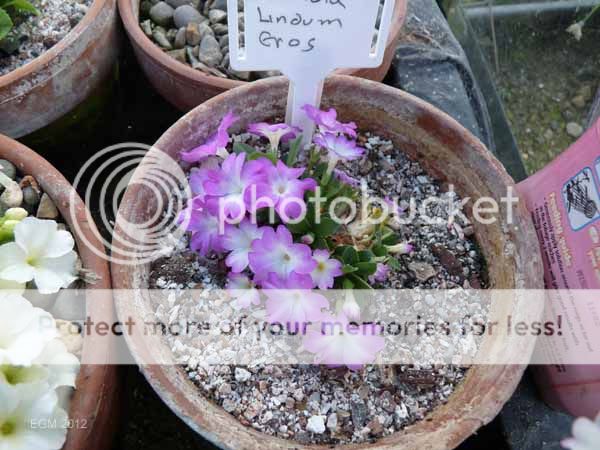
Primula allionii Lindum Eros
Primula allionii Lindum Wedgewood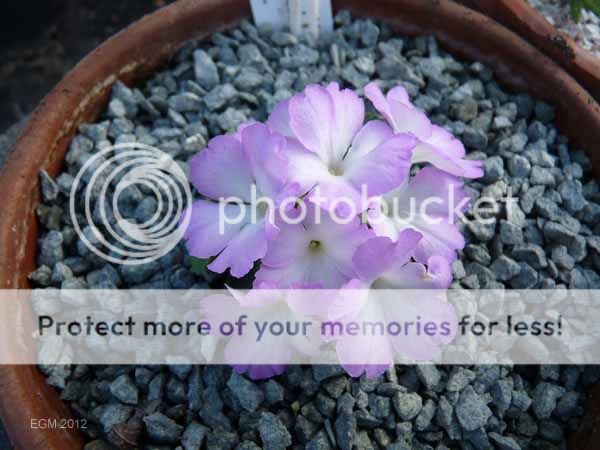
Primula allionii Malcom’s Mate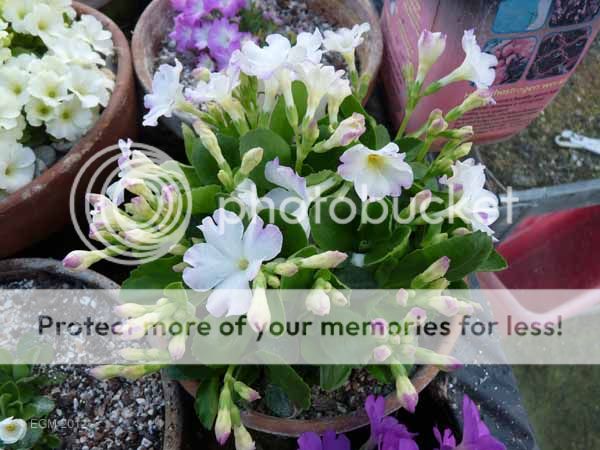
Primula allionii Pink Ice
Primula allionii Rachel Kinnon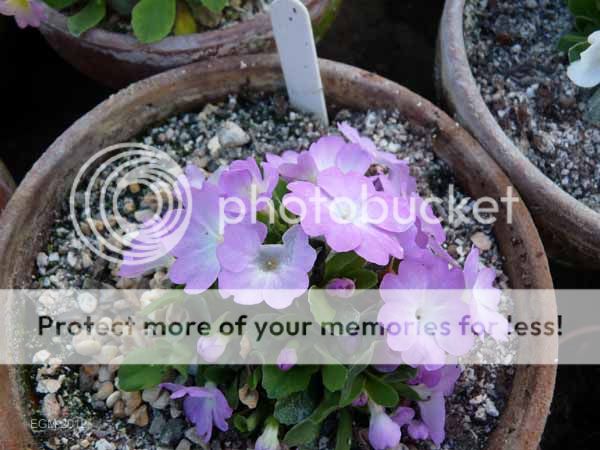
Primula allionii seedling
Primula allionii Stradbrooke Dream
Primula allionii Tony(?)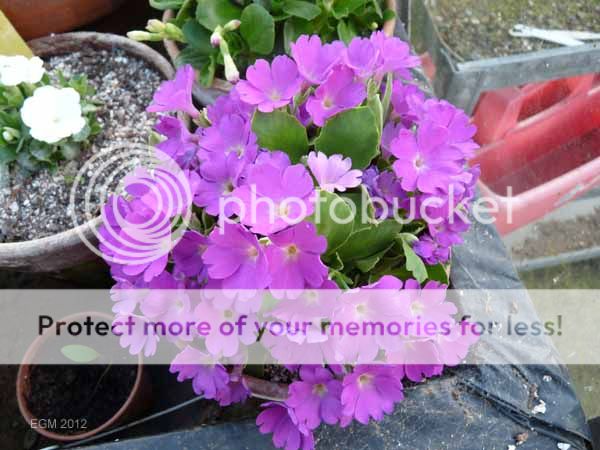
Primula allionii unknown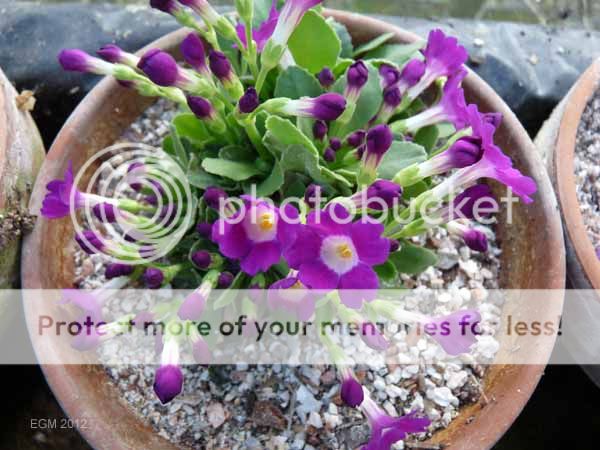
Primula allionii unknown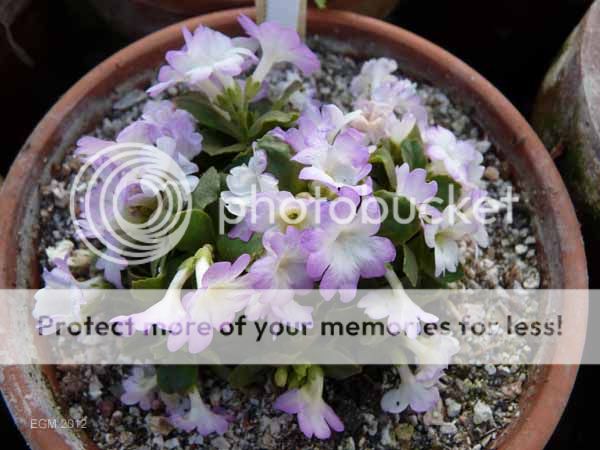
Primula allionii Wharefedale Ling
Primula Boothman’s Variety
Primula Hall Barn Blue.
There are more plants, but not in flower yet and the Primula allionii are no where near as good as the ones on the show benches, but I am just pleased to have kept them alive for another season.
Re: What do you see on your garden walks? 2012
Thought you might like a quick tour of the greenhouse with a few of the plants on show.
There are more plants, but not in flower yet and the Primula allionii are no where near as good as the ones on the show benches, but I am just pleased to have kept them alive for another season.
Thank you for sharing Palustris. Your greenhouse is nice and tidy. The plants are all gorgeous! I really like Primula allionii Malcom’s Mate just solid blooms. 8)
Stunning pulsatilla too!
Re: What do you see on your garden walks? 2012
Second that - I've never grown many allionii primulas, but 'Hall Barn Blue' is a great primrose-type for the garden.
Re: What do you see on your garden walks? 2012
The crazy northeastern weather continues. Plants seem almost a month ahead. The Everett, Wa NARGS Meeting was great but cold. It was warmer at home!
The daffodil is usually 2nd week in April and the douglasia the 3rd or 4th week, yet here they are.
Re: What do you see on your garden walks? 2012
Very nice flowers, Wim and Tim!
You have so many wonderful things in your greenhouse, Palustris!
Well, it looks like we will have flowers before the end of March after all... Bulbocodium vernum emerging: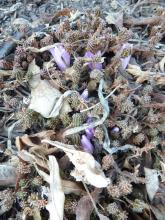
Wow, the start of the alpine season there already, Anne!
Re: What do you see on your garden walks? 2012
Palustris - you have some really nice primulas!
Yesterday and today we have had sun and the temperature reached 14C! We have not seen that since December!
Cardamine enneaphylla has been out in several weeks already but today they stretched their legs substantially! Also the daffodils (probably 'Tête à Tête') and Narcissus cyclamineus opened fully - notice the slug damage of some of the flowers :(
The lungworts also come forth in strides now! And for the first time in my garden - Pteridophyllum racemosum in flower! I managed to get hold of some plants last year ;D ;D
Re: What do you see on your garden walks? 2012
A month ahead in Reno! ;D
Viola beckwithii
[attach thumb=1]
Ranunculus glaberrimus var. glaberrimus
[attach thumb=2]
Re: What do you see on your garden walks? 2012
Wonderful sights, Trond and John!!
Re: What do you see on your garden walks? 2012
It is wonderful how varied gardens are - we have had exceptionally sunny and dry weather this spring, but with hosepipe bans to come because of similarly very dry weather last year when ground water levels are normally replenished. So in fact the alpines come more into their own in the garden because they are more easily looked after where other plants might struggle.
I grow many alpines in a railway sleeper raised bed (ca. 16 x 8 ft) which was made probably around 12 years ago and has had several major replantings. This one is the latest after it had become rather overgrown and weedy and certain plants had become too vigorous. Slowly I am learning to grow smaller plants on it and regular tidying and topdressing each year keeps it looking good.
Will I be able to succeed with that wonderful Alkanna on the bed? Time will tell, but it is planted in a section that is virtually pure grit and other choice species like Campanula zoysii are growing next to it, so given winter protection I have high hopes it might do. It would be wonderful to try that Viola beckwithii of John's too...
Re: What do you see on your garden walks? 2012
So many delights :)
No snowdrops here, yet, still just snowflakes ;) We had another 8-10cm of snow the other day, and around -16C last night.. we'll be back up to +11 by wednesday....
Here I am after shovelling, maintaining, as always, the highest standards of fashion, even when there is no one to see! and a chipper attitude in the face of back breaking (or knee/arm breaking- one fall on the abundant ice under the new snow!), then my (mostly under construction) main rock garden area, and my new Sempervivum bed from last fall, which is in front of the house..
Re: What do you see on your garden walks? 2012
Here I am after shovelling, maintaining, as always, the highest standards of fashion, even when there is no one to see!
Well, yes, that is the essence of style isn't it? Maintaining decorum even when out of the glow of the paparazzi's flash bulbs. ;D I share your attention to fashion as I pot on seedlings indoors here - only the most elegant of sweatpants and t-shirts, artistically daubed with accents of cat hair and dirt. ;D ;D
Re: What do you see on your garden walks? 2012
Cohan - do you have as many words for snow as the Inuit? The famous UK gardener Christopher Lloyd was renowned for his complete lack of style; he hardly needed it because he made a fabulous garden!
Re: What do you see on your garden walks? 2012
We didn't get as much as Cohan did. Despite that minor setback (and there'll be a lot more snow before it's done :rolleyes:), there are signs of spring all over the yard:
Buds developing on Thlaspi kurdicum; foliage on Primula algida; Jovibarba arenaria and Saxifraga cuneifolia; Primula cv.: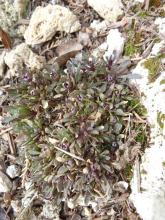
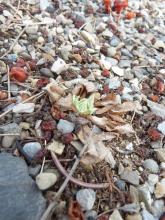
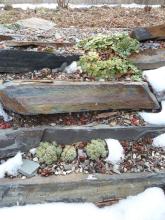
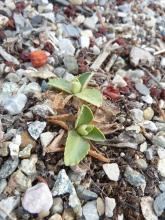
Buds developing on Saxifraga sancta var. macedonica, and some rosettes nipped off by jackrabbits; Pyrrocoma uniflora; Erigeron trifidus(?) (bought as Anacyclus marrocanus); Primula elatior; Townsendia parryi; Synthyris platycarpa: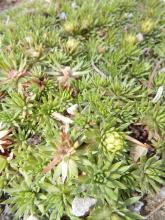
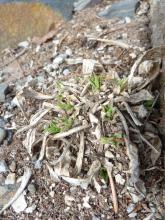
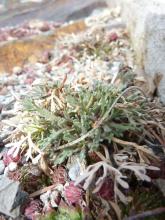
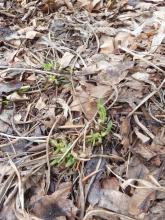
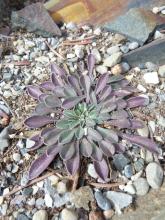
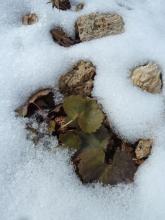
Re: What do you see on your garden walks? 2012
Lori and Tim- it's a tidier looking outfit- at least the bottom half- since I wasn't planning to shovel at first, and so I didn't put on my 'work' pants which get rapidly dirty handling logs/firewood in the bush! These are sweatpants mostly reserved for lounging indoors...lol
Tim- our language for snow is sadly lacking (at least words in general use- they may exist in scholarly writing??) though I can certainly recognise many many types and conditions of snow, and have often judged temperature by the condition of snow on the road....
Lori- lots of plants to look at there! I just noticed tonight that one corner of the semp bed is showing ( I think, it was dark out)- the sun is powerful this time of year, melting where anything dark is on or through the snow, even when temperatures are barely above (or even below) freezing! Until that, my only plants showing were my cactus seedlings... 7C for tomorrow, then we have snow forecast again Mon and Tues, but after that, up to 11C..
Re: What do you see on your garden walks? 2012
First greenhouse flowers of 2012 - the wonderfully bizarre water hawthorn, Aponogeton distachyos- these flowers were cut and brought inside to better enjoy the vanilla/gardenia scent.
Re: What do you see on your garden walks? 2012
Beautiful but a little bizarre ;D
Re: What do you see on your garden walks? 2012
I didn't know you had a greenhouse, Lori. Too small for all your seedling, I suppose...
Bizarre certainly is beautiful!
--------------------------------
Ptilostemon afer: March 19th and March 25th.
Re: What do you see on your garden walks? 2012
Really pretty, Lori, they remind me of something- maybe I've seen a picture before....
Rick, things are rolling along!
I'm going out to do some chores now- supposed to get up to 7C as I said, but at noon in Rocky Mtn House, it was still -5, and windy.. have to look at that semp bed and see what's showing...
Re: What do you see on your garden walks? 2012
I didn't know you had a greenhouse, Lori. Too small for all your seedling, I suppose...
No, amply large (10'x20') but Stuart uses it for his above-ground water lily ponds and tender roses and I don't want to interfere. (it's enough that I've taken over the entire rest of the yard! :rolleyes:)
Wow, Ptilostemon afer looks spectacular!
http://www.greekmountainflora.info/Parnon/slides/Ptilostemon%20afer%20Pa...
Re: What do you see on your garden walks? 2012
Your rolling eyes doesn't compute with me...
My yard is all for me, I still have seeds all over the house, my refrigerator is more than half full of overwintering plants, cuttings and seeds stratifying, and I have a potting table set up in the living room!
There are advantages to being single. ;D
-------------------
Gee, it had never crossed my mind before, but from that pic, Lori, it looks like the Ptilostemon would make a good dried flower.
Similar to Milk Thistle (Silybum marianum)
Re: What do you see on your garden walks? 2012
Forsythia mandshurica 'Vermont Sun' blooms two weeks earlier than F. x intermedia cultivars. Actually, it is already done now...
Adonis 'Fukujukai'
A plain ol' Corydalis solida, but very pretty anyway.
Cornus mas has lost its petals, but it's still nice looking, too.
Hieracium villosum is interesting anytime of year.
Re: What do you see on your garden walks? 2012
Rick's C solida is a little ahead of mine-- here's a shot from today of the planting area where I have some- they are about 4 feet farther than the stick you see sticking up out of the snow...
Second shot is another bed- just between the shrubs and the posts (stuck into the snow to keep shovels and snowplows away from the beds). this is where I wait for Pulsatillas, Muscari, etc...
Re: What do you see on your garden walks? 2012
Rick's C solida is a little ahead of mine-- here's a shot from today of the planting area where I have some- they are about 4 feet farther than the stick you see sticking up out of the snow...
Second shot is another bed- just between the shrubs and the posts (stuck into the snow to keep shovels and snowplows away from the beds). this is where I wait for Pulsatillas, Muscari, etc...
;D
Re: What do you see on your garden walks? 2012
Good stuff there Rick, I see that you're experiencing the same early spring we are here. Interesting about Forsythia mandshurica, being an early flowering variety. Even though common and ubiquetously planted, I do love Forsythia. I don't have any in my yard, but that's okay because they're in everyone else's yard, and I get to see them everywhere. Need to rectify the situation, and plant some of the different varieties; really like those that have deeper gold color flowers. The Adonis is most cheerful, can't believe I don't have any adonis in my garden.
Re: What do you see on your garden walks? 2012
F. mandshurica 'Vermont Sun' flowers are twice as large as those of F. x intermedia cvs. Lighter yellow, not gold. I am not sure how or if it differs from the species. But it is a very tidy shrub in comparison to most unruly forsythias, and with oval leaves, not at all narrow or pointed.
Re: What do you see on your garden walks? 2012
I have fond memories of Forsythia from seeing it -esp in charmingly overgrown plantings in the yards of Victorian houses- in Toronto; I had thought they weren't hardy here, but have seen a couple growing happily in the town where I work.-- on the south sides of buildings, I think.. I'd like to try some if I can find seed/the right varieties :)
Re: What do you see on your garden walks? 2012
Spring really has started over here, with temps up to 18°C and constant sun, flowers are popping up everywhere:
Olsynium douglasii 'Album'
Saxifraga wendelboi
Ranunculus ficaria 'Salad Bowl'
Anemone blanda
Primula 'Aire Waves'
Pulsatilla vulgaris 'Papageno'
Veronica thessalica
Ranunculus alpestris
Soldanella carpatica 'Alba'
Morisia monanthos
Re: What do you see on your garden walks? 2012
I grew a seedling Pulsatilla Papageno once. Frankly, I couldn't figure out why people liked it. Flowers had very asymmetrically divide, sparse petals and were very ragged looking. Yours, Wim, looks nice. I love all of those creeping veronicas, too.
Cohan, I have found Forsythia mandshurica to be more cold hardy than even Forsythia x intermedia 'Northern Sun', which is a University of Minnesota introduction, and much touted here.
I have been going through some of my flats of miscellaneous potted materials. They are all much farther ahead of plants in the ground. And I came across this surprise:
Clematis ochotensis from wild seed collected in Japan. I planted the seed back in 2009 and only one sprouted, so I didn't transplant it. The clematis grew about a foot last season, but died back to what you see. I never realized it would be such an early bloomer!
You can also see a bunch more seedlings that came up two years later (in 2011) in the pot. There ya go, Lori: another example for keeping "dead" pots. But, you probably would have been smart enough to use GA3 in the first place. ;D
Re: What do you see on your garden walks? 2012
You can also see a bunch more seedlings that came up two years later (in 2011) in the pot. There ya go, Lori: another example for keeping "dead" pots. But, you probably would have been smart enough to use GA3 in the first place. ;D
You greatly overestimate me :o... I often do things in the most inefficient way possible! :D Great example of delayed germination, though.
Re: What do you see on your garden walks? 2012
Cohan, I have found Forsythia mandshurica to be more cold hardy than even Forsythia x intermedia 'Northern Sun', which is a University of Minnesota introduction, and much touted here.
I'll try to remember that.. I have no idea what the ones are that I saw locally.. I don't usually look at woodies in local nurseries- usually can't afford any ;D so I mostly see the woodies they stick out front or featured in seasonal offerings at supermarkets, home stores etc, and haven't seen any Forsythias at all among those...
I don't recall seeing seed offered either, is it short-lived?
Re: What do you see on your garden walks? 2012
I have some locally-published books that claim Forsythia ovata is the one that tends to get planted around here. The flower buds can be winter-killed in low snowfall years.
Re: What do you see on your garden walks? 2012
For forsythia, flower buds are often killed above the snowline here in less cold hardy cultivars. I have grow Vermont Sun since 2001 and it has never skipped a beat, even in years with little snow. It stays around 6ft high. Flower buds above the snowline are hardy to at least -37F (-38C). That's the coldest it has been here in those years. There has been at least two springs in that time frame when the Northern Sun shrubs at the Arboretum (9 miles away) have had very significant flower bud damage. I have never seen F. mandshurica offered for sale at local nurseries, only mail order. Mine does not set seed. :(
A pic of Vermont Sun from 2003:
Re: What do you see on your garden walks? 2012
I have been going through some of my flats of miscellaneous potted materials. They are all much farther ahead of plants in the ground. And I came across this surprise:
Clematis ochotensis from wild seed collected in Japan. I planted the seed back in 2009 and only one sprouted, so I didn't transplant it. The clematis grew about a foot last season, but died back to what you see. I never realized it would be such an early bloomer!
You can also see a bunch more seedlings that came up two years later (in 2011) in the pot. There ya go, Lori: another example for keeping "dead" pots. But, you probably would have been smart enough to use GA3 in the first place. ;D
Wonderful, Rick. Didn't know that one...looks very nice!
Re: What do you see on your garden walks? 2012
Maybe sometime if I have a chance I'll try to take a closer look at the Forsythias in town- I've only seen them from the car driving past! I think both I saw were planted in front of businesses (maybe one was a church..).. of course they are in town, so that gives them an advantage already over here, though one local gardener claimed that my 20 miles east of Rocky Mountain House (on the edge of foothills biome and weather) gives me a 2 week frost advantage, and my sheltered property can be kind to woodies..
Now I'll have to look around for them...
Re: What do you see on your garden walks? 2012
Cohan, I have found Forsythia mandshurica to be more cold hardy than even Forsythia x intermedia 'Northern Sun', which is a University of Minnesota introduction, and much touted here.
I'll try to remember that.. I have no idea what the ones are that I saw locally.. I don't usually look at woodies in local nurseries- usually can't afford any ;D so I mostly see the woodies they stick out front or featured in seasonal offerings at supermarkets, home stores etc, and haven't seen any Forsythias at all among those...
I don't recall seeing seed offered either, is it short-lived?
Cohan, Forsythia is extremely easy to root by cuttings! Almost any little piece of a twig will root without treatment of any kind.
Rick, ochotensis looks similar to koreana but is possibly much earlier in bloom?
Wim, some nice spring stuff there! BTW today I spotted the first patches of flowering wood anemones (Anemone nemorosa) along the road. I have had some flowering in my garden for a week. It is not the first spring flower though, the coltsfoot (Tussilago farfara) has been in bloom some time now.
Re: What do you see on your garden walks? 2012
When we bought our house there was a great deal of forsythia planted too close to the house. It was removed and every place I dropped a branch there would soon be a new plant. Our wind chill can make us much colder than the surrounding area and a number of times there were no flowers above the snow line. It looks cheery at a distance early in the spring.
Re: What do you see on your garden walks? 2012
Good to know cuttings will root.. in case I ever have a chance to get any :)
Re: What do you see on your garden walks? 2012
Good to know cuttings will root.. in case I ever have a chance to get any :)
Is it impossible to send cuttings in the mail to Canada?
Re: What do you see on your garden walks? 2012
A nice dwarf form of Forsythia in flower on a raised bed now; F. viridissima 'Broxensis'
Re: What do you see on your garden walks? 2012
More signs of life...
Corydalis nobilis; Taraxacum pseudoroseum; Lewisia glandulosa; Eritrichium pauciflorium ssp. sajanense: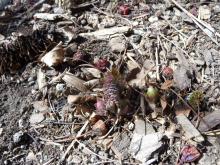
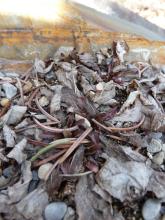
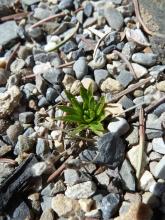
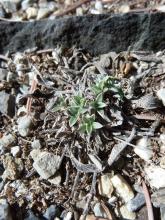
This tiny nub is what I bought as "Rhodiola rosea/purpurea" a few years ago; however, it's a tiny thing that looks and acts differently than my old Rhodiola rosea (e.g. it goes dormant in summer), so I'm wondering if it is actually another species: 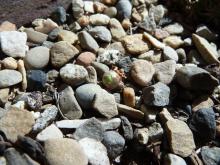
Winter colour on Vitaliana primuliflora v. cinerea (with Genista delphinensis in foreground):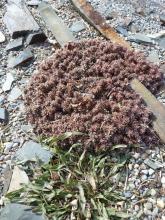
Re: What do you see on your garden walks? 2012
A close-up that probably explains why it's called Lewisia glandulosa: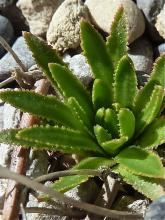
Edit: I picked up B. LeRoy Davidson's Lewisias at the WSW in Everett, Washington and have been perusing this excellent reference. Davidson makes note of the glands lining the edges of the bracts on the flower stem and on the sepals. I'll have to remember to look closely when it blooms later on.
Re: What do you see on your garden walks? 2012
April 1, 2012 NE Massachusetts USA zone 5b to 7a {depending} (3rd "season" in the garden, Galanthus and Crocus gone)
Charles Swanson
Re: What do you see on your garden walks? 2012
Great color on the corydalis. Any idea which one it is? Amazing that you have a townsendia in bloom already.
Re: What do you see on your garden walks? 2012
Hi Lori, all,
The Corydalis (solida) came from a small local nursery - no info. The winter has been absurdly warm, but just dropped to normal in the last 10 days. I don't recall the Corydalis being that red in previous seasons, the return of temps in the uppers 20s F after 60s - 80F may have done it. This Towndendia was showing buds as soon as winter broke, rothrockii wasn't; and is just in the earliest stages of opening. If we have a "normal" winter again, may be a month later for both.
Charles Swanson NE MA USA Z -- whatever
In spite of warnings from Lithuanian Rare Bulb Garden, this bed does show signs of "turning into a vast Corydalis plantation", and I'm not upset. They evaporate very early. Nothing else that I've ever planted (and wanted) tries to sprout every seed--seemingly more seeds than I ever see on the plants.
Re: What do you see on your garden walks? 2012
Charles- great colour on that Corydalis! I have one small planting, plus seedlings in pots- and I hope they spread!
Lori- much farther ahead than me, not surprisingly... I'm just happy to have a few areas showing out of the snow ;D
The only real activity shown so far are a few semps/jovis- amazingly after only being out of the snow a week or so (and fresh snow half the nights) there are signs that some are awake at the highest parts of the bed/first to melt out.. This bed is almost all plants received as 'lost label' from a serious grower, so if she couldn't/wouldn't name them, I wont! But this is clearly enough Jovibarba globifera, prob ssp hirta, two shots taken 4 days apart, March 28 and April 01..
Re: What do you see on your garden walks? 2012
Spending a week in the mountains but we had to drive some km to find snow even at 1100m altitude. Like last year much of the snow had gone and the remaining hardfrozen like ice due to very cold weather the last days. This spring has been rather dry up here 1.5cm of precipitation in 2 months.
Re: What do you see on your garden walks? 2012
April 1, 2012 NE Massachusetts USA zone 5b to 7a (3rd "season" in the garden, Galanthus and Crocus gone)
Charles Swanson
Wonderful photos Charles. My Townsendia rockrothii suffered from the early heat wave, and the flowers didn't open properly, the petals looking cut off and underdeveloped or altogether missing. It has been is a state of pseudo-bloom for weeks.
Re: What do you see on your garden walks? 2012
Nice images, Trond- not too different from the amount of snow here- though instead of the deepest snow being on high spots, its in the shade, and low areas, but we also have a lot of standing water now- one of my favourite times of year visually, since we suddenly have ponds and streams everywhere, and no grass to obscure them...
Re: What do you see on your garden walks? 2012
Took these yesterday morning thinking it would be better in case we get snow.
http://s703.photobucket.com/albums/ww32/Owdboggy/April%202012%20Garden%2...
We got snow!
Re: What do you see on your garden walks? 2012
Looks like spring is (was?) well under way for you, Palustris :) Looks like a great large garden, with lots of different kinds of planting areas!
I'm pretty sure we went through this not long ago- but my memory is not working today...lol where are you and what is your first name?
Re: What do you see on your garden walks? 2012
Very nice, Palustris! Your greenhouse plants are just amazing! I assume from your photos (the green lushness and beautiful buildings) that you are in the UK? It would be helpful if you could add your location to your signature in "Profile"... (always nice to know where abouts the garden is. :) )
More signs of life in the rock garden, as I wait for Wednesday's snow to melt:
Buds on Androsace carnea ssp. brigantiaca; buds also on Douglasia montana - some winter burn this year; Potentilla uniflora and buds on Androsace septentrionalis (a loose lanky form, not the compact beauties I see in the mountains here):
New leaves on Aquilegia laramiensis; Eriogonum caespitosum, bought from Beaver Creek last year, has come through well; Campanula orphanidea, from seed in 2010: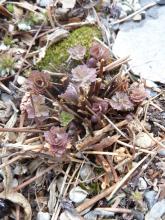
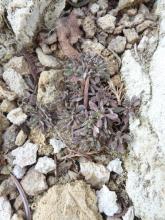
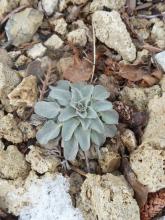
Buds on the most developed Pulsatilla I found on my little trek... dare I hope that this is one of the Pulsatilla patens I've planted? (Could just be one of the many self-seeded Pulsatilla vulgaris though...)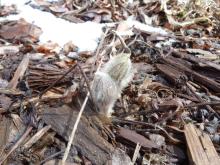
Re: What do you see on your garden walks? 2012
Always nice to see what have survived the winter. In fact, I miss that feeling of excitement to watch the snow recede and plants showing anew :D
Last year we discussed whether Dryas overwintered with green leaves. Well - here's the answer for this winter regarding D octopetala: (about 1000m altitude and very exposed site with little snow cover)
Re: What do you see on your garden walks? 2012
Here's another photo of Dryas octopetala emerging from winter by Merlin:
http://nargs.org/smf/index.php?topic=934.msg16427#msg16427
Lewisia longipetala, emerging: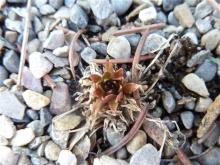
It's probably just a passing anomaly, but this tiny Aciphylla simplex appears to be lifelike and pliable... will probably soon be dealt a death blow by a late hard freeze...
First buds on Hepatica transylvanica in my cold yard (I know that people in warmer parts of the city have had hepatica in bloom for some time already):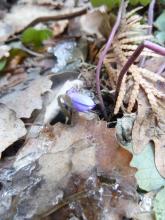
Re: What do you see on your garden walks? 2012
Draba lasiocarpa and and the evergreen gold foliage of a creeping veronica.
Echium russicum and Fibigia eriocarpa. I haven't seen this one bloom yet, and so far it looks just like Fibigia clypeata (maybe perhaps less ruffling of the foliage?).
Sanguinaria canadensis 'Multiplex' has lost its pink blush. That's Fibigia clypeata in the right background.
Thermopsis fabacea is always an early sprout. A purple Corydalis solida with Variegated Bulbous Oatgrass (Arrhenatherum elatius ssp. bulbosum 'Variegatum') to the right.
And bless its little heart, a one year old Pulsatilla georgica seedling, blooming at just 2 inches. :o 8)
Re: What do you see on your garden walks? 2012
Rick- early bloom on the Pulsatilla!
Lori- good luck with the Aciphylla! Looks like it has really nice leaves...
Re: What do you see on your garden walks? 2012
Here's another photo of Dryas octopetala emerging from winter by Merlin:
http://nargs.org/smf/index.php?topic=934.msg16427#msg16427
Seems to have had better snow cover ;)
Re: What do you see on your garden walks? 2012
Here's another photo of Dryas octopetala emerging from winter by Merlin:
http://nargs.org/smf/index.php?topic=934.msg16427#msg16427Lewisia longipetala, emerging:
It's probably just a passing anomaly, but this tiny Aciphylla simplex appears to be lifelike and pliable... will probably soon be dealt a death blow by a late hard freeze...
First buds on Hepatica transylvanica in my cold yard (I know that people in warmer parts of the city have had hepatica in bloom for some time already):
Not very long leaves, though on that longipetala ;) Aciphylla is a genus I have tried several times but they are not fond ofwinter wet :(
Draba lasiocarpa and and the evergreen gold foliage of a creeping veronica.
Echium russicum and Fibigia eriocarpa. I haven't seen this one bloom yet, and so far it looks just like Fibigia clypeata (maybe perhaps less ruffling of the foliage?).
Sanguinaria canadensis 'Multiplex' has lost its pink blush. That's Fibigia clypeata in the right background.
Thermopsis fabacea is always an early sprout. A purple Corydalis solida with Variegated Bulbous Oatgrass (Arrhenatherum elatius ssp. bulbosum 'Variegatum') to the right.
And bless its little heart, a one year old Pulsatilla georgica seedling, blooming at just 2 inches. :o 8)
Some nice ones, Rick. Impressive Pulsatilla :o
Re: What do you see on your garden walks? 2012
Palustris, a very beautiful pulsatilla. Do you know which one it is?
Re: What do you see on your garden walks? 2012
Palustris, a very beautiful pulsatilla. Do you know which one it is?
Not really, it has been suggested that it is a form of P. ambigua. All I can say is that it is slap bang in the middle of Pulsatilla rubra with deep red flowers, P. vulgaris with normal purple flowers and P. grandis with lilac coloured blooms. It is a self seeded one that is for sure. I have a picture of it in flower for the first time in 2006.
Re: What do you see on your garden walks? 2012
Lewisia longipetala, emerging:
Not very long leaves, though on that longipetala ;)
Well, no, not on the mingy little specimens I grow! ;D I suspect "longipetala" refers to the petals though; Davidson in his Lewisias refers to them as "narrow, equal" and "starry, not oval", (in describing how it was differentiated from P. pygamaea); see L. longipetala in bloom below: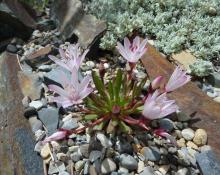
Re: What do you see on your garden walks? 2012
Lewisia longipetala, emerging:
Not very long leaves, though on that longipetala ;)
Well, no, not on the mingy little specimens I grow! ;D I suspect "longipetala" refers to the petals though; Davidson in his Lewisias refers to them as "narrow, equal" and "starry, not oval", (in describing how it was differentiated from P. pygamaea); see below:
Yes, i suppose so! Anyway both are very cute. Would like to grow them both ;)
Re: What do you see on your garden walks? 2012
Suddenly the sun broke through the cloud cover and the Anemone blanda and Chionodoxa opened their flowers. All the Scilla and Crocus are done but other small bulbs take over.
I got two pots of Trillium pusillum from a friend last year and one of them are due to flower! They all wait for a place in the garden.
Re: What do you see on your garden walks? 2012
Congrats on some sunshine! I like the pink Anemone- it seems blue and yellow are more common for spring flowers, so pink is welcome :)
How small is the T pusillum?
Re: What do you see on your garden walks? 2012
No photos from me as yet, won't be long though, I hope! Out checking on the garden areas today,the usual suspects are showing signs of life, the ever so hardy sedums, the plain old - plain old varieties, I don't think anything stops them, short of pulling them out. And many of the dianthus, and bergenia, perking up their "ears". I stopped and checked on the crambe cordifolia I planted last year, wondering if it made it through the winter as it wasn't very large, but I see what looks to be at least a couple of reddish growing points on the exposed crown, naturally I was tempted to poke at them, but at the last minute I found some common sense and left them alone...
Re: What do you see on your garden walks? 2012
Glad to hear of someone else growing Crambe cordifolia around here, Faith - it's a terrific plant!
I have been resisting tugging at things in the rock garden too.
Re: What do you see on your garden walks? 2012
The small bulbs are starting to bloom in greater number now - crocus, chionodoxa, scilla - though no good shows yet.
A couple of hepatica are starting to bloom today, though my camera didn't the colours correctly. They are actually more of a deep purple-blue, especially the H. nobilis.
H. nobilis; H. transylvanica: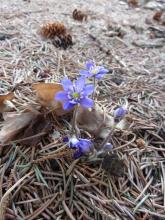
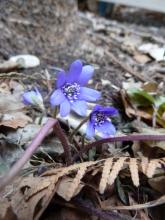
Re: What do you see on your garden walks? 2012
Great Hepaticas, Lori :) Still no garden action here (really curious whether the forecast possible heavy rain- and snow- will speed things along at all, or just make us even soggier - we may be floating by the end..), but I did, to my surprise, see some Petasites in bud in the bush- just emerging from the water, only in one sheltered spot (that I saw, no doubt similar others) with snow still melting into the water just metres away..
more pics here:
http://nargs.org/smf/index.php?topic=591.msg16594#msg16594
Re: What do you see on your garden walks? 2012
Congrats on some sunshine! I like the pink Anemone- it seems blue and yellow are more common for spring flowers, so pink is welcome :)
How small is the T pusillum?
Had a couple hours of sun this evening too and the temp reached +12C.
I have planned to plant more of the pink anemone. It looks nice in the lawn.
My flowering T pusillum is 9.5cm tall and the leaves are 3cm long! Have about 10 nonflowering specimens of half that size too. Hopefully they flower next year.
Re: What do you see on your garden walks? 2012
Lori, nice to see some hepaticas with flowers! My plants didn't flower much due to wet weather and slugs. Although they let the leaves alone they devour the petals.
Re: What do you see on your garden walks? 2012
My Trillium pusillum hit the dust.
Or, it's been sleeping for two years so far...
Re: What do you see on your garden walks? 2012
My Trillium pusillum hit the dust.
Or, it's been sleeping for two years so far...
Two years ago I bought Trillium pusillum 'Road Runner', named for this selection's propensity for spreading quickly, I have seen some wonderful clumps of it in other gardens. In my garden, it should be renamed 'Road Sleeper" as it has reduced in size and looks pathetic. I suppose, the trick is to find the right spot.
Re: What do you see on your garden walks? 2012
Guess I should be posting my current bloomers in this thread..I'll endevour to do this in the future.
I have never tried T. pusillum..for what its worth, most of the trillium I do have are just breaking the surface.
Re: What do you see on your garden walks? 2012
These were a few shots taken in the garden today.
Well, Todd, I once wrote that I didn't dare planting Petasites in my garden but they certainly have some charm, at least frigidus. Maybe I have to change my attitude! ;)
Re: What do you see on your garden walks? 2012
That's a cool Petasites, Todd! I'll have to look it up..
Re: What do you see on your garden walks? 2012
Petasites frigidus is very invasive... I tried it twice and yanked it out twice (gave it a second chance in case my invasiveness tolerance had changed, I guess). Some of the cultivated ones are just as bad, from observation. (I've never grown them, having enough invasive things to deal with.)
Re: What do you see on your garden walks? 2012
That Petasites is indeed invasive...along with Podophyllum peltatum, I am constantly hacking them back.
Sunny but cool today (7 C). Here's how things are progressing.
Re: What do you see on your garden walks? 2012
I wouldn't put them next to anything delicate or rare, but both P frigidus palmatus and sagitattus (if, as I've said, its really accurate to distinguish the species- there are so many intermediate forms, I wouldn't be surprised if my whole region contains hybrids, or if its really one big messy species) are native here and even on my acreage, so I have no fear of them- though likely they behave differently in a cushy cultivated bed than in a more natural context which always includes many other plants... that said, I still plan a planting in the yard so I can enjoy them up close in spring! I can put them somewhere they can spread for a few metres, mixed with other native wetland plants- sagitattus, that is, palmatus is a woodland species here, and often doesn't flower, but has really lovely leaves... it grows even more spread out amongst other plants than sagitattus, but I'd like to try a mass of it, like a whole berm or something- I like the emerging leaves and fall leaves as well..
Todd, did you grow your albus from seed? I still haven't looked it up yet...lol
Re: What do you see on your garden walks? 2012
Thank goodness for alpines- only thing showing signs of life in the garden besides weeds ;) and that with nightly frost, at least as low as -11C recently, and snow frequently, including snow/rain almost non-stop since Thurs afternoon... still, just noticed today a few subtle suggestions of growth to come! These are still small seedlings, second winter outside, but first in the ground in this new bed with semps, so I'm excited to see signs of life;
Saussurea here:
http://nargs.org/smf/index.php?topic=676.msg16672#msg16672
Plus Waldheimia tomentosa just emerged, no more than an inch tall, my one and only seedling..
I was starting to wonder about the leaves which I have not seen any white on so far, but I found an image on Holubec's site that looks right- I guess its just a greener form...
http://holubec.wbs.cz/1Kunlun-Shan-Xinjiang.html?framebreaker
Potentilla nitida I have several of these in different spots as well.. just waking up...(the other bed is snow covered again)
Re: What do you see on your garden walks? 2012
Well at leats you can get P. nitida to survive....that is more than I can say! However, my P. dickensii is just starting to unfurl a leaf so several of my plants are at the same stage as yours...just the bulbs are further advanced.
I goofed on the Petasites...the one I showed is P. japonicus, NOT P. albus.
Re: What do you see on your garden walks? 2012
One thing is for sure, the landscape and climate that Holubec shows is very different from my place! Don't think I ever can grow anything from that place here!
I goofed on the Petasites...the one I showed is P. japonicus, NOT P. albus.
Todd, I am not the only one, seemingly ;)
Re: What do you see on your garden walks? 2012
Todd-- good thing I didn't look it up yet, then ;D
As for P nitida, we'll see longer term now that its in the ground- sure would love to see it flower :) There's a funny story there- I was sowing this and Paederota bonarota at the same time, and unknowingly sowed them both in one pot and left the other empty!! I realised eventually there were two kinds of seedlings and just left them like that...lol I have the Paederota planted out as well, no sign of that yet...
Trond, the Holubec collections are from a number of places, some dry but some not- there is a bit of description on the site, I haven't go them all sorted out in my mind... for sure the Sakhalin collections seem to be from a wet place, better for you... I still don't know how any dryland plants will do here, I think I need to site and plant carefully- my rainfall is not so high, but low temperatures mean less evaporation, and spring and fall can be wet.
Interesting about the Waldheimia, the site of Holubec's wild photo has a very similar mix of rock types to the natural glacial deposits in my area- field stones have a similar mix here (though more quartzite here) as does the road gravel- so that photo could have been in a rock garden here ;D
Re: What do you see on your garden walks? 2012
Anything from Sakhalin should do fine for both Trond and I. It is a coolish, wet, windy area. Hokkaido plants do wonderfully well in St. John's...sakhalin should be even better! I didn't realize Holubec collected there.
Re: What do you see on your garden walks? 2012
Finally, we have a bit of sunshine today, though it's cold with the odd little patch of snow still around from yesterday.
Various seedling primroses, planted last year, are emerging, and P. algida (from 2 years ago) shows buds: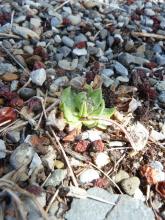
Sunny enough for crocus to open: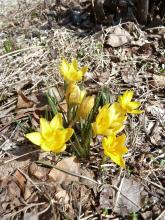
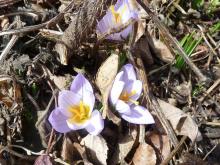
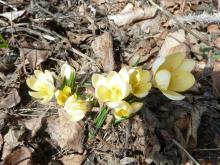
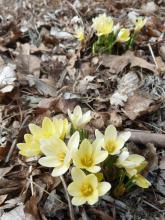
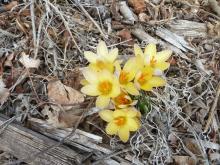
Re: What do you see on your garden walks? 2012
Anything from Sakhalin should do fine for both Trond and I. It is a coolish, wet, windy area. Hokkaido plants do wonderfully well in St. John's...sakhalin should be even better! I didn't realize Holubec collected there.
That's exactly what I was thinking :)And I think I might be able to grow some of those things too- a lot of my local woodland plants are species of 'moist woods'; Sakhalin was mentioned on Holubec's site this year, with one photo gallery from there; I don't remember if he did the collecting himself or that was one of the people that collect for him...
Re: What do you see on your garden walks? 2012
Todd, I forgot to mention- the Pulmonaria montana is a very nice colour..
Lori- you're doing better than us- we didn't get any sun till late afternoon- if we broke freezing, just barely! Still lots of snow around from the other day (besides what was here before that!)
Re: What do you see on your garden walks? 2012
This sand bed was started about three or four years ago, and recently extended at the front. It has been a great success and is leading me to redesign and change some of the plantings in our front garden. These are just a couple of photos and the superb dianthus 'Conwy Star', bred at Aberconwy Nursery.
Re: What do you see on your garden walks? 2012
Out standing!! Would make any gardener proud and as neat as a pin. :)
Re: What do you see on your garden walks? 2012
Spectacular Tim! I don't have the patience for such a neat garden.
What I think is Draba lasiocarpa in my trough.
Re: What do you see on your garden walks? 2012
Simply(?) fantastic, Tim! :o Every plant has it place in the sun and ready for stardom. Commanding agave looking plants. (With my limited knowledge, I can at least see that the one on the right is one.) I don't think I realized this before: the cyclamen is growing in sand?
Re: What do you see on your garden walks? 2012
Everything looks happy there, Tim- the Yuccas are quite spectacular!
Todd- nice combination of the dark Semp with the Draba!
Re: What do you see on your garden walks? 2012
Actually you should see the rest of the garden - not so neat! A lot of alpines lend themselves to this sort of planting (like a very big trough in effect), because you do tend to view them individually, but I like them best when they begin to merge and mix over time. Woodland plants are especially nice in spring just in foliage.
Re: What do you see on your garden walks? 2012
Tim- this is a lovely combination with the Brunnera etc :)
Re: What do you see on your garden walks? 2012
Tim, your magnificent sandbed has made me planning one too ;) But I'll have to build it somewhat up from the ground. I know where to build it but not when yet . . . .
Re: What do you see on your garden walks? 2012
What I think is Draba lasiocarpa in my trough.
Maybe I should try some Draba speies. They look good!
Re: What do you see on your garden walks? 2012
Trond, the aizoides group Draba are easy in OUR climate...its the fuzzy ones that are challenging. I love them for the early bloom and their form is quite lovely all summer.
We broke two temperature records today..the warmest day for this specific date (it reached 21 C) and the hottest temperature for this early in the season...we actually did not hit 20 C last year until July! (last year was one of the coldest summers on record).
Lots blooming now...the crocus and reticulated iris are at their peak, Chionodoxa and Scilla are starting nicely..I've seen daffodils open next to houses were it is sheltered.
A few recent bloomers..the Corydalis solida are just starting to colour up, the first Erythronium are open and my Viburnum bodnantense is also starting.
Re: What do you see on your garden walks? 2012
Wow, those viburnums! I've just bought tubestock of both and need to find the right place to plant them - Rick's suggestion of near the door is a great idea!
Our autumn continues dry here and the bulbs such as nerines are doing well;
in the garden, Nerine "Ariel"
In the shadehouse, "Aristocrat"
By the front door we have a rather spikey Hakea suavolens which is supposedly sweetly scented - just a bit risky to try to sniff it!
cheers
fermi
Re: What do you see on your garden walks? 2012
Fermi - love that Hakea suavolens. Does MAFF allow seed of it to leave the country?
Todd - Have had success with cuttings of Viburnum bodnantense in the University's misting bed but am still trying with V.carlesii. Guess it has a lot to do with at what stage you take cuttings from the plants. They are both prize plants. Fran
Frances Howey
London, Ontario, Canada
Zone 5b
Re: What do you see on your garden walks? 2012
Viburnum carlesii really is a great plant. We just have gap left by a specimen of Daphne bholua which died this winter, and this would make a good replacement. We actually have as spiky a plant as Fermi next to our front door - a Grevillea rosmarinifolia 'Williamsi' which I accidentally allowed to root through from the pot it was in. It flowers wonderfully but has to be curbed to allow visitors through!
I thought I would show a few examples of foliage of alpines since I find this as attractive as their flowers in many cases - these are Leucogynes leontopodium, Stachys candida, Potentilla ovina and Teucrium pyreniacum. The camera often picks up details that you don't notice in the garden.
Re: What do you see on your garden walks? 2012
Many plants have foliage that certainly deserves a closer look.
I grow one nerine indoors...it won't bloom here until September. It would be nice if it could be grown outside.
The hellebores are coming along nicely now. Here is a selection of those I have in bloom.
Re: What do you see on your garden walks? 2012
We actually have as spiky a plant ...next to our front door - a Grevillea rosmarinifolia 'Williamsi' which I accidentally allowed to root through from the pot it was in. It flowers wonderfully but has to be curbed to allow visitors through!
What a coincidence, Tim, as that is why the Hakea is where it is - it rooted through its pot and the tray and into the soil. 15 months ago the wind ripped it down though it was still attached to the soil by a root. I chopped off its branches and stood it up again to ready it for disposal and the infernal thing just kept growing! These are the first flowers in 2 years though, so it obviously had to do a bit of re-establishing itself. Hopefully it will set seed so that I can re-establish it somewhere else - I've not found it for sale again since I bought this one a few years ago at an agricultural field day at Elmore.
A shrub I've come to appreciate for its drought-hardiness and prolific flowering is Eriocephalum africanus
I must remember to take cuttings at the right time in future!
cheers
fermi
Re: What do you see on your garden walks? 2012
I thought I would show a few examples of foliage of alpines since I find this as attractive as their flowers in many cases - these are... Potentilla ovina... The camera often picks up details that you don't notice in the garden.
What odd foliage for a potentilla!
Re: What do you see on your garden walks? 2012
Just a suggestion of things to come-- Corydalis solida buds, just barely showing among the leaf mulch.. and Primula, I think its an auricula cultivar- I planted two of them last summer, and one flowered in fall! Almost out of the snow, and looks like its ready to go.... I may be planting more of these (one is yellow, one violet) though none of the crazy ones...
Re: What do you see on your garden walks? 2012
You guys show a wealth of interesting plants :o some of which I've never even heard of!
Here at my summerhouse it's not many interesting plants flowering at the moment as we have more summer flowers than spring flowers. Moreover, the geese have arrived and they graze everywhere. It's tracks of deer too.
Re: What do you see on your garden walks? 2012
More signs of life...
Gentiana punctata; buds on Draba acaulis; Rheum rhizostachyum:
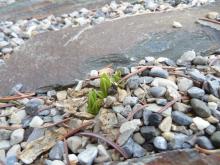
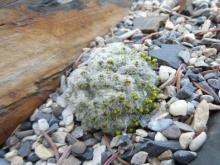
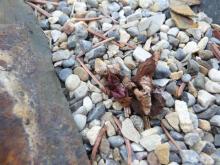
Corydalis solida x2; Adonis x amurensis 'Fukujukai', making an appearance; Jeffersonia dubia; Fritillaria pallidiflora:
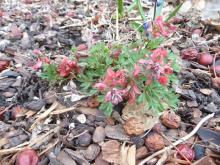
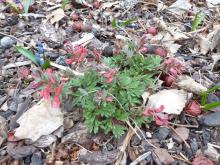
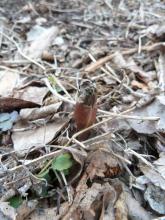
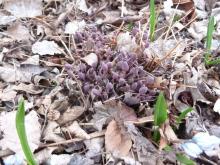
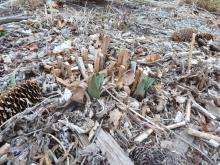
Re: What do you see on your garden walks? 2012
Lori and Cohan - it is magical seeing all those plants just appearing through the ground, not too different to when seeds germinate. I don't think Draba acaulis is much in cultivation in the UK and most people grow these tomentose species in alpine houses - rather wonderful to see it in a garden setting. In a cool gritty spot I am trying this x Leucoraoulia hybrid along with the exquisite New Zealand 'edleweiss' Leucogynes leontopodium. Our often hot dry summers will be the testing time but where they are planted moisture levels in the soil should remain high. In the same place is the unusual little umbel from South America Bolax gummifer, which i have not succeeded well with before.
Re: What do you see on your garden walks? 2012
Nice to see things really gaining steam now, Lori. There was that many stems on F. palliflora last season? Do you expect more sprouts still to emerge?
The silvers that Lori and Tim show are so cute, intricate and robust. (Each has its own aura ;D.)
More stuff in my garden:
Corydalis solida. To the right is a bit of Arrhenatherum elatius ssp. bulbosum 'Variegatum'. Seed of this turned out to be crap last season (sorry, Stephen).
Mertensia alpina
Astrantia major 'Sunningdale Gold' and Jovibarba heuffelii
Re: What do you see on your garden walks? 2012
Love the Draba, Lori!
The stone behind the Gentiana looked like running water in the thumbnail, and I thought OMG, your run-off is even worse than mine, I just have trickles! lol Of course I'd love to have a real stream in the garden.....
Re: What do you see on your garden walks? 2012
You definitly grow some gems, all of you!
I went for a walk today visiting some of the wild populations of Hepatica nobilis on the island where I have my summerhouse. The usual blue form dominate in all populations except two. One consists almost completely of red (pink Lori?) flowered specimens and in the other 30-40% are red (and a few white). However, you can find red ones here and there other places too.
Re: What do you see on your garden walks? 2012
You definitly grow some gems, all of you!
I went for a walk today visiting some of the wild populations of Hepatica nobilis on the island where I have my summerhouse. The usual blue form dominate in all populations except two. One consists almost completely of red (pink Lori?) flowered specimens and in the other 30-40% are red (and a few white). However, you can find red ones here and there other places too.
These are great, Trond- love the deep colours and pinks are very nice!
I just saw the first bulb emerging (apart from Cory I saw already a couple of days ago)! Probably a crocus... so far the first and only of the bulbs I planted last fall...lol
Re: What do you see on your garden walks? 2012
Nice to see things really gaining steam now, Lori. There was that many stems on F. palliflora last season? Do you expect more sprouts still to emerge?
It looks like the same number of stems as last year - 2; more would be nice though, if that's what happens! It's funny that I didn't even plant any F. pallidiflora out there... the bulbs may have been in the roots of a perennial that I moved. If the bulbs had been mixed in with other bulbs being planted, you'd think we would have noticed (from the skunky smell, if not from the different appearance.) The woody stems immediately behind the green shoots are some larger perennial that will emerge later.
Wow, just beautiful, Trond! If I had hepatica like that in my woods (if I had woods :rolleyes:), I don't think I'd even bother growing them in the yard!
Re: What do you see on your garden walks? 2012
Wow, just beautiful, Trond! If I had hepatica like that in my woods (if I had woods :rolleyes:), I don't think I'd even bother growing them in the yard!
We have no formal yard or garden at our summerhouse but plant a lot of different plants to substitute those that the deer, hares, rodents and sheep devour ;)
It isn't our wood but belongs to the two closest neighbours 500m away. Actually we have some Hepaticas on our property too but they were done for the season.
Here are some examples of what we have planted:
The spent Christmas Hyacinth bulbs flower well for many more years in the field. A Draba which suddenly appeared out of nowhere and an overwintered Delosperma in the "rock garden".
Re: What do you see on your garden walks? 2012
Nice rock garden vignette, Trond! Besides the Delo, and Semp off to the right, what is at the left with small reddish rosettes- Rosularia? and what are the variegated grassy leaves?
Re: What do you see on your garden walks? 2012
I agree - very attractive and colourful! Are the striped leaves crocuses?
Re: What do you see on your garden walks? 2012
Adonis vernalis emerging: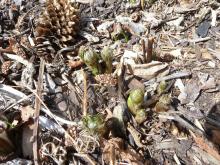
The first waterlily blooms of the season in the greenhouse, Nymphaea 'Helvola':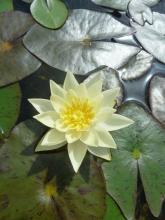
And with a sunny day warming the soil yesterday, I killed the first lily beetle. :P
Re: What do you see on your garden walks? 2012
Several woodland species coming into their own at the moment:-
The Doronicum (caucasicum?) is always a nice surprise early in the season, and here is planted with cyclamen and Corydalis temulifolia 'Chocolate Stars'.
Nearby is another good combination, Tiarella cordifolia and Primula 'Strong Bear' (curious name for a very good deep blue double).
The finest wood anemone in the garden, A. nemorosa 'Allenii'. This is only just beginning to flower and has very large, beautifully soft-blue flowers, though perhaps not best placed under a magnolia that has just finished flowering!
Re: What do you see on your garden walks? 2012
Lori-- lots of nice crocuses! sorry about the lily beetle :(
Several weeks after the winter snow melted from the bed (much of which was quite cool with frequent snow) I finally have a few noses poking (barely) above ground- Crocus and Galanthus, I think.. there was only one yesterday, but a few more today, and with next couple days around 20C, should finally see some progress!
The bad news- looks like maybe vole damage in my older spring bed that has Pulsatilla vulgaris a few bulbs, Muscari etc too soon to say what they have damaged, hopefully not too much....
Tim, more nice plant combinations! That is a nice A nemorosa :)
Re: What do you see on your garden walks? 2012
Nice rock garden vignette, Trond! Besides the Delo, and Semp off to the right, what is at the left with small reddish rosettes- Rosularia? and what are the variegated grassy leaves?
Thanks, Cohan ;)
The variegated grassy leaves are some Crocus as Lori suggests and the rosettes are Rosularia sedoides:
Re: What do you see on your garden walks? 2012
Lori, I tried once to grow waterlilies but didn't make it as the container was to small. How big are yours?
I have dreamt of growing such magnificent plants ever since I saw my first "nøkkerose" as a little kid.
Both in Norway and Sweden grow the red-flowered waterlily wild in several lakes and tarns:
From this site: http://friluftsrad.iis01.daldata.net/dalane/default.asp?WCI=ViewNews&WCE...
Re: What do you see on your garden walks? 2012
Thanks, Trond- nice Rosularia! I did think after I typed that they could be Crocus.. mine are about 1cm tall so far....lol
Nice waterlily.. we have a wild one around here too, its yellow.. I don't see it much though,(and not close) since it is in quite inaccessible places here- in (presumably) deep water preceded by sometimes large areas of slough/bog, water, mud etc.. best chance is if a road or trail cuts through those areas and gets you nearer to the deep water..
Re: What do you see on your garden walks? 2012
That somehow seems quite a surprise to see waterlilies like that; I've only seen them in gardens. Interesting website with fine scenery - what are the rock drawings that are shown?
Re: What do you see on your garden walks? 2012
That somehow seems quite a surprise to see waterlilies like that; I've only seen them in gardens. Interesting website with fine scenery - what are the rock drawings that are shown?
The rock drawings are possibly depicted boats (and a foot print) with people on board from the bronze age - about 3000-4000 years ago.
http://www.fornminner.no/AmS/08-bo-i-sokndal/bo-i%20sokndal.htm
Re: What do you see on your garden walks? 2012
The other place isn't very far in distance from where I live but I've never walked there (have to take a ferry and drive for a couple of hours ;)
I had a nice walk on another island when I was at my summerhouse yesterday (I drove home in the evening). Had to take my small boat though to get there but the weather was calm and sunny.
At the beach the very common scurvy-grass (Cochlearia officinalis) was in full flower. However, as I don't have scurvy I didn't eat any ;) Here and there the wild gooseberry (Ribes uva-crispa) also bloomed.
However my camera is damaged and it is difficult to take pictures - they're not sharp always.
The common windflower covers the floor of the deciduous woods. Here and there some other plants find footholds like the yellow star of Bethlehem (Gagea lutea, in Norw "gullstjerne" = gold star) and cowslip (Primula veris). Later the cowslip will dominate in more open situations.
Re: What do you see on your garden walks? 2012
I was early and the flowers still hang down waiting for the chill night air to warm up and the night haze to disappear.
Most of the plants have white flowers but quite a few have some pink in them particularly on the reverse of the sepals. Some get darker as they get older. Some of the flowers are quite large too.
Re: What do you see on your garden walks? 2012
Hoy, this is so lovely to see!
I would like to take a walk there.
Thank you for taking us with you.
Lina.
Re: What do you see on your garden walks? 2012
Beautiful pictures Hoy. The morninglight through the leaves in the wood, perfectly catched in your (damaged) camera.
Re: What do you see on your garden walks? 2012
Nice waterlily.. we have a wild one around here too, its yellow.. I don't see it much though,(and not close) since it is in quite inaccessible places here- in (presumably) deep water preceded by sometimes large areas of slough/bog, water, mud etc.. best chance is if a road or trail cuts through those areas and gets you nearer to the deep water..
That would be spatterdock, Nuphar variegatum. There is a true water lily also, Nymphaea tetragona, which has white flowers, but I've yet to see it!
Re: What do you see on your garden walks? 2012
Lovely pictures, Hoy. You are very artistic with the camera.
Everything here is way ahead of schedule (at least 3-4 weeks). My garden in open for the Garden Conservancy May 5th and It will be interesting to see what's in bloom then - not a typical spring following a non-winter. The rhododendron is R.'Aglo', hardy here and unusual this year because the deer left it alone. There is usually bloom only on the top which they can't reach.
Re: What do you see on your garden walks? 2012
Nice waterlily.. we have a wild one around here too, its yellow.. I don't see it much though,(and not close) since it is in quite inaccessible places here- in (presumably) deep water preceded by sometimes large areas of slough/bog, water, mud etc.. best chance is if a road or trail cuts through those areas and gets you nearer to the deep water..
Nice waterlily.. we have a wild one around here too, its yellow.. I don't see it much though,(and not close) since it is in quite inaccessible places here- in (presumably) deep water preceded by sometimes large areas of slough/bog, water, mud etc.. best chance is if a road or trail cuts through those areas and gets you nearer to the deep water..
That would be spatterdock, Nuphar variegatum. There is a true water lily also, Nymphaea tetragona, which has white flowers, but I've yet to see it!
We have 3 species of the white Nymphaea (or subspecies some say) which of one have red forms too; and 2 species of the yellow Nuphar. Some of the species are rather common. I have picked them several times in my youth but they're difficult to put in a vase!
Re: What do you see on your garden walks? 2012
Lovely pictures, Hoy. You are very artistic with the camera.
Everything here is way ahead of schedule (at least 3-4 weeks). My garden in open for the Garden Conservancy May 5th and It will be interesting to see what's in bloom then - not a typical spring following a non-winter. The rhododendron is R.'Aglo', hardy here and unusual this year because the deer left it alone. There is usually bloom only on the top which they can't reach.
Beautiful pictures Hoy. The morninglight through the leaves in the wood, perfectly catched in your (damaged) camera.
Hoy, this is so lovely to see!
I would like to take a walk there.Thank you for taking us with you.
Lina.
Thanks a lot! But my camera is damaged, I swear! The lens is bad and the electronics do what it want without listening to me!
Re: What do you see on your garden walks? 2012
Trond - it is amazing how Anemone nemorosa grows with hardly anything else flowering at the same time. In Blean woods near us (and Canterbury) it grows just like your pictures, but in other places under coppice it is mixed with bluebells and celandine. Very wonderful to see it en masse as in your photos.
Re: What do you see on your garden walks? 2012
Great stuff!
Trond, the seashore plants are nice, but the Anemone woods are especially lovely :) As Tim mentions, it always fascinates me to see such solid growth of anything, pretty much unheard of here.. the pinkish ones are especially nice...
Anne- love the Hymenoxys, and the view of the Rhodo with the lovely stone house behind is really nice :)
Lori, I don't think I've seen the white waterlily either, though I was happy to see the native water arum once (Calla? too lazy to look it up right now...lol)
Re: What do you see on your garden walks? 2012
Extremely dry and warm spring. Now 3 to 4 inches of rain and possibly a low of 30F next Monday.
Charles, NE Massachusetts USA Z 6a +/-
Re: What do you see on your garden walks? 2012
Great Pediocactus! My favourite genus of hardy cacti :)
Love the yellow tulip too :)
Just heard about that storm going through the east- hope you get some good moisture with no damage..
Its turned opposite here- into the low to mid 20'sC the last couple of days and tomorrow (31C forecast for Medicine Hat in southern Alberta) but then temps will drop back to more normal low teens C..
We now have that interesting spring phenomenon- we still have sizeable snow banks on parts of the property, summer temperatures, and mosquitoes!
Re: What do you see on your garden walks? 2012
Trond, your meadows of Anemone are wonderful! Mine are about 5 cm high at the moment. Our Cochlearia will not flower until June.
Charles, to grow cacti outside is the stuff of dreams in my area.
We just had another spell of wonderful sunny, warm weather but now it is just 2 C and suppose to stay under 10 C the rest of the week...plus rian, drizzle and fog! The alpines will be on hold for a while.
Re: What do you see on your garden walks? 2012
Cohan, Todd thanks for your comments. Have about 7 species of barrel cacti, every winter I hold my breath, but so far they have come through. Way back when, I angled a sash over a trough for the winter against a south wall; but I've gotten lazy and they're on their own. They're in at least 20 inches of sand mix above grade and against a free standing brick wall. I kept finding different sources of sand so it's a bit of an archiological site. I'm moving toward 90% sand with some limestone gravel (and some dirt), but I haven't gotten there yet.
Many of my cacti came from Beaver Creek in BC. Penstemons and Astragalus/ Oxytropis seem to have settled in too, at least the ones that lived long enough for me to plant them. Lewisia rediviva has 2 buds. I planted one under a stone and one in the open, the stones get infested with ants, so the one in the open is better.
Charles MA USA 6a
Re: What do you see on your garden walks? 2012
An update on the Leibnitzia anandria from here:
http://nargs.org/smf/index.php?topic=934.msg16283#msg16283
and the follow up message two down on that page.
~~~~Pollination did occur. When the petals withered, all that was left was the green calyx(or bracts). Today I noticed these protruding purple appendages. I am not sure what exactly they are, but they weren't there before! Only one flower was not pollinated (I asssume). It's the dried up stem at the lower right in the first photo.
Re: What do you see on your garden walks? 2012
I looked for the leaves of Erythronium dens-canis several times on the weekend and saw nothing... today, I come home and not only are the leaves up but this one's in bloom! :o (Sheesh, am I that unobservant?!?)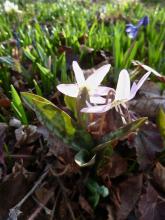
Re: What do you see on your garden walks? 2012
They look cool at that stage, Rick! I like the plant, makes me think of mini Petasites...
Lori- just missed it, or were they that fast in the warm weather? Seems too fast, though...lol
Re: What do you see on your garden walks? 2012
I am still only dreaming of growing cacti in the open garden! Or to be more precise, I have planted 2-3 different taxa (just one pad of each) outside at my summerhouse now ;) - but they still have to face a winter there before I can relax a little.
Re: What do you see on your garden walks? 2012
Our much needed rain blasted the flowers on Paeonia tenuifolia before I got around to photgraphing it but Paeonia mlokosewitschii made it through OK. This has the added attraction of fire-red seed heads in the fall. You can see them from quite a distance.
Re: What do you see on your garden walks? 2012
Charles - really interesting that you grow those cacti in such deep sand and are also trying astragalus and oxytropis. So far I haven't done too well with these but would love to grow more of them successfully. I think Anne also mentioned that her sand beds were very deep. Probably I haven't made them on a big enough scale. The Veronica (bombycina?) is a super plant.
Re: What do you see on your garden walks? 2012
but Paeonia mlokosewitschii made it through OK. This has the added attraction of fire-red seed heads in the fall.
Wonderful specimen in great form. Hopefully it exceeds it's reputation of flowering for a week and looking at it's best for 4 hours.
....but then, how many other cherished plants might deserve that reputation?
Charles MA USA
Re: What do you see on your garden walks? 2012
I think quite a few plants deserve that reputation but not this one. It blooms two weeks or longer with new buds opening all the time. The big deal is that the foliage survives a heavy rain, unlike Paeonia tenuifolia, which really is fleeting unless the weather is perfectly to its liking.
Re: What do you see on your garden walks? 2012
Stunning peony Anne!
You are almost caught up to me Lori....my E. dens-canis is almost past.
Erythronium sibericum is my favourite species...I grew this from seed. Only one germinated and it is not spreading yet. I hope it does!
Re: What do you see on your garden walks? 2012
Todd, that's a beauty. Hope it spreads soon.
Re: What do you see on your garden walks? 2012
Seems you all soon are ahead of me :-\ Although the weather hasn't been too bad it has been very cool and almost a standstill for plants. No Erythronium, peony or Trillium have opened yet although they have been ready for weeks.
I don't need rain, I need sun and warm weather!
Re: What do you see on your garden walks? 2012
Beautiful sights in everyone's gardens!
Some sunshine today has brought out the flowers...
Corydalis solida 'George Baker', 3 plants bought last year: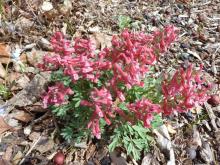
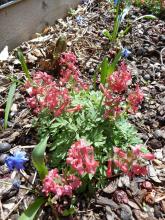
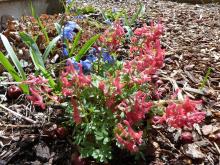
Re: What do you see on your garden walks? 2012
Lots of colour, Lori- your Jeffersonia is looking great!
Re: What do you see on your garden walks? 2012
Lori, the Jeffersonia dubia flower color and petal shape are superb!
(As is everything. :D)
------------------------------------
After our April Chapter meeting yesterday, I went with another member to visit Dick and Shirley's garden (also members). I've posted pics from their garden before, and it's very memorable. A few photos I took on this cold, drizzly day:
Anemone nemerosa 'Vestal' and Antennaria 'Silver Edge'
Virginia Bluebells (Mertensia virginica) happily thrive seemingly anywhere in the garden.
An unexpected treat, Buciniczia cabulica actually overwintered during this extremely mild and practically snowless winter. I never knew (but why would I?) that it was such an early bloomer: it already has a flower stalk!
I am a little partial to Tulipa sylvestris: bent over a little more than normal because of the rain, I think, it reminds me of my avatar. ;D
Part of their sand bed, and a lovely, fragrant Daphne caucasica var. rosea
Thlaspi praecox is ornamental in both flower and in seed:
Re: What do you see on your garden walks? 2012
Lovely garden visit, Rick! This Thlaspi actually looks something like the only one we have here (the weed) ;D --I know this one is smaller and cuter with bigger flowers, though the one I saw blooming a week or more back was actually very tiny..lol
That reminds me that the greenest patch so far on my sparsely planted new rock planting from last fall is Taraxacum- even though its pseudo-roseum..lol
Re: What do you see on your garden walks? 2012
I join the chorus!
Lori, your Jeffersonia is awesome!
As is the garden you visited Rick. I am particularly jealous on those Virgina bluebells. I have had several attempts to establish that species but the slugs always make a feast on them.
The lesser celandine (Ranunculus ficaria) is one of the commoner "weeds" in the garden. The gastropods don't like it! I have a pale yellow and a doubleflowered too.
Cardamine heptaphylla and Waldsteinia ternata are also let alone by the slugs.
Re: What do you see on your garden walks? 2012
Enjoying everyones garden shots.
A few more: Fritillaria pallida, Asperula (gussonii or pontica), Dracocephalum imberbe, Lamium garganicum, Houstonia caerulea, and Delosperma (? sp. Reznicek).
The Dracocephalum and the Lamium move about in the sand bed, never staying in place for more than a couple of years. Houstonia grows here in barren clay soil or barren sandy clay soil, but this large bun was a commercial plant -- generally in the wild the plants without flowers are about an inch across and not much more than 1/4 inch high
Charles, Massachusetts USA z 6a, 40+ inches rain
Re: What do you see on your garden walks? 2012
Charles, some really choice selections!
Trond- I like your weeds! I wonder if R ficaria is hardy and/or weedy here? the mix of yellow and white is nice...
Re: What do you see on your garden walks? 2012
I'm with Trond on those mertensias - what a sight! I only have one plant in my garden which has never increased. Something about those blues.
Re: What do you see on your garden walks? 2012
The genistas are coming into bloom now, one of my favorite times in the early garden. They have an affinity for stone. This one is blooming in the lower crevice garden and has formed a waterfall. The second picture is a general view of the lower crevice garden.
Re: What do you see on your garden walks? 2012
Don't know what happened to the pictures, I'll try again.
Re: What do you see on your garden walks? 2012
Cohan; I was unable to get Ranunculus ficaria going in my giant sand bed of a yard despite its aggressive reputation. The Mertensia has been around for a while and does reseed. Both probably like wet soil at least in spring. The Ranunculus probably likes it heavy.
Re: What do you see on your garden walks? 2012
Anne- fantastic!
Bundraba- no sand in sight here! lol I do have one end of the yard that stays fairly moist, though often we have a dry spell in spring after the snow is gone and before summer rains start.. This year is different- April was a bit wetter than usual, and May is off to a wet start with a couple of days of rain- spotty yesterday, but pretty steady so far today...
Re: What do you see on your garden walks? 2012
I don't think R ficaria grows in a (dry) sand bed :o
They prefere moist soil at least in the spring, then summer drought is no problem. It is two different forms though, one spreads by seeds (no bulblets) and the other by bulblets (no seeds). My plants are mostly the bulblet-type, except the pale one.
Your garden shots are something to enjoy too, Charles! So is your Genista, Anne!
Re: What do you see on your garden walks? 2012
Although all the rhododendron flowers were damaged in early April frost the buds were not.
Here are two. Rh lanatum 'Muncaster Castle' and an hybrid of unknown parentage. The flower truss looks small but that's due to the very big leaves!
For the first time in three years the ivy managed to ripen the berries. They flower late fall and are pollinated mostly by flies etc. The birds do eat the fruits and spread the seeds.
Re: What do you see on your garden walks? 2012
Trond- I like your weeds! I wonder if R ficaria is hardy and/or weedy here? the mix of yellow and white is nice...
Cohan, I've found R. ficaria to be somewhat hardy here, lasting for 3-4 years, though perhaps the dry conditions I had it in were not ideal for it and contributed to its short life.
Re: What do you see on your garden walks? 2012
The Rhodos are great, Trond- not so many of those hardy here! There are some newish hyrbrids supposed to be hardy, though I doubt they are as big as yours, and probably mostly deciduous.. I haven't tried any yet...
Thanks for the ficaria comments, all.. worth trying, I guess!
Re: What do you see on your garden walks? 2012
Anne - being partial to yellow and "waterfalls", those genistas you posted are to die for. Right now in my rock garden there are Potentilla hyparctica, Ranunculus grammineus, Kerria japonica, Ribes odorata and Laburnum blazing away - such a cheering sight when we have been having a spell of dull weather just now. Will post some pics when I get on to this new camera. I promise. Fran
Frances Howey
London, Ontario, Canada
Zone 5b
Re: What do you see on your garden walks? 2012
This Thlaspi actually looks something like the only one we have here (the weed) ;D --I know this one is smaller and cuter with bigger flowers, though the one I saw blooming a week or more back was actually very tiny..lol
Many years ago, I almost grew Thlaspi arvensis (our native weed) on purpose, before I realized what it was. :D I have to say, though, that the seed pods do look nice in a dried floral arrangement.
Anne, those genistas are truly spectacular. Thanks for showing them off. It would be a travesty to keep them all to yourself!
----------------------------------------
More from the garden:
Stylophorum diphyllum and Mertensia alpina alba
Convallaria majalis 'Aureo-striatum'
Fibigia eriocarpa and Fibigia clypeata
[
Re: What do you see on your garden walks? 2012
Fran- we're eagerly awaiting you getting your camera going :)
Rick- nice stuff, I'm trying to recall whether I know Fibygia or not, seems interesting... the variegation is really nice on that Convallaria!
Re: What do you see on your garden walks? 2012
I am usually not fan of variegated plants but the Convallaria seems to be worth an exception!
I also like those Peltoboykinia leaves!!
Re: What do you see on your garden walks? 2012
Aureo-striatum Lily of the Valley is not a very stable cultivar. Every year I cut out reversions. Consequently, it increases slowly.
Fibigia clypeata I keep around for dried arrangements. The seedpod "windows" are quite ornamental. Fibigia eriocarpa I am trying just to see how it is different. This is its first year blooming - not too impressive, I might add.
Re: What do you see on your garden walks? 2012
I think I should be tempted to try Fibigia again; in seed it is quite a plant! It never looked as good as that in my garden.
Re: What do you see on your garden walks? 2012
Fran, I also grow Ranunculus gramineus and love the way the sharp yellow flowers seem to float above the surrounding plants. It introduces a new level in the garden and self sows, but not aggressively. I used to have Viola aetolica which always self-sowed, but it seems to have disappeared or been taken over, too bad.
Re: What do you see on your garden walks? 2012
Rick: I couldn't see any difference in the Fibigias when I grew them - have now lost them - they self-sowed a few years here..
Re: What do you see on your garden walks? 2012
Thanks for the that, Stephen. The F. eriocarpa does grow in drier and heavier clay soil than the others. The photos are not a perfect comarison, and this is only the second year from seed for F. eriocarpa, while I have grown F. clypeata for many years.
Tim (or anyone), PM me if you would like clypeata seed. I can send it off right now, if you like, rather than waiting for fresh batch of seed.
Re: What do you see on your garden walks? 2012
Some great plants! You are ALL ahead of me...including Lori. We have had 1-3 C for a week now and everything is in suspended animation. After a record warm April, looks like a record cold May!
Rick, love the foliage on that Peltoboykinia...I have a few seedlings up so keeping my fingers crossed.
Only new alpine opening at the moment is Arabis flaviflora...not yellow as you would think but with a lovely yellow centre.
Re: What do you see on your garden walks? 2012
An unexpected treat, Buciniczia cabulica actually overwintered during this extremely mild and practically snowless winter. I never knew (but why would I?) that it was such an early bloomer: it already has a flower stalk!
Is that unusual there, Rick? Judging from the specimens in the garden of an alpine expert here, it is very hardy... (and I have some seedlings of it waiting to be planted out!)
Re: What do you see on your garden walks? 2012
Anne - being partial to yellow and "waterfalls", those genistas you posted are to die for. Right now in my rock garden there are Potentilla hyparctica, Ranunculus grammineus, Kerria japonica, Ribes odorata and Laburnum blazing away - such a cheering sight when we have been having a spell of dull weather just now. Will post some pics when I get on to this new camera. I promise. Fran
Frances Howey
London, Ontario, Canada
Zone 5b
Looking forward to it, Frances!
Re: What do you see on your garden walks? 2012
Oh my, Lori! I had no idea about the Buciniczia! Somehow, I had the idea that it was only hardy to zone 6. It is pretty unknown here. I have only seen it once before in someone annual container garden, and also sold as such at a nursery.
Incidentally, after she saw my post on the Forum, Shirley mentioned that she had kept another in her cold frame for "back up", but the stem rotted at the soil line.
----------------------------------
An update with Fargesia rufa:
The drought that continued from late August until two weeks ago took its toll. Despite the ridiculously warm winter, practically every leaf dried up.
So this is the first year that I have decided to treat it as an herbaceous plant, and I cut everything to the ground. As these bamboos do every year, new culms are generated profusely.
Many of the stalks themselves were still alive and green. As I removed them, I notice that they would make nice fillers for dried floral arrangements.
Re: What do you see on your garden walks? 2012
Lots of good colour there, Todd! Never fear- you always have my garden to make you feel much advanced ;) I have retic Irises just barely in flower, and Scilla and Cory solida budding- maybe something will open the next few days which should be sunny after a week (two?) of mostly cool and wet weather- unusually rainy for springtime here, but not a bad thing.... We missed the snow that fell in southern Alberta today, just some scattered rain showers here..
Re: What do you see on your garden walks? 2012
An update with Fargesia rufa:
The drought that continued from late August until two weeks ago took its toll. Despite the ridiculously warm winter, practically every leaf dried up.
So this is the first year that I have decided to treat it as an herbaceous plant, and I cut everything to the ground. As these bamboos do every year, new culms are generated profusely.
Many of the stalks themselves were still alive and green. As I removed them, I notice that they would make nice fillers for dried floral arrangements.
Had you left them where they were I think they had produced new leaves. But they are pretty in floral arrangements too ;)
Re: What do you see on your garden walks? 2012
Some great plants! You are ALL ahead of me...including Lori. We have had 1-3 C for a week now and everything is in suspended animation. After a record warm April, looks like a record cold May!
Rick, love the foliage on that Peltoboykinia...I have a few seedlings up so keeping my fingers crossed.
Only new alpine opening at the moment is Arabis flaviflora...not yellow as you would think but with a lovely yellow centre.
Todd, don't despire! You are in front of me! We had an record warm March but since it has been cold. Last night we even had another hailstorm and it is still heaps of hail out there (9AM).
Only some of the earlier Primulas have started flowering and many plants are, as you say, in suspended animation. Some hasn't changed much in two weeks.
Re: What do you see on your garden walks? 2012
Yes, Trond. The green stalks would have produced leaves, and even the brown ones, if they act like other years, turn greener as spring progresses. But the crispy brown secondary "branches" remain, and are unsightly well into summer because growth is poor, comapared to new culms. Normally I cut them back the old stalks by about half, and even then in the summer, I often end up removing them in favor of the much fresher, robust, and better looking new culms.
Re: What do you see on your garden walks? 2012
Lots going on in the garden now but I need someone PLEASE to identify this gorgeous astragalus. Are you listening, Panayoti?
Re: What do you see on your garden walks? 2012
It really is gorgeous! ;D
Re: What do you see on your garden walks? 2012
Rick, my Fargesia muriale also took a beating this winter but its not as brown as yours, so I am hopeful it will re-leaf. I was given a small rufa last summer...I overwintered it in a coldframe and it appears completely dead...I'll hold on to it a while longer to see if it resurrects like yours.
Re: What do you see on your garden walks? 2012
A few things here, after a week of rain and snow...
Caltha leptosepala; Primula marginata 'Sheila Denby' x2; Petrocallis pyrenaica; Primula algida; update on Thlaspi kurdicum:
Looks like Rheum rhizostachyum will bloom this year:
Adonis vernalis:
Arabis androsacea:
Re: What do you see on your garden walks? 2012
Nice! I especially like the Thlaspi and Rheum in tufa! Do these have the original media you felt was too rich, or do they have the leaner mix?
How big is/(will it be) the Rheum?
Re: What do you see on your garden walks? 2012
Does this mean its really spring now??
This is the first to suddenly bloom today (I hadn't even noticed buds) in a new crocus etc bed at the foot of my new semp bed.. I planted these last fall, and have been watching eagerly since snow melted on this bed some time ago ( I tried to find photos that pinpoint the date, but it seems I was only taking pics of the semps up above..lol-- but it seems the winter snow must have been gone at the beginning of april, with several snowfalls after) and the crocus plants began to appear weeks ago, so I was starting to think there would be no flowers this year! Well, this one began today, with another close behind, and more buds.. These are from a big box store package labelled 'vernus and flavus'.. I assumed this must, then, be flavus, but I guess vernus can be yellow also (though why add flavus if your vernus mix includes yellow, right?) ...anyway, I'm not concerned about labelling big box store bulbs ..
I also have retic Iris in flower, but still can't get a photo I'm happy with-- its a very dark, deep rich violet I have not yet been able to capture...
Re: What do you see on your garden walks? 2012
Nice! I especially like the Thlaspi and Rheum in tufa! Do these have the original media you felt was too rich, or do they have the leaner mix?
How big is/(will it be) the Rheum?
The Rheum rhizostachyum is supposed to have flower stalks to 15cm. This is the only one of the 4 I planted out that shows signs of blooming this year. The soil between the tufa blocks in this area is probably richer than it needs to be, although most things seem okay so far. The Chaenactis alpina I planted last year rotted out during a rainy spell in the same season, however.
Re: What do you see on your garden walks? 2012
15cm- tiny! love that :) I've looked at some spp on the lists, but haven't got any to try yet..
Re: What do you see on your garden walks? 2012
Lots going on here in May. Here's a few things as they stand right now: 002 is Armeria caespitosa, Aubrieta and Forget-me-nots:
003 is Phlox 'Lemhi Midnight'.
004 is Primula 'Wanda' always a dependable spot of bright color.
010 is Eriogonum umbellatum 'Porteri' recommended to me by Anne Spiegel at the Stonecrop sale a few years ago.
018 is Anemone 'Blue Eyes'. Wood Anemones do good here once they finally get going (2-3 years).
036 is draba rigida 'bryoides'; Erysimum 'Orange Flame' and a little cosmos of Androsace. At the very top are Ajuga reptans amid Cimicifuga 'Brunette'. But there's also lots of Dandelions and the birds have planted Garlic Mustard; dear gentle little creatures.
Re: What do you see on your garden walks? 2012
Looks like you're doing very well with the Eriogonum umb. porteri. I see lots of flower heads developing.
Re: What do you see on your garden walks? 2012
Lots of gems there, Bundraba! I have several Erigoniums from seed now but not that one ;)
Cohan, nice Crocus! I think it is a flavus, can't imagine such deep yellow vernus.
BTW, it is still much snowsome places. A couple of hours drive from here it is still more than 1meter!
Re: What do you see on your garden walks? 2012
Penstemon nitidus & Tulipa batalinii
Astragalus newberryi var. castoreus
[attach thumb=2]
Echinocereus reichenbachii ssp. albispinus
[attach thumb=3]
Re: What do you see on your garden walks? 2012
Lots going on in the garden now but I need someone PLEASE to identify this gorgeous astragalus. Are you listening, Panayoti?
John, Michael, Lori: some great plants being shown here; I've only had time for a quick browse. Cohan, glad to see that spring has finally arrived in your area and the crocus are blooing.
Anne, the Astragalus sp is gorgeous, one the more concise and appealing peas I've seen, the foliage is wonderful. To help narrow down possibilities, do you know the source of the plant, or a seed source. If it could be narrowed down to a particular State, then searching for an ID would be easier.
I saw your post on SRGC too.
For a peak at the work Anne is doing expanding her natural rock outcrop areas, take a look here:
http://www.srgc.net/forum/index.php?topic=4656.msg245780#msg245780
Re: What do you see on your garden walks? 2012
What a beautiful astragalus, Anne! It will be nice to know its name, so I hope it is ID'd.
Bundraba! and John, your photos are stunning!
Re: What do you see on your garden walks? 2012
Lots going on in the garden now but I need someone PLEASE to identify this gorgeous astragalus. Are you listening, Panayoti?
John, Michael, Lori: some great plants being shown here; I've only had time for a quick browse. Cohan, glad to see that spring has finally arrived in your area and the crocus are blooing.
Anne, the Astragalus sp is gorgeous, one the more concise and appealing peas I've seen, the foliage is wonderful. To help narrow down possibilities, do you know the source of the plant, or a seed source. If it could be narrowed down to a particular State, then searching for an ID would be easier
Mark, I wish I knew the source. It's the only one I have so probably I didn't grow it from seed. Have checked my records and not found anything I purchased that could be this one. I've had it a few years and it just keeps getting better and better. The foliage is furry and fabulous and each year it is more floriferous. I'm reasonably certain it's not american, but Panayoti might prove me wrong. The problem is that it hasn't made pods yet so I've not been able to collect any seed. It makes me very nervous to have only one plant. PLEASE, someone identify this wonderful astragalus.
Re: What do you see on your garden walks? 2012
Lots going on in the garden now but I need someone PLEASE to identify this gorgeous astragalus. Are you listening, Panayoti?
John, Michael, Lori: some great plants being shown here; I've only had time for a quick browse. Cohan, glad to see that spring has finally arrived in your area and the crocus are blooing.
Anne, the Astragalus sp is gorgeous, one the more concise and appealing peas I've seen, the foliage is wonderful. To help narrow down possibilities, do you know the source of the plant, or a seed source. If it could be narrowed down to a particular State, then searching for an ID would be easier
Mark, I wish I knew the source. It's the only one I have so probably I didn't grow it from seed. Have checked my records and not found anything I purchased that could be this one. I've had it a few years and it just keeps getting better and better. The foliage is furry and fabulous and each year it is more floriferous. I'm reasonably certain it's not american, but Panayoti might prove me wrong. The problem is that it hasn't made pods yet so I've not been able to collect any seed. It makes me very nervous to have only one plant. PLEASE, someone identify this wonderful astragalus.
I have been intrigued by Anne's lovely Astragalus, which I thought was an American species and have been wondering where I have seen something like it.
Now with Anne's latest remarks, I wonder if it might be a Turkish species?
Mojmir Pavelka has shown a little furry yellow species which he calls Astragalus pelliger... though I think that is not a fully accepted name... have a look at this plant from Dedegol Dag in the IRG #23 - page 7......
http://www.srgc.org.uk/logs/logdir/2011Nov241322170676IRG_23_-_November2...
;)
Re: What do you see on your garden walks? 2012
So many beauties :)
Bundraba- love the nice big clumps you have of many plants..
John W- I like the paler flowers of Echinocereus r. albispinus, and E bonkerae is very flashy!
Re: What do you see on your garden walks? 2012
I have been intrigued by Anne's lovely Astragalus, which I thought was an American species and have been wondering where I have seen something like it.
Now with Anne's latest remarks, I wonder if it might be a Turkish species?
Mojmir Pavelka has shown a little furry yellow species which he calls Astragalus pelliger... though I think that is not a fully accepted name... have a look at this plant from Dedegol Dag in the IRG #23 - page 7......
http://www.srgc.org.uk/logs/logdir/2011Nov241322170676IRG_23_-_November2...;)
In my flora of Turkey it's abad picture of a plant named Astragalus pelliger, not unlike yours Anne. However the flowerheads seem to be larger but they are quite similar. So are the leaves.
Here is my unnamed Tukish Astragalus in situ. Didn't find any seeds :-\
Re: What do you see on your garden walks? 2012
John, you have some really beautiful plants!
Re: What do you see on your garden walks? 2012
Although the weather has been rather cold the last weeks some plants have started flowering about on time.
The summer dormant Geranium macrostylum starts in May and continue about two months before it goes completely dormant. The wallflower (Erysimum cheirii, syn Cheiranthus cheirii) is biennial but selfsow around. The fragrant shrub Osmanthus burkwoodii spread its intoxicating odour all over the garden!
Ribes sanguineum flowers for about one month. So do Chaenomeles japonica. Neither have any detectable scent however. Pieris 'Forest Flame' doesn't have any fragrance either. The tree peony P rockii is "pregnant" with 50 flowers!
Re: What do you see on your garden walks? 2012
Lots of great colour there, Trond- Erysimum, Ribes and Chaenomeles are esp nice! Looks like that peony will be really something too :)
Re: What do you see on your garden walks? 2012
My mostly baby garden (with a few spots of senescence) can't compete with the wonders we see here! But there are finally a few bits of activity :)
My second crocus, C vernus from the same mixed package as the C flavus the other day
Scilla, I forget what it is, also from a cheap big box store package a couple of years ago, doing better this year, last year I thought they might disappear, but I improved the spring drainage of the bed (a ditch in front!); I've been studying a bit to try to improve these violet blue shades-- in person, this is really fairly dark with a definite violet cast, though this is not as hard to get as the iris...
These are from a bunch of bits of roots and rhizomes sent to me by a friend in Poland last fall, and with many pieces going in several places, I didn't tag anything, but presume they will all be easy enough to distinguish at full growth! Right now though, not sure what's what- there were a couple of Anemones- this could be A ranunculoides?
And these could be Dentaria?
A couple more- these retic Irises are already a little past their prime, but I've been trying repeatedly to get a reasonable colour- this still isn't right, but closer- these are a dark violet in person..
And the only Pulsatilla vulgaris left in this patch after vole damage or whatever it was that wiped out the two large plants this winter :(
Re: What do you see on your garden walks? 2012
Not a bad start, Cohan!
I agree that it is A ranunculoides and a Cardamine. Maybe C. dentaria ;)
Re: What do you see on your garden walks? 2012
The Astragalus are just mouthwatering - I have seed germinating of a lot of legumes and hope some turn out to be half as attractive. A really fascinating group of plants. The blues of the pentstemons are also pretty stunning from what at present is a soggy British garden - all our rain for spring seems to have come in April and May! (But useful).
A little potful of Gentiana verna - these are a group of different seedlings, one in particular is much smaller, which we are growing to collect seed from. Such a glorious plant.
Re: What do you see on your garden walks? 2012
Beautiful display Bundraba!
Lori you are right on par with me. That Rheum is a gem and I love the Arabis androsacea.
Here are some 'woodlanders' blooming today.
Re: What do you see on your garden walks? 2012
Not a bad start, Cohan!
I agree that it is A ranunculoides and a Cardamine. Maybe C. dentaria ;)
Thanks, Trond.. there were a couple of Anemones, but I'm not sure more than one type is up so far; he only sent one Dentaria, so I just need to find the full list, which I think is in an email...lol..
I'm not at all up on the Cardamine vs Dentaria story, I did get the impression there had been some movement of names there, but have no idea from which genus to which genus for what reason...lol
Love the woodlanders, Todd- wonderful colour on the nemorosa- I've had some seeds a couple of times, but so far I have not seen any seedlings :( The Trillium erectum is lovely too, and a very atypical colour for spring :)
Re: What do you see on your garden walks? 2012
Second wave Rhodies: This low growing white one was likely purchased on sale at a local big box store.
Photo2 is R. 'Aglo' as seen by Gentiana acaulis.... never mind the colors. Well; heck; you only live once.
Photo3 is of the smallest Delphinium I know. Initially there were three from central Montana south facing slip scree. Bugs,
slugs and ignorance consumed two. Though all three of these are still very much in effect, a marked decrease in the last may be putting the other two in check. This plant has two (living) children.
Photo4 is Telesonix jamesii. It has bloomed and may again this year. Like others do, I wonder if it would cross with a Heuchera.
Photo5 is Androsace villosa and Polygala calcarea. The Polygala is the more adventurous of the two in this garden. The Androsace has yet to really get going.
Anne; congrats on the Blue Broom. I'm working on (killing?) my third one this year!
Re: What do you see on your garden walks? 2012
Bunderabi, you show some very nice plants here!
But the species name of the Delphinium is?
Re: What do you see on your garden walks? 2012
I much prefer the weedy blue foreigner, Echium vulgare, to these Echium russicum. But I had to try them to see what they were like.
The Iris riechenbachii are blooming:
There is just something about Shooting Stars that captivates me, especially the alba form of Dodecatheon media. The flowers seem to float in the air like butterflies.
Re: What do you see on your garden walks? 2012
Rick, I am amazed your Echium is open at the same time as your Dodecatheon.....my former does not bloom until August yet my Dodecatheon is now in bud.
Here is a scene from my woodland garden.
Re: What do you see on your garden walks? 2012
Rick, I am amazed your Echium is oipen aat the same time as your Dodecatheon.....my former does not bloom until August yet my Dodecatheon is now in bud.
Here is a scene from my woodland garden.
Yes, all the photos were taken yesterday. The echium is in the hot (temperature wise) garden. The dodecatheon is in a much cooler garden, although I don't have a nice wet-moist place for it. I didn't grow the Echium russicum from seed. They came from the huge Friends School Plant sale http://friendsschoolplantsale.com/. I collaborate with the organizer/director/buyer. He is now on our NARGS Chapter board, too. Henry was just visiting my gardens a few days ago, and he brought me a nice piece of Corydalis nobilis.
Todd, love the dark hellebore in your photo. :)
Re: What do you see on your garden walks? 2012
Looks like spring is really here! Beautiful sights, everyone!
I have some catching up to do...
Tulipa turkestanica; Chionodoxa 'Pink Giant'; Corydalis nobilis (x2); Narcissus 'Jetfire':
Pulsatilla turczaninovii - gorgeous flower colour; Eremostachys speciosa will bloom this year; I bought a beautiful plant of Saxifraga 'Gregor Mendel' in bloom last year, but I guess it will have to adapt to my conditions before it puts on such a good show again - I got one flower stalk this year!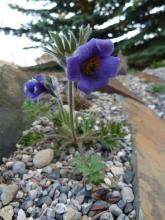
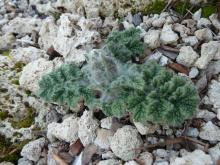
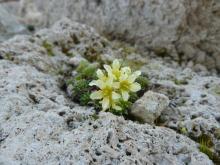
Primula elatior ssp. meyeri; a modest bloom on Douglasia montana (the flowers are darker pink than the photo shows):
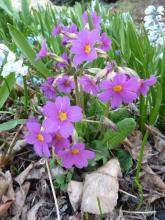
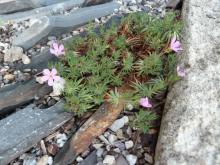
Re: What do you see on your garden walks? 2012
Draba ventosa; Potentilla nivea - as the buds begin to break, the petals appear to be orange (from the orange tip of the bud), but open yellow with an orange spot at the base; Tulipa tarda; Sanguinaria canadensis:
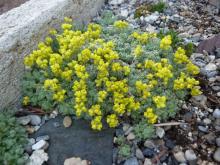
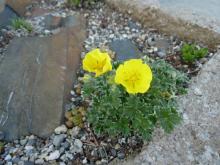
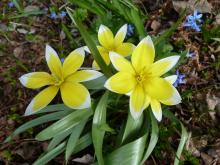
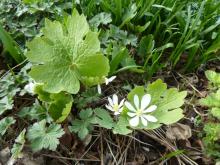
Primula rusbyi; I have almost missed Adonis x amurensis 'Fukujukai' - here's the tail-end of bloom; Pulsatilla pratensis, from seed a couple of years ago: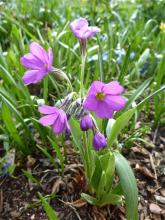
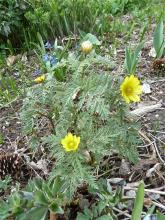
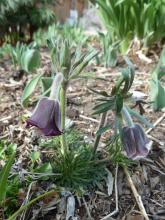
Hepatica nobilis 'Rubra Plena'; Vitaliana primuliflora v. cinerea: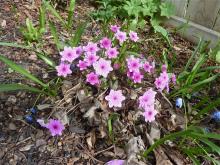
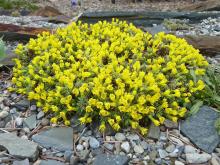
Re: What do you see on your garden walks? 2012
Bundraba- I like the juxtaposition of the Gentiana with the Rhodo :)
Rick- Iris reichenbachii is very sweet! native Dodecatheons will probably start in a couple/several weeks- we are at that odd stage where only a small handful of the very earliest wildflowers have started, but in a few weeks there will be many!
Todd- nice woodland- what sort of light does this planting get?
Lori- especially like the Tulipa turkestanica and Eremostachys :)
Re: What do you see on your garden walks? 2012
I should have bought a C. nobilis when I had the chance! Lori, you are pretty much smack on with me, although my P. unifolia is not open yet.
Cohan, that woodland garden gets morning sun but afternoon shade. It can get pretty dry in summer as the large Philadelphus there sucks every bit of water.
Re: What do you see on your garden walks? 2012
It's nice to revisit spring over again, with Todd.
Moving along, Calochortus (reliable small CV) and Iris x Dardanus
Charles Swanson MAssachusetts 6A USA
Re: What do you see on your garden walks? 2012
What beauties you all show! Here things don't grow - or are damaged by strong winds. Yesterday we had the second gale in three days. It's more like late autumn or winter weather.
I managed to sneak out an hour yesterday between the storms to take a few pictures and look for damage.
An edible mushroom but toxic if you don't prepare it correctly (Gyromitra esculenta). This dicentra (Ichtyoselmis macrantha) does good in the shade of the trees so does the Hylomecon vernalis (syn japonica). Corydalis nigro-apiculata grows among small shrubs and is completely hardy often starting growing midwinter without damage.
The first peony to flower is P. mairei. It is almost at schedule but all the rest of them are very late this season. Many rhododendrons have suffered in the strong winds and lost buds and flowers. Some are completely defoliated too from the hurricane last winter. However quite a few manage to flower still, here is Rh cinnabarinum Roylei. The banana plant does actually grow (in a pot) outside in the cold weather but the leaves are damaged although it sits in the most sheltered place I have!
Re: What do you see on your garden walks? 2012
Wish I could grow cinnabarinum in Newfoundland...orange rhodies are so rare!
Re: What do you see on your garden walks? 2012
Wonderful primulas, Todd.
Bundraba - I have killed several Erinacea pungens while waiting for them to bloom. This is my first success. Patience pays! Have several more in the garden still in the non-blooming stage. They do seem to take a few years to settle in and do their thing.
Re: What do you see on your garden walks? 2012
Lots going on in all those pics :)
Trond- not too bad considering the conditions you mention!
Re: What do you see on your garden walks? 2012
I don't know if this is east to west west to east or whatever. There is a bit more work and less doting as the fecund season approaches.
Photo1 is Sakurasoh grown from NARGS seed. Aubrieta is in the background.
Photo2 is Lewisia pygmaea I bought mail order years ago (probably SiskiyouRPN). It has seeded about joyfully. In fact there are other Lewisias seeding in here: my little Lewis Meadows -which I hope to expand upon!
Photo3 is our native Anemone quinqufolia, a delicate thing that grows in the mountains near by.
Photo4 is Trillium cuneatum. I got it from Potterton and Martin years ago.
Photo5 is the very dainty Sand Myrtle.
Photo6 is R. 'Scintillation'. Never before has it bloomed! Global warming? Yes!
photo7 is Areneria (Minuartia) obtusiloba native to the Rockies. This is a top rate Sandwort.
Photo8: Great gobs of 'Blue Ridge' Phlox! Imagine this carpeting an acre of woodland? Its one of two plants I got from Logee's (1995?) before I knew there were dedicated sellers of alpine plants. The other was Muehelenbeckia axillaris, which I still have too.
Photo9 -just for fun.
photo10; It's just a wonderful magic carpet ride, a color cosmos, sublime admiration.
Re: What do you see on your garden walks? 2012
Lots going on in all those pics :)
Trond- not too bad considering the conditions you mention!
Yes, fortunately I have always some spots that is not exposed so much to the elements ;)
Nice weather today but rain and cold the next 3-4 days :(
Bundraba, you have a impressive wide range of plants! I'm envying you the 'Blue Ridge'!
Does the Anemone quinquefolia set seed? I'm interested in swapping ;)
And Todd, here are some more rhodos, not all orange though ;) Labels lost long ago as usual.
Re: What do you see on your garden walks? 2012
I just have to squeeze in a few more....
Photo1 is one of the treasures of the Blue Ridge Mountains. Unlike our puny little local Houstonia, this one is hefty and takes full hot sun well. I see the NARGS annual meeting is down there next year. This wondrous region is fully worthy; enjoy it.
Photo2: This blooms and sets a few seeds most years but never have I seen it like this (there's just gotta be a reason!). Seed goes on the exchange as Packera ex. Red Mountain Montana. I became intrigued by these on my first (plant) visit to the Rockies; every mountain range seems to have its own one. I seek those that are stoloniferous rather than singular so that they may be made good and perennial. I'd also like a good orange! This is one of the finest small silver foliage plants in my garden -if not THE finest. It may be P. paupercula that is native here, so this is not entirely without precedent. There's also Pediocactus in the photo.
photo3 is a little Pussy Toe (Antenneria) that I found on Bald Ridge. It is a cushion former. The leaves have a distinct diamond shape. It grows among the likes of Eritrichium howardii and Astragalus kentrophyta so I don't expect easy and immediate success, but who knows? A. umbrinella is the only name I've seen that might be it.
Trond; yes variety is a good deal of the fun. It makes for an interesting garden and each plant is so interesting too in how it responds to various conditions etc. I sometimes think that after getting to know a plant well -I know its native environment too -even though I may have never been there. A small bed of Lewisias, for example, can nearly transport one to a High Cascade ridge, if one gets right down into it
Re: What do you see on your garden walks? 2012
I am attaching some pictures i have taken yesterday. The weather is extreme for the last 3 days.The daytime temperature is between 20C-26C.The plants are sulking at this condition
Krish
Re: What do you see on your garden walks? 2012
Krish, It looks like you are working with the peat stuff Saxifrage technique I've espoused for years! You are in New England? That vertical placement might get ya though. I find it hard to keep really slow growing things from anchoring in properly, at least without a ledge to sit on; or some batter to the wall. Good luck!
Re: What do you see on your garden walks? 2012
Hi Bundraba
the sax is there for two years.I got as rooted in tufa from wrigtman.Two others I got destroyed by birds.They picked the branches and left them on the ground. This spring that two are also coming up nicely .The cuttings I got from the destroyed pieces where rooted and kept in tufa.Two weeks ago I kept them near a small stream of water. They look very happy.
Krish
Re: What do you see on your garden walks? 2012
Ptilostemon afer and Echium russicum
I noticed the developing seed pods of Saruma henryi today. They are interesting, too.
Re: What do you see on your garden walks? 2012
I had forgotten to post the open Clematis ochotensis. It bloomed 20 April:
Notice the peculiar bent edges of the petals. I really like that. The flower color is actually a shade darker than the photos.
Re: What do you see on your garden walks? 2012
Rick, the Draco is native of Norway although I have never seen it! I like the flower of both your Clematises. At home only the alpine types have started flowering. (I am at my summerhouse now - long weekend due to the "National Day" May 17th.) I like the Echium too. Have seen pictures of it from the steppes. And Saruma - I've given up growing it due to slugs :(
Re: What do you see on your garden walks? 2012
Catching up again...
Pulsatilla turczaninovii: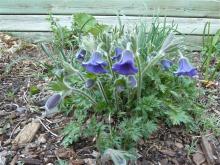
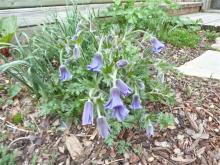
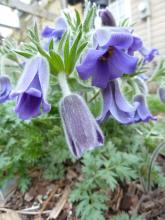
Fritillaria meleagris - they seed loosely throughout the back yard but this bunch made a nice arrangement: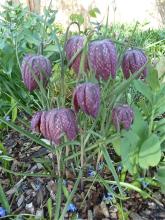
Re: What do you see on your garden walks? 2012
Progress on the flower stalk of Eremostachys speciosa: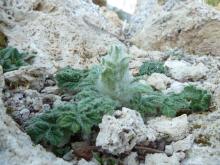
A very mealy little Primula scotica... unfortunately the flower is somewhat damaged: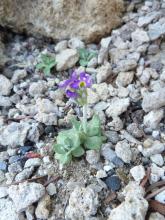
First blooms on Eritrichium pauciflorum ssp. sajanense: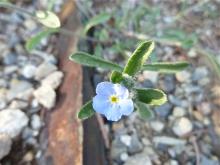
Dracocephalum palmatum: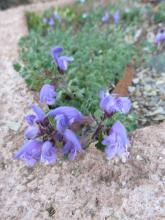
The usual heavy bloom on Pulsatilla vulgaris 'Papageno':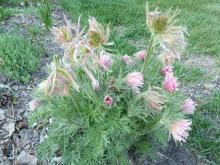
A number of young, self-seeded Pulsatilla vulgaris: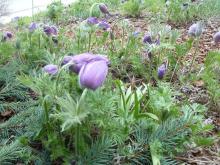
Re: What do you see on your garden walks? 2012
Echinocereus viridiflorus; Orostachys minuta and a Cryptantha from the Wildcat Hills in Nebraska. Two of four flowered this year and promptly both rotted! The two remaining are smaller and in somewhat different culture.
Lori; I'll have to remember to look for the Pulsatilla with the unpronounceable name!
Re: What do you see on your garden walks? 2012
Krish, It looks like you are working with the peat stuff Saxifrage technique I've espoused for years! You are in New England?
Bundraba, Krish is in Saskatoon, Saskatchewan, zone 3... a far cry from New England. :)
Re: What do you see on your garden walks? 2012
Lori, of all your wonderful plants I'll say that Pulsatilla turczaninovii takes the prize ;)
Been for a little trip today. First we took the small bat round the island (2.5km x 0.5km), then we took a walk on the only "road" that is on the island. Half of the island was farmed once and have a kind of track for the small tractor they used. Now only sheep graze the meadows. Fortunately they are still on another island therefore we can enjoy the blossom of early summer.
The crab apple (Malus sylvatica) and Crategus monogyna are still in flower. However, it isn't easy to distinguish the wild apple from garden escapes.
Geranium sanguineum has just started flowering and so has the weed G. molle. Along the track and on small ridges and banks Saxifrage granulata dominate.
Re: What do you see on your garden walks? 2012
It is always nice to find it although it is rather common, the blue Polygala vulgaris. Polygonatum odoratum has a nice scent, you can discern it from a distance.
Also blue violets like this Viola riviniana dot the woods everywhere at this time of the year. The old pastures are still filled with Primula veris but the orchid Orchis mascula is almost disappeared due to the sheep's grazing.
Re: What do you see on your garden walks? 2012
What a spectacle that Eremostachys speciosa is! Like a tiny water fountain with all that white "cotton candy". Great stuff, Lori, Trond and Bundraba.
-------------------------------------
Penstemon grandiflorus blooms nicely now. These are from seed collected in Isanti County, central Minnesota. I really don't see any difference from this locality, though. They seed into the lawn sometimes.
Syneilesis aconitifolia, and S.aconitifolia, Hosta nigrescens, Epimedium seedling, Podophyllum hexandrum, Iris cristata.
A yellow leaf creeping veronica, very nice even though I don't know the name. Thalictrum aquilegifolia.
Re: What do you see on your garden walks? 2012
Nice Penstemon! Seems you have summer Rick! Here it is still spring ;)
Some plants from the "garden" at our summerhouse. Most plants grow as they like here. Almost no weeding ;D
I've planted several Narcissi and tulips. Both the roe deer and the mice like tulips but Narcissi are left. Here are however a rare tulip (an unnamed species) and a lateflowering Narcissus.
Omphalodes verna do spread a little but go dormant later in summer. All the rain this season has been good for the moss!
Once I planted 3 different Primula cv here, one white, one red and one yellow. Now they have done some crosses of their own.
Re: What do you see on your garden walks? 2012
It's lovely to see what's going on in your areas, Trond, Rick and Bundraba! So glad you have joined us, Krish - looking forward to more scenes from your garden! :)
First blooms on Potentilla frigida, wild-collected in the Walliser Alps (NARGS seed):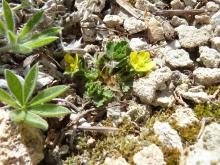
Bloom starting on Phlox multiflora: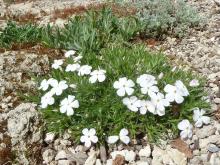
This is way beyond my limited photographic skills to capture, but these are the airy flower stalks of Androsace septentionalis, where they have been reseeding themselves in a trough!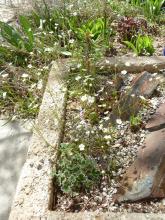
A bit of bloom on Silene acaulis, also in a trough: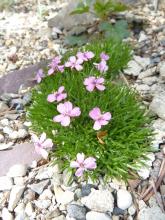
Re: What do you see on your garden walks? 2012
I'm working with different types of rock and different soil profiles. I love crevice gardening! The white garden (Light Bridge;a distant range of spectacular snow covered peaks!) is at the very western end of the Great Cordillera and was built in 2010 (there is no train yet). Sprinkled here and there with little treasures; it will fill up fast! The Yellow daisy is from the Wallowa Mountains and is unprecedented here. Never before has anything like this lived long enough to bloom naturally; and from seed too!
Here's something that could be more widely grown. I have two collections of Erigeron flagellaris -this one is from the Abajo Peak area. It is actually a bit too vigorous grown in a warm raised bed, but given space, it could really be an asset. The other is planted by the road where it doesn't bloom as well but it has space to make a nice compact mat.
Photo5 is a seedling to the effect of Lewisia 'little plum' or some such. It seeds strongly here and they don't apparently vary. L. 'pinkie' is in front. It makes a nice dome of leaves but blooms rarely.
Re: What do you see on your garden walks? 2012
Looks terrific, Bundraba!! :o :o Love the different geologic terrains. ;D Well, I guess the train would add historical accuracy, but I draw the line at a miniature ski slope and resort in every valley... gotta maintain some wilderness! ;D ;D
What kind of stone is the white garden made of?
Love the daisies... would the yellow one happen to be Erigeron linearis? I think the provenance would fit.
Re: What do you see on your garden walks? 2012
Lori, E. linearis is one of them but there's another from that region. I've been trying all day to recall it! Probably just a bit of research needed. The stone might simply be called Shelburne Limestone from Shelburne Limestone Co. One very nice thing about this quarry is that they provide a data sheet so we know pretty much what is in the rock; in this case 93% Calcium carbonate. There is a trace of Magnesium, the green schist (serpentine) shows and adds a touch of mystery to this already beautiful stone; and there is some Iron. I've placed it in my very acidic environment; so that and acid rain; I figure it will all disappear in a couple hundred years; fizzzzzz. Pretty cool to think about. On the other side of this quarry is a much grayer stone probably containing more Iron and there are a few striking porphyries of a brick red color. How it all came to be boggles the mind! The Serpentine becomes very apparent just a bit to the east on the upthrust of the Green Mountains. The front rockery is of Plattsburgh stone which is fossiliferous. I don't think the mix of color is everyone's cup of tea -but, for the sake of alpine gardening, that stone just could not go unused! Vermont is, or was, also a big producer of white marble.
Re: What do you see on your garden walks? 2012
Lori; I'll have to remember to look for the Pulsatilla with the unpronounceable name!
Well, I always collect seeds, so just remind me!
Re: What do you see on your garden walks? 2012
When do you harvest the rhubarb, Lori? I used to make soup of mine. It was a bit bigger though ;D ;)
Nice collection as always!
Re: What do you see on your garden walks? 2012
When do you harvest the rhubarb, Lori? I used to make soup of mine. It was a bit bigger though ;D ;)
Thinking on that a bit, guess a bit (a very small bit) of zing to something like cold cucumber soup might actually be good(!)
An excuse to post this pic: our drought that lasted from September through April finally broke a week or so ago. You can see how the vegetable rhubarb has responded with the more normal leaf size. However, still not quite as large as they usually are this time of year...
To the right of the rhubarb is a trough with Coryphantha (Escobaria) vivipara from the Rapid City area of South Dakota. It bloomed a few days ago.
Re: What do you see on your garden walks? 2012
More news from my little Lewis Meadows. My favorite glowing salmon colored L. cotyledon is taking the year off but this
white one is doing well. The situation is sandy, fairly moist and I doubt there is any lime or clay. Cold wet does not seem
to bother them but they suffer warm wet. They'll also grow in a mix of peat and (Plagioclase?) Granite if it is moist. I've
had these for over a decade. Sakuasoh, Aubrieta and Aetheonema in background.
Re: What do you see on your garden walks? 2012
When do you harvest the rhubarb, Lori? I used to make soup of mine. It was a bit bigger though ;D ;)
Thinking on that a bit, guess a bit (a very small bit) of zing to something like cold cucumber soup might actually be good(!)
Hope you did understand; I would never eat a gem like Lori's Rheum. However mine is - or rather was, I've dug it up to make room for something more precious - huge. Rhubarb is excellent as soup or juice if you are thirsty ;)
Bundraba, your rock garden is marvellous!
Re: What do you see on your garden walks? 2012
Krish, It looks like you are working with the peat stuff Saxifrage technique I've espoused for years! You are in New England?
Bundraba, Krish is in Saskatoon, Saskatchewan, zone 3... a far cry from New England. :)
sorry Bundraba I forgot to answer about my location. Thanks Lori for that. Like Lori mentioned Saskatoon is very cold and goes upto -40C in winter.Today it is raining here non-stop .
Re: What do you see on your garden walks? 2012
I was trying to highlight the previous posts but it did nor work.
Moderator note: I fixed it for you, Krish! I think what you wanted to do was not to highlight, but instead to quote from that other posting. The easiest way to include a quote from any other posting is to go to that posting, and click on "Quote" in the upper right. That will open a reply box for you, containing the contents of the other posting as a quote. You can then delete part of the quote, say if there was only a sentence or two that you wanted to reference, as long as you leave the opening bracketed phrase, and the end bracketed phrase, unchanged. Then it will come out showing "Quote from...:", with the grey highlighting that you see in the post above this one. :)
Lori
Re: What do you see on your garden walks? 2012
It's been a while since I posted...been busy putting in a new shade garden and painting the deck. Here are some of my current woodlanders.
Re: What do you see on your garden walks? 2012
Everything is looking very green and lush, Todd!
Re: What do you see on your garden walks? 2012
I was trying to highlight the previous posts but it did nor work.
Moderator note: I fixed it for you, Krish!
Thank you Rick.
Re: What do you see on your garden walks? 2012
Some great plants Todd - oh that we could grow primulas like that! I particularly like the ranunculus and pulsatillas.
Trond I've never heard of making rhubarb soup? Rhubarb crumble is excellent though!
Re: What do you see on your garden walks? 2012
Some great plants Todd - oh that we could grow primulas like that! I particularly like the ranunculus and pulsatillas.
Trond I've never heard of making rhubarb soup? Rhubarb crumble is excellent though!
At home my mother made crumble, soup or mesh (is it the right word? - soup thickened with flour -). Now we use rhubarb as dessert soup with sugar and milk or as juice. Very nice in hot weather ;)
Re: What do you see on your garden walks? 2012
Todd, seems summer has arrived at your place - some plants of yours are more advanced than here!
Does the Ranunculus survive outdoors?
Re: What do you see on your garden walks? 2012
Attractive, to me, though a bit of a thug, is this Claytonia californica - Mine's Lettuce. Not sure how it got into my garden. Fran
Frances Howey
London, Ontario, Canada
Zone 5b
Re: What do you see on your garden walks? 2012
Krish, I should have noted that your introduction mentions your location. Frances; I found something like that miner's lettuce in my front garden this morning; an odd thing. This won't be the first time that some strange little weed has occurred in my garden. I sometimes think that variety spurs yet more variety; or, maybe it's something the birds want there? They watch, you know. We plant; they plant. We pull weeds; they root about too.
Re: What do you see on your garden walks? 2012
Boy, miss a few days with busy-ness, then no internet friday thru monday night, and there is no cactching up ;D
I can hardly find time to look at the pics, nevermind getting around to mine...lol
If I'm still in the right thread, there was a lovely Ranunculus (Todd), something I liked in Trond's walk, though I can't remember what...lol.. and I'm amazed Lori's Androsace septentrionalis are already flowering! Bundraba, Krish, et all-- so many lovelies :)
Re: What do you see on your garden walks? 2012
An advantage of heading up our Chapter plant sales committee: at the end of the sale, I decide what remaining plants are "worthy" of holding over to the next sale. Often I will take the orphans home and grow them on through the summer or another year. Like this Clematis integrifolia:
Any guesses as to what this is?
Bless its little heart, blooming in a little styrofoam cup!
Anemone multifida 'Annabella Deep Rose'
Re: What do you see on your garden walks? 2012
Nice orphans, Rick- the Clematis is especially elegant, and nice colour on the Anemone :) I think I got seed of a similar, hope its still good :-[
Re: What do you see on your garden walks? 2012
Attractive, to me, though a bit of a thug, is this Claytonia californica - Mine's Lettuce. Not sure how it got into my garden. Fran
Frances Howey
London, Ontario, Canada
Zone 5b
Is this a distinct species? It looks like Claytonia perfoliata.
Re: What do you see on your garden walks? 2012
Don't see it in the USDA Plants Database, but I've learned that there are different subspecies of C. perfoliata:
http://plants.usda.gov/java/profile?symbol=CLPE
...and in FOA: http://www.efloras.org/florataxon.aspx?flora_id=1&taxon_id=242415745
I grow a variegated form (picture).
But, why are there so few of the North American Claytonias which are in cultivation/ available as seed? The only ones I've managed to get are C. virginica and C. megarhiza.
Re: What do you see on your garden walks? 2012
It's a nice time in the gartden which is about to go blue with Moltkia petraea. Some eriogonums in the crevice gardens are in bloom now.
I like the foliage as much as the flowers
Re: What do you see on your garden walks? 2012
Now that's talk'n to me! Dianthus alpinus from SPARQ/QARGS seed (photo1). The other is Potentilla thurberi, a rather large
plant for the alpine garden but the flower color has heart.
Photo2 is the Blue Mist Penstemon (P. virens).
Photo3; looks like a Chocolate Lily (Fritillaria Camschatensis); but I've planted everything else.
Photo4: Mr. Toad has made himself a nice, cozy toad-hole in the rather prickly 'Pic-Carlit' Fescue: smart toad!
Photo5: Saxifraga; There is Heuchera sanguinea in here and once there was a daisy (one of the Townsendias) that really made
this scene magic.
Photo6 is Geranium richardsonii; a native to North America.
Photo7: This is cute. It doesn't bloom much but cute when it does.
Photo8: Claret Cup.
Photo9: Saponaria rubra.
Keep walk'n!
Re: What do you see on your garden walks? 2012
I like that garden scene in photo 5 very much - so nice to see plants growing together like this. The penstemon reminds me how striking some of these blue species are - 'Blue Mist Penstemon' has a real ring to it. We used to try a lot of these from seed but our warm and sometimes wet summers were not always to their liking. I really should try again.
My experience of loniceras is very vigorous climbers and huge shrubs! That little plant in Anne's garden looks a real delight by comparison.
Re: What do you see on your garden walks? 2012
An advantage of heading up our Chapter plant sales committee: at the end of the sale, I decide what remaining plants are "worthy" of holding over to the next sale. Often I will take the orphans home and grow them on through the summer or another year. Like this Clematis integrifolia:
Any guesses as to what this is?
Rick, can't understand that nobody wants these?? They hadn't been leftovers at our arrangement!
The unknown one reminds me of something I've seen - a Campanula?
Re: What do you see on your garden walks? 2012
...and alot of gems from Anne and Bundraba!
Re: What do you see on your garden walks? 2012
Rick, can't understand that nobody wants these?? They hadn't been leftovers at our arrangement!
Actually, it was only the clematis pictured here that was a leftover, not the others. A couple people brought several each, so there was quite a few to choose from.
The unknown one reminds me of something I've seen - a Campanula?
You're the only brave guesser, Trond.
Its a fuzzy bunch of young Martagon lily buds! (seed grown, of course. ;D)
Re: What do you see on your garden walks? 2012
Rick, how many people attend such Chapter plant sals?
A lily! You fooled me there, Rick! But I have seen some campanula with similar leaves ;D And actually I have martagon lilies in my garden but can't remember that they are so hairy! - or should I say hoary ;) Do you know the flower colour?
Re: What do you see on your garden walks? 2012
Nice to see the Geranium richardsonii, Bundraba, a common and beloved (by me) native here.. yours doesn't look quite typical of local forms, though I can't quite put my finger on it, and it could be just lighting and angles...most here, though, are not pure white like yours (I am watching one little colony though, and will try to propagate it), usually have subtle or not subtle pink/purple veining on the petals
Re: What do you see on your garden walks? 2012
So I was took a walk in the garden and caught a flash of color out of the corner of my eye. ;)
Re: What do you see on your garden walks? 2012
Oh My, John! There is a whole LOT going on there! :o :o :o
A "spot" of color is way too modest. You could start a new thread on just that garden scene alone! So the striking red-orange is... what?
Rick, how many people attend such Chapter plant sals?
Ya know, I know we have kept count (or tried to) in the past, but I can't put my finger on it. For the spring sale, I am thinking about 50 from the Chapter members plus whatever we can pull in from the public. We hold it in a public park, but the shelter can't be seen from the connecting road or parking lot.
A lily! You fooled me there, Rick! But I have seen some campanula with similar leaves ;D And actually I have martagon lilies in my garden but can't remember that they are so hairy! - or should I say hoary ;) Do you know the flower colour?
Most martagon buds are not that fuzzy, although some are even more so. Flower color on that one is a darker mauve-pink. Here is the same one, four days later:
It will be first bloom for this martagon seedling this year:
Re: What do you see on your garden walks? 2012
Rick I assume you are asking about the orange in the bottom, center of the first picture. The two orange spots of color.
If so, that is an orange red Echinocereus triglochidiatus. Here is a close up from a couple of years ago.
Re: What do you see on your garden walks? 2012
Cohan, the Geranium comes from the Bighorn Mountains quite a bit south of your area. So far all of the seedlings that pop up have been white and I'm wondering if it will cross with any of the other Geraniums in the garden.
John, Great stuff. I'm still trying to do that here!
Re: What do you see on your garden walks? 2012
My goodness, I am hopelessly behind... been wanting to respond to this topic numeropus times, and I do enjoy seeing everyone's fine plants and garden views (I like the toad pic). After nearly 3 weeks of traveling and cramming for various"events" at work, I have a breather here on a holiday weekend (Memorial Day here in the USA).
Here are three view of a trough at the end of my driveway, backed up by a garden shed. The winter-tiny foliage of Alyssum oxycarpum gives away to a small billowing cloud of yellow flower. I didn't notice last year, but today I noticed an unusual characteristic of this species, the flowers stink. When I kneeled down to take photographs, I detected the smell of skunk, and I thought to myself "oh no, there might be a skunk moved in under my garden shed", but then realized it was the Alyssum! What an unusual mal-aroma for an Alyssum to have! Next to it, in the neighboring trough, is Delosperma 'Tiffindell', now in its third year (seems perfectly hardy). In the last photo, I show a close-up of two plants near the Alyssum, Globularia repens 'Nana' on the left (from Wrightman's Alpines ), the most minute and concise leaves which are near shiny black all winter, but no flowers this year (only 2 flowers last year), although I would grow it just for the foliage, and Erigeron scopulinus in the center (from Peter George), making a dense mat, but also no flowers this year, only a smattering of flowers last year.
Re: What do you see on your garden walks? 2012
Do skunks really smell as bad as people say? I am not sure if I dare approach a little Alyssum I have in the front garden! Apparently some teucriums are pretty malodorous too. Curious how once someone tells you then you are tempted to test it for yourself - most people go for roses!
I am interested by the comments about Globularia repens 'Nana'. I have this too and it is a super foliage plant, but like the normal form seems very shy flowering. I rather like this genus even so and also grow G. spinosa and probably my favourite incanescens, which I have just managed to find again from seed.
Re: What do you see on your garden walks? 2012
Catching up, yet again...
Paeonia anomala, the first to bloom this year: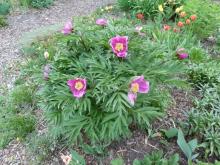
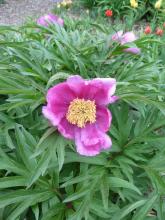
The little bulbs are done (except for muscari), and the narcissus are having their time: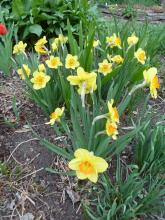
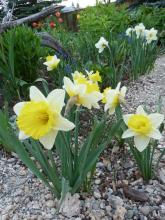
More Pulsatilla turczaninovii - I know I keep showing this one but it is fabulous! Thank you for the seeds years ago, Rick!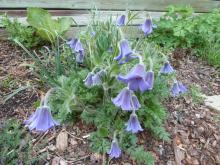
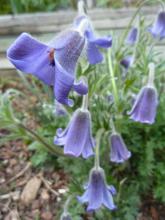
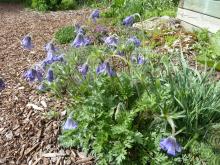
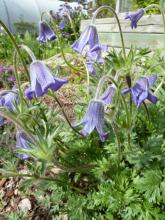
Phlox multiflora, again... but this time, it's more "multiflora". ;D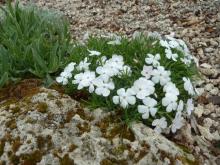
Myosotis decumbens: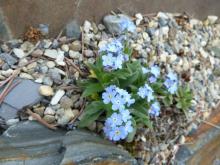
Re: What do you see on your garden walks? 2012
Euphorbia capitulata... showing somewhat more evidence than usual of a rough winter: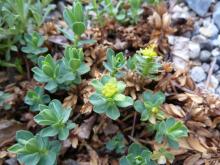
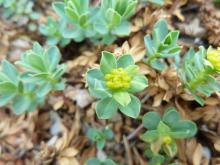
Paeonia tenuifolia 'Flore Pleno', ready to roll: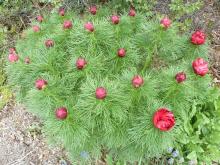
I think this is Arnica cordifolia... I hope it's not so invasive as another Arnica I'm currently trying to eradicate, that just romps around and never blooms. (Will I ever learn? :rolleyes:)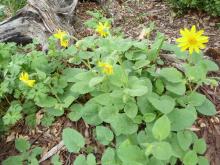
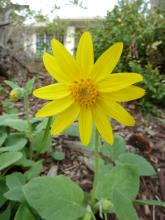
Pulmonaria vallarsae 'Marjerie Fish':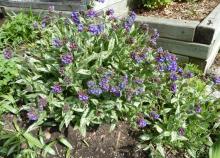
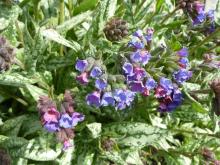
Vanilla-leaf, Achlys triphylla, just leafed out and starting to bloom: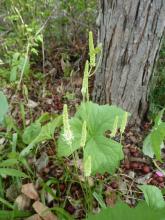
Re: What do you see on your garden walks? 2012
Primula polyneura... or so the seed packet from years ago said anyway: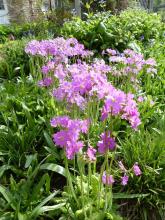
Primula x juliana 'Jay Jay', battling for space among the bulb foliage: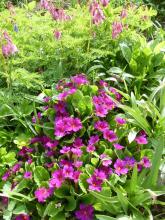
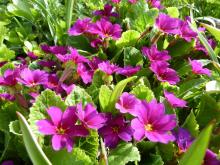
Hacquetia epipactis with Dicentra eximia (? - I always mix this up with D. formosa?):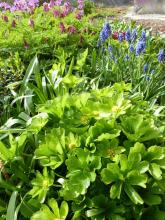
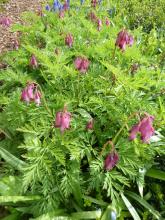
I never imagined I'd be having to weed out Ligularia seedlings but look at this!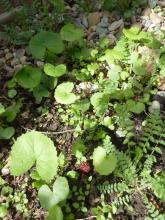
Re: What do you see on your garden walks? 2012
Dianthus microlepis and Gentiana verna: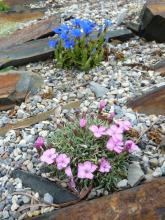
Lewisia longipetala, starting to bloom: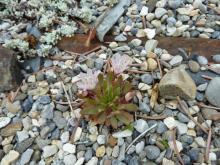
Paeonia mlokosewitschii will have 6 flowers this year!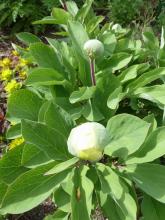
Euphorbia polychroma 'Bonfire':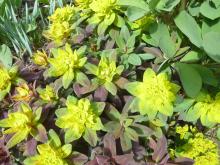
Update on Eremostachys speciosa, looking more and more intriguing: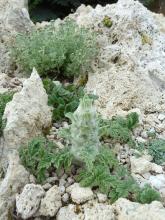
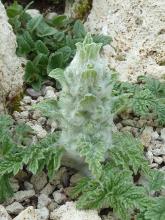
Re: What do you see on your garden walks? 2012
Stuart has been referring to this as horseradish ( >:() but it's actually Ligularia macrophylla: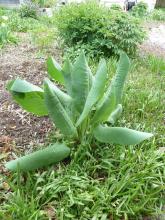
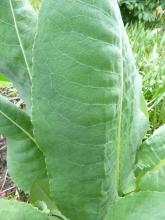
Aubrieta canescens: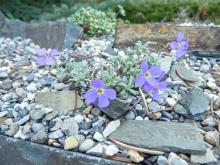
Lunaria perennis and Lathyrus vernus gracilis: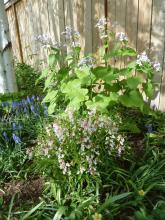
Valeriana montana, starting to bloom: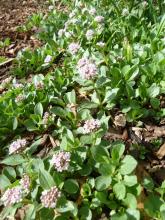
Cerastium alpinum ssp. lanatum, that managed to seed itself up in to a trough with some very prickly company: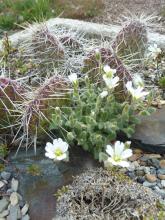
Anemone nemorosa 'Vestal':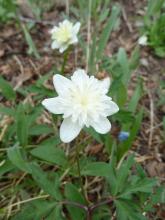
The last of Adonis vernalis: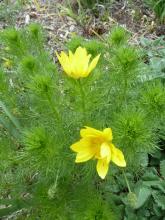
Re: What do you see on your garden walks? 2012
Monday morning greetings of Soapworts and Golden Heathers! The same Golden Heather; Hudsonia ericoides was photographed two days in a row. It will flame out quickly; new flowers each day falling apart before tea time.
I had this thought about the birds, and this one in particular as it is so elegantly colored, that they come to this garden to die (to breed, to steal berries, and to generally pester me); but; perhaps, simply, a cat got it.
Re: What do you see on your garden walks? 2012
It's kinda funny how the wind can whip around the Pulsatilla turczaninovii flowers and rearrange them permanently, until the next group of gales from a different direction rearranges them again. Almost like an Obedient plant's flowers, except they don't obey me! Your specimen, Lori, if the coloring is right on my screen, looks intermediary between my most blue flowered plant and a steel gray-blue that I used to have. (That one mysteriously died.)
Are you sure that is Alchemilla alpina?
Usually with a silver edge, aren't the leaves supposed to be palmately compound and not so heavily toothed?
Re: What do you see on your garden walks? 2012
Are you sure that is Alchemilla alpina?
Usually with a silver edge, aren't the leaves supposed to be palmately compound and not so heavily toothed?
Oh right, it's Alchemilla erythropoda. Thank you!
Re: What do you see on your garden walks? 2012
Wonderful pictures, Lori. Does the Myosotis decumbens stay small for you?
Re: What do you see on your garden walks? 2012
Lori, esp love the Euph capitulata and Achlys :)
I was surprised some bits of Haquetia I planted last fall just emerged in the last week/few days- so far behind some of the other things (Cory, Anemones, Dentaria)I thought they weren't coming at all, so I was very pleased to see them!
Bundraba- love the Hudsonia! I don't remember if I have seed from Kristl, or just thought about it...
Colourful bird!
Re: What do you see on your garden walks? 2012
Catching up, yet again...
More Pulsatilla turczaninovii - I know I keep showing this one but it is fabulous! Thank you for the seeds years ago, Rick!
Lori, you have loads of gems and interesting plants! But I agree, P turczaninovii certainly is fabulous! Is it possible to ask for seed if you have some to offer later?
Re: What do you see on your garden walks? 2012
Does the Myosotis decumbens stay small for you?
Yes, the elongated flower stems get to about 5cm max.
I was surprised some bits of Haquetia I planted last fall just emerged in the last week/few days- so far behind some of the other things (Cory, Anemones, Dentaria)I thought they weren't coming at all, so I was very pleased to see them!
Great news, Cohan!
Yes, I always do collect seed from whatever pulsatillas bloom for me, and I'll send you some P. turczaninovii when they are ready, Trond.
Too bad about the dead cedar waxwing, Bundraba... but at least it allows us a close-up view of the beauty. Cedar waxwings have been busy eating apple petals in our trees, and trilling their songs. Stuart managed to get a photo of some out the window... (fuzzy but better than any of my bird pics!)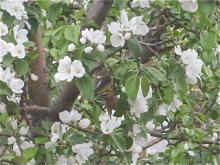
Arenaria kansuensis, with a few buds; this one is looking pristine but another specimen is half brown.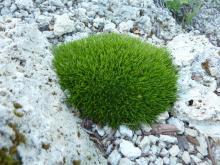
Re: What do you see on your garden walks? 2012
Two more nice irises :)
Interesting about the waxwings eating petals- that I haven't noticed, though our crabs/apples draw all sorts of other predatory attention- grouse eating fruit then buds in later fall, moose eating all tender stems in winter, etc.... I suppose if they just pull petals it wouldn't affect fruiting?
However, the waxwings do make a strong appearance as soon as any berries are ripe- I went out to harvest some Shepherdia canadensis on the acreage last year, only to hear the waxwings in the bush ahead of me, where they'd nearly stripped every bush to be found (and there are many, in numerous spots); they routinely clear saskatoons (Amelanchier) and Sorbus as well, usually almost immediately..
Re: What do you see on your garden walks? 2012
I'm with everyone else on the wonderful variety of plants pictured. The pulsatilla is especially nice; I have grown this in the past on the nursery but never had the chance to establish it in the garden - it is very distinctive and elegant.
I couldn't resist putting a picture of the daisies in our lawn - ever since we visited a friend whose lawn was almost all daisies in early summer we have tried to encourage them too. In the sand bed a new range of plants are flowering:-
Penstemon rupicola 'Conwy Rose' (a selection from Aberconwy Nursery in North Wales)
Onosma echioides. These I have always found short lived but hope the sand bed will be more to their liking
Hypericum cerastoides. A reliable and cheerful species. There are many very good alpine species in the genus
Triteleia ixioides. After the spring bulbs have done their thing this really comes into it's own in early summer
Thymus 'Peter Davis'. A striking thyme named for the renowned botanist. It flowers so freely we have trouble getting any propagating material from it!
Astragalus angustifolius. The only one of this huge and diverse genus that we grow at present, although I have young plants of many others coming on from seed. This one though (from Greece) is a good doer in the garden. Others I have found a lot more tricky.
Re: What do you see on your garden walks? 2012
Interesting about the waxwings eating petals- that I haven't noticed, though our crabs/apples draw all sorts of other predatory attention- grouse eating fruit then buds in later fall, moose eating all tender stems in winter, etc.... I suppose if they just pull petals it wouldn't affect fruiting?
No, it doesn't seem to affect fruit production (wouldn't mind if it did, as we always have far too many apples anyway). They just pluck and eat the petals, not the whole flowers or the stamens/pistils.
Re: What do you see on your garden walks? 2012
Surprisingly not flattened by the 3+ inches of rain we have had in the last few days, Allium moly:
Phyteuma orbiculare. Each flower is always subtended by one very long single bract.
A species Hemerocallis.I hadn't noticed before the small white protuberances at the end of the sepals that point forward. How odd...
Not a photo worthy of discussion, but I thought I had gotten rid of Penstemon pinifolius 'Mersea Yellow'. It is growing better now than when I tried to grow it! Second Pic: Pentemon whippleanus (thanks for the seed, Lori!)
Clematis integrifolia
Re: What do you see on your garden walks? 2012
Nice lawn Tim! One thing I like about our large mowed area (necessary to keep the forest from closing in), while it does have many weeds I'd rather be without- dandelions and clovers etc, I am very happy that its also full of wildflowers- right now lots of Viola adunca, fewer V renifolia, a couple of different Antennarias, some in flower, and Maianthemum canadense in bud..
The Onosma is very charming!
Re: What do you see on your garden walks? 2012
Thanks Cohan - I'd be happy to establish such a range of wildflowers in the grass. In part of the garden I am doing this with bulbs but it is quite a long term project (also saves on the mowing!).
Rick - is there much variation in Penstemon pinifolius grown in the US? We had a very robust form called 'Wisley Flame'. Here it is one of the most reliable penstemons in the garden but I have had the same poor experience as you with 'Mersea Yellow'.
Re: What do you see on your garden walks? 2012
Rick - is there much variation in Penstemon pinifolius grown in the US?
I nave no idea.
I have the species, too, growing right next to Mersea Yellow, and it does better, but not by a lot.
Re: What do you see on your garden walks? 2012
Tim, I can't take any credit for our 'flower lawn' --our yard was never really true lawn- before our first house here was built in the early '70's, this property was just a mostly wooded pasture area on one corner of the family farm- the native vegetation was never removed, though of course it was affected by the grazing livestock (which just passed through this small part of the native wooded pasture on the farm) and the later building and installation etc; over the decades since, the native plants on the acreage have spread to most of the acreage, mixed with grasses ( I confess to mostly not knowing which grasses are native and which are forage escapes or from my mom's early seeding efforts here) and common agricultural weeds..
Since taking over mowing when I moved back (I don't do all the mowing, but I'm the one who says- don't mow there!) I've encouraged the wildflowers more by leaving some areas around trees, shrubs and stumps to become little islands with more full grown plants, and try to enjoy the flowers more by mowing around flowering plants when possible, even if they will be mowed at other times...
Right now, of course, dandelions are hitting their peak, so there is more yellow than anything!
Re: What do you see on your garden walks? 2012
Tim, I like your flowering lawn too! I have just mowed mine - first time this season ;)
I also like the Onosma! If it is short lived, does it produce seed?
Rick, surprisingly I could do with some rain! It has been very dry here for some weeks - a dry (cold) wind from north suck the moisture out of everything and the layer of soil is thin.
Both Penstemons are nice. I have started trying new species now :)
Here are some of my peonies flowering now.
P rockii, delavayi and delavayi lutea, all from seed.
Re: What do you see on your garden walks? 2012
A few more: lactiflora(?), mlokosewitschii and obovata(?).
Re: What do you see on your garden walks? 2012
A walk in 'Cactus Park': Photo1: the green leafy thing just above Cerastium tomentosum is Campanula glomerata (which will bloom) growing through Phlox subulata which is past blooming. By now you may be thinking: thugs! But, this; bottom and right planting (The gravel area is newer); has looked pretty much just like this for ten years or more. The Plants are kept in check by furrowing between the mats. Apparently, The Campanula just runs around in there without too much malicious intent. At left is Stephanandra, which could be a problem soon if the scene is not to go much scaled upward!
And, at right there is a Teucrium (not yet blooming) which is dangerously welded into place. Can I trust it to be as nice as the Campanula as it swiftly eats ground?
At the bottom of photo2 is Sphaeralcea coccinea.
At the bottom of photo3 is Artemisia stelleriana; at the top is a bridal veil Spirea, the only plant in the photo that came with the house when I bought it many years ago.
In photo4 is Erigeron flagellaris and one of those rather fast Artemisias. The Colchicum will senesce in a not unpleasant way.
John; your "little spot of color" noted here. But the palette will be different and there won't be any Chollas.
At bottom of photo6 are the remnants of an ancient and formerly huge Astragalus angustifolius. Just up is a good Eriogonum from Abajo Peak in Utah; they don't all bloom like this and winter burn is an issue in the Northeast; but big bearded Iris do great in my garden not withstanding that these were photographed just before the storm!
To make short the story, this Iris was being extirpated from its former home as ugly. So here lives ugly (photo7).
Photo8 is an old planting of Allium moly, 'Tiny Rubies' Dianthus, Sedum aizoon (?), and Polypodium vulgare.
Here's a couple from 'The Rock': Soapworts and Allysum oxycarpum. Mark; you may want to check your shed (carefully) these A. o. don't smell like skunk!
Photo10; Convolvulus boissieri blossoms only last for a day, but I've seen this plant fairly covered with them. It will even set seeds here.
Re: What do you see on your garden walks? 2012
Love all of the mats of color! Your garden is a glory of color!
Nice cactus garden! Is that a clustering Pediocactus in the upper center of your bed? What ever it is, it certainly looks happy.
The buns and baby cactus in your last two photos are very nice indeed.
Great show!
Re: What do you see on your garden walks? 2012
I second John's comments; those last two pictures especially are really attractive - you can imagine them in the wild. Great to see gardening with alpines like this!
Re: What do you see on your garden walks? 2012
Great garden, MichaelP (nice to have a name :) Also nice to see the ways the plants interact (especially in a nice established garden like yours) as well as individual portraits..
Re: What do you see on your garden walks? 2012
You really have a nice garden, Michael! Some plants are familiar but some are not ;) Some do grow in my garden and a lot of them don't ;D I do not think they'll survive either :-\
Re: What do you see on your garden walks? 2012
I forgot to mention the peonies, Trond- nice! We have several oldish ones here, which are all more or less pink and more less fully double (quadruple?)while I like them well enough, I do appreciate some of the simpler ones, and peonies in any colour other than pale pink :)
Re: What do you see on your garden walks? 2012
Thanks, Cohan. Do you want some seeds ;)
Re: What do you see on your garden walks? 2012
Here's a couple from 'The Rock': Soapworts and Allysum oxycarpum. Mark; you may want to check your shed (carefully) these A. o. don't smell like skunk!
I can assure you, my Alyssum oxycarpum has flowers that smell skunky; I do believe I can tell the difference when sticking my nose in the actual flowers that the flowers are the source of the skunky scent, versus an aroma that might be eminating from under a shed, it isn't that difficult an observation. There are plant species (I know of some Allium species) where nearly identical plants, but from different known sources, will show different scent characteristics, one will be odorous, and the other will be inodorous.
Re: What do you see on your garden walks? 2012
Thanks, Cohan. Do you want some seeds ;)
You could probably guess the answer.... :-[ lol
Re: What do you see on your garden walks? 2012
Thanks all for the nice compliments on the garden walk.
John, yes it is a clustering Pedio. The center rotted, or began to and the thing split!
Tim, it is interesting that the two sections of the garden I posted last are so different and that both "themes" -dryland; and cushion steppe -are obviously to some degree doable here. I can't help but wonder how either would appear on a much grander scale.
Re: What do you see on your garden walks? 2012
I thought you might like to see what our garden looked like on the 1st of June 2012.
Not put names to the flowers, but none of them are particularly rare or recherché so I reckon all you experts will have no trouble recognising them.
http://s703.photobucket.com/albums/ww32/Owdboggy/June%202012/
Re: What do you see on your garden walks? 2012
You have a nice place, Palustris.How big is your property? And yes, I recognized most of the species ;)
Here are some pics from my (very untidy) garden yesterday:
I suddenly noticed that the asphodel (Asphodelus albus) had started flowering in a crab apple!
It is the shrubs that dominate: Rhododendrons, Pieris, Enkianthus(and peonies) . . . .
Re: What do you see on your garden walks? 2012
Michael, that is a beauty!
Palustris, I'll have to wait for a stronger internet time to check the link..lol
Trond- some nice views! I only have a vague idea at best of what I am seeing, esp in the last view, but nice! Better shrubs dominating than the sea of yellow I have right now ;D
Re: What do you see on your garden walks? 2012
Beautiful, Trond!
Draba kitadakensis and Thymus neiceffii: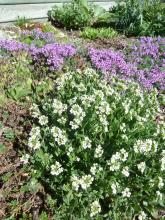
Hellebore, that's been blooming for a long time now: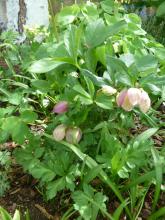
The narcissus are down to the last few... a trio of Narcissus poeticus: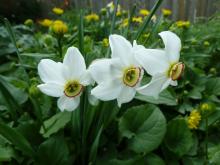
Omphalodes verna and Rheum palmatum var. tanguticum: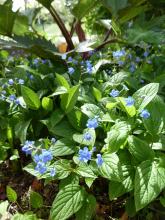
Erigeron pinnatisectus: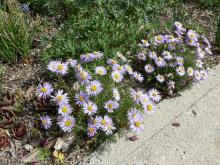
Re: What do you see on your garden walks? 2012
This time of year is so wonderfully fragrant, with the trees in bloom...
Malus 'Royalty':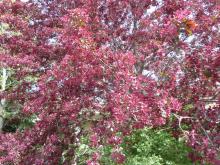
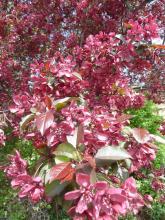
Sour cherry, Prunus cerastus 'Evans':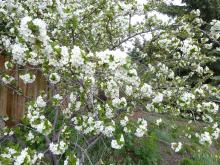
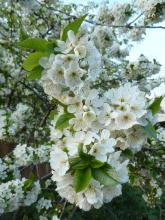
Chokecherry, Prunus virginiana 'Schubert' (the leaves turn purple later on):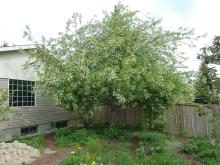
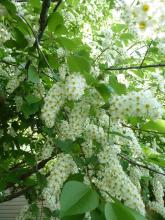
Re: What do you see on your garden walks? 2012
Clematis alpina - a seedling ex. 'Pamela Jackman' that turned out to have white flowers: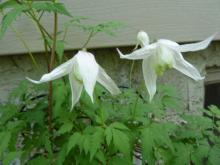
Re: What do you see on your garden walks? 2012
Lori, you certainly have some beauties yourself! And despite your later start you are ahead of me now. Your warmer days have brought you in front in great strides ;)
Here a cold desiccating wind from north makes it almost as cold as February :( As I have said before: We have two seasons, one long spring and one long fall mixed with a few wintry days almost anytime and a few warm days anytime from April to October.
Re: What do you see on your garden walks? 2012
After a couple of false starts from seed batches, I think I finally may have the real Pensteomon nitidus. I picked up a couple seedlings from our Chapter plant sale, and so far they look like the real thing. Lori, I hope they look as nice as yours or John's someday. :o
My supposed Penstemon pocerus seedling is blooming... I am very pleased, even though it is not procerus.
Re: What do you see on your garden walks? 2012
I would be pleased if I had a blue Penstemon! Last year I sowed several different batches of seed but all the seedling looked very similar though. I planted them out but none has started flowering yet.
Re: What do you see on your garden walks? 2012
Lots goong on there, Lori :) Love the Peony! Peonies here are maybe a foot tall, still red foliage post emergence..
Re: What do you see on your garden walks? 2012
My supposed Penstemon pocerus seedling is blooming... I am very pleased, even though it is not procerus.
Nice one, nonetheless, Rick! One would think it should be readily identifiable with the combination of serrated leaves and blue flowers? I'm sure Mr. Nold would know it right off!
Re: What do you see on your garden walks? 2012
I once had Penstemon nitidus with Tulip 'Little Princess'; absolutely sublime; both are now gone but the Penstemon, at least, WILL get tried again!
On June 1 I walked in the gardens of others. The first four photographs were taken at Cady's Falls Nursery: The next four at Rocky Dale Gardens; in my opinion two of the finest gardens in the region. The last two were taken from the ferry on my returning approach to Essex New York.
Re: What do you see on your garden walks? 2012
Beautiful gardens Michael, they look almost "English" ;D
Re: What do you see on your garden walks? 2012
Yes, very beautiful! Would love to take a walk there too ;)
I had a little walk in my untidy garden yesterday, and here are some of the plants flowering now (actually rhododendrons still are the dominant genus).
Allium triquetrum and the native ursinum do a good show in the shady woodland. They are rather common but their white flowers light up the gloomy forest floor.
In a more open place the dark Phyteuma ovatum and the purpur Menziesia ciliicalyx var purpurea grow together and on a dry wall another native, Sedum reflexum, soon flower.
Re: What do you see on your garden walks? 2012
I once had Penstemon nitidus with Tulip 'Little Princess'; absolutely sublime; both are now gone but the Penstemon, at least, WILL get tried again!
On June 1 I walked in the gardens of others. The first four photographs were taken at Cady's Falls Nursery: The next four at Rocky Dale Gardens; in my opinion two of the finest gardens in the region. The last two were taken from the ferry on my returning approach to Essex New York.
Hey Michael...I wish I had known you came to Rocky Dale Gardens!! I work there and would have loved to give you an official tour! The next time you make your way across Lake Champlain let me know, it would great to meet you. and I so agree the Rocky Dale and Cady's Falls are the best nurseries in the northeast!!
Re: What do you see on your garden walks? 2012
Michael- looks like a nice day for a tour of some lovely gardens!
Trond- nice things happening in your garden- love the Alliums- I've been slightly aware of some woodland Alliums, but don't have any yet- all I have is many square metres of A schoenoprasum!
Love the vignette of the Phyteuma and Menziesia too :)
Re: What do you see on your garden walks? 2012
Trond - great combination of phyteuma and menziesia with the fern in the background. Funny how you always wish for the plants you can't grow; I've always been fascinated by a lot of the smaller ericaceae and would love to grow, for example, Loiseluria procumbens, a great memory from visiting Iceland very many years ago. Now if somebody would write a book on these wonderful plants ...?!
Re: What do you see on your garden walks? 2012
I may have to ask for seed of A. triquetrum and ursinum, Trond. I am not too crazy about the angular stem, but really like the triquetrum flowers. I'll never know if they are hardy here unless I try them. Do they go dormant in summer?
Re: What do you see on your garden walks? 2012
In a more open place the dark Phyteuma ovatum and the purpur Menziesia ciliicalyx var purpurea grow together...
That's a very striking picture, Trond!
Re: What do you see on your garden walks? 2012
Thank you, folks ;)
I'll collect seeds, Rick. They have a tendency to stay green the whole summer and are often very early with leaves in spring in mild spells.
In a more open place the dark Phyteuma ovatum and the purpur Menziesia ciliicalyx var purpurea grow together...
That's a very striking picture, Trond!
Yes, Lori, you can see all the weeds!
Re: What do you see on your garden walks? 2012
A Penstemon seedling growing where a burgundy form of P. whippleanus and a pink form of P. arizonicus once grew.
A couple of afternoon's ago I walked out and saw this little spectacle and this wasn't the only Escobaria vivipara that decided it was a good day to bloom -like they all got together and discussed the best way to draw in bees.
A little bun cluster: Eriogonum flavum 'xanthum' (reclassified recently I believe), Dianthus haematocalyx subsp. pindicola, and Areneria species 'Wallowa Mountains'.
I wasn't kidding when I said I planted wheat. The blue flower is a very nice big bearded Iris. Now, as sometimes the artists critique of his own work is appreciated, notice the composition of this image -the wheat in the foreground vying with the iris in the center for attention; color, aspect and form. The whole creating an interesting vertical element in the photo. I took one with the Iris off to the side; but not as interesting. Note also the interesting rotation set up by the Penstemon in the first photo and carried through in the blue Aquilegia and other plants behind it.
It's been over a decade since I grew one of the little peas this well giving 2012 distinction as the year the little peas returned to my garden. This one normally lights up the roadside in Northwestern Wyoming and there, is probably capable of producing more than a few 'stop the car!' moments.
Re: What do you see on your garden walks? 2012
Today I took pictures of some plants blooming in the garden. Not as nice as Michaels.
Re: What do you see on your garden walks? 2012
Today I took pictures of some plants blooming in the garden. Not as nice as Michaels.
But they are special, just the same. Very nice, healthy, well grown plants, Krish!
Re: What do you see on your garden walks? 2012
Michael- I have seeds of some fancy heirloom wheat I bought to plant as an ornamental (and for any birds interested) It just hasn't happened yet!
Krish- the Dodecatheon are painting some ditches pink here right now- it always happens that they start and I see them from the car but am not able to make an excursion to photograph them until they are past their prime :( Hopefully this same wet weather that will keep me from getting out on the bike will keep them fresh, since its also chilly!
Re: What do you see on your garden walks? 2012
Very nice, Krish! It looks like your Primula vialii has access to the moisture it would probably want. How long have you had them there? I've had them survive a couple or three years only, in our dry soil (and have given up on growing it long ago)... I never bothered to create the environment it would probably need to give it a chance of longer term survival.
More mouth-watering photos from your superb garden, Michael! Keep 'em coming!
Re: What do you see on your garden walks? 2012
Here primula vialii is always shortlivedbut easy from seed.
Clintonia andrewsiana is in flower now, 50cm (1.6') tall.
Re: What do you see on your garden walks? 2012
Hi Lori the Primula vialli I got from Canadian Tire one month ago.It was in a sad state when I bought it.As soon as I planted at one end of the stream it was happy.The one next to it is Primula rosea I germinated from NARGs seeds last year.It grew well in a different section and had only one flower this year. I took a piece of it and planted near viali.
Re: What do you see on your garden walks? 2012
Now that is a sight for sore eyes Trond! I have tried Clintonia andrewsiana several times but never managed to establish it. It must like the cooler Scandinavian climate. Such distinctive flowers.
Re: What do you see on your garden walks? 2012
Now that is a sight for sore eyes Trond! I have tried Clintonia andrewsiana several times but never managed to establish it. It must like the cooler Scandinavian climate. Such distinctive flowers.
It definitely likes it where it is growing now, anyway. I had another plant - much smaller though but still it flowered reliably - but it was shaded out by a rhododendron. I have to keep an eye on this one as the neighbours are greedy and spreading . . . .
Here is the whole plant by the way, forgot to post it. I do like the leaves too! They have spots of shed petals from a rowan tree.
Re: What do you see on your garden walks? 2012
Leaves are very similar to our native Clintonia borealis, except ours seldom grows more than two or three leaves.
Trond, your stylophorum in the pic prompts an observation: I have always known S. diphyllum to look like this:
Isn't it interesting that such a wide variation in the wild occurs.
Re: What do you see on your garden walks? 2012
Another first in this garden for 2012; I was surprised and (extremely) delighted to find Aquilegia jonesii had suddenly pushed a flower! Ask not what is the blue glow in the center of obscurity: look it over! From seed collected in the Bighorn mountains in 2009.
Last bloomer Rhodo; Rhododendron chionoides backs up a firecracker Penstemon. These Penstemons like the Northeast USA. I have two sorts here and wish to improve seed set so that there may be more in the days to come. PEB's (Penstemon eating bugs) are one of the vial reproaches to my desire. The weather is, of course, another but our summer can be like that on the peaks of the Southwest where these naturally grow: fickle and apt to be wet.
Sempervivum ciliosum is a top rate wall plant IMO. This thing grows on air, and rock too.
And as the rock garden fades into summer: a mini-rose stands guard.
Peonies are a poor choice for acid sand but I plant them anyway. Four miles south they grow splendidly; something for geologists to fathom. Iris 'Super Ego' at hint in this picture is rather better here than the Peony but it is so nice when they get together. All the Peonys in my garden took a huge hit in the "spring" of 2011; they aren't aquatics. I lost, and probably will not replace, some rather nice tree peonies.
At the bottom of the picture is Liatris spicata. It will bloom later. The rock garden is going over but the garden season does not ever go over.
This is Vaccinium oxycoccus 'Wright Peak', a very choice ground covering plant. The Empetrum at the top of the photo is also from the Adirondack Mountains.
Campanula muralis, Thyme; a nicely colored form, and Aruncus aethusifolius.
Re: What do you see on your garden walks? 2012
Michael, you have some exiting plants! I think the peonies do good at your place to ;)
Leaves are very similar to our native Clintonia borealis, except ours seldom grows more than two or three leaves.
Trond, your stylophorum in the pic prompts an observation: I have always known S. diphyllum to look like this:
Isn't it interesting that such a wide variation in the wild occurs.
Rick, this time the variation is more than usual! It is an entirely different species! The yellowflowered plant accompanying the Clintonia is the very weedy perennial Meconopsis cambrica. It is showy when in flower (like now) but sprout like cress everywhere. But I agree, the flower is very similar to S. diphyllum and the leaves too.
I have tried to get Stylophorum diphyllum but it always turns out to be S. lasiocarpum! Here it is with my toes as a meassure.
The seedpods belong to Helleborus foetidus.
Re: What do you see on your garden walks? 2012
Rick, this time the variation is more than usual! It is an entirely different species!
Too funny! My initial thought was that it was a different species, too. But when I started googling around, I convinced myself that I would be foolish posting such a suggestion. Look where that got me...(Where is our blushing emoticon?)
Re: What do you see on your garden walks? 2012
Change is afoot on Cactus Park. The cactuses really steal the show for a time. Opuntia flowers are good for a day but don't detract a whole lot from the new blossoms after they're done. Opuntia is a strong and willing genus here but my garden holds just a scant few; no particular reason for that, I guess, just that there's an awful lot of plants one can collect (and real estate seems to be becoming more and more dear)! It might also be said that Opuntias are rather "standoffish"; a stern hand is useful when dealing with them. But, as other less adventurous gardeners may be settling in to the cool greens of shade gardening; I'm pretty happy right here.
This is Opuntia 'Claude Arno' putting on a decent show; but I've seen it buried in these pink chalices.
I showed the bun cluster in a previous post; the cactus is O. 'Red Glory'
Bailey's Lace Cactus is freer of bloom than the Claret Cup here; at least so far. All of the Bailey's Lace Cactus shown here were grown from seeds produced by two parents. That's right; years ago on a visit to Santa-Fe greenhouses; I bought the pot with two plants in it. They are both still doing fine.
Salvia takes a blue cue from Veronica and carries it into summer. Salvia officianalis (culinary sage), among Artemisia here, has to be among the most unsung of all ornamental perennials. I grew these from seed; how else to get it?
I thought I might use these as ground cover but they respond quite differently to the garden's conditions than Opuntia does. That said: I'm still after "plan A".
Re: What do you see on your garden walks? 2012
Michael the opuntias steel the show. I love their vibrant color.What is the Diantus in the second picture
krish
Re: What do you see on your garden walks? 2012
Trond- the Clintonia is striking- not a colour I'd expect!
Michael- nice cactus show!
I was thinking about your z4b- doesn't sound so much different than our z3 ( though I still have some skepticism about even calling us z3) but the 4 1/2 months frost free sounds very different! We hope for mostly frost free in June (though were I planting anything really tender, which mostly I don't bother doing) I'd probably wait till a week into June.. July is pretty safe, but by mid-August all bets are off! There is frost in every month in the record, and a couple years ago, many areas in the province had summer frosts, though we were okay here. All the more reason to grow alpines and northern plants that couldn't care less about about a few degrees below freezing!
Re: What do you see on your garden walks? 2012
Cohan, I like that colour very much as most flowers at this time is yellow or dirty shades of pink ;)
Michael, wonderful cacti!
Re: What do you see on your garden walks? 2012
Great how one plant sets off another - the salvia and artemisia. Cacti are a bit more independant though! All I can think of seeing those opuntias is a cowboy standing on one in a spaghetti western - obviously not in flower, he might have noticed it otherwise! Really nice plants.
Re: What do you see on your garden walks? 2012
Right now my garden is kind of dull. not many flowers. These two Iris are from friends. I like both of them
Re: What do you see on your garden walks? 2012
Ha Tim! No cowboy in cactus garden but there was a pretty nice cow skull there for a while. Its that "something" about cactuses that inspires silliness. Recently I've taken to a more subdued approach.
Krish; those look like pretty happy plants: No lily beetle yet? That scourge showed up here for the first time last spring, adding insult to injury. The Dianthus was grown from SPARQ/QARGS seed labeled as D. haematocalyx subspecies pindicola.
As further comment on the "season" here: "Alpines" greatly expand the gardening season. I'm out in the garden two months before "normal" gardeners wake up and still at it more than a month after they pack up. I expect this season to be unprecedented (to my knowledge). It began before mid March with snowdrops etc. and should go into November with bloom/seed on the Ozawa onion (A. thunbergii).
Re: What do you see on your garden walks? 2012
Michael, you speak of the Lily Beetle. I no longer see it on my morning garden walk, nor do I see any lilies except one white Martagon that seemed to escape them. At first I just squished them on sight but now have a bottle containing a few of them to take up to an entomologist at the University for research. Initially, I noticed they were eating each other, so I tossed in a mutilated lily bud and they are still moving around in there. What buds the bugs didn't get, the robins in the bird bath nearby finished off to get at the bugs. So, regarding lilies, it's been a disappointing year. A friend suggested using Neem to get rid of them? Fran
Frances Howey
London, Ontario, Canada
Zone 5b
Re: What do you see on your garden walks? 2012
Sounds like the Lily bettle is a real pain --i hope it never makes it's way 'down under'.
Spotted this bit of colour in one of the pots today --way too early i'm thinking as the plants of this in the ground here don't normally appear for another month or so.......
Adonis amuriensis.
Cheers Dave.
Re: What do you see on your garden walks? 2012
"All come to look for America".
At one point I took preference over Sedum sexangular as being, perhaps, less invasive than Sedum acre but as particularities fade I'm not sure there's much difference. Sedums can provide (big) color not oft seen in planned ground covers; check 'em out. The blue is Campanula muralis.
Probably not too many advanced gardeners; rock or otherwise; would disagree that foliage and form are the better part of the exercise. Here Areneria tetraquetra meets Areneria 'Wallowa' and a Sempervivum ('Silver Thaw' -purchased on a trip to Maine) is wondering what's next.
A. franchetianum likes America.
Pert and perky just look'n the joint over: Arisaema flavum.
Here on The Rock; Moltkia petraea blue; certainly among the choicest of rock garden plants. I shuddered when this one seeded in on top of a trial Gypsophila aretioides; but I let it be: a fair trade. These are willing, and deeply beautiful plants. Grown from NARGS seed.
Saxifraga cochlearifolia in splendid light.
Iris 'Good Omen' on camera. May all of your gardens sparkle, and so inspire wandering.
Re: What do you see on your garden walks? 2012
Krish, is that Echium russicum that I see? Mine was done blooming a week ago.
Edit: Nevermind. I see you identified it as E. amoenum in another thread.
Michael, I really like your Arisaema flavum. Years ago, our Chapter went on a summer roadtrip that took us into Iowa. We stopped at a really out-of-the-way nursery that specialized in alpines amidst miles and miles of only farmland. It had a whole greenhouse of Arisaema species, too. After we had made our purchases, the Chapter was given a dozen or so each of A. flavum, fargesii and candidum. (He had way too many.) "See if you can get these to grow up there" he said. They were very healthy, 1 foot tall plants. All succumb, but A. flavum lasted he longest, limping through four summers and three winters.
I don't think your photo is Arisaema franchetianum. http://efloras.org/florataxon.aspx?flora_id=2&taxon_id=200027201
But it does look just like the "A. franchetianum" that I received from Chen Yi many years ago. don't have a clue what it really is...
Sedum sexangulare is a weed at our Rock garden at the MN Arboretum. The staff there grows it as a ground cover right across the walk path from our rock garden. :rolleyes: It does set off nicely the potted bonsai displayed there, though. Fortunately, the path is asphalt, so the sedum is not a terrible problem. I think I'd "choose" S. sexangulare over S. acre any day of the year.
Re: What do you see on your garden walks? 2012
I don't think your photo is Arisaema franchetianum. http://efloras.org/florataxon.aspx?flora_id=2&taxon_id=200027201
But it does look just like the "A. franchetianum" that I received from Chen Yi many years ago. don't have a clue what it really is...
I agree Rick, on both accounts... love Arisaema flavum, tried it a couple times, but have not succeeded yet, and the first Arisaema isn't franchetianum, but a really lovely narrow and elegant dissected leaf Arisaema... I too wonder what it is. Here's a photo of A. franchetianum from the International Aroid Society; a species with 3 bold and wide leaflets, and a distinctive flower.
http://www.aroid.org/genera/arisaema/franchetianum/15.php
Re: What do you see on your garden walks? 2012
It just so happened that a botany friend of mine from Hayward, Wisconsin visited me today. He grows lots of things I never would think had a prayer: Meconopsis grows like weeds, Stewartia from seed just planted in the woods(!), a vining polyganatum, Iris wattii, etc. We got to talking about arisaema and he mentioned that he has had A. flavum for at least ten years! He is in zone 3, and about 50 miles south of Lake Superior. Often he benefits from lake effect snowfall, but not all years. From my point of view, this guy can grow anything, and he is a master at rooting cuttings, too!
Re: What do you see on your garden walks? 2012
Arisaema flavum does indeed seem very hardy. Mine seemed to have gone AWOL last year, though, after 7 years in the garden.
Now for something completely different... a few of the roses in Stuart's greenhouse. All are specifically selected for fragrance (as well as for form and disease resistance) - and the fragrance is, indeed, intoxicating!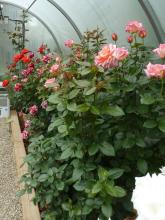
'Double Delight'; 'Dolly Parton'; 'Sheila's Perfume'; 'Rock'n'Roll'; 'Full Sail': 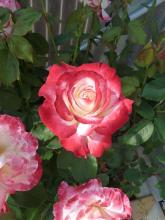
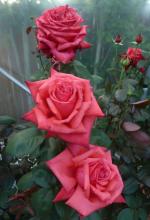
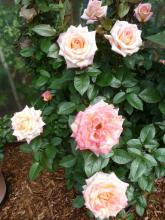
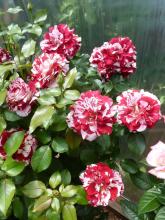
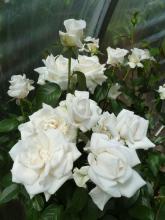
And Rosa primula, outdoors - no coddling needed for that one!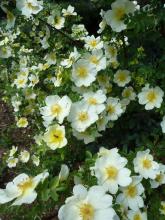
Re: What do you see on your garden walks? 2012
Michael, I think your A. franchetianum is really A. ciliatum. I have a few that I grew from seed labelled as ciliatum, and they look just like yours. Also, the photos on Google look the same.
Re: What do you see on your garden walks? 2012
Massachusetts sandy bed still holds some interest. Acantholimon, Sempervivum, and Lewisia rediviva Sold as v. minor. This is first year for the latter, but 2 made it through last year and flowered, earlier.
Charles Swanson NE Massachusetts USA z6a "mildish" sunny winter, recently cloudy and cool, 90s F this week.
Re: What do you see on your garden walks? 2012
Here on The Rock; Moltkia petraea blue; certainly among the choicest of rock garden plants. I shuddered when this one seeded in on top of a trial Gypsophila aretioides; but I let it be: a fair trade. These are willing, and deeply beautiful plants. Grown from NARGS seed.
Michael, those "on the rock" garden scenes are outstanding. Hope you'll post to the Gallery: Rock Garden Scenes.
Charles Swanson
Re: What do you see on your garden walks? 2012
Thanks for the feed back; particularly for the Arisaemas. I'm pretty sure both came from Potterton and Martin many years ago. Both have been in the garden for over ten years. A. flavum has seeded quite a bit and there's lots of wee ones. The other spreads widely by stolons but has also produced fruit. If the seeds mature before cold weather; I haven't seen any seedlings yet. It's a genus I really have yet to explore. As for Stewartia; It took two seasons before seeds germinated.
Re: What do you see on your garden walks? 2012
It just so happened that a botany friend of mine from Hayward, Wisconsin visited me today. He grows lots of things I never would think had a prayer: Meconopsis grows like weeds, Stewartia from seed just planted in the woods(!), a vining polyganatum, Iris wattii, etc. We got to talking about arisaema and he mentioned that he has had A. flavum for at least ten years! He is in zone 3, and about 50 miles south of Lake Superior. Often he benefits from lake effect snowfall, but not all years. From my point of view, this guy can grow anything, and he is a master at rooting cuttings, too!
I believe many Stewartia are hardy, a number of species can be grown in New England without the slightest winterkill over many years. If I had to pick only two trees to grow, Stewartia pseudocamellia is one of the two (Sourwoord, or Oxydendron arboreum is the other). It used to be that my tree never started blooming until the very end of June or beginning of July. But in the past decade, flowering start date has consistently moved up, earlier and earlier, the first few blooms started here on June 8th. This past week, the maturing tree is heavily laden with large flowers, quite a spectacle in the garden, the ground white from the flowers that drop just after one day, replaced by ever more opening buds.
This tree is an all-season winner, trim, concise deep green leaves never bothered by buds, smart red leaf petioles, upright conical growth with willowy slightly pendulous branch ends, incredible profusion of late-season bloom, spectacular red-orange-pink autumn color, and beautiful smooth multi-color peeling bark for winter interest. The only thing this tree lacks, is flowers with a fragrance (they're unscented, although the bulblebees love the tree). This tree has never seeded around in 18 or so years, whereas other ornamental such as Magnolia, Stryax, and recently Chionanthus, seed around with ease.
Another late bloomer is Magnolia sieboldii (mine is a Korean form grown from Magnolia Society seed). I mentioned in another topic about Winners and Losers, that when we were hit with a deep freeze to 18 F after several weeks of summer-like warm to hot weather back in March, one of my two M. sieboldii trees completely blackened. It never recovered and has indeed died, whereas the second tree growing 2' away, didn't bat an eye at the sudden deep freeze, and is growing lustily and producing lots of flowers. The flowers, besides being exquisite, have a rich perfume, an enticing sweet lemony scent. Nearby grows Corydalis elata, 18"-24" tall with deep blue flowers that waft an intoxicating sweet coconut aroma, mmmMMMMmmmm good!
Re: What do you see on your garden walks? 2012
Lots of beautiful things there, Charles and Mark!
Doronicum orientale; Salvia juriscii, with its upside-down flowers; Antennaria along the sidewalk: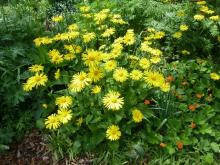
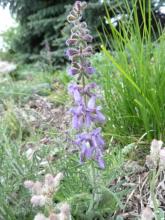
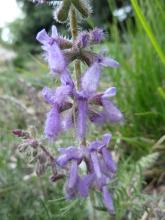
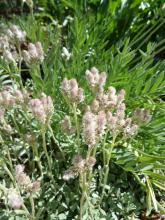
Castilleja miniata in the front yard; there is one particularly vivid plant that I'm glad to see has seeded itself: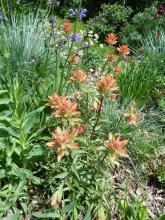
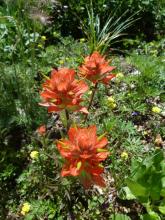
I grew this from seed long ago as Anemone x lesseri: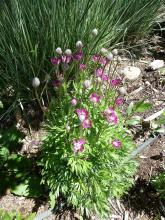
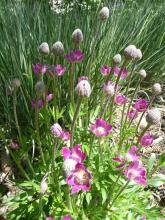
Anemone canadensis - pretty in bloom but very invasive: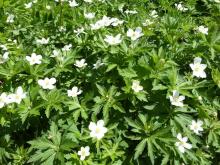
Eremurus himalaicus - I broke this one off last year under the soil surface while weeding and assumed I'd killed it - not so: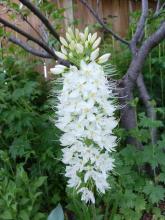
Re: What do you see on your garden walks? 2012
Lupinus nootkatensis, looking more blue in the photo than it really is: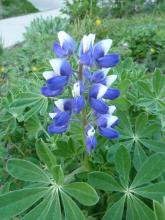
A sucker or seedling of Lupinus argenteus has turned out to have pink flowers, as opposed to the usual lavender (on the right):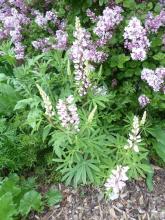
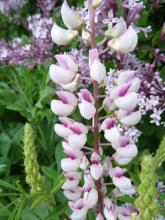
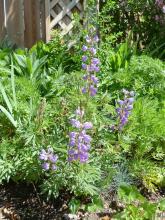
Re: What do you see on your garden walks? 2012
Lori, interesting how your season starts so much sooner than mine, but in our short summer things become compressed and we are not as far behind on some things now- Anemone canadensis and Castilleja miniata have just started flowering in the wild here..
Your Rosa primula is interesting, this seems to be the same as many massive old plants that were flowering all over in the nearby town of Sylvan Lake when we were there last week- I commented that some local nursery years ago must have promoted these heavily many decades ago since there are so many -grown as 'hedges' (I use hedges a bit ironically since it suggests something much more tame than what I actually saw) and over archways etc- clearly very very hardy and splendid in flower.. I think I've seen some in Rocky Mountain house as well... I collected a hip from one at my mother's doctor's office some time ago, but have not sown...
Re: What do you see on your garden walks? 2012
Cohan, if you get a closer look at those white roses sometime, try to note the thorns. Rosa primula has winged thorns (left), while another possibility, Rosa spinosissima (another very hardy, early, once-blooming white rose) has straight, fine thorns (two photos to the right):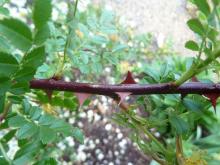
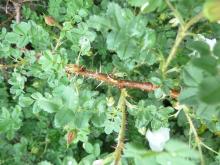
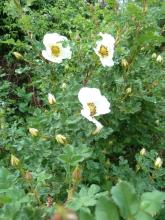
It would be interesting to know if it's one of these, or something else again.
Alliums; a rather cute little Hemerocallis that I moved from elsewhere in the yard... no name springs to mind, unfortunately; Erigeron aurantiacus: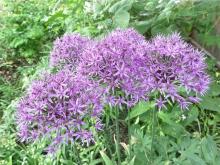
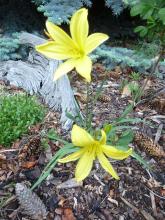
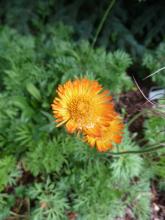
An odd little Delphinum with most unusual felty leaves and aconitum-like flowers - Delphinum vestitum; I rescued this from the border last year, where it was being overwhelmed, and stuck it in one of the acid beds, where it is recovering: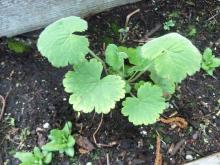
Re: What do you see on your garden walks? 2012
A very dark 'Nora Barlow'-type columbine that has sprung up; Aquilegia chrysantha 'Yellow Queen'; a very old iris: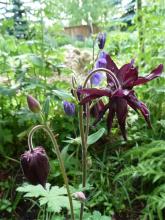
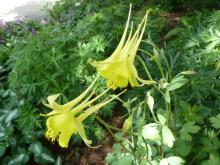
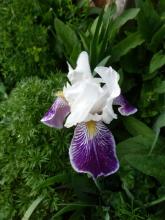
Zigadenus elegans in the front yard: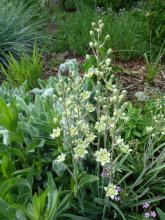
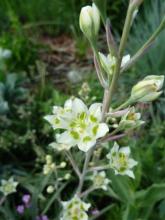
Only the odd flower left on any Pulsatilla vulgaris now (though P. ambigua P. turczaninovii is still producing fresh flowers):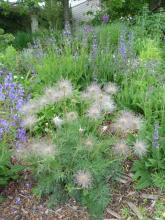
Oh, and I noticed the other day that I have finally had an Ixiolirion tataricum survive in the garden! :)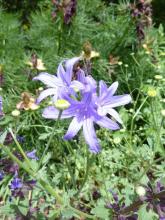
Re: What do you see on your garden walks? 2012
Hi Lori: Love your pictures - I have Zigadenus elegans too but not so photogenic as yours. You mention an "acid bed". I don't seem to be able to grow the acid loving plants I covet and wonder if there is any way one can create such a bed and grow things like Kalmia, Bunchberries, etc. Fran
Frances Howey
London, Ontario, Canada
Zone 5b
Re: What do you see on your garden walks? 2012
To make a acid raised bed over limy soil:shape the soil in a upside down V shape to allow drainage and cover with a plastic sheet(protected on both side with clean sand or a membrane as used to make pounds)
Put rocks,logs or planks to retain the acid rooting medium on the edges of the bed.You can fill with what is available:peat, composted bark,garden compost even acid soil from another location.
Compost made from conifer needles is very acid.
A lot of ericaceae have thin shallow roots so a depth of 1'1/2 will allow several species but not big rhodos of course.
Re: What do you see on your garden walks? 2012
Getting small for a moment. Sedum hispanicum 'minus' in front of Vaccinium uliginosum.
Lady's Mantle, Sundrops, 'Good Omen'...... yada yada (OK -getting into the perennials a bit much but this is a garden walk and I'm just the reporter).
Small Cobweb in Selaginella densa.
Small Cobweb flower avant Draba rigida imbricata in seed. The plants are showing stress because of heat (this is normal). We can get fifteen hours of daylight at this time of year and this is followed by summer. It is warm for June here but the weather is finally (by 2 or 3 years) "normal" - just some thermal degrees elevated and with a tropical twist.
Small Cobweb in Arabis bryoides with Selaginella rupestre.
Vaccinium 'Hamilton' is another extremely choice ground cover; but, like my previously displayed V. oxycoccus -start now if you like it and expect it to cover ground; these things are really pokey.
Re: What do you see on your garden walks? 2012
When the thermometer hit eighty plus in mid March I swapped the wooden planter frogs, totally appropriate to last spring, that had been in a south window for a couple of years, with a toaster.
Summer enters with a blaze of fury. I knew these were threatened on the south face of The Rock but, after a day of record heat, they now appear to be toast; A tiny Saponaria and two buns of Gypsophila aretioides. That could be eight years down the drain on those Gypsophilas. I'm glad I have back ups, for now, at least. There are seven species of Acantholimon here that seem more resistant; and, of course, cacti. If the Gypsophila lives it's set to be moved from this area. The Saponaria has kindly made lots of seeds.
Cacti couldn't be happier; The weather has been perfect for them. I'm doing some remodelling on Cactus Park; making it more cactusy. This Opuntia macrorhiza(?) has value beyond simply being fun to look at so this is what I've done: taken several lengths of un-blooming growth from beneath an existing plant and layed them atop the ground in the radial pattern they will naturally take on as they grow. There are few roots now but that will change quickly.
I always enjoy this little scene: Campanula glomerata in Cerastium tomentosum.
Potentilla thurberi enjoys the afternoon shade of tall trees to the west.
I noticed this morning the flowers on Lonicera crassifolia. Vaccinium uliginosum is at bottom of photo.
Moltkia petraea, Sedum dasyphyllum, and Allysum oxycarpum.
Re: What do you see on your garden walks? 2012
You mention an "acid bed". I don't seem to be able to grow the acid loving plants I covet and wonder if there is any way one can create such a bed and grow things like Kalmia, Bunchberries, etc. Fran
Hi, Fran,
Our acid beds are basically what John described, with the structures being raised beds made of landscape ties (one bed) or planks (the other bed). The beds started out as pure peat, but have had soil incorporated in through time. I can't say they have been raging successes for me, but they have given me a place to grow Linnaea borealis, Cornus canadensis, Vaccinium vitis-idaea 'Wabasca', a few alpine willows and mitrewort... plus some other things that don't necessarily require acid soil, but have been reasonably happy in there.
I have tried various heaths and heathers and Phyllodoce in the acid beds but our winter conditions (the dryness particularly, perhaps) don't seem to favour them.
Linnaea borealis was beautiful in the acid bed (photos from last year) but all the draping parts were killed this winter... arrghh! The rooted portions in the acid bed and the draping parts that rooted into the soil below survived, at least. 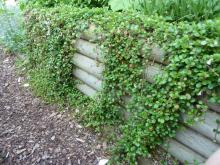
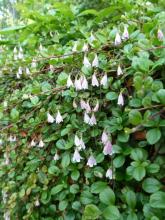
Re: What do you see on your garden walks? 2012
John and Lori: Many thanks for your info about creating an acid bed and your inspiring photographs - never saw Linnea borealis growing like that - reminds me of Fuchsia procumbens I have growing in a pot - leaves look similar but no flowers. A case of unrequited love on my part. Fran
Frances Howey
London, Ontario, Canada
Zone 5b
Re: What do you see on your garden walks? 2012
Wow, fabulous, Michael!
Let's see, where did I leave off?
Geranium phaeum 'Springtime'; Primula cortusoides(?) x2; Dracocephalum nutans: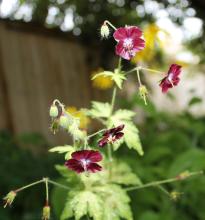
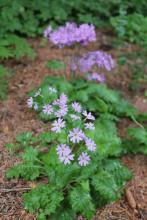
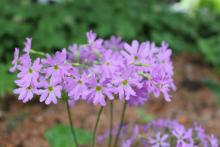
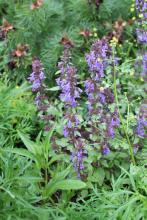
Front yard; more Zigadenus elegans x2; Salvia pratensis; 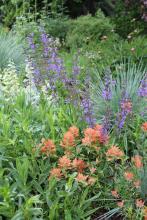
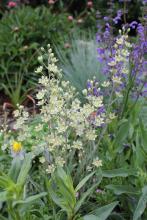
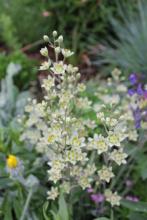
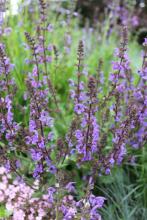
Rain, rain and more rain lately, and the perennials are growing like gangbusters... Persicaria polymorpha is taller than I am: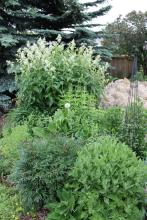
Re: What do you see on your garden walks? 2012
Will my plant envy ever cease? Doubtful. But even just enjoying these wonderful photos enough.
I must agree, Lori, that that Zigadenus is a very nice form. I've never seen it growing here, even though it is suppose to be native. I'm probably just not out at the right time. Wouldn't mind some seed of that one though...
Re: What do you see on your garden walks? 2012
To make a acid raised bed over limy soil:shape the soil in a upside down V shape to allow drainage and cover with a plastic sheet(protected on both side with clean sand or a membrane as used to make pounds)
Put rocks,logs or planks to retain the acid rooting medium on the edges of the bed.You can fill with what is available:
I've often wondered about this. So, John, you've essentially created a low mound of material, covered it with an impermeable membrane, surrounded the whole thing with a low retaining wall, and topped it all up with an ericaceous compost? This would leave a shallow spot in the middle of the bed and the deepest soil on the edges. I'd think an issue with this would be keeping it moist enough. I might direct run-off from the roof, or something, into the bed.
why not sink the center instead (or just leave it level)? The edge of the membrane could still be finessed above the offending alkaline ground level. so long as the water going in is not alkaline I would think that a lack of drainage deeper in the bed would be unimportant. Another potential stumbling block might be the compactness of what is put in: from my experience, it takes a deal of effort to get light ericaceous composts compact enough for good plant growth. This is good stuff but not something that will provide much return to a guy who already gardens on pickling sand. In fact I'm running a test on Louiselueria procumbens pretty much just plopped right in. It's still alive, and seems healthy, after more than a year. Some of my dabblings were published in the Spring 2005 Quarterly (I'm still dabbling!). Lets hear more, if there is more, from folks in alkaline areas.
Re: What do you see on your garden walks? 2012
Opuntia macrorhiza on Cactus Park
Asclepias tuberosa starting up.
My weedy vegetable garden: The poppies have been coming up in it for years and I like to eat the mustard which was long ago planted for that very purpose.
Security, in part, on my half acre of paradise, is a shed full of wood. The plant is Hydrangea petiolaris: In rough translation; He who gobbles sheds. There's a Vitis on the other side of this shed just to make sure the job gets done.
In the foreground is a truely gargantuan Daphne 'Carol Mackie'. Above is a Box Elder. Hey, it made a nice place for a shade garden in just ten years; never mind the fact that it sheds its leaves in June as well as the more-than-occasional branch or limb, and it seeds everywhere. I do so consider the chain saw. A conundrum indeed.
My crispy ash tree (Fraxinus exebitius? 'crispa'). If I knew what I do now about the best of gardens I may have sought out more things like this fifteen years ago; again conundrum; time and place and, of course, initial investment. Where does the sense to "just go" on this kind of thing come from -if there is such.
Yacky Pond; among the most contrived things I've ever done; but oh so much fun.
Big hostas, as well as shrubs and trees, being used to carve a garden into the rough.
A couple of photos of my latest crevice garden. I filled it with "compost" last fall and after a winter's settling have begun to plant it. I'll use seedlings, enforced patience, and selected stuff I can propagate from the garden to start it. It was done in the parallel style popular today though you will notice a slight curve in this one (second photo). From this angle it appears a low mesa thrillingly juxtaposed against the backdrop of the shining mountains in the grand distance beyond.
Re: What do you see on your garden walks? 2012
Michael, your place looks terrific! And your new rockery looks very promising ;)
Re: What do you see on your garden walks? 2012
I agree - and what a great description of carving a garden into the rough! How many see a garden like this and are actually exhilarated by it?
Re: What do you see on your garden walks? 2012
This has got to be the most dramatic 'thistle' - Berkheya multijuga from the Drakensberg Mountains of South Africa. Its flowers are yellow and not especially striking, but the foliage gets more remarkable every year. Unlike B. purpurea, which I also grow, this doesn't send out running shoots, and neither does it set viable seed for me - I should probably excavate some roots and try root cuttings.
The second plant, Symphytum x uplandicum 'Axminster Yellow', is equally hard to propagate as root cuttings lose any variegation and it hardly produces enough growth to divide easily. A nice feature with Phlomis russeliana.
Re: What do you see on your garden walks? 2012
Gardeners in Essex New York have given effort in fits and starts for some years. But I'm sensing a new paradigm. Today these guys 'get it'. Great use of the 'defendable borders' principal in these: 8 or so feet between sidewalk and street put under staunch perennials and again between sidewalk and building.
The garden display is easy; there has been scant care of landscape over the years yet it has succeeded to a relative degree. The back side of this daylily highlight, et al. has been allowed to roam into the lawn; The owner/caretaker ever avoiding the spreading mass. I call this 'the fear of plants' or; thou shalt never damage a priceless perennial! Bah! Discuss broadly and set limits or ye shall be eaten!
The 'ditchlily' taking on its proper roll? There probably arent any other 'weeds' in that ditch. Nice work. In the second photo it's a little outta hand, but I think these guys 'get it'.
I've always liked alleyways. This really isn't one but it's nice to see the backside of buildings blossom anyways.
The village sits on greystone and shale. Some of the first structures built here were made of the grey stone. What fun it must have been to build these things!
A "boat house" overlooking Vermont shore on July 1.
I doubt there's a town anywhere that couldn't be made more beautiful by the considered use of plants.
Re: What do you see on your garden walks? 2012
Michael and Lori- many wonders :)
Lori, love the colour of the Geranium phaeum 'Springtime'!- oh to have 20 square metres of that instead of the fluorescent purple/blue himalayense we have :(
I'll have to look at those rose stems when I get a chance... I may have photos somewhere, but would have to really dig...
Michael- love the Potentilla thurberi, will have to try it sometime.. |I was looking at seed of Hydrangea petiolaris (I think, or a similar sp) last year, that would be another fun one to try... Did you say your property is a half acre? How long have you been gardening on it and what state was it in when you started? do you have native vegetation?
Re: acid plantings-- Lori, do you count Cornus canadensis and Linnaea among the things you find need/prefer the acid bed, or are they in the other category of things you just put in there? just curious, both grow everywhere here, where there is even part shade, and some of the soils are quite clayey ('grey wooded' soil which does not have a huge humus content)... though spruce needles can and do reach any part of my acreage when the wind blows.. really need to use the ph testing papers Trond so kindly sent..lol
Michael again- I enjoy the (sub?) urban scenes- I spent many happy hours wandering the streets of Toronto enjoying and photographing the plants and flowers- the 'outta hand' yards were often my favourites- assuming some nice things were put there to get out of hand!
I have a ton of common daylilies I dug up a year or two back (and another patch to dig) where they've spread over many years, and too close to my rock garden.. I haven't yet figured out what to do with them (the ones already dug, along with the Irises they have grown with -german? SDB, MDB, CBS, ABC, PPP-- can't say I have yet grasped the complex letter codes of garden Irises-- were plopped as chunks of 'sod' nearby the dig and are happily growing there two winters later.. but that is not where I want them either!)-- I think I will move them all to a grassy/forby native area at the edge of the property, and let them do their thing among the other vegetation between spruce trees and mower.. nothing short of chemicals would ever give such a pure display as your ditchlilies here! I will not spend every waking minute weeding daylilies!...lol
Tim- the Berkheya is indeed striking :)
Re: What do you see on your garden walks? 2012
Michael: Love your "ditchlily" idea. My neighbors, in order to get rid of grass at their curb -it was usually weedy and was and still is a mountain of snow pushed up on top of it by the snowplow in winter. However, they dug it up and planted some really tough but actually quite attractive plants there that provide nice color throughout the growing season, beginning with yellow Heliopsis, red Shirley poppies, Datura (not exactly my cup of tea, nor that of the local Ministry of Agriculture) and ending up with some nice colored Autumn Glow Sedums. This is a spot where nothing much will grow but they want to keep it looking nice - and they do. I shall mention to them about the "ditchlily" which is flowering right now. Fran
Frances Howey
London, Ontario, Canada
zone 5b
Re: What do you see on your garden walks? 2012
I'm sorry I have been in absentia for several months: trips to Europe and all over the US compounded with springtime and work responsibilities kept me from posting (and I was stymied for a while when my logon lapsed)...but a very long spell of hot weather has allowed me to catch up a bit, and driven me to the computer. I shall perhaps do a garden walk this time of year (lots still happening), but I thought this would be a good place to post some of the highlights of the past few months in my garden and a few of my friends: it may take two postings to get them all!
1) Penstemon x barbatus hybrid ('Coral Baby' Horrible name!) at the Gardens at Kendrick Lake
2) Convolvulus assyricus at Sandy Snyder's rock garden late last April
3) Closeup of same
4) Escobaria sneedii var. leei in a trough in Gwen Moore's garden
5) Astragalus angustifolius in my garden
6) An overview of a part of my rock garden in late May (ice plant season!)
7) My favorite form of Daphne oleioides (either buxifolia or kurdica: lost track which)
8) Erodium absinthoides ssp. amanum in Mike Kintgen's gem of a garden
9) Delosperma FIRESPINNER in my private garden
10) Alkanna aucherana in a trough at Mike Kintgen's garden
Re: What do you see on your garden walks? 2012
And MORE highlights of the last few months...
11) Monardella macrantha 'Marion Sampson' at the Garden at Kendrick Lake in May (still blooming some)
12) Closeup of same
13) Arctotis adpressa in the Watersmart Garden at Denver Botanic Gardens late April
14) Trillium luteum at Sandy Snyder's wonderful garden in Littleton
15) Sandy's crevice garden in late spring
16) Echinocereus dasyacanthus in Dryland Mesa garden at DBG
17) Escobaria sneedii var. leei at Denver Botanic Gardens
18) The crevice garden at the Colorado Springs Water Conservation Demonstration Garden in late April...
19) Osteospermum AVALANCHE in the Children's Garden at Denver Botanic Gardens
20) Salvia pholomoides blossom at Mike Kintgen's garden--his collection from Morocco.
Re: What do you see on your garden walks? 2012
I will not spend every waking minute weeding daylilies!...lol
Cohan; That's the point of the exercise. Once these are weeded and strongly established; they like never need weeding again! Furthermore, if you know where the weeds are or may be lurking; which is, of course, not in the daylilies; you should be able to keep them at bay. To give brief answer to your other question about native flora on my small town lot (.8 acre): roughly; NO there is no "important" such. Fifteen years ago when I began the garden, I found a variegated hosta, a blue Iris, and a cut leaf form of Viola; all still here. However; in the mixed (white pine dominant) woods behind the house (recently destroyed for logs) there are extensive colonies of Mitchella repens, a variety of large ferns, and Montiopsis? sp. It supports plants that like a light sandy soil but does not seem to support things like Trillium and Arisaema. Mitchella has formed a patch way out in the corner of my lot under a big white pine. It, like the big hostas in my former post, draws my attention and thus may be used by me to, as I say, carve a garden into the rough. I've got a lot of work to do yet and June-July really makes that apparent. In total fear, I have not dained to time-lapse photo things like Oxalis corniculata, Glechoma hederacaea, spotted spurge, and numerous species of crab grass all of which may attain absurd dimensions in a very short period of time! Now I need another full time gardener plus one part time.
Panayoti. Thanks for those. Looks like I gotta get back to the drawing board as they say. That's Convolvulus assyricus? Wow!
Re: What do you see on your garden walks? 2012
Panayoti - what fantastic plants! The Monardella set against that red stone is inspired - a plant I have tried several times and failed with. I am also beginning to see the great following there is for cacti in American alpine gardens - the Echinocereus dasyacanthus is such an extraordinary colour and highly appealing. I am sure others have asked before but are there any prospects of a book based on the experiences of alpine gardening at Denver and around about? I enjoyed Bob Nold's book immensely and despite our long tradition of alpine gardening in the UK we are starved of writing like this, and a sense of such a distinctive range of plants.
Re: What do you see on your garden walks? 2012
Dear Tim,
You are very kind indeed: glad you liked the pix! The Monardella macrantha is apparently a selection that is much more gardenworthy than the typical species: the picture I showed is taken at a public park after all! We have it all over Denver Botanic Gardens--if you need a start let me know once it cools off; there's lots of it hereabouts!
I have helped produce a number of books that have quite a bit of content deriving from me over the decades....although not specifically alpine in content, they do have interest beyond our region: Durable Plants for the Garden is the history of the first 10 years of Plant Select, and a really great book that hardly had distribution outside the Denver metro area--a great injustice! Flourish was edited by me: a tribute to the first 50 years of horticulture at Denver Botanic Gardens, and finally "Gardening with Altitutude" wherein I wrote two chapters and generated the overarching vision: this, alas, is out of print. I have two book projects that should come to fruition in the next year or so...and I suspect I shall one day do a "rock garden" book--I am not in any rush!
You are right that there's not enough in the way of rock garden books lately: you would seem to be a first rate candidate to produce one!
Re: What do you see on your garden walks? 2012
Michael- I suppose the key is getting the daylilies absolutely weed free in the first place, but I am sceptical whether that's achievable here (without paid help) in the first place, and even more sceptical whether it would remain so afterwards- I suppose in semi/urban environments there are fewer incoming seeds etc but here (on my acreage I mean) natives and weeds rapidly establish on my woodash pile, piles of rocks, wood, concrete etc- so I can't see the daylilies keeping them out! We do have some very dense growth of chives and Geranium himalyense here, but even those are not weed free- just really hard to weed...
We did have a large area where daylilies and iris had established, and still a good sized patch of days, but far from free of other plants..
Panayoti, many beauties in there- the Escobaria sneedii is wonderful, and Echinocereus dasyacanthus is among my faves in the genus- sadly no hope of hardiness here and rather large for my indoor space...
Re: What do you see on your garden walks? 2012
A considerable fight with the little point-and-shoot to get some of these. One day I'll get the confusing maze of settings figured out! This required some distance and cropping. Allium sibthorpianum has to be the perfect trough onion.
Phlox bryoides (muscoides) from calcareous Wyoming steppe (planted 2009). The secret to growing this is obvious in the photo: it's the old pennies!
I've never seen Minuartia caroliniana growing in this region (with the exception of this garden). It's native further south and is associated with pine barrens. I think it not a bad display for a sandwort.
Yeh, I wish it were all bright glowing orangey-red too. But I like it anyway: Monardella odoratissima, very widespread in the western third of the USA. I've tried others but so far this one from the Mogollon Mountains is the only one that's taken here. Come to think of it: there's plenty of red Beebalm in the back yard. Maybe the Hummingbirds can help me get something going.
A magnificent display of Yucca filamentosa.
Some garden shots taken in Willsboro where I live. The Methodist Church here had this big deal put in last year. It's pretty spectacular when it's all up in roses, Hydrangeas, daylilies, Hosta, and scads of other perennials; maybe just a bit "over the top" but: two thumbs up here! -and, at the same location Irma Halen's rock garden. These 'Adirondack Chairs' are at a B&B south of the village.
And finally; the Rock Garden Gods have comment on 2012. This big old stone trough was excavated just a couple houses up the road from me. Around here; stone hitching posts and step-ups aren't so rare as this. This almost never happens!
Re: What do you see on your garden walks? 2012
Two fantastic little North American plants withstanding heat and drought well are Douglasia montana from Bighorn Mt. seed collected in 2009 and Eriogonum caespitosum.
An Acantholimon in morning light and another. These were both grown from AGS seed. AA kotschyi and venustum come to mind.
Allium caucasicum subspecies albidum and Sideoats by the side of the road.
This Opuntia did not come directly from J. Spain but that was said its provenence. I think it might be a hardy O. phaeacantha. The pads are big but it does burn in winter.
And a summer Gentian to cool things down.
Re: What do you see on your garden walks? 2012
Great to see you back, Panayoti, and with fantastic photos! Your Delosperma 'Firespinner' is really taking the gardening world by storm, most deservedly!
And speaking of fantastic photos, Michael, your garden is wonderful, and what a pretty town you live in. Will the stone trough be put to its proper use (that is, alpines ;D), do you think?
Re: What do you see on your garden walks? 2012
Finally, a photo of Gentiana siphonantha with flowers opened: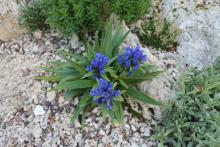
Several of the Smelowskia calycina that I grew from local seed this winter are blooming in a very anomalous fashion, not at all how one sees them in the wild: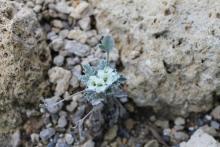
In the wild, for example:
http://nargs.org/smf/index.php?topic=384.msg3761#msg3761
Another of Saxifraga paniculata v. minutifolia 'Red-backed Spider':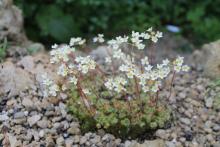
Saponaria x(?) suendermannii (Hmm, I see that this name is not shown in The Plant List):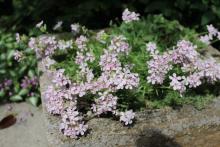
Re: What do you see on your garden walks? 2012
Whether you believe it or not, Lori, I still say your plants are never ending... :o and very cool 8).
A question for you and everyone: which Edrianthus sp. would you guess is easiest for lowlanders?
------------------------------
The night blooming Hemerocallis altissima has significantly shorter scapes this year, due to the early hot weather, I think. Fortunately the flower size and quantity is unaffected.
I had been waiting for the flowers of Ptilostemon afer to open, but now I find out that this is as open as they get!
Re: What do you see on your garden walks? 2012
Rick - Edraianthus are superb on our sand bed and I think I would go for pumilio anytime; it is compact, well flowered, and tidy in and out of flower.
Re: What do you see on your garden walks? 2012
Hard to keep up with this favorite topic, which such a refreshing variety of plants and scenes. I can't begin to express my thoughts on so many great plants shown here, but I'll mention a few that particularly come to mind.
Lori: I'm totally impressed with Gentiana siphonantha, such a distinctive display of flowers above neat foliage. Michael, I like your summer Gentiana too, do you know what species it is?
For foliage alone, both Tim's Berkheya multijuga and Rick's Ptilostemon afer are eye-catching, the Ptilostemon with such architectural structure, although dangerously spiny to be sure.
Rick: I wonder if your Hemerocallis might actually be H. citrina or a hybrid; both citrina and altissima are night blooming. Hemerocallis altissima is a favorite of some daylily hybrids here in New England, and from what I know of this species, the flower shape and disposition look a bit different.
PK: regardless of the name, Penstemon 'Coral Baby' looks terrific! Seeing the splendid specimen of Alkanna aucherana reminds me that I once grew this, from MacPhail & Watson seed expedition to Turkey, and while mine never bloomed, I was able to strike some cuttings and give rooted plants to Howard Porter in Connecticut, which he grew them on to flower in his outdoor "dryland scree" protected from rain with an overhead open-air translucent roof.
And what can one say seeing clumps of Escobaria sneedi v. leei growing larger than an ancient clump of Sempervivum arachnoideum and undulating waves of an impossibly huge Convolvulus assyriacus, OMG! But it is Monardella macrantha 'Marion Sampson' that has my head spinning once again; every time you show us this awesome little western mint it makes me crazy with plant envy.
Michael: Minuartia caroliniana is indeed a nice surprise, a respectable floral display, good to learn of that species. Congratulations on your Phlox bryoides (with penny cultivation), and the many other wonderful plants you show.
Re: What do you see on your garden walks? 2012
Well, thanks, Rick! I do like that Ptilostemon afer, though it looks like a wicked thing to weed around!
Mark, Gentiana siphonantha is a good size too - 7" tall in flower.
A few things from the garden...
The colourful bracts that precede the flowers on Ajuga lupulina; the second photo hints at the perfectly geometric shape of the flower stems as seen from above: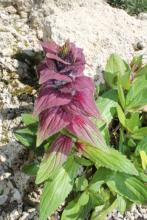
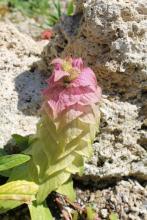
Tiny flowers on Aethionema saxatilis ssp. oreophila, from seed this winter: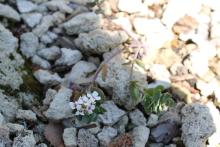
Sideritis glacialis - subtle but quite pretty: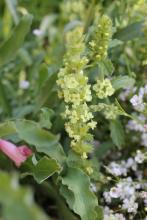
A froth of blossoms on Clematis recta: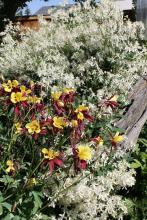
Heuchera richardsonii, a native plant; the flowers are insignificant (though much loved by bees) but the foliage is quite attractive (though currently concealed in the underbrush in this overgrown bed!):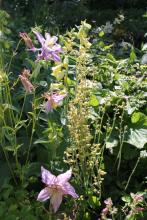
Heuchera 'Canyon Duet' with hail-ravaged ligularias in the background (2 hail storms in the last week - uggghh!):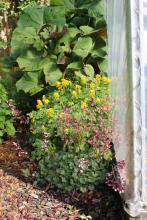
Re: What do you see on your garden walks? 2012
Great to see you back, Panayoti, and with fantastic photos! Your Delosperma 'Firespinner' is really taking the gardening world by storm, most deservedly!
Speaking of which, a few weeks back I picked up a Delosperma something-or-other 'Kelaidis' at Home Depot- funny to see that while shopping way up here...lol no idea if it will actually survive here- those stores seem to be stocked nationally, with no regard for local climate... any tips from anyone on ideal siting and soil for best chance of survival? Mid-winter wet is not an issue, but spring and fall can certainly have cold wet spells.. I don't have a spot for it just now, as I am in the midst of bed-building, but I think I should get it out of the nursery junk into real soil anyway..
Re: What do you see on your garden walks? 2012
Cohan, I have run into Delosperma 'Kelaidis' at a general nursery myself, had a similar reaction as yours :)
Panayoti sent me a box of various "Delos" in 2010, which I duly planted, but received some advice after I had planted most in troughs, that they are less likely to survive in troughs, and show improved hardiness when planted directly in the ground. One that he sent me was a "new species" but I think this is the one that is now named "FIRESPINNER" (PK, let me know if that assumption is correct). It grew in the trough that first summer and looked terrific, even through the winter, but in late winter early spring it went into a slow demise, not turning mushy or anything, just losing any life color and slowly browning until it was dead by full spring. Saddened I was, but there was a glimmer of hope.
When I first planted it in a trough, a piece broke off, and I stuck it into some sandy soil at the base of the trough. That little piece is still alive and growing, now I must move it to a more permanent place of honor in a warm sunny spot.
Re: What do you see on your garden walks? 2012
Thanks, Mark, I'll likely try to keep a piece indoors just in case..
What about soil/moisture? Should I be deliberately trying to keep it dry (once in ground)? I have read that the hardy Delos in general are not dryland plants, but rather alpines, and as such want good drainage, of course, but not actually to be parched..
Re: What do you see on your garden walks? 2012
Rick: I wonder if your Hemerocallis might actually be H. citrina or a hybrid; both citrina and altissima are night blooming. Hemerocallis altissima is a favorite of some daylily hybrids here in New England, and from what I know of this species, the flower shape and disposition look a bit different.
I received that hemerocallis from Chen Yi many years ago as H. nana. (Obviously not that!) There sure are a varied bunch of identities for H. citrina on the web. But from what seems to be the most verifiable, I think you are right, Mark. At the least, citrina and altissima are very closely related.
The Flora of China doesn't even recognize an H. altissima, and views it as a synonym of H. citrina. And the drawing there does seem to match.
http://efloras.org/florataxon.aspx?flora_id=2&taxon_id=200027672
Even more so this H. citrina on the Plant Delights site:
http://www.plantdelights.com/Hemerocallis-citrina-Yao-Ming-Yao-Ming-Dayl...
Mine also normally has 5ft. scapes. Maybe I should be selling mine for $25 a shot, too! :D Actually, mine is even better because it hast the enviable characteristic of dark tipped buds. ;D
Re: What do you see on your garden walks? 2012
I received that hemerocallis from Chen Yi many years ago as H. nana. (Obviously not that!) There sure are a varied bunch of identities for H. citrina on the web. But from what seems to be the most verifiable, I think you are right, Mark. At the least, citrina and altissima are very closely related.
The Flora of China doesn't even recognize an H. altissima, and views it as a synonym of H. citrina. And the drawing there does seem to match. http://efloras.org/florataxon.aspx?flora_id=2&taxon_id=200027672
Looking again, I see that The Plant List, Tropicos, and other sources all regard H. altissima as a synonym of H. citrina, didn't notice that before. So citrina it is, and a most attractive daylily it is. I will ask a daylily hybridizer friend of mine (Mike Huben) about the citrina-altissima question, as certainly the name altissima is often credited in daylily hybridization reports. Mike has been working on some hybrids with near black stems, which set off the flowers nicely; the dramatic coloration does tend to fade to a gray color during anthesis.
Re: What do you see on your garden walks? 2012
Cohan, I have planted my fat plants in a mixture of pebbles, sand and organic soil:
The commoner rocky subjects here are Sedums like S spurium, a Caucasus native which has spread enormously here. They come in all shades of "red".
The yellow Hemerocallis is finished but the brown H fulva is in flower now. It is a very old garden plant here and every other old house has a clump of it. Here it grows "wild" with other plants like these Campanulas and the weedy Lysimachia punctata.
Re: What do you see on your garden walks? 2012
Nothing is growing in tidy beds but all plants have to struggle for life in a semi wild planting scheme together with the native ones.
Here are some Geraniums, a Securigia, a Trifolium and a Tanacetum(?). The last one is biennial and very floriferous from Chadwell seed.
Re: What do you see on your garden walks? 2012
Although it has rained much in the rest of the country the last days we have had nice and warm (that is about 25C here) weather and enough rain so I don't need to water anything.
The insects have appreciated the sun an the thyme and several of the other plants have been eagerly visited by honeybees and other insects. Lots of them paid the Erigeron a visit too - and a species rose, also Chadwell seed.
Re: What do you see on your garden walks? 2012
Trond, your Tanacetum? looks like Matricaria, except that is an annual...
Re: What do you see on your garden walks? 2012
I think I have finally caught up to you Trond....Hemerocallis fulva is just starting in my area too.
Re: What do you see on your garden walks? 2012
Nice views, Trond- I am working on some areas like this too-- but except for the mostly wild areas, I need to weed quite a lot or they will still be mostly grass, dandelions and clover!
I have a lot of daylilies here too (as I mentioned before on the forum)- though I'd call them orange-- I still have to figure out what to do with them... no flowers yet this year, that I've seen, though they may come along faster with this recent weather- we've been 28-30C or a little over, and more days of it to come...
Re: What do you see on your garden walks? 2012
Trond, your Tanacetum? looks like Matricaria, except that is an annual...
Rick, I am pretty sure it is a Tanacetum. I got seed from Chris Chadwell and think(!) I remember the name. It is very similar to T niveum although that presumably is a perennial.
I think I have finally caught up to you Trond....Hemerocallis fulva is just starting in my area too.
Todd, I am sure you have!
Re: What do you see on your garden walks? 2012
Nice views, Trond- I am working on some areas like this too-- but except for the mostly wild areas, I need to weed quite a lot or they will still be mostly grass, dandelions and clover!
I have a lot of daylilies here too (as I mentioned before on the forum)- though I'd call them orange-- I still have to figure out what to do with them... no flowers yet this year, that I've seen, though they may come along faster with this recent weather- we've been 28-30C or a little over, and more days of it to come...
Cohan, I am too lazy to weed much! Grass and Leucanthemum are problematic, but not clover or dandelions ;)
Re: What do you see on your garden walks? 2012
I'm ever impressed by the intricacies of texture and detail that our little subjects provide and am amazed by it every time I go out into the garden. Is there a rock garden anywhere where such delights are not fully loved and admired? Here's some of the best of it in my garden right now: Gypsophila aretioides and detail; Draba rigida bryoides; Minuartia obtusiloba and Vitaliana; Azorella trifurcata, an antipodian and Muhelenbeckia axillaris, another.
I become even more aware of this potent green life force as cool weather approaches and the plants really begin to settle in. Can't you just feel the energy in these little green rock eaters? Words cannot describe.
Below: Low humidity, temperatures in the 80's and no rain for days. Our climate is beginning to show its satanic side. I've heard it said that treated (city) water is not good for alpines but it's looking like that or nothing. Here's a couple of surprising holdouts from markedly different habitats both are growing right in the eye of the sun: Androsace muscoidea and Loiseleuria procumbens. The Androsace has the glancing blow on a north side the Loiseleuria does not.
I've actually been consciensly watering the re-jiggered cactus garden in the belief that these things will grow better if the roots are not grounded in dust, at least for an hour or two on many hot afternoons. There's great suffering among the rock Primulas and many of the Saxifrages.
Re: What do you see on your garden walks? 2012
An interesting collection you have there, Michael! I am familiar with Loiseleuria as it is a native and very common in the mountains here. It always grows on the most exposed ridges and gets full share of the weather! I did grow Azorella too, and it seemed to really like the wet coastal climate where I live but was ultimately crowded out by large shrubs. The others are completely new to me ;)
Loiseleuria procumbens in the wild, taken a couple of years ago:
Re: What do you see on your garden walks? 2012
Although not current (it will be 2 months before I will see this scene here) here's a picture of what I have as altissima and citrina growing side by side, no guesses as to which is "altissima" ;)
Re: What do you see on your garden walks? 2012
Just a couple I snapped yesterday evening: Pretty light on this PeeGee Hydrangea in grass: Head high garlic scapes! And -a good crop for acid sand though if I want to eat them at all I must settle for "slightly under-done".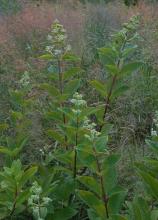
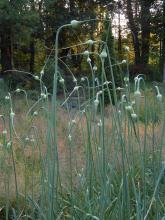
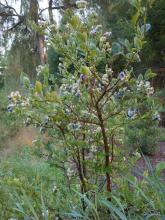
Trond; I've seen Loiseleuria put on more than an inch of growth a season if all is just right. The hot sun stresses them. I'm just kind of amazed how heat resistant they really are!
Re: What do you see on your garden walks? 2012
Azorella trifurcata, an antipodian and Muhelenbeckia axillaris, another.
Michael
Thought you might like a shot of the Muehlenbeckia's natural environment in Fiordland .
Growing on rocky ground -banks -- stream beds--gravel fans .
While I've photographed it in bloom on a number of occasions while travelling about the South Island i don't think I've a shot of it in fruit.
Cheers Dave.
Re: What do you see on your garden walks? 2012
Michael
Thought you might like a shot of the Muehlenbeckia's natural environment in Fiordland .
Fantastic! Thanks Dave. I've seen a pretty good show of blossoms here. If it made fruit or seed; It was not showy but the shiny olive green foliage is unlike anything else in the garden.
Re: What do you see on your garden walks? 2012
Native plants here - Ratibida pinnata and Campanula americana
Our newest ivasive thistle in Minnesota - Onoporum acanthium (Scotch Thistle). I had been letting it grow where it came up, since I didn't recognize it as a weed or a desireable until now. At least I think that is what it is...
And a slug of unknown Arisaema spp.
The last little bugger a friend identified, but what did I do with the name ???
Re: What do you see on your garden walks? 2012
Touring around the garden in the early morning is rather depressing these days - so dry and when we do water it doesn't seem to stay around long - lots of wilting phlox, burnt up wood ferns and thalictrums and Amazonia didn't even bloom this year although the leaves look OK. However, amid this devastation there are some survivors - a blue Platycodon is "business as usual" and Anthericum racemosum is quite fantastic. Surprisingly the Maiden Hair Fern is lovely and Ipomopsis rubra is delivering its wonderful red again. The one that really surprises me is Zauschneria californica. In former years, in its high and dry spot, it has barely flowered before giving up. This year it is full of life with plenty of fat red flower buds. Beebalm is a washout (I should say dry out) - I think if it were near some big rocks it would do better. And I've never seen so many marauding chipmunks and mice turning up pots and doing other nasty things to the plants. This dry time has been a learning time telling me that certain plants MUST be moved to another spot. Fran
Frances Howey
London, Ontario, Canada
Zone 5b I guess
Re: What do you see on your garden walks? 2012
Frances, you should invite me over to put shade paint on your greenhouse. Whenever I do mine it rains for ever-or so it seems. We haven't had a dry day this month so far, which followed 24 wet days in June.
Re: What do you see on your garden walks? 2012
Frances, I'd love to see the ones you mention - Anthericum, Ipomopsis, maiden hair fern - they are not so commonly grown here; nice to hear that they are doing well despite the weather challenges.
Good heavens, David, what horrible weather you seem to be having! Maggi mentioned a little while back that there is nothing but unending rain in her area as well, and yet it continues. It struck home for me how awful it must be when I saw in the local news that the Times of London published an editorial demanding that it stop raining!!
Nothing so fine here as has been shown in the preceding photos, but it's time again to try to catch up a little...
Lindelofia anchusoides and the very similar Lindelofia longiflora:
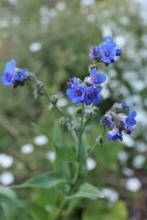
Scutellaria orientalis v. alpina; Scutellaria alpina; Lychnis chalcedonica cv. with Veronicastrum sibiricum and Persicaria polymorpha: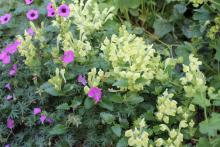
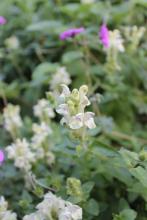
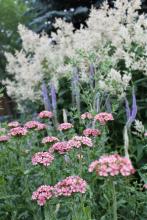
Paeonia cv. with Verbascum ex. 'Helen Johnson':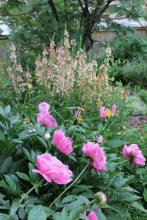
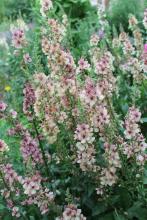
Delphinium nudicaule 'Fox', planted this year; another Scutellaria alpina; Lupinus argenteus: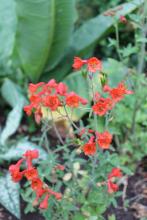
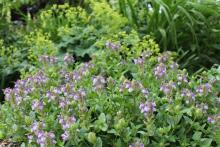
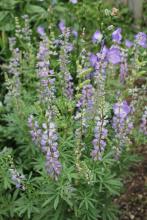
Re: What do you see on your garden walks? 2012
Dianthus monspessulanus has rather messy, irregular flowers but a wonderful scent - perfumey, rather than spicy... and another Dianthus, one that some may find eye-searing ;) :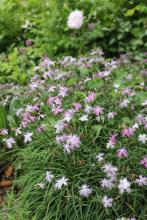
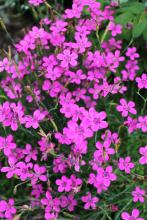
In the greenhouse - Nymphaea 'Colorado' and 'Helvola':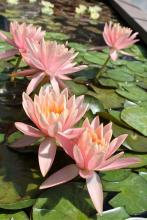

Linum flavum compactum; Lilium 'Pink Pixie'; Dracocephalum purdonii(?); lots of chartreuse and yellow in this photo with Alchemilla mollis, Dasiphora fruticosa and Digitalis grandiflora: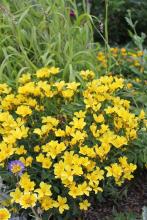
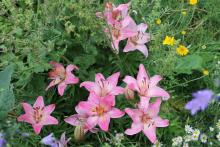
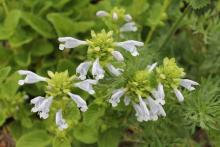
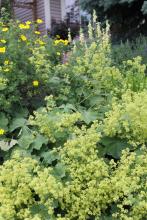
Re: What do you see on your garden walks? 2012
Lori your plants look very nice.
I have some pictures taken last week.Non-stop rain for the last two days.
Re: What do you see on your garden walks? 2012
Thanks, Krish! Yours are very nice too!
Papaver sp. ex. Tajikistan; Arenaria grandiflora: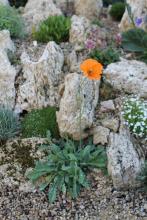
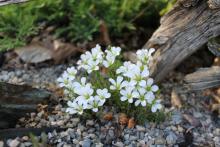
Ranunculus platanifolium; Geranium pratense ex. 'Midnight Reiter' - nice that the seeds come true, at least in so far as having dark foliage; our native Geranium viscosissimum; Hieracium villosum: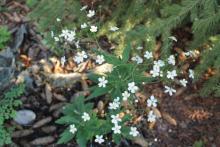
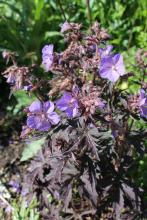
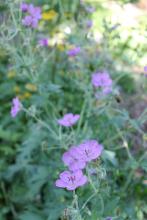
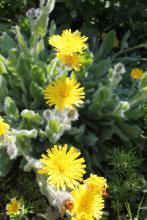
An interestingly-coloured columbine, among the self-seeded multitudes; Adenophora remotiflora and Geranium x cantabrigiense 'Biokovo'; 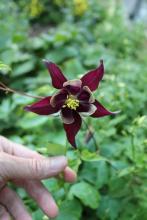
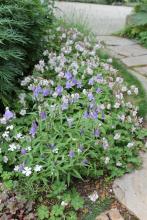
Erigeron grandiflorus; Erigeron glabellus: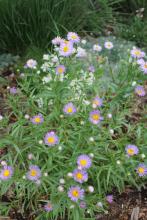
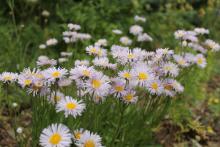
Re: What do you see on your garden walks? 2012
Erigeron peregrinus ssp. callianthemus and Erigeron speciosus:
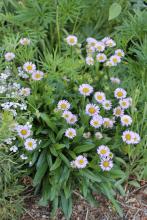
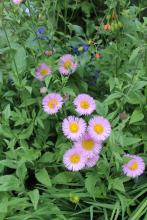
Re: What do you see on your garden walks? 2012
Lori: You really must have a fabulous garden - those lovely pictures you post make me feel like I'm actually touring around with you looking at all the treasures there. It must be a very large and "concentrated" garden and you must have great soil/tufa and weather (moisture) in addition to your obvious expertise. Thanks for this almost daily treat - rain or shine. Fran
Frances Howey
London, Ontario, Canada
Zone 5b
Re: What do you see on your garden walks? 2012
Gentiana septemfida and Acantholimon make a pretty pairing. The Gentian is also nice with Silene schafta when they bloom together. The perennial 'plunk' is pretty much about Daylilies these days. The warm pastels sparkle. 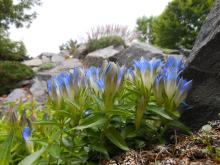
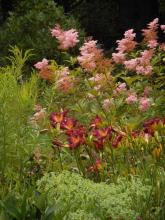
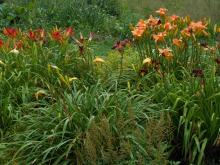
A shrubby Hypericum from near Black Balsam in North Carolina and 'Brunette' bugbane with milkweed
Re: What do you see on your garden walks? 2012
It must be a very large and "concentrated" garden and you must have great soil/tufa and weather (moisture)...
Thanks for the kind words, Fran! It is pretty large - just under 1/3 acre, with no lawn. Well, I wouldn't say that the soil is great everywhere - when we first removed the grass to make beds in the back yard, we just piled a foot of organic soil/compost on the bed and planted (it was like planting in chocolate cake - no trowels or spades needed ;D), then added fine bark mulch as a topping. That was long ago, though. If I was to redo some beds (which I should do), I'd be inclined to do that again to replenish things. In the front yard, we just dug out grass in big swathes, then filled in the void with bark mulch immediately after (wanted to protect the many tree roots and not raise the soil level too much)... so there is lots of pretty lousy soil (clay and rocks) tool The worst is at the far end of the fence line, where things get sparser and sparser along in that direction; the other reason for sparseness is that it's in the upwind, northwesterly direction and the seeds from the rest of the yard don't generally get blown out there to colonize things. (Ha, there's the secret to my gardening, if there is one... complete randomness - the wind does most of my planting for me. ;D Unfortunately, the wind only has the same old perennials to work with... now if only there were some really interesting gardens upwind from me...).
Re. moisture, we have been having wet springs the last few years, but the norm is to be pretty dry - I tend not to be able to grow moisture-loving plants well at all.
Michael, again I have to say that your garden is fabulous!! Thanks for showing it to us! I'd love to have enough space (and moisture) for a tract of queen of the prairie (and all the other delights you show)... wonderful!
Re: What do you see on your garden walks? 2012
Krish, do you have to support your Clematis recta? It looks somewhat more upright than mine. These recumbent, not-quite-climbing ramblers (C. recta, C. integrifolia) are always a problem for me - I never have the right support figured out or available (or am too lazy to get it out there at the right time ;)).
Re: What do you see on your garden walks? 2012
Good heavens, David, what horrible weather you seem to be having! Maggi mentioned a little while back that there is nothing but unending rain in her area as well, and yet it continues. It struck home for me how awful it must be when I saw in the local news that the Times of London published an editorial demanding that it stop raining!!
Yes, it's been a God awful Summer in most parts of the UK so far (apart from the Western Isles off the cost of Scotland who have missed it all and are crying out for rain.
Apparently it's all the fault of the Jet Stream which has been positioned to the South of the British Isles and Ireland and forcing out any high pressure systems moving in from The Azores and allowing in all the Atlantic low pressure systems. I live in the South West of England and we get all the prevailing south west winds and systems first. I live around 15 miles from the coast
on the southern escarpment of Dartmoor and the moor also affects our weather. For example, today has been continual drizzle and a heavy mist and 14C whereas no more than three miles to the east of us the temperature was 22C and blue sky.
The forcasters tell us that Jet Stream is slowly moving north and we should be getting some better weather soon. But will they get it right? ???
Re: What do you see on your garden walks? 2012
David- they are talking about English weather on tv on account of the upcoming olympics.. hope some reasonable weather happens!
Great garden showings all!
Lori, do you find the Erigerons interbreed or stay distinct?
Michael, I have some baby Azorellas and need to figure out what sort of siting they need (exposure, moisture, soil and space) any tips?
and Lori, ditto to that advice re: Alchemilla mollis -I only have one plant bought for a dollar, so just wondering how much space to give it in particular..
Re: What do you see on your garden walks? 2012
Cohan, I can't say I've noticed any hybridization among erigerons in my yard.
Alchemilla mollis is very large here (~4' diameter)... however, it takes some years to get to full size. Not a fussy plant at all (I think that's what I always say, isn't it?) - I have them in full sun through to mostly shade, in what was once rather nice organic-rich soil through to unamended clay. And it's normally pretty dry here everywhere (at least after the spring rains) and it doesn't mind.
If you don't mind me commenting on this one too, there's probably no need to allot too much space initially to Azorella trifurcata in our climate. It's hardy but not a fast spreader and you can always move things out of its way with time as needed. My old original plant (which I bought, and used to think of, as Bolax gummifera but eventually ID'd) got to 28" x 22" in 8 years... though about a third of it died in last winter's strangeness. (It is coming back though.) Full sun, and nothing extraordinary in terms of soil quality (i.e. regular garden soil - I've never grown it in the rock garden) or moisture, seems to suit it fine here. You can cleave off chunks easily and plant them elsewhere as the mother plants grow.
Re: What do you see on your garden walks? 2012
Krish, do you have to support your Clematis recta? It looks somewhat more upright than mine.
I have a metal obelisk hidden under the plant.The support is not great. For the last two years I am trying to find some good support that has the top open for the vine to come out naturally .No luck. Looks like tomato cage is the one I should use
Re: What do you see on your garden walks? 2012
Cohan, I can't say I've noticed any hybridization among erigerons in my yard.
Alchemilla mollis is very large here (~4' diameter)... however, it takes some years to get to full size. Not a fussy plant at all (I think that's what I always say, isn't it?) - I have them in full sun through to mostly shade, in what was once rather nice organic-rich soil through to unamended clay. And it's normally pretty dry here everywhere (at least after the spring rains) and it doesn't mind.
If you don't mind me commenting on this one too, there's probably no need to allot too much space initially to Azorella trifurcata in our climate. It's hardy but not a fast spreader and you can always move things out of its way with time as needed. My old original plant (which I bought, and used to think of, as Bolax gummifera but eventually ID'd) got to 28" x 22" in 8 years... though about a third of it died in last winter's strangeness. (It is coming back though.) Full sun, and nothing extraordinary in terms of soil quality (i.e. regular garden soil - I've never grown it in the rock garden) or moisture, seems to suit it fine here. You can cleave off chunks easily and plant them elsewhere as the mother plants grow.
4' for Alchemilla! then I will need to give some thought to where to put it- I may give it a spot I'm developing at the end of a semi-woodland bed, where I can give it a whole end to itself!
For Azorella, I was thinking about an area I have at the foot of my semp bed , where there are some Crocus and Galanthus- or would it be too dense for the bulbs to push through? if so, then maybe among stepping stones in a walkway- to- be between the Eurasian rock bed I made last year and another 'ridge' to go behind it.. I don't have enough South Americans to have their own area..lol my batch of Patagonian seed yielded very little :( I do also have a couple of bits of Acaena (have to look- antarctica, I think) already in ground, but they look to be slow indeed- though to be fair, I only planted the seedlings in ground last year, so its not much time to get going..)
On a more positive seedling note- Waldheimia tomentosa has a bud :)
Re: What do you see on your garden walks? 2012
Krish, do you have to support your Clematis recta? It looks somewhat more upright than mine.
I have a metal obelisk hidden under the plant.The support is not great. For the last two years I am trying to find some good support that has the top open for the vine to come out naturally .No luck. Looks like tomato cage is the one I should use
I've seen designerish things that could be obelisk shaped and made out of some sort of solid metal struts, but openwork- could be a much nicer look than tomato cage, though much pricier, probably..
Re: What do you see on your garden walks? 2012
There is too much to keep up with in the summer garden and it still looks quite good despite all the rain that David mentioned - we have probably been a bit drier in Kent. Summer growing South Africans like Dierama pulcherrima must appreciate the rain; these are such delightful plants. Teucrium ackermannii looks nice on a raised bed, especially at this stage with many more buds to open. And finally a mix of plants on the patio steps - the astonishing almost black Aeonium 'Zwartkop', with Viola 'Molly Sanderson' and variegated Alonsoa; and behind the curious origanum-like flowerheads of the annual Cerinthe major 'Purpurascens' - this plant caused quite a stir when it first appeared on the horticultural scene a decade or so ago; it flowers over a very long period and sets a lot of large bullet-like seed which is easy to pick up from around the plant on paving. It is a Mediterranean annual from southern Spain, usually not quite hardy enough to overwinter in British gardens from autumn sowings. Behind are a couple of cycads which were completely defoliated in the cold greenhouse last winter, when temperatures dropped very low. It's pleasing to see them grow out again as both were raised from seed!
Re: What do you see on your garden walks? 2012
4' for Alchemilla! then I will need to give some thought to where to put it- I may give it a spot I'm developing at the end of a semi-woodland bed, where I can give it a whole end to itself!
Well, again, I think it's completely workable to plant more for the mid-term, not the longest term... otherwise the bed will have plants with big gaps in between for years and years. I think a perennial garden takes 5 years to look established anyway... and a garden is never done in any case. :) There is always lots of moving around of plants to be done.
There are a few crocus (or other small bulbs; I'm forgetting what) in my Azorella, so, no, it's not too dense... (not sure any plant is ever too dense to be pushed through by bulbs). Please let me know how the Acaena do after the winter - I've only ever had little bits come through. I will certainly try it again, needless to say, if it works out for you.
Well done on the bed construction - sounds like it's going great guns! You'll have to show us some time! :)
Great news on the Waldheimia too!
Re: What do you see on your garden walks? 2012
Krish, do you have to support your Clematis recta? It looks somewhat more upright than mine.
I have a metal obelisk hidden under the plant.The support is not great. For the last two years I am trying to find some good support that has the top open for the vine to come out naturally .No luck. Looks like tomato cage is the one I should use
Plant supports are a bugaboo of mine! As C. recta has gotten especially huge over the last couple of years, it's become increasingly necessary to prop it up (particularly since the bank of 'Terese Bugnet' roses that used to form it's reluctant support were taken out last fall). So, I went out and bought a couple of very tall metal panel supports... which proved to be too tall and obtrusive (will have to try to cut them down to make them useful... somewhere. Now where did I leave that cutting torch??). We ended up gathering some of the wood stumps we've been using as naturalistic plant supports and stacking them to support it... I much prefer a natural look anyway, though they are largely hidden by the plant anyway.
C. 'Pamiat Serdsta' has outgrown it's obelisk support (did we use a different, taller one for it last year?).... stems were bent over after the rain, and I had to cobble together an extension from a couple of other plant support hoops. Oy... :rolleyes:
Re: What do you see on your garden walks? 2012
Cohan - I find Alchemilla mollis seeds very freely so a spot in a semi-woodland area sounds perfect. I have it under apple trees and in early spring it's tidy and just growing out; by now it becomes very strong growing and I have had to curb it from growing over more choice adjacent plants. The leaves catch the rain beautifully so in the right spot it is great groundcover.
Re: What do you see on your garden walks? 2012
4' for Alchemilla! then I will need to give some thought to where to put it- I may give it a spot I'm developing at the end of a semi-woodland bed, where I can give it a whole end to itself!
Well, again, I think it's completely workable to plant more for the mid-term, not the longest term... otherwise the bed will have plants with big gaps in between for years and years. I think a perennial garden takes 5 years to look established anyway... and a garden is never done in any case. :) There is always lots of moving around of plants to be done.
There are a few crocus in my Azorella, so, no, it's not too dense... (not sure any plant is ever too dense to be pushed through by bulbs). Please let me know how the Acaena do after the winter - I've only ever had little bits come through. I will certainly try it again, needless to say, if it works out for you.
Well done on the bed construction - sounds like it's going great guns! You'll have to show us some time! :)Great news on the Waldheimia too!
Good news on the Azorella :) I may try a couple of those spots..
As far as gaps, I have lots of those, since all of my beds are very young (except those that predate me, which are all badly overgrown...lol) but at the moment, I'm working on so many different areas at once that It doesn't really bother me if some beds have nothing interesting going on...lol I started off buying plants and seeds with no place to plant anything (okay, I'm still doing that!) so now I'm kind of focussing on building without always having a full set of plants to go in them- some general ideas and some specifics, but I'm happy to have areas that may fit what I have next year :)
That said, I understand what you mean about moving stuff- some things just no way to know how they will really work out longterm-- I have a nice Geranium sanguineum album, next to a Potentilla (Geum? I always forget) Miss Wilmott- okay up till about this time of year, but unfortunately the Geranium only starts flowering a week or so before the Potentilla, which proceeds to flop all over the Geranium...lol...
The rock gardens I've been working on lately are meant for North American alpines that want dryish conditions- and I only have a few seedlings to go in now, though more to sow, and others I've held off buying knowing there was no home for them :) Next up is a sort of dryland/scree that goes in front of those NA ridges (completely opposite end of the property from the wetter 'Eurasian' ridges).. I have been taking some photos along the way, and will try to get them posted- nothing to see plantwise yet, but I thought I'd show the method which is probably unorthodox but working for me so far with available materials..
The Acaena has been outside for a couple of winters- doesn't look great in spring, but its there! I'll keep you posted, may have some recent pics, they are only about 2 inches across, tiny tiny leaves..
Tim, your Alchemilla looks great! I read on one blog someone bemoaning the fact that theirs was just surviving, not seeding freely as she expected from English sources- I guess drier/hotter sites... I will put mine in the wetter end of the yard (where, however, my Primula auricula I thought was doing so nicely is wilting every day when its 'hot' I guess it needs even more mid day shade, since the soil is never dry in that bed...
I haven't done much by way of plant supports yet, but something I need to think about...
Re: What do you see on your garden walks? 2012
Salvia nemorosa 'Snow Hill' - terrific plant, much loved by bees: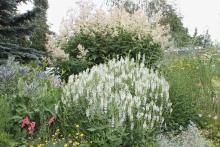
Big betony, Stachys macrantha: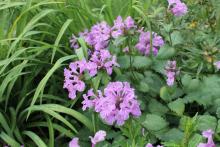
Calamintha grandiflora - great plant for dry shade (or anywhere):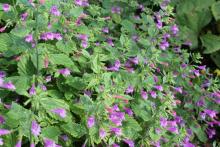
Stachys officinalis 'Hummelo' - a plant that's often mistaken for Primula on plant ID sites ??? :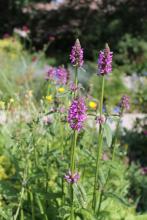
Delphinium grandiflorum - normal blue and self-seeded variations: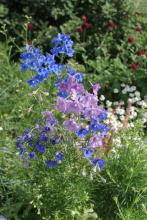
Re: What do you see on your garden walks? 2012
All nice but I find the Verbascum and Salvia especially striking!
Re: What do you see on your garden walks? 2012
Michael, again I have to say that your garden is fabulous!! Thanks for showing it to us! I'd love to have enough space (and moisture) for a tract of queen of the prairie (and all the other delights you show)... wonderful!
Thanks again Lori and also for reminding me (us!) of all the plants I (we!) still need to grow! That's quite a variety of very interesting things you grow and paintbrushes too! Those will grow here some day -just watch! I agree about Azorella; it does not seem to need anything special. I might avoid an overly well drained scree type soil though, unless it is moist.
Cohan; If you are seeing brand new rock gardens and novel techniques on your garden walks; perhaps we may have a look see?
Re: What do you see on your garden walks? 2012
Cohan; If you are seeing brand new rock gardens and novel techniques on your garden walks; perhaps we may have a look see?
Thanks, Michael- the spot at the foot of the semp bed I was thinking of for the Azorella looks gravelly but I didn't amend it too much, so its more our clayey loam than anything else, and I think should be quite moist most of the time; the other spot I mentioned is probably even more moist, so one or the other should suit them :)
I doubt if I'd describe my rock garden building as 'novel' : probably odd, maybe inappropriate or second-rate would be more likely thoughts...lol- I'm sure I'm breaking some rules that are there for good reason! but from my perspective, the key points are 'made with available materials' (the main part of which means they are built up with sod and soil underneath, with rocks and gravel more on the outside and in the higher, planting layers) and satisfying my own personal aesthetic sense with the rocks (available fieldstone, which here means granite and quartzite mostly, with some amount of sandstone, and small amounts of limestone (the last is mostly small, with much more of it in the gravel than in the stones)..
I am taking photos as I progress, and when I finish the next section in the area I'm working on now (the lower, but still raised, dryland area in front of the ridges, with some below grade boggy/marshy areas), I'll show some of them :)
Re: What do you see on your garden walks? 2012
A number of Cyclamen coum are out --this one under the edge of small Rhododendron in a double concrete wash tub .
Cheers Dave.
Re: What do you see on your garden walks? 2012
Back from my other garden - the Dolomites - and finally over jet lag. Here are a few pictures to whet the appetite of any plant enthusiast.
Re: What do you see on your garden walks? 2012
A few pictures that tell a story. Thunderstorms heading our way but a rifugio in sight for shelter and a cup of hot chocolate. This is what makes walking in the Dolomites so wonderful. If the weather becomes awful, you can spend the night there. Despite forecasts for no storms etc, weather can be very sudden in the mountains, and the rifugios offer shelter and a place to stay overnight if needed. I can think of quite a few hikes in the Rockies when it would have been nice to have this option.
Re: What do you see on your garden walks? 2012
Beautiful shots, Anne and David! Can't wait to see more from your "other garden", Anne.
Stachys discolor: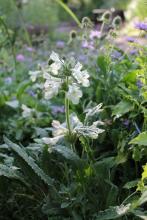
Eryngium alpinum, now coloured up: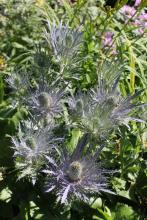
Cephalaria gigantea, reaching for the sky: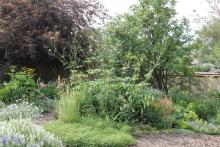
Verbascum eriophorum, a biennial, unfortunately: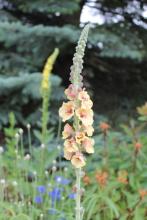
Our native Spiraea betulifolia (corrected name), in the garden: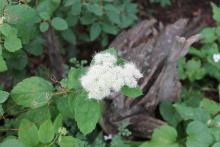
Verbascum nigrum, starting to bloom: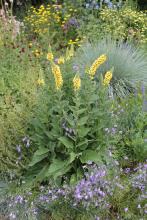
Re: What do you see on your garden walks? 2012
Lori, you really grow a wide range of plants, amazing.
Pictures below taken on a new trail we took this year.
Re: What do you see on your garden walks? 2012
It's all eye candy, every photo....
Or as my friend likes to say: horticultural porn :D
As a comparison to Lori's native Spiraea betulifolia in Alberta, this one, grown from wild seed collected in western Russia (but grown in Minnesota).
Spiraea betulifolia
Lori, does yours spread much? Since 1997, mine grows about 2ft high and has spread to 5ft. in heavy clay soil.
Re: What do you see on your garden walks? 2012
And farther up the trail more great plants, and finally, on the way down, a great rest stop.
Re: What do you see on your garden walks? 2012
Wow, what beautiful sights, Anne! Thank you for posting them! We were too late for Silene acaulis on our first (lower elevation) hike yesterday, so it was wonderful to see such a great specimen in bloom there, along with all the other beauties. Thlaspi rotundifolium is such a fabulous plant! (I hope the couple I managed to raise this winter survive to bloom next year.) That poppy is stunning.
Rick, my Spiraea betulifolia (thanks for the correct spelling - I couldn't remember offhand if it was "folium" or "folia", and I am not well versed in Latin gender rules ???) was planted in 2003 and has remained very contained; it has not expanded out beyond a radius of about 1 1/2 feet. I haven't seen any in the wild that are a lot larger than that either. As a Spiraea, one would probably expect suckering but it has been very slow.
Re: What do you see on your garden walks? 2012
Anne- every plant is wonderful, as are the views, and the amenities most enviable! Ah to be able to pause for a hot chocolate in mid-hike!
Lori, the Verbascums are quite charming, as is the grass? behind V nigrum
The native Spiraea is nice, I've seen it once, I think, in the foothills, but wasn't able to get seed... should see if I can find a photo..
Re: What do you see on your garden walks? 2012
Lori, as an absolute novice rock gardener years ago, I grew Papaver rhaeticum and Gentiana verna from seed and planted the seedlings together. I thought they would make a great primary color combination. And boy did they! It was a sensational show for two years and then they died out. I was horrified at the time because they were growing well and my assumption was that it was a permanent planting. The real tragedy was that they were never photographed. I don't recall seeing this combination in the wild although nature certainly loves strong color combinations. The poppy grows in steep limestone rubble. If it's steep enough and rough enough to make you slide around, the poppy is sure to be there.
Re: What do you see on your garden walks? 2012
Hosta the morn'n to ya! In 'My Little Shade Garden': Hostas (clockwise from top left): 'Sum and Substance', Fluctuans 'variagata', 'Lakeside Dragonfly' and 'Thunderbolt': Second photo: 'Eternal Flame' in front of 'Blue Mammoth' and last; a longer view of the daylily sparkler.
Up on the froggy depths of Yacky Pond!: Eriogonum umbellatum from the Rockies reblooming: and the takeover Teucrium on a tear.
Anne: Great stuff. I'd like to make sense of that confounding Rhodothamnus!
Re: What do you see on your garden walks? 2012
Lovely, Michael... nice to see those big leaves not ravaged by hail!
Re: What do you see on your garden walks? 2012
Lori, the Verbascums are quite charming, as is the grass? behind V nigrum
Thanks, Cohan. I love verbascums, though they do necessitate a lot of weeding... but then, what doesn't, with time? (Aside, I mean, from that inverse relationship thing between self-seeding and plant desirability that kicks in above a certain level... ;D) The grass is blue oat grass, Helictotrichon sempervirens, a very nice one indeed.
Re: What do you see on your garden walks? 2012
Dave, I forgot to comment on the great Cyclamen- nice leaves too :)
Michael- good to see the heat and drought in so many places isn't slowing down your garden :)
Lori- I wonder if there is any plant choice enough to not lose a little gloss if it re-seeds too readily?
Speaking of hail ravaged, we haven't fared badly compared to many, but a few things have some minor cosmetic damage- a couple of Saussurea have some holes in leaves- not entirely sure whether hail or critters or both...
Re: What do you see on your garden walks? 2012
Lori- I wonder if there is any plant choice enough to not lose a little gloss if it re-seeds too readily?
Ah, you missed my reference to Gardening Axiom #104b, which, restated, says, "Beyond a defined point on the plant desirability index, the propensity to self-seed starts to vary inversely with the lusciousness of the species." (And from there, of course, it's easy to see how this relates to the the Principle of Non-propagatability... which is self-explanatory.) ;D ;D
But seriously, to exclude plants that will cause weeding with time (as most of them will), would be to seriously restrict your choices and miss out on an awful lot of very fine plants. I figure 90%, if not more, of gardening is weeding, and I'd rather be weeding out self-seeded perennials, than to be weeding out weeds... which will gladly fill that space if not already occupied by something that was at least originally intended to be in the garden. :)
Re: What do you see on your garden walks? 2012
Yeah, self seeding doesn't bother me (though having only garden plants as weeds is nearly beyond my comprehension...lol) its when they seed into the natural environment that I get nervous- or rather, seed around my yard, which is never more than a few metres from the 'natural' environment!
Though I was thinking today, bit ironic I worry about it, when I'm surrounded by agriculture which has filled the region with invasive exotics (and where they have the nerve to call natives that are toxic to livestock problem plants!) ...would seem kind of fair to introduce something that would spread into fields (joking)! Of course, again, that's not my worry, it's things that would spread into woodland or wetland...
Re: What do you see on your garden walks? 2012
Michael, where I usually see the finest Rhodothamnus chamaecistus is on limestone, often cliffs or huge boulders. Companion plants might be Papaver rhaeticum, Paederota bonorata and Anthyllis alpestris. Have you tried this one from seed yet? You seem to be able to grow a huge range of plants successfully, including many plants which have chosen not to stay in my garden.
Re: What do you see on your garden walks? 2012
Of those, I have some tiny seedlings of Paederota bonarota- a couple years old, but only planted in the ground last year.. very slow to start this spring, but looking healthy enough!
Re: What do you see on your garden walks? 2012
Looking at Anne's glorious pictures from the Dolomites, and Michael's lush garden in New York, I hesitate to trot out some of the toughies that are still managing to survive our very hot summer. It amazes me than when temps have hovered over 90 (and quite a few days in the 100's) that anything survives at all. A few strategic rainy days have saved us from despair, but nonetheless, it's been a trying summer in the garden and in the mountains. The rains have been timely (every ten days or so--and some substantial) so that lawns around Denver are emerald green (thanks to irrigation of course) that despite drought warnings from the utility, things appear normal...
I have been too busy dragging hoses to take many pictures in my own garden, but I have snapped a few in the last week on some of my garden visits, and these I shall post (they qualify as walks even if I drive to them?--I do walk around once I am there!)
1) The first is a really dazzling dwarf South African forget-me-not that I photographed at the test garden of a local seed company: they are about to produce the seed commercially in China: typical Anchusa capensis (introduced through Plant Select last year) gets 18" or more tall, but this one is under 10" and should be a winner for the larger rock garden. It is a short lived perennial for us (2-4 years) but self sows abundantly and blooms all summer!
2) I had to include a picture of Delosperma FIRESPINNER, our Plant Select blockbuster of the year. This one is reblooming for us in my garden. Is it bright enough for you?
3) These are flats of Delosperma karooicum ("Ouberg"), a plant I collected in the East Cape on my wonderful expedition funded by NARGS in 1998. It is a perfect size for the rock garden and blooms heavily through the summer. These are for sale at Timberline Gardens, our best local nursery.
4) Here is a shot in the sales area where there are a great variety of Delospermas blooming their hearts out in Mid July!
5) Sorry I did not put the proper name under the picture: this is Phlox nana, which most serious plant nuts in Denver have big patches blooming all summer. Paul Maslin, my mentor and first president of the local rock garden club, loved this plant and wrote about it for the English AGS journal. A few local gardeners find it weedy, but tolerate it because it looks like this for 5 months: this is at the home garden of Mike Bone, propagator at DBG.
6) Mike has propagated and promoted this hybrid between the wonderful, but somewhat fussy Heterotheca jonesii (a rare plant from Utah) and our ubiquitous and weedy Heterotheca villosa (possibly the commonest plant in the Great Plains and Rockies!). The hybrid is almost sterile and blooms for months in the heat. Best of all, it's easy to grow!
7) Inula verbascifolia from Mt. Olympus is a highlight of my summer rock garden
8) Opuntia erinacea (very near to the Grizzly Bear--O. trichophora) at Timberline: even non cactus lovers fall for this.
9) This is a poppy we are growing locally that is from Central Asia and allied to P. nudicaule: unlike the "Iceland" poppy, this is soundly perennial in our heat, and even blooms through this infernal heat: we love this plant!
10) The last show is the same Heterotheca I mentioned above next to a wonderful mat of Pterocephalus perennis (parnasii) at Mike Kintgen's private garden, which is a treasure trove of gems....
So there! There is hope for us, even on this hopelessly hot year on the windy, parched plains of America!
Re: What do you see on your garden walks? 2012
Wonderful poppy. Panayoti. A Papaver nudicaule that doesn't perish in heat, wow. Seed of that would be worth having.
This year we hiked with Sue and Cliff Booker and found a "first" - a white-flowered Papaver rhaeticum and also a pale
creamy yellow form. I'll post pictures soon.
Re: What do you see on your garden walks? 2012
Gee, I could spend all day commenting on how wonderful EVERY pic is here.
So one big WOW and THANK YOU to everyone must suffice! :o
Fire Spinner has made it all the way to Home Depot in Minnesota. Wonder if it is really hardy here. ???
Re: What do you see on your garden walks? 2012
I wonder if firespinner is the Delo I got, I keep forgetting to look at the tag..
That Inula is extra special!
Re: What do you see on your garden walks? 2012
Michael, where I usually see the finest Rhodothamnus chamaecistus is on limestone, often cliffs or huge boulders. Companion plants might be Papaver rhaeticum, Paederota bonorata and Anthyllis alpestris. Have you tried this one from seed yet?
Anne, I have not. I have 'Anthyllis montana' ? for many years from seed and a 'good' pink form I purchased. I did try the poppy and failed but I am quite a bit keener these days!
I swear that Rhodothamnus is whispering: "grow me".
Re: What do you see on your garden walks? 2012
I'm sitting at my cabin waiting for the sun to drive away the clouds and the temperature to increase.
What's better then to admire your garden walks whether at home or abroad ;)
Re: What do you see on your garden walks? 2012
Michael, if the plant is whispering to you, listen.
Re: What do you see on your garden walks? 2012
Wonderful plants, Panayoti! Phlox nana looks like a great plant - I wouldn't mind having a groundcover phlox that blooms all summmer. The poppy looks interesting - a little different bud shape than P. nudicaule (which does bloom here all summer), and lacking the black hairs? Can't wait for my little Inula verbascifolia to start performing, after wintering over successfully - it's really nice to see your mature plant.
Convolvulus lineatus v. angustifolius - I was warned by a couple of experts that this one is invasive, and indeed, saw a shoot pop up about a foot away this year... so I have since turfed it, regretfully: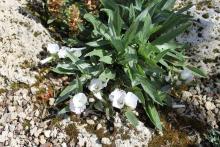
Scutellaria hypericifolia, from seed in 2011: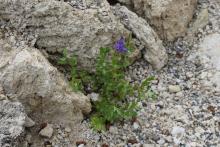
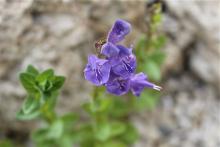
Lilium martagon cultivar; Eryngium bourgatii; Sanguisorba dodecandra; Tanacetum macrophyllum: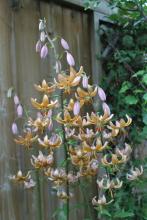
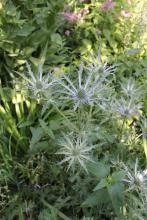
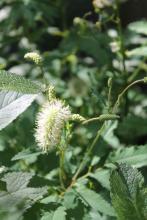
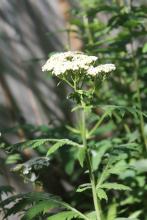
Thymus 'Pink Chintz'; mid-July peonies: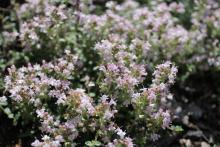
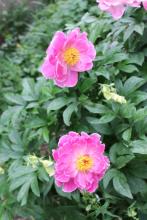
Edit: Sorry, can't get the last photo to attach - will have to try later.
Re: What do you see on your garden walks? 2012
Love you pix, Lori! Imagine, Peonies in mid July (our's are popping seeds already)...
Love the Thymus 'Pink Chintz' shot: thymes are so easily overlooked. I seem to have more and more over time (along with lots of unsolicited hybrids)...
I posted many of these pix in Facebook, but realize most of you don't belong, so I am reposting them: plants from this past week in my garden.
1) Bulbine abyssinica which has made it through the last few winters.
2) Campanula fragilis var. cavalinii and Orostachys japonica
3) Eriogonum allenii
4) Jovibarba heuffellii ('Silver Ingot'? any help on cultivar name?)
5) Lantana horrida (a form hardy in Oklahoma, which I hope will make it here--only its first year)
6) Muhlenbergia torreyi (the wondeful ring muhly of the Great Plains--one of the best miniature grasses)
7) Pinellia pedatisecta: a tad weedy, but manageable in our climate. I saw this on Confucius' grave in China
8) Seseli gummiferum (a large, but very worthwhile umbel from Greece)
9) Talinum rugospermum: quite local from the Midwest. More delicate than the commoner T. calycinum.
10) Trachelium rumelianum: a pale specimen, but good view of details.
Re: What do you see on your garden walks? 2012
Panayoti - great to see that Seseli. This is a plant that caught gardening attention here some years ago but because it is biennial and needs really hot and dry conditions is not so much grown now. I imagine in Denver it could seed around? I used to grow several other species, all nice for their blue-silver foliage but mostly with much looser and more typical umbels.
Re: What do you see on your garden walks? 2012
Great stuff as always, Panayoti!
Love the Orostachys- still have not found a source for seed of japonica or other more exotic species..
Peonies are still in flower here too, and daylilies have just started..
Interesting the Bulbine is hardy..I have a couple of tiny South African spp indoors.. do you grow Asphodeline also?
Re: What do you see on your garden walks? 2012
Tim: the Seseli is widefly available hereabouts, and in almost every "serious" gardeners garden. It does self sow, although never to the point to annoy. I am told there is a dwarf race in Sweden (which we must obtain!): you are right, it loves Colorado. And Colorado loves it!
My Orostachys japonica is not blooming this year, but I may have old seed, Cohan..As you can see, I have lots of offsets: some could """"accidentally""" fall into an envelope, if you know what I mean ;) (finally found a use for the emoticons).
Re: What do you see on your garden walks? 2012
Emoticons are great fun- my favourite is the 'lips sealed' not sure if its exactly the same here as on SRGC- but to me it always looked more like 'holding back the vomit!'
old Oro seed brings up a good question- does old Crassulaceae seed in general tend to be any good? I think I sowed some old Semp and Jovi seed this year with no result I've noticed yet :(
Re: What do you see on your garden walks? 2012
If Crassula seed is viable, it comes up right away: I know that old Rosularia seed can be very viable (I gave my friend Bill Adams seed of several Rosularias stored at room temperature for ten or fifteen years and they came up like cress). The seed is very tiny, and subject to lots of pathogens--and grows slowly. So lots of things can happen in transit, so to speak.
Re: What do you see on your garden walks? 2012
I can't help it, these are just way too cute to not post some more pics:
Echinocereus reichenbachii ssp. baileyi and ssp. rigidissima
Echinocereus reichenbachii var. perbellus, E. triglochidiatus and E. viridiflorus
Re: What do you see on your garden walks? 2012
Thanks, Panayoti, good to know! I do have some Rosularia seed to sow also!
Rick cute indeed :) I have a pot of E triglochidiatus, as well as one of E reichenbachii perbellus which spent their first winter outside last year- a few survivors in each pot, by no means all of them.. time will tell if they will survive here- still siting experimenting to be done.. the lone E viridiflorus did not survive- whether it was the winter or the spring that did it in is hard to say..
Re: What do you see on your garden walks? 2012
I can't help it, these are just way too cute to not post some more pics:
Echinocereus reichenbachii ssp. baileyi and ssp. rigidissima
Echinocereus reichenbachii var. perbellus, E. triglochidiatus and E. viridiflorus
Agree! But small and cute - they seem to be able to defend themselves ;)
Re: What do you see on your garden walks? 2012
We have no ordinary garden here but it is always some plants to admire - and other colorful accessories!
1, 2 Campanula barbata. Although native in Norway I have introduced it here.
3, 4 Gentiana purpurea, also native and introduced in the meadow here.
5 Xanthorhoe montanata. Rather common but easily overlooked.
6 Erebia ligea (the Arran Brown). Very common here.
Re: What do you see on your garden walks? 2012
Campanula barbata is one of my favorites of a huge wonderful genus: I grew it quite well for a long time (even self sowed!), but notice it's now long gone. And always a treat to see European lepidoptera--very different from ours mostly.
Re: What do you see on your garden walks? 2012
Campanula barbata is one of my favorites of a huge wonderful genus: I grew it quite well for a long time (even self sowed!), but notice it's now long gone. And always a treat to see European lepidoptera--very different from ours mostly.
Panayoti, if you want to renew Campanula barbata, please tell me!
Re: What do you see on your garden walks? 2012
Yoga Yoga Yoga frog and Sedum debile.
The best lilies of the year in my garden. Strength and, perhaps, culture has saved them from complete beatle anhiliation; 'Black Beauty' and 'Stargazer'
Allium cyaneum and a Phlox that looks like the Phlox nana that Panayoti recently posted. This was found growing on Rowe Mesa in New Mexico. It's woody and probably short lived but seems everblooming.
Ceratostigma plumbaginoides blooms for a long time and last; a Talinum on Cactus Park.
Re: What do you see on your garden walks? 2012
Some more images from my "other garden" in the Dolomites.
Re: What do you see on your garden walks? 2012
Trond- some of the views with the Campanula are very similar to views here, though it would be rotundifolia, with Solidago around, and the most abundant Stellaria/Cerastium are weeds (though we have some natives I'm fond of).. Great colour on the Gentiana..
Anne- great to see the vast flower meadows, and interesting to see the colour variants on R glacialis- would these grow near one another or in separate colour populations?
Re: What do you see on your garden walks? 2012
Trond- some of the views with the Campanula are very similar to views here, though it would be rotundifolia, with Solidago around, and the most abundant Stellaria/Cerastium are weeds (though we have some natives I'm fond of).. Great colour on the Gentiana..
Anne- great to see the vast flower meadows, and interesting to see the colour variants on R glacialis- would these grow near one another or in separate colour populations?
They all grew together at the same place. The darkest pink one, almost red, hadn't fully opened. The others were fully opened and the range between sparkling white to pale pink to mixed pink and white to deep pink and red was really wonderful. Of course the best ones were below on a steep sliding scree with nothing between you and the bottom if you started to slide. It's my favorite trail but each year more of it slides down the mountain. I suppose one of these years it will be gone.
Re: What do you see on your garden walks? 2012
That would be nice seed to get :)
The disappearing scree/trail reminds me of an article I just read in Alberta Views magazine by the outgoing director of Banff National Park- he commented that alpine flower meadows are disappearing as higher CO2 levels are favouring the growth of woody plants which are crowding them out, and while they might move upslope, they need soil to be built up first, which can't happen that fast....
Re: What do you see on your garden walks? 2012
Trond- some of the views with the Campanula are very similar to views here, though it would be rotundifolia, with Solidago around, and the most abundant Stellaria/Cerastium are weeds (though we have some natives I'm fond of).. Great colour on the Gentiana..
Anne- great to see the vast flower meadows, and interesting to see the colour variants on R glacialis- would these grow near one another or in separate colour populations?
Rotundifolia is the common species here too. Barbata is very rare in Norway, however it has started to spread a little around our cabin. It sets seeds (and so does the gentian) if you would like some ;)
Anne, nice to see your other garden! The flora is obviously richer then here.
Cohan, I think the red colour of glacialis is due to age. When fertilized the flowers redden to increase the heath absorbency to quicken the ripening of the seed.
Re: What do you see on your garden walks? 2012
Trond, from my experience this does not appear to be true. All of my pictures were taken at the same site and the colors varied from a pure white to almost red. There were white ones going over without a hint of pink, and there were red ones, some of which were still in bud and obviously not yet fertilized. At this site there just seemed to be a wide color range. I have been visiting this trail for almost twenty years and this has always been true here.
Re: What do you see on your garden walks? 2012
Trond, from my experience this does not appear to be true. All of my pictures were taken at the same site and the colors varied from a pure white to almost red. There were white ones going over without a hint of pink, and there were red ones, some of which were still in bud and obviously not yet fertilized. At this site there just seemed to be a wide color range. I have been visiting this trail for almost twenty years and this has always been true here.
Anne, that's interesting! I've learnt that it is like I said. However, I don't doubt your observations. In fact I did a similar observation some years ago:
in Norway when I found a redflowered colony with flowers of all ages.
Re: What do you see on your garden walks? 2012
Trond, seed of either/both would be nice, though I fear I am woefully behind in the seed exchange :-[ I've hardly even been out to botanise in ages, since I am spending all my outdoor time building rock gardens! I am on a short break now, I've mostly finished the dry/North American beds, though there will be some finishing and I have some low/wet areas in it to work on.. (nothing planted yet) and now I am working on another one in front of the house which will be (mostly) European- named Semps and others...
I really love those pink/red R glacialis, though all the colours are nice :)
Re: What do you see on your garden walks? 2012
Cohan, if I am at the right spot when they seed, I'll collect some ;)
Re: What do you see on your garden walks? 2012
When the thunderstorm ended (it lasted almost all the day) I took a stroll in the garden. Had to use wellingtons though, it was very sodden.
The Actinidia deliciosus vine almost swamp the house. The new shoots are several meters long already. The Campanula lactiflora (actually a seedling in a wrong place) has been flattened by the heavy rain. Clematis vitalba threatens to swamp my greenhouse. Phygelius capensis seems to like some rain.
Alstroemeria aurea has spread to cover several square feet. Tropaeolum speciosus doesn't seem to mind growing in deep shade.
Re: What do you see on your garden walks? 2012
Looking very lush-- all that rain is good for something! (perennial) Tropaeolum and Alstroemeria I think are genera that will not be growing outside here- great colours :)
Re: What do you see on your garden walks? 2012
Beautiful summer scenes, everyone! Do your kiwis produce fruit, Trond?
Echinops sphaerocephalus 'Arctic Glow':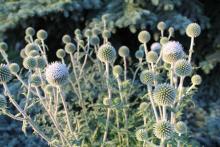
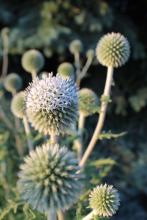
One of the best Austin roses, 'Golden Celebration':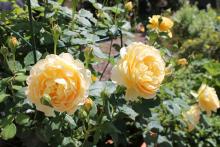
Heuchera 'Sherry Kiss' and others; Lallemantia canescens: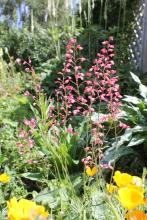
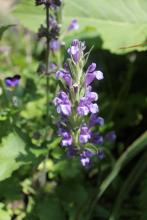
Re: What do you see on your garden walks? 2012
Campanula x carpatica 'Thor Pedo':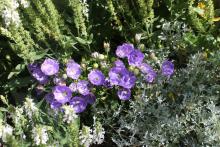
Allium nutans: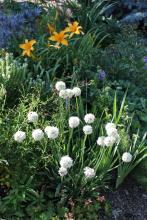
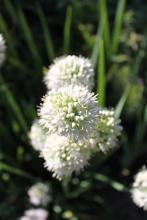
Assorted ligularias along the greenhouse: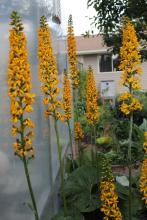
Aconitum, including one white self-seeded individual: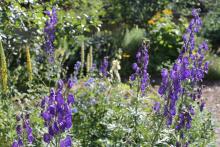
'Purple Pavement' roses out in "Palliser's Triangle" (the boulevard - http://en.wikipedia.org/wiki/Palliser's_Triangle):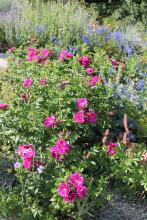
Re: What do you see on your garden walks? 2012
I am fascinated by the Dalea. I am trying a few of these from seed. The picture of purpurea looks a most distinctive legume which I have never seen cultivated in the UK.
Trond - we have had the same experience with the alstroemeria and unfortunately it seeded into an alpine bed nearby and I am forever pulling out shoots. The tubers go down a mile!
Re: What do you see on your garden walks? 2012
Your garden doesn't stop, Lori :) Dalea is great among so many others! Have you ever grown the white Dalea?- saw it on Alplains, he said basically a white flower on D purpurea type plant, I forget the species name...
Re: What do you see on your garden walks? 2012
I would like to have Dalea candida - and the various other species that are available from Alplains, for example, too! - but Dalea purpurea is the only one I've managed to grow successfully so far. It is a much more impressive plant in cultivation than I've ever seen it in the grasslands around here. Even in the very poor, dry clay along our fence, a plant will have hundreds of stems and form a full vase-shape, whereas in the wild, I see plants with three or four stems and often very small, button-like flowers.
Re: What do you see on your garden walks? 2012
It certainly looks to be in full bloom in your photo :)
I was just wondering if this could be a mystery plant I've seen a couple places in ditches as we whizz past on the highway- taller than everything around it with pink flowers on tall bare stems- they're not super far away, between here and Eckville, but not a place you could stop, and I've never seen anything like it on my backroad botanising... Probably not this though, as I think the sites are probably damp, and I saw flowers several weeks ago..
Re: What do you see on your garden walks? 2012
Maybe you're seeing Geranium viscosissimum?
Re: What do you see on your garden walks? 2012
I'll save seed of D. candida for you both. In the wild here in Minnesota, both Dalea purpurea and D. candida remain at the general height of nearby plants. I wonder if what you are seeing, Cohan, might be a species of verbena. Typically in the Minnesota wild, V. hastata and V. stricta flower above surrounding plants and most often with just one or two stalks.
It [Dalea purpurea] is a much more impressive plant in cultivation than I've ever seen it in the grasslands around here. Even in the very poor, dry clay along our fence, a plant will have hundreds of stems and form a full vase-shape, whereas in the wild, I see plants with three or four stems and often very small, button-like flowers.
Ditto for both D. purpurea and D. candida in the wild here.
Re: What do you see on your garden walks? 2012
I am fascinated by the Dalea. I am trying a few of these from seed. The picture of purpurea looks a most distinctive legume which I have never seen cultivated in the UK.
Trond - we have had the same experience with the alstroemeria and unfortunately it seeded into an alpine bed nearby and I am forever pulling out shoots. The tubers go down a mile!
Tim, I'm not unhappy with the spreading Alstroemeria! It keeps other weeds away and where it grows it can't swamp anything special.
I have some Dalea seedlings going - hope they are still alive when I get home - it has been a tremendous slug summer I've heard >:(
Re: What do you see on your garden walks? 2012
Dalea purpurea came through the winter and flowered for the first time. I look forward to its continued success in the garden.
It is, after all, a pea!
Re: What do you see on your garden walks? 2012
I'll save seed of D. candida for you both. In the wild here in Minnesota, both Dalea purpurea and D. candida remain at the general height of nearby plants. I wonder if what you are seeing, Cohan, might be a species of verbena. Typically in the Minnesota wild, V. hastata and V. stricta flower above surrounding plants and most often with just one or two stalks.
Thanks, Rick! I'll be looking forward to trying Dalea candida. I was given seeds once before but had no luck at germinating them for some reason. Our observations about plant habit for Dalea are the same.
The only verbena we have here is V. bracteata which is a prostrate plant. Geranium viscosissimum would fit for bloom time, colour and for holding its flowering stems high above the surrounding grasses - it is very showy in the roadsides.
Great to hear that your D. purpurea plants have succeeded so far, Trond and Anne! Trond, as seedlings, I imagine they might be vulnerable to slugs but as adults, with very tough (even woody at the base) stems and small, skinny leaves, surely the slugs could find more succulent things to eat? ??? I hope you can get them past what would seem to be the most vulnerable stage.
Re: What do you see on your garden walks? 2012
Thanks, Rick, seeds of candida would be cool, I haven't tried any Daleas yet..
As Lori mentioned, our only Verbena seems to be prostrate, its not a plant I know, probably not in my area though I didn't check the map..
Lori- viscosissimum would be interesting, map doesn't quite show it in my area, but that has not stopped a number of other species! but I wonder if it would really have such long bare stems as I'm seeing- of course just looking from highway speed I could be off by a bit, but it seems to me the plant I see has at least a good 20-30cm or more of bare stem with flowers at the tips (if there were tiny reduced leaves I might not see them, but nothing much)..
I've really hoped to run into the plant in another place on bicycle, but no luck so far, and only one outing this year to date...lol
I just flipped through Alberta Wayside Wildflowers (Kershaw) with no further clues- the only thing that caught my eye was Monarda- about right for colour, flower head shape and possible height, though I'm pretty sure it's too leafy..
Re: What do you see on your garden walks? 2012
I wouldn't describe Monarda fistulosa (our only monarda) as the same colour as Geranium viscosissimum and Dalea purpurea (it's a lavender-ish rather than the hot pink of the latter two), and I've never seen it so tall as what I imagine you're describing... it seems to be another one that doesn't really extend itself above the surrounding vegetation, from what I've seen.
Guess you're just gonna have to stop the car some time!! ???
Re: What do you see on your garden walks? 2012
This was supposed to be Erysimum humillinum but it's shaping up to be a orange-flowered Mimulus, from what I can tell so far. I do reuse potting soil from year to year, so who knows where it came from? Poor thing is rather pallid (I have given it fertilizer) though the flower will be quite vivid: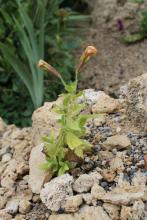
Talinum sediforme, not looking as well as in previous years (and it has never looked extremely vigorous):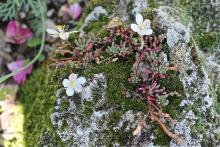
Agoseris glauca; to answer your question from a while back, Cohan, I wouldn't say the flowers are ever so variable as to make them uncharacteristic, though there is variation. Well, I like seeing this in the wild, but I don't really think it needs a place in the rock garden - too big, too dandelion-ish, IMO.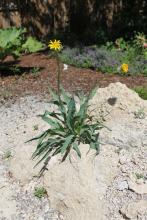
Hemerocallis 'Bela Lugosi' (with its usual "off" colour in my conditions - should be very deep purple) and 'Yellow Pinwheel'; strangely enough, many of the daylilies didn't even bloom last year but there is a more normal showing this year: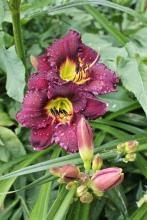
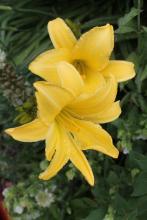
Liatris punctata(?), with Salvia juriscii in seed in the background. I'll have to check that ID - please let me know if you recognize it: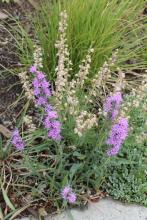
Campanula hofmannii, blooming heavily: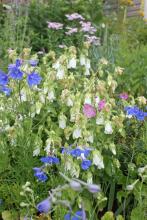
Agastache pringlei, an alpine native to the mountain ranges of New Mexico and Mexico, starting to bloom - despite the usual zone 6 rating, it is much hardier - with Achillea sibirica in the background: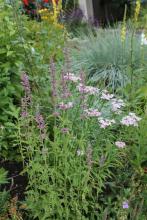
Salvia nemorosa ssp. tequicola is spectacular, colourful, and very long-blooming (but needs staking up in my conditions... oh well):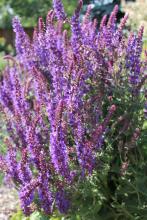
Telekia speciosa; the huge leaves that took a battering from hail earlier on have been replaced: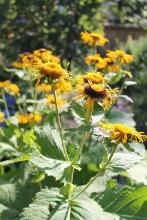
Re: What do you see on your garden walks? 2012
Trifolium rubens... much reduced in the last couple of years from its former glory since the jackrabbits have discovered it - apparently, it's very tasty!; a couple of seedlings have turned up this year, which I will move inside the fence to safety: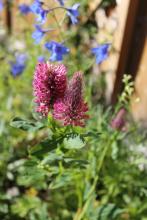
Rosa 'Amsterdam' is putting on its second big flush; I think it's a really spectacular rose with gorgeous foliage and blooms (notwithstanding that it was shipped as something else, that was supposed to be double and fragrant!):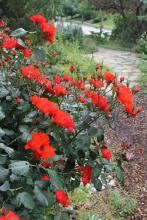
Re: What do you see on your garden walks? 2012
Great to hear that your D. purpurea plants have succeeded so far, Trond and Anne! Trond, as seedlings, I imagine they might be vulnerable to slugs but as adults, with very tough (even woody at the base) stems and small, skinny leaves, surely the slugs could find more succulent things to eat? ??? I hope you can get them past what would seem to be the most vulnerable stage.
Yes, thanks, Lori ;) I hope too that they will survive the summer and the severe slug onslaught! I was home a couple of days ago and found several nasty slimey creeps around the pots although I have tried to place the pots out of reach.
Re: What do you see on your garden walks? 2012
Dark night of the rock gardeners soul. Tell me we aren't on target for a summer heat record in the northeast. Sunshine every day does make for a gorgeous summer however. I'm quite stingy with the hose but it is the only thing between these bright Phlox cultivars and severe dessication.
The south face of The Rock in high summer. The dark bun at upper left (north face) is a Daphne arbuscula much, much larger than a man's head. It may, indeed, qualify as gargantuan for the species! The white patches are lime dabbing. The second photo shows my most proud trough with Sedum pluricaule, a welcome August blooming alpine. I think that's a 'Jaqueline Verkade' spruce in there too, Selaginella densa covers the ground, a silver Saxifrage has seeded into the central chunk of Bighorn dolomite. It is a trough upon which all has been well for well over a decade.
One of a small number of choice small ferns currently here is this Chielanthes from the Rockies. The fronds are generally faced to the east and perpendicular to the north side of the adjacent rock. It seems a thinking fern.
Re: What do you see on your garden walks? 2012
Your rock work, Michael, is really awesome! Looks so good even this time of year.
I just got back from 4 days in Spokane, Washington...an awesome destination for rock gardeners. It is situated between the Palouse prairie (now pretty much wall to wall wheat and lentils, alas!) and the Idaho panhandle mountains. That prairie had to be one of America's natural wonders: in addition to dozens of rare endemics, it harbored some exotic fauna including a giant earthwork (up to a meter long!) which was thought to be extinct, but was recently rediscovered in a protected prairie remnant. And there is even some restoration going on...
But I digress! I shall post just a few pix I have also put on my blog: if you want more extensive commentary, check the blog: http://www.prairiebreak.blogspot.com/2012/08/spokane-visit.html
The first two pictures were taken in the garden Maralee Kowalsky and her husband John--here Maralee is next to her giant Salvia pachyphylla. The second picture is of a champion Origanum libanoticum in her garden as well. Although not technically "rock gardeners" they grow many rock plants very well.
3) Origanum laevigatum 'Pilgrim' at Manito Park in Spokane: I saw this in several gardens there, by far the showiest oregano for color effect. I had never seen it before. Now to get a start!
4) I was hosted two days by Alan Tower, a superb plantsman and nurseryman in Spokane who took me to Steptoe Butte, a remnant of wild vegetation surrounded by wheatfields. (you can see these in the background). Alan's nursery has a wealth of rare plants of all kinds (conifers and shrubs to all kinds of xeric, woodland and alpine plants).
5) Calochortus macrocarpus still blooming there
6) Gentiana oregana is a large flowered steppe cousin of the subalpine G. calycosa: I would love to grow this!
7) Heuchera cylindrica was still blooming prolifically on the Quartzite cliffs of Steptoe,
8) Eriogonum heracleoides was still in fresh bloom, although some were going over enough to get seed!
9) Alan had a magnificent specimen of Gypsophila aretioides on her rock garden: I have never seen a better grown specimen.
10) He has grown a number of unusual gentians from various Czech collectors, and he had many Gentiana striata in bloom--a plant I am not familiar with--from Gansu. Also lots of Gentiana szechenyi, several of which found their way back to Colorado, as well as what he called "Gentiana siphonantha" only it appeared to be compact and attractive. We shall see!
Re: What do you see on your garden walks? 2012
What a treat, PK!
Love the Oreganum and the calochortus, especially.
--------------
Dark Night of the Soul is among my favorite poems, in Spanish or any translation I've read. I liked your play on the words, Michael, though not at all the original meaning of the phrase! ;) As usual, your gardens leave me envious, and I would love to see a close up of that trough...
Re: What do you see on your garden walks? 2012
My points go to the gentians . . and of course the Sagebrush Mariposa lily but not for food ;)
Bundraba, I can use some of the heat here, please! The weather forecast says warmer weather the next week - when I have to start working again :-\
Impressive Daphne, and a pretty fern!
Re: What do you see on your garden walks? 2012
Every day I take a stroll in the "garden" here in the subalpine zone. The meadow is a former pasture used when the farmers (or rather small boys) herded their livestock (mostly milking cows) to graze in summer. My father-in-law used to be a "cowboy" in summer when he was young. At that time the landscape was open with very few trees. Now birch and spruce march in and cover the previous pastures, only a few sheep try to keep the shrubs down but don't suffice. I try to manage a small plot near our cabin by mowing once every year in late fall. I have also introduced some native plants that had disappeared or occur naturally in similar areas. The flowering meadow is attractive to insects too!
Arnica montana is endangered in Norway due to disappearing pastures. Leucanthemum vulgare is common but this montane form is more delicate than the lowland form. Rosa majalis grows in the low alpine zone some places.
Solidago virgaurea is also very common. The lowland forms become 1m tall but the alpine forms have only a few flowers. Here they are inbetween those. Vicia cracca do spread but gives a nice colour. Cirsium heterophyllum is coarse and dominating but the flowers are very attractive for insects and the seeds are bird food in the autumn.
The Scarce Copper isn't scarce here but common. Here are both the male and the female. Hopefully we get a new generation next summer!
Re: What do you see on your garden walks? 2012
Wonderful pictures Michael and Panayoti! Origanum laevigatum is a good plant here but 'Pilgrim' is a fine selection (we grow a robust form called 'Hopley's'). I would have to strip down the garden and start again to get that great rock planting of Michael's - lovely to see plants so beautifully displayed.
Silver and grey foliage plants are such a feature of dry landscapes and we aim to propagate more of these as the nursery gets going again. This one is Scabiosa cretica (from a friend's garden on the coast which is very mild). A small Mediterranean sub-shrub which I hope might do against a warm wall.
Re: What do you see on your garden walks? 2012
Love those scenes, Michael, and the construction of that rock cliff, especially!
Nice to see what's happening in that part of the world, Panayoti, especially the nature scenes.
I'm curious about your comment about Gentiana siphonantha:
(Alan) has grown a number of unusual gentians from various Czech collectors... as well as what he called "Gentiana siphonantha" only it appeared to be compact and attractive. We shall see!
I get the impression there may be uncertainty about the identity or description of Gentiana siphonantha?
The ones I grew in 2010, with one flowering this year, were from seeds from Pavelka, with seeds collected from 4300m, Anyemaquen Shan, Quinghai, China (description: "densely tufted, narrow leaves to 10cm, dark blue flowers in heads 10-15cm, stoney slopes, very good; 2008 seed"), and they seem to fit the eflora description:
http://www.efloras.org/florataxon.aspx?flora_id=2&taxon_id=200018083
The basal foliage is 10cm tall, and the fully extended flower stalks (now in seed) are 16cm. Would you say this is actually Gentiana siphonantha?
Re: What do you see on your garden walks? 2012
Bundraba, I can use some of the heat here, please!
Careful what you ask for!
Re: What do you see on your garden walks? 2012
Is there anything you don't grow, Lori? I bet it is the same plant as your's: I believe G. siphonantha should be much bigger than that. But I am glad I got this little one! Boy, would I love to visit your garden, Lori: you really need to write it up for a book (or at least some articles in NARGS!)...
I love the copper butterflies in your Subalpine walk, Hoy! It looks so cool and inviting there--we have had a beastly hot summer, but at least a bit of rain the last few weeks (more than most areas in continental USA)...
I think I posted a pic of my current pride and joy, Silene plankii: it has a few more flowers, so I am adding that as a final flourish...
Re: What do you see on your garden walks? 2012
Panayoti, to answer your question literally ( :)), yes, I don't grow almost everything. ;D ;D I do grow a few things, though, although sometimes only for brief periods. You would be most welcome to visit if you're ever in this neck of the woods. I would love to visit your garden and the Denver Botanic Garden too, it goes without saying! Thank you sincerely for the comments! Honestly, I wouldn't even know what to write about for even a short article... I really just mess around and experiment enthusiastically, but mostly rely on trial and error! It is fun though!
Love the Silene plankii - terrific colour! I picked one of these up last year but it didn't winter over... (actually I don't even recall if it survived the season. :-[)
Beautiful photos, Trond - lots of colour there, and even if it is too much rain, at least everything looks very fresh and lush!
Another wonder from you, Tim - Scabiosa cretica - without the flowers, I would have never taken it for a Scabiosa.
Re: What do you see on your garden walks? 2012
Hosta nigrescens, Buxus sempervirens 'Vardar Valley' amongst Hosta 'Vanilla Cream' and Hosta clausa var. clausa flowers. I need an "iredescence" button in my photo imaging program. The color is actually flat compared to real life.
Impatiens balfourii and Impatiens glandulifera(or is it glandulosa?)
Ruellia humilis in the garden and, if you don't mow your grass for a few weeks, sometimes you get a nice surprise...
Re: What do you see on your garden walks? 2012
Lori, I second Panayoti - you should write an article or two! You have lots of possible headings I would say, even " My successes and failures" could be interesting!
Rick, I like the flowers of your Hostas! I have not been very interested in that Genus - a lot of similar big-leaved slug-baits! But some have nice flowers too ;) Ruellia is lovely!
Panayoti, the colour of Silene plankii is vibrant! One I would love to have at my summerhouse ;D
Re: What do you see on your garden walks? 2012
Two plants from the rockery at our summerhouse (it's all rocks here though): Orostachys iwarengi and Rosularia sedoides. They are very late this year.
Re: What do you see on your garden walks? 2012
This is what I have from seed labeled as Orostachys iwarenge from the NARGS seed ex. I don't know if it will ever look like yours, Trond. I wonder what it is...
[attachthumb]
I have to agree, I don't really understand the hosta mania, either. Although I do keep several around. In fact, another one of my favorites is all green leaved, too: Hosta 'Sparkling Beauty'. Fairly (but not completely) slug resistant.
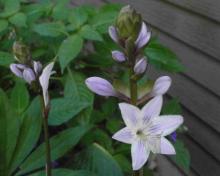
Re: What do you see on your garden walks? 2012
I'm going to have to look out for more Rosularia - that one sure is attractive, Trond.
Despite the heat and drought, everything looks so fresh and pristine, Rick! A few hostas around here too, though I tend to think of them more and more as space-fillers (ones that are rather vulnerable to hail damage).
I dunno, I think your plant could very well be Orostachys iwarenge... it doesn't look too dissimilar to this one (except that mine's a little hail-bruised):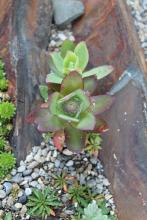
Stachys minima: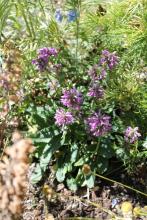
Mother-of-thyme, Thymus serpyllum - I love seeing the bees enjoying it!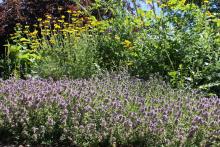
Re: What do you see on your garden walks? 2012
This is what I have from seed labeled as Orostachys iwarenge from the NARGS seed ex. I don't know if it will ever look like yours, Trond. I wonder what it is...
I have to agree, I don't really understand the hosta mania, either. Although I do keep several around. In fact, another one of my favorites is all green leaved, too: Hosta 'Sparkling Beauty'. Fairly (but not completely) slug resistant.
Have your tried your Orostachys outside?
'Sparkling beauty' is a beauty, indeed! . . . . and somebody should start breeding Hostas for flowerpower, not leafpower!
I'm going to have to look out for more Rosularia - that one sure is attractive, Trond.
Despite the heat and drought, everything looks so fresh and pristine, Rick! A few hostas around here too, though I tend to think of them more and more as space-fillers (ones that are rather vulnerable to hail damage).
I dunno, I think your plant could very well be Orostachys iwarenge... it doesn't look too dissimilar to this one (except that mine's a little hail-bruised):Stachys minima:
Mother-of-thyme, Thymus serpyllum - I love seeing the bees enjoying it!
Showing, yet again, the rose 'Amsterdam' - what a knockout!
Dracocephalum grandiflorum:
Lori, I could send some pieces of R sedoides if you think it possible.
Here the thyme is done for the season - and almost all the bees disappeared. However bumblebees still hang around and visit everything in flower.
'Amsterdam' really is a stunner, Lori! My father would have loved to see it, he was a passionate rose grower in his elder days.
Re: What do you see on your garden walks? 2012
After seeing that flowering clump of hosta from Rick I agree with Trond - there must be real scope to breed for hostas with good flowers. Some of the older varieties must be much better in this respect.
This year's wet summer has led to far better flowering of many later perennials - usually only the weeds grow well for us at this time - and Crocosmia 'Emily Mckenzie' is a good example. This has a looser and more elegant habit than some and has never been divided over the more than 20 years it has been in the garden.
Re: What do you see on your garden walks? 2012
Tim, Emily McKenzie crocosmia is indeed elegant. And as with everything in your gardens, so well placed!
Have your tried your Orostachys outside?
This is a first year seedling for me. one of three in the same pot. (The other two seemed to have disappeared.) Time will tell if it is true to name. Obviously, Lori grows Orostachys iwarenge outside, and I remember seeing a nice big patch of it in a pic on this forum from someone in Massachusetts (Peter, I think?). I have grown another species many years ago, but it never produced any offsets, so when it bloomed, it was gone.
A word to the wise:
Back then, when a species died or I removed it and no longer grew it, I deleted it from my list of plants I kept on the Excel program. And now I don't have a record of what it was. I've gotten smarter now. ;D First I just formatted a strkethrough the plant's name, but there got to be so many. :'( So I created another book in the same file and labeled it "Past Plants". So when a species dies or is removed, I simply transfer the data out of "Present Plants" to the new book: "Past plants". I refer back to this old plant list more than I ever thought I would.
Despite the heat and drought, everything looks so fresh and pristine, Rick! A few hostas around here too, though I tend to think of them more and more as space-fillers
Our severe drought here lasted from August 2011 through April 2012. Since then, my area has had an abundance of rain, and even our normal seasonal drought period was much reduced. Although, it has been very hot. Those hosta are on the north side of the house, too.
Space-fillers is an apropos name. Hostas have saved space in my garden for new and upcoming special plants several times. The Hosta clausa var. clausa grows where nothing else will (except weeds and woody plants) in compacted clay gumbo (hence the moss). Incidentally, The hosta is rhizomatous, with flowers that never open(clausa).
Re: What do you see on your garden walks? 2012
After viewing the last few posts I realized I had to go out in the garden and hunt down a truly huge bun of Gypsophila aretioides. I found two! They aren't nearly as grand as that pictured from Alan Tower's garden (but I could always sneak them together) :o There's actually more here too; all from a start or two I acquired when I began seeking out alpine plants in the nineties. The second pictured had three flowers on it many years ago; a BIG event and it even, for a moment, became the mysterious Penstemonella aretioides which many Yahooed!, AOLed, and may have even Googled to no avail. Rock gardening is to be not all drudgery and dirge; laboring with heavy rocks and obstinate little plants, tirelessly under the hot sun. One must be light of heart! The first was posted previously but this is obviously the money shot.
Lewisia cotyledon beautifully set for summer and a hint of blue in Lycoris squamigera.
A low growing Phlox paniculata in hot pink/orange. It was a hand-me-down so I don't have a name. Is it 'Red Riding Hood'?
And here's another look at that trough. On the north side under the spruce is Saxifraga 'minutifolia' and little plastic piggies. Below is London Pride; just out of the photo is the tan line (ouch!). The second is a photo of a weird little Selaginella I found in the arid Uintah foothills growing among Ephedras and Echinocereus. I call it "cactus moss".
Bees like onions! -and the giant native Silphium perfoliatum.
Re: What do you see on your garden walks? 2012
The second plant, Symphytum x uplandicum 'Axminster Yellow', is equally hard to propagate as root cuttings lose any variegation and it hardly produces enough growth to divide easily. A nice feature with Phlomis russeliana.
Sorry very late to reply. Today my gardening friend who has a beautiful garden told me about your problem of propagating this plant. I got flowering stalk from the nodes of her plants which rooted easily.
Re: What do you see on your garden walks? 2012
Krish - thank you so much! Now why didn't I think of that; we will give it a go.
Re: What do you see on your garden walks? 2012
Gee, I didn't think I missed that many days, but too many posts to comment on!
Trond, love your meadow, and good you are able to preserve some of those plants.. here, the ration of open to wooded land constantly changes on different properties - forest and wetlands are bulldozed for grazing and shade plants have to be replaced by meadow plants, others become completely overgrown with shrubs and trees squeezing out all of the sun plants, and numbers of animals grazed on a plot vary over years as well, with some becoming mostly the d****d buttercup or yarrow etc; On my family's land, grazed fairly heavily (in the open areas) for a long time, then not so much for recent decades, there are some weedy areas but still a lot of native plants, with some plants I knew in my youth lost to cleared forest sections or loss of meadow to woodies; The last few summers, a neighbour had more cattle on the land again, and it was interesting to me to see more flowering on some wetland plants like Pedicularis and Menyanthes..
Fortunately, most of these plants are regionally fairly common and while particular patches are lost, regionally they are mostly doing fine with this continual habitat flux..
Tim, re: Crocosmia- a few weeks ago I was in a local big box store that was selling Crocs discounted in their garden centre.. I really doubt these are hardy here? but they were just sold as garden plants....
Re: What do you see on your garden walks? 2012
The Crocosmias in my garden have not started showing buds yet this year :-\
Bundraba, those Lycoris are beautiful!
We went for a boat trip yesterday in the nice weather. Thought we should enjoy a flowering island due to enough rain this summer. But they have introduced sheep there too >:( :-X
Previously a few calves have grazed there, but a bunch of sheep eat it all!
Part of the island Jomfruland named Skadden: From left 1 &2, view west, 3 view east (Rick, this is Skagerak!).
Only a few, common plants survive the hard grazing: Hieracium peleteranum and Scleranthus perennis on drier ground, Matricaria maritima, Potentilla anserina and Sagina nodosa on moister ground.
Also the tiny Spergularia salina survive. Only one species benefits from the hard grazing, Senecio viscosus. The animals doesn't like it!
Re: What do you see on your garden walks? 2012
A few more pictures of "my other garden" in the Dolomites. Joe and I spent a day with Cliff and Sue Booker, introducing them to one of our favorite hikes. We came to an area of limestone rubble which was the habitat for hundreds of Papaver rhaeticum. The typical color is a brilliant yellow which fades towards orange as it goes over. This day we found some white ones and some pale yellow, definitely not typical, and an exciting find. If you see an area with many of the same plant, you can often find one or two that are different. I can remember a few years ago finding a white Linaria alpina when hiking with Elisabeth and Rod Zander, an exciting find that I've never been able to duplicate, and many years ago seeing a white Oxytropis podocarpa
when hiking with Panayoti. (Unfortunately, all those pictures are slides.) As you can see, we've been so lucky to have wonderful hiking companions.
Re: What do you see on your garden walks? 2012
A rhizomatous hosta - how interesting, Rick. I wasn't aware of these at all.
Great scenes, Michael - now yours is a garden that just won't quit! What an amazing variety of plants.
Trond, I'm enjoying your boat trip and island tour!
Love the crocosmia, Tim - just a summer plant here though, sadly.
Stunning poppies, Anne! Have you grown these? I have yet to see any of the 3 native alpine poppy species here yet... some day though...
Some pix from the garden - a lot of repeats, admittedly, but hey, summer is short!
Sidalcea malviflora; daylily (the warm summer is favouring them - most didn't even bloom last summer); Allium flavum: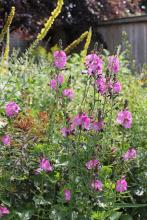
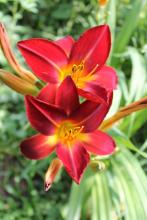
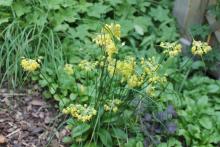
Rose 'Dolly Parton' - very fragrant; flower bed view; Lysimachia vulgaris: 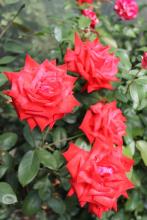
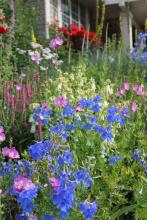
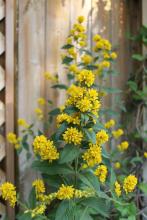
Clematis 'Pamiat Serdtsa'; Dalea purpurea; Linum flavum 'Compactum':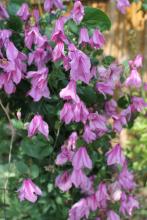
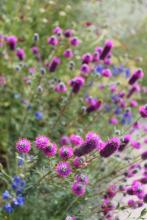
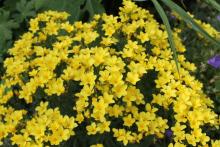
Re: What do you see on your garden walks? 2012
Dianthus knappii - probably notable only for being yellow!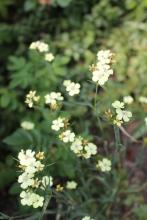
Catananche caerulea, normal colour and white that popped up from self-seeding: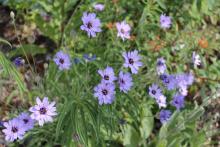
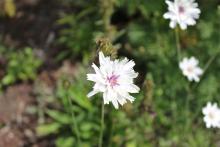
A couple more views - a colourful mess, to some perhaps, but I like it! ;D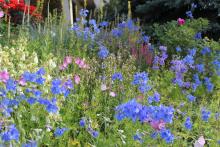
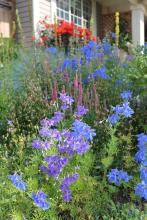
Re: What do you see on your garden walks? 2012
Lori, in my early rock gardening days I thought that Papaver rhaeticum and Gentiana verna would be a brilliant primary color combination. I would have had a red in there a well but couldn't think of one that would look well with the other two. So I grew them from seed and put several seedlings in the scree together. They came through the winter fine and in the spring they made a glorious combination, one that would probably make the lovers of subtlety in the garden shrink in horror. I enjoyed them immensely and in my rock gardening innocence was absolutely stunned when they did not reappear the next spring after a very cold and almost snowless winter. Isn't it amazing the things you will try as a newbie when you're not overburdened with much knowledge.
Re: What do you see on your garden walks? 2012
I have always loved poppies and many, many years ago I had a very large patch with poppies. Only when the flowers were spent I realized they were opium poppies that are forbidden to grow here ;D
Unfortunately I have never managed to grow poppies from mountain areas more than a year or two :-\
Lori, your garden is like the Jar of Zarephat: It never ends producing!
I like your "colourful mess", mine is also a mess but not colourful!
Re: What do you see on your garden walks? 2012
Great scenes, Michael - now yours is a garden that just won't quit!
That's part the fun; it doesn't quit! Well there can be a period, and two winters ago was a good example, and because a lot of the "structure" is new, when it does quit. We had so much snow here that even the tallest of my Rhodies was completely buried. The garden was a white desert flat as a pancake for weeks!
Re: What do you see on your garden walks? 2012
I remember that winter with great fondness. The snow was so deep the deer couldn't manuever and the garden was trackless for a long time. Then last year we went to the other extreme and had no snow except for October.
Re: What do you see on your garden walks? 2012
Love your delphinium masses, Lori! Amazing how much bright color you have. We have more muted colors this time of year, but still, lots is blooming. Your Dianthus knappii is not nearly as bright a yellow as ours. I am very fond of this, and have it in several spots. There seems to be a more compact straing being sold recently. We mostly have pale clematis blooming this time of year--except for some re-bloom on the integrifolias. Our summer has not felt short at all: we have had 30 days over 90F, and no end in sight--interspersed mercifully with a few days in the 80's....
I had Matt Mattus, a great plantsman from Massachusetts visiting this week and we drove around looking at things: a few of the sites on our garden drives are posted here...
1) Cylindropuntia 'Golden Lion': a magnificent cholla growing at Timberline Gardens in Arvada
2) Opuntia 'Chocolate Princess'--and amazing everblooming cactus hybrid produced by Kelly Grummons, one of the owners of Timberline. Incredible dark color now, and even darker in winter!
3) Euphorbia clavarioides at Kelly's--a nice clump that has been through several subzero winters already...
4) -6) various shots of Salvia penstemonoides, one of the rarest (and hardest to photograph) native Salvias...with dark purple flowers...
7)-8) Gentiana paradoxa x septemfida, bringing a lot of color into my garden this time of year...
9) Veratrum formosanum, a wonderful miniature with black flowers that seems to settle down and last a while in the garden. Either you love this.....or you don't
10) Here's Matt Mattus behind the champion clump of Ipomoea leptophylla, spitefully blooming next door instead of MY garden...harrrumph.
Beautiful day outside: time to go garden!
Re: What do you see on your garden walks? 2012
Lori- I think a colourful mess is a good thing to aim for, I have a tiny section with several plants commingling, and quite like it! Getting simultaneous flowering of course is the tricky part, let alone ongoing flowering, both of which I imagine take years of adjusting and luck!
Trond- hope nothing to precious was lost on that island? I've thought fondly of the idea of getting some sheep, goats or even miniature cows or horses to take the place of the lawnmower here, but it would involve a lot of fencing around garden areas and months of feeding when there's no grass...lol
Michael- my garden is a white desert for months at a time! ;D Though the snow isn't really deep enough to be flat/even
Anne very exciting to see the mixed colour population of poppies :) I suspect there are a few things in my garden or seed pots now that more experience might have made me more nervous to try, or more fussy with the soil! Still too soon to say much...lol
Panayoti- is this the same Veratrum offered by Alplains? I don't remember thinking it sounded miniature, but maybe that's all relative to other Veratrums?
Re: What do you see on your garden walks? 2012
Lori, the light sky-blue Delphiniums are my favorite and to have them juxtaposed with a bright rose is wonderful! You go girl!
It's been raining a lot lately and myriad birds nest fungi have appeared in the garden!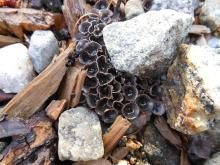
It worked! Peaches(Prunus persica 'Reliance') in zone 4!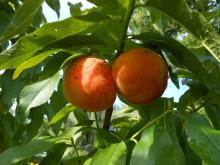
A Sclerocactus glaucus I recently purchased and Christmas in August.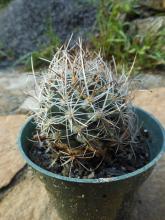

Hexastylis minor from the Southeast and Oxalis decaphylla (?) from the Southwest.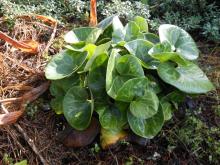
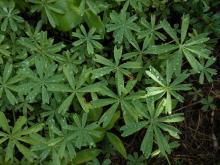
Potentilla tridentata and Bigelow sedge reminding me that I haven't been to the alpine in quite a while; and my portly Yucca glauca in morning light.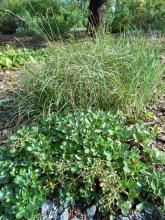
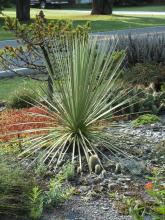
Re: What do you see on your garden walks? 2012
Well - I sowed seed of that Ipomaea but they all damped off, should have kept them to the warmer days of summer to sow. What a plant! I shall definitely try this again. The Dalea is also a must, a fascinating and very 'different' legume. I have just planted D. formosa out on a raised bed and hope I can grow and flower it here.
This is a view of the re-development of our nursery here, intimately linked to the garden, with an old raised bed waiting to be developed as a tufa or crevice/sand bed planting. We aim to try and switch gardeners more on to growing alpines and 'different' plants in the dry south-east of the UK...
Re: What do you see on your garden walks? 2012
Trond- hope nothing to precious was lost on that island? I've thought fondly of the idea of getting some sheep, goats or even miniature cows or horses to take the place of the lawnmower here, but it would involve a lot of fencing around garden areas and months of feeding when there's no grass...lol
I don't think anything rare have disappeared due to grazing, not at this spot anyway. But I believe a rare plant (Trifolium fragiferum) has disappeared from another place on the island. Moreover, as it is a popular place for tourists at the sandy beaches on the leeward side, many interesting plants have disappeared or become rare. Eryngium maritimum for instance, I haven't seen it since childhood. People remove it from the beach as it is too thorny!
Re: What do you see on your garden walks? 2012
Lots of goodies, Panayoti! I wouldn'tmind growing that Opuntia ;)
Congratulation with growing peaches, Bundraba! What's the flowers like on that Oxalis?
Tim, when I get time I will pay your redeveloped nursery a visit! It looks, and so does your garden, terrific!
Re: What do you see on your garden walks? 2012
Tim, that riased bed looks full of promise. Please keep posting pictures as you develop it.
Re: What do you see on your garden walks? 2012
Panayoti - I forgot to comment on the white 'fluffy' mass behind the Salvia- in thumbnail, I thought it was composite seedheads, but full size I realised there must be a cactus under all that white!
Congrats on the peaches, Michael! Lots of fungi here this time of year, too..
Tim- good luck on the project to educate local gardeners- even in places in North America with totally unsuitable climates, people still try for the cliche of the English garden, I suppose within Britain there must be a real struggle to get the average gardener to break the mould? On the other hand, there does seem to be a real gardening culture there, so maybe people will be more adventurous :)
Trond, beach people are so boring...lol the Eryngium is very nice!
Re: What do you see on your garden walks? 2012
Trond, if Oxalis decaphylla blooms, I'll try and remember to get a photo posted.
Gentiana farreri (ex 'Alex Duguid') begins bloom in August. Bupluerum spinosum is new to the garden and Silene schafta gives us pink.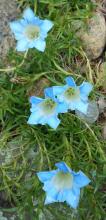
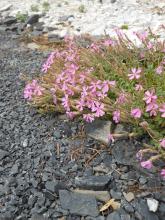
A small Sphaeralcea from the San Mateo Mountains and another great rock fern: Pellaea atropurpurea.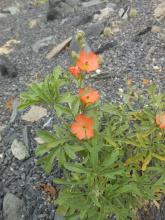
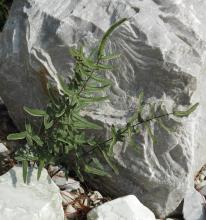
There's been a lot of these Frittilary butterflies this year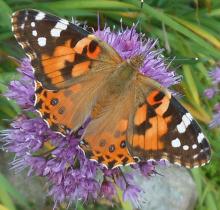
Epilobium canum ssp. 'garretii' (Zauschneria)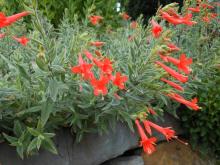
I thought Limonium vulgare(?) might go well with these Phlox: and more Lycoris!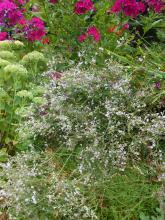
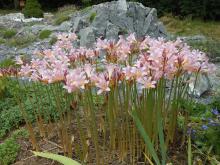
Re: What do you see on your garden walks? 2012
All nice, Michael- great shade on the Silene;
The Lycoris is a bit of a surprise, not that I know that much about them, but had thought they were only hardy to z6 or so...
Re: What do you see on your garden walks? 2012
Trond, if Oxalis decaphylla blooms, I'll try and remember to get a photo posted.
Yes please!
You still impress, Michael! The butterfly is nice too. Similar to one flying here now.
I'm impressed by the Lycoris too. Seems not to be on sale in Europe, anyway I haven't found any sources. Do they set seed?
Re: What do you see on your garden walks? 2012
What great pix you all have: can't wait to visit your garden, Tim! You grow so many plants I love (and have either lost or merely long for)...and as for YOU, Mr. Michael Peden, your cursed garden puts botanic gardens to shame: are you sure you do not have a staff to help you? Love your Southwestern Oxalis (could be O. grayi?)...I have not succeeded with this and thought it might be tender...WRONG! eh?
Cohan: that white cactus is Cylindropuntia whipplei 'Snow Leopard'--commonly grown in Denver. it can get massive (over a meter tall and across) and it's vicious. But stunning too!
The Veratrum formosanum is essentially a micro-V. nigrum, mine are very dwarf--mostly under 15"...but I starve and torture my plants. In a more typical garden where they have richer soil and moisture it can get twice as big--but still svelte and manageable (unlike most Veratrums). The black color is super: I got my first plants from seed from Jack Elliot, but Beaver Creek has listed it...well worth the investment!
The weather is mercifully cooling just a tad, and the plants show it: lots in bloom. This is my first installment:
1) My waterfall bog bed with Solidago I should remove and Lobelia cardinalis starting up: hot yellow and red is a combo I enjoy.
2) Clematis hexapetala--this taken at DBG. Mine are finished blooming. The most spectacular herbaceous clematis from Mongolia. It's been blooming two months.
3) Hosta clausa--the strangest of the genus with NO basal rosettes...love that dark color! At DBG
4) A miniature Hosta (couldn't find the label...will seek it out if need be) at DBG--love these little ones.
5) Impatiens are horrible weeds, especially this I. balfourii--but I would hate to be without them. There is always a woodsy corner to tuck them into...
6) This is my favorite Impatiens, I collected it in Pakistan in 2001: just as weedy as the preceeding, and even more distinctive co
7) Jovibarba heuffellii 'Hot Lips' growing to enormous heights at Denver Botanic Gardens. One of my faves.
8) A smaller J. heuffellii--looking almost snake-like
9) Ligularia (I believe 'Desdemona') in our Asian garden: amazing it looks so good after two months of colossal heat...but we do water the bejesus out of things there!
10) Our last big clump of Silphium perfoliatum in the Cottonwood border at DBG (removed elsewhere due to massiveness and spreading): a great spectacle when in bloom--love it but don't have room for it in my garden, alas!
Re: What do you see on your garden walks? 2012
...and as for YOU, Mr. Michael Peden, your cursed garden puts botanic gardens to shame: are you sure you do not have a staff to help you? Love your Southwestern Oxalis (could be O. grayi?)...I have not succeeded with this and thought it might be tender...WRONG! eh?
That may be going just a bit far Panayoti! And; no staff just clever camera angles! the Oxalis goes under ground for the winter (it's very late up too), thus none of the winter burn that might normally affect many other plants from that region. For example, I have a small birch leaved Cercocarpus that barely survived last year's mild winter. That said, those mountain meadows down there must get pretty chilly. I observe that the summer "heat zone" as mapped for the mountains north and east of Phoenix is the same, or nearly so, as ours here. I've been messing around with Agaves too. These surprise me! I'll get a photo or two for one of these posts. Is your Hosta "stilletto"? This wouldn't qualify as a miniature in my garden but the flowers are excellent. I don't collect the miniatures but have accumulated a few. They are cute but I'll refrain from posting a lot of slug damage here; unless y'all really want to see it :)
Trond; like the Daffs and Snowdrops I have; no seed on Lycoris to date; and those clumps are pretty old.
Re: What do you see on your garden walks? 2012
Panayoti- I thought that might be a Cylindropuntia but wasn't sure --definitely impressive! These are among the few plants that really give me zone envy- there are tons of other plants that will grow here, but I will never have those sorts of cactus displays (there are lots that will grow here, but nothing at all tall)..
this is the Veratrum Alplains lists: Veratrum formosanum (Melanthiaceae) (70x30,Z5,P,C,3:8w) ............................................ 30 seeds / $4.00 30854.01 Ex Nantou, Taiwan, 3000m. Almost unknown to horticulture is this fantastic, late-flowering relative of the Lily family with drooping spikes of numerous deep purple-black flowers over quickly-clumping, grass-like foliage. Usually starts blooming by its third year from seed.
One I'd like to try sometime- on the endless 'list'..lol
Re: What do you see on your garden walks? 2012
PK, those are very healthy Cup plants. They don't look like they are in a very moist place, which I thought they needed. Are they?
Trond; like the Daffs and Snowdrops I have; no seed on Lycoris to date; and those clumps are pretty old.
I wondered if that was an old patch of Lycoris, Michael...
I thinned mine last year for the Chapter sale, but they seem to be doing well. They always look like they will produce seed, but I've always cut them down before they have a chance. I'll let some go this time, and see what comes up for you, Trond. ;D
Re: What do you see on your garden walks? 2012
I thinned mine last year for the Chapter sale, but they seem to be doing well. They always look like they will produce seed, but I've always cut them down before they have a chance. I'll let some go this time, and see what comes up for you, Trond. ;D
That's kind of you, Rick :)
I had to buy this Penstemon, it was named Penstemon 'Rick R' ;D
Re: What do you see on your garden walks? 2012
Rick- another person growing Lycoris in z4- clearly my idea they were z6 was mistaken ;D
Good find, Trond- both for the name and colour :)
Re: What do you see on your garden walks? 2012
My garden is not particularly well-tended at the moment due to our long absence but some plants do bloom anyway.
I have several Clematis and many are flowering at the moment, Clematis (forgotten name), C x jouiniana 'Praecox', Francoa appendiculata (the main flower stem finished for the season), and a untidy corner with a mophead Hydrangea and an Anemone.
The Lonicera periclymenum is a weed but have showy flowers and a very pleasant fragrance, here the cv 'Serotina', a Malva struggle through the dense growth of weedy plants - notice the bindweed, the fern Osmunda regalis, the new growth of Rhododendron bureavii is almost as good as its flowers.
Re: What do you see on your garden walks? 2012
Nice to come home and find lots of things in flower :)
Re: What do you see on your garden walks? 2012
Remember guys, only Lycoris squamigera is fully zone 4 hardy. Other Lycoris not so much. I've had a couple L. chinensis that I've missed digging come through, but not happy looking. And Lycoris radiata survives here for 7 years so far, but never adapting. They come up in the fall, get frozen back, and limp along into the summer. Leaves never surpass a pitiful 5 inches and they don't look that happy. They apparently are cold hardy enough, but never amount to anything.
Re: What do you see on your garden walks? 2012
Idyllic late summer: There's a lot of "fade". Iris have stopped growing, Daylily leaves are tinged with browns and yellows, the air is still and thick but not uncomfortably so. There is a lot of rot in some of the "alpines" -this is unfortunately normal -but I really like the scene in the garden now, composed of only a few plants, but so glorious; the slow turn-over into autumn! The blues in Platycodon and Gentiana add a touch of magic but they must be sought by the eye in this garden right now as they are not common.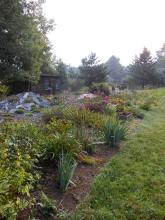
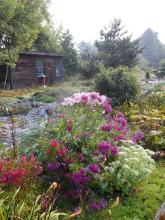
An expanded view of My Little Shade Garden and an excellent Hosta for flower color; H. 'stilletto'.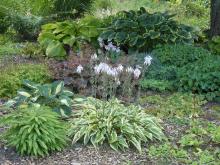
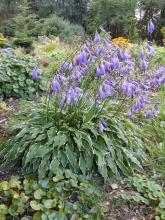
Re: What do you see on your garden walks? 2012
Very nice shade plantings with the hostas. Do you not have slugs in the garden?! By this time in the year we are normally very dry (naturally and due to too many woody plants), so many late flowering perennials struggle. I give the alpines on the sand bed a good soaking every now and again...
Re: What do you see on your garden walks? 2012
All those beautiful plants and plantings, Michael, and peaches too! I never would have thought that was possible in zone 4.
Heck, I'm amazed at Lycoris squamigera being hardy... must give them a try now.
Wow, nice penstemon, Rick Trond - it is an amazing colour. (Hey, knowing that you are a lover of language, note that that plant will give you the chance to use the word "eponymous" ;D ;D... a rare enough opportunity!)
Re: What do you see on your garden walks? 2012
Seems I should try any Lycoris I come across!
Michael, my favorite time of the year is the spring although all the other seasons have their charm too ;) Have to look for Hosta 'Stiletto' too ;)
Have been warm and dry for some days. However I don't need to water the garden but a few pots.
Bacopa 'Blue Shower' and an Agapanthus
Re: What do you see on your garden walks? 2012
I had to buy this Penstemon, it was named Penstemon 'Rick R' ;D
Rick, did I miss previous mention of Penstemon 'Rick R'? Please tell us about it, the color is amazing!
Re: What do you see on your garden walks? 2012
I had to buy this Penstemon, it was named Penstemon 'Rick R' ;D
Rick, did I miss previous mention of Penstemon 'Rick R'? Please tell us about it, the color is amazing!
Ooops, sorry! I think I have caused everyone to go astray - I just backtracked and realized it was Trond who bought Penstemon 'Rick R', not Rick! :-[ Scratch my comment about using the word "eponymous"... unless you can come across that one, Rick. Any idea of the heritage of that penstemon, Trond?
Re: What do you see on your garden walks? 2012
Michael- your garden looks as dreamy at this time as ever :) I'm especially happy to see the larger views, since I am just now thinking about how far to space regular perennial beds from raised rock beds, and have not yet come to any conclusions (except that I have one that is way too close, since the Achilleas are flopping over onto the edge of the rock garden...lol) Anyone else that has shots that show how the two types of beds relate to one another in your landscape, I'd love to see!
Tim, always nice to see your sand bed-- not dry here, although we are having some warm sunny days, after tomorrow, the whole week has 30-70% chance of rain again...
Trond- nice blue on the Bacopa- is that an annual or can you overwinter it?
Re: What do you see on your garden walks? 2012
Ooops, sorry! I think I have caused everyone to go astray - I just backtracked and realized it was Trond who bought Penstemon 'Rick R', not Rick! :-[ Scratch my comment about using the word "eponymous"... unless you can come across that one, Rick. Any idea of the heritage of that penstemon, Trond?
Lori, I wondered who you talked to and what you talked about ;D
I can't find the label although I am sure I put it somewhere. I think it was Penstemon superbus 'Rick R'. I'll report on hardiness next year!
Trond- nice blue on the Bacopa- is that an annual or can you overwinter it?
It is a perennial although I assume it is difficult to overwinter inside. I'll try though.
Re: What do you see on your garden walks? 2012
I can't find the label although I am sure I put it somewhere. I think it was Penstemon superbus 'Rick R'. I'll report on hardiness next year!
You just won't stop the charade, Trond! Fun, but I'm on to you, though... ;D ;D ;D
I thought that bacopa was extra nice, too. The white form has been around for decades here, but only now is it catching on with the general gardener.
Re: What do you see on your garden walks? 2012
I can't find the label although I am sure I put it somewhere. I think it was Penstemon superbus 'Rick R'. I'll report on hardiness next year!
You just won't stop the charade, Trond! Fun, but I'm on to you, though... ;D ;D ;D
I thought that bacopa was extra nice, too. The white form has been around for decades here, but only now is it catching on with the general gardener.
I'll shut up now, Rick!
It's the second flush on that Bacopa. It flowered in June and beginning of July and had a break in late July. Then started again in August!
Re: What do you see on your garden walks? 2012
Been a while since I stepped in...been too busy to breathe this summer. Here are a few Gentians which are currently open. G. decumbens, G. macrophylla and G. walujewii var. kesselringii
Re: What do you see on your garden walks? 2012
A couple of alliums....good ole A. flavum and A. togasii
Re: What do you see on your garden walks? 2012
Been a while since I stepped in...been too busy to breathe this summer. Here are a few Gentians which are currently open. G. decumbens, G. macrophylla and G. walujewii var. kesselringii
MMMmm, I like each and every one of those Gentians! But I particularly like the light blue blooms on the last one (G. walujewii), contrasting with the spotted yellowish centers and brownish-purple tipped buds.
In my garden, it would be impossible for Allium flavum and A. togasii (also spelled togashii) to bloom at the same time, A. flavum blooms starting the end of June into July, and togasii starts late August and into September, your season must be very contracted to have them bloom together.
Re: What do you see on your garden walks? 2012
That light blue gentian is also my favorite.
How it comes up with that arrangement of open blooms is a mystery to me.
Re: What do you see on your garden walks? 2012
Nice Gentians, Todd, I like A flavum, too..
Re: What do you see on your garden walks? 2012
Delphinium grandiflorum..amazed the slugs missed this one! Blooming first year from seed. Inula rhizocephala..slugs DO love the blossoms. Guess blooming the first year from seed means its monocarpic. And my newest addition, the hardy Impatiens omeiana.
Re: What do you see on your garden walks? 2012
Todd, I've grown Inula rhizocephala before, but don't recall it having much longevity and I was away when it produced seed. How long has it lasted for you? Should you ever have extra seed, please think of me.
Re: What do you see on your garden walks? 2012
My understanding is that Inula rhizocephala is monocarpic....I have two plants...one blooming, the other appears to be waiting until next year. I saw it first in Lori's garden...maybe she will comment in regards to how long her's lived.
Re: What do you see on your garden walks? 2012
I've actually had Inula rhizocephala last for multiple years (I'm guessing ~3? - not a long time, but not monocarpic though) as well - that was with the original plants I had out along the sidewalk in regular soil. I also heard one account of it being perennial here in another garden. The plants I later put in phase 1 of the tufa garden did act as monocarps... not sure if that was due to excessive moisture in that area (a low spot, underlain by rich soil).
Re: What do you see on your garden walks? 2012
Great looking Impatiens, Todd!
Re: What do you see on your garden walks? 2012
I have a blooming mystery Aquilegia. Sown from seed this year as A. parviflora but while the flower is minute, it is not that species. I cannot find anything in Nold's book that comes close. I am thinking a hybrid between viridiflora and one of the canadensis types, based on size and shape.
Re: What do you see on your garden walks? 2012
:( I'll apologize in advance for this rather blighted post. It may not be suitable for all audiences.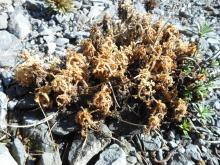
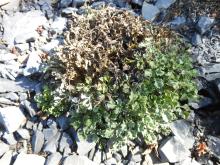
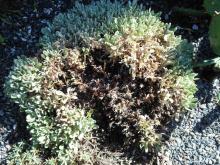
Erigeron compositus, Centaurea simplissicaulis, Eriogonum flavum 'xanthum': The fungus/mold fibers were quite evident on the last. below: Are these ants (termites) foraging on the fungus that attacks alpines? They are pouring out of this blighted cushion of Saxifraga bronchialis. Some plants survive the fungus period. Others do not. In some cases I'm able to out fox or out propagate the attrition rate or, at least, it seems to seem so.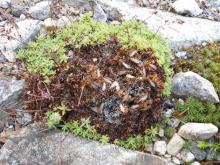
The Psylid (on sunflower leaf) that makes growing the Aster family (most) an ugly challenge in my garden. There have been curious, usually brief, exceptions.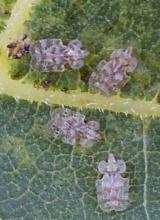
Finally here is a conundrum, one of many we face. These Asarum europeum are growing side by side. In the second photo; Shortia galacifolia planted in my experimental "New Sand Barren". Some green is beginning to creep into the sickly yellow leaves. I've been applying a gravel and crushed stone (feldspar?) as well as some peat to the barren sand. The yellowing might be due to excessive nutrient (and magnesium) in the soil or other imbalance.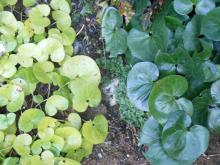
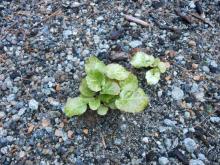
I do see this stuff on my garden walks.
Re: What do you see on your garden walks? 2012
A rare instance: This sage brush (Bighorn Mountains, 2004) seems less prone to Psylid attack than many other plants on the garden. I think its the pewter shepherd dog!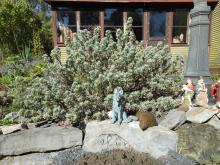
Here's a nice little late blooming buckwheat backed by Satureja montana.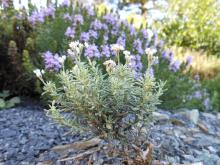
The odd flower on Iris suaveolens 'rubromarginata'.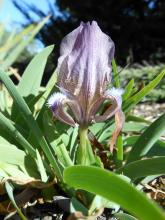
Three little Western peas grown from 2009 seed. They will all bloom gloriously next year of course. The third is an orophaca and (all/any) up there pretty high on my "must grow" list.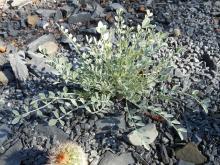
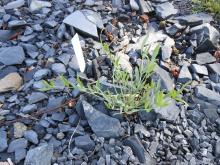
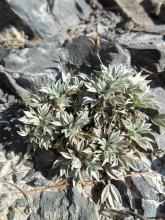
Three agaves that survived last winter. The last, planted right at the south foot of my house has come through two winters. Note two tiny pups off of the first. It is planted in a crevice pocket with probably scant root run due to construction. I consider these a horticultural stunt to trump sage brush but a fun idea! They are: First is from SW New Mexico at 8500' or so (estimate). The other two hail from central Arizona (8000' estimate). The Arizona population seems just a bit tougher. I've just now obtained another try at A. utahensis which grows yet farther to the north and west.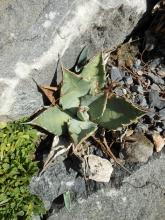
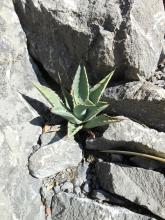
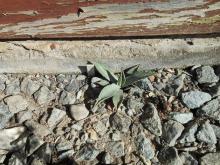
Re: What do you see on your garden walks? 2012
Must be a pain to lose so much growth on slow-growing plants!
I've never heard of that pest on Asteraceae :o
Nice to see the other set of plants still thriving- great sage brush, and the Agaves are looking good, what species are they?
Re: What do you see on your garden walks? 2012
I've been aware of this pest in other gardens, even in other parts of the country, but seemingly not so bad as here, which really makes me wonder if growing conditions contribute to the problem: The plants may have a defense, but if it isn't available to them via the environment, they are lost. In your case, Cohan, I suspect the lack of certain pests might have something to do with that -49 degrees you post. That would probably deter me!
Unless the splitters have been busy the Agave is still A. parryi.
Re: What do you see on your garden walks? 2012
Probably the cold winters help with some pests- though you'd never know it by the bazillions of bugs in general- and they are out before the snow is gone (though maybe its the large number of bugs that keep pests limited)! To be accurate, though, I've never seen that -45C-49F in person, its just a record low, usually nothing lower than -40C/-40F and not always that even. Nonetheless, there are some days in mid-winter when I find it hard to believe that anything- animal or vegetable- can still be alive out there!
Interestingly, there has been a need for sub -40 winters to slow the eastward spread of pine beetles (not right here) and we just haven't had much of it. Last I've heard, though, the beetles have slowed a bit for some other reason....
Re: What do you see on your garden walks? 2012
Scilla scilloides is putting on a much better show this season compare to recent years.
Apparently, eryngiums are quite tasty; I suppose that is why the are usually so darn thorny. Something ate one of my two Eryngium agavifolium planted out this year in the garden. A 3 inch divot was left, and the culprit had eaten right into the soil. I could still feel the primary roots radiating out from what would have been the crown. Eryngium agavifolium is not prickly at all.
A Helianthus cultivar. Sometimes the buds are more interesting than the flowers. And Gentiana septemfida, not liking the heat stress.
Vernonia gigantea topped out at 9ft 10 inches. Yes, I measured, and how else but on a ladder can I get pics of the flowers?
Re: What do you see on your garden walks? 2012
Euonymus hamiltonianus var. sieboldianus is beginning to color up for its last year in the yard. :'( After ten years it is beginning to sucker, and I don't want the next door neighbor having to deal with it. On the bright side, E. planipes (thanks, Mark!) or a medlar will be replacing it.
Pics of sieboldianus from above and below.
The herbaceous Aralia continentalis replaced the woody Aralia elata that had threatened to invade my other neighbor's lot. Chamaecyparis thyoides always has heavy cone set for me.
Re: What do you see on your garden walks? 2012
Rick - the Vernonia must be really stunning to have in the garden! I wonder how tall Eupatorium purpureum can get under ideal conditions? Your mention of Eryngium yuccifolium reminded me of the New Zealand aciphyllas, another formidable group of umbellifers. Many of the family have the same chemistry as things like carrot and parsnip, and if you smell the roots you can often make this out. With the aciphyllas their form must have evolved to counteract grazing by the many flightless moas of past times. Having said this I have had rabbits eat the leaves in the garden here so they must be particularly tasty!
Re: What do you see on your garden walks? 2012
Kelaidis, what a nice Salvia is your S. penstemonoides ! I didn't know it.
Re: What do you see on your garden walks? 2012
Salvia penstemonoides was thought to be extinct, but was rediscovered near Dallas, Texas--it is a beautiful thing that seems to be hardy for us. I am amazed that Impatiens omeiana is hardy in Newfoundland, Todd! Or has it not been through a winter? Inula rhizocephala has always been monocarpic here, Lori--you must have very special conditions to have it rebloom twice more. I am relieved we do not have Psyllids, however. This time of year the garden seems to have a second spring, and the botanic gardens has almost too much to relate, but my own garden is more manageable. Here are some of the highlights from the last day or two...
1) This pale form of Allium cyaneum came to me as A. sikkimense (Joy Creek Nursery)--it's better sited than others of this species, and shows off more. Needs something contrasting next to it, though...
2) Artemisia filifolia is the only shrubby sagebrush in this area, always growing on sandy soils. It was native to my property, and this one magically appeared in just the right spot. I love its extravagant swirls.
3) Colchicum (Merendera) pyreneicum is always the first of its clan, inducing a bit of panic (which is why its Spanish name is "I scare the shepherds" [with the approach of winter]/ I love it in the evening when it closes,
4) And in the daytime when it is wide open.
5) I take my tender cacti outdoors for the summer, where they are happier, and often bloom: here Coryphantha elephantipes
6)-7) I've grown Cyclamen purpurascens long enough that seedlings are popping up all sorts of places--here in among sempervivums, and elsewhere--often in full sun!
8) Not much blooming here on my dry xeriscapes (east and west Ridges), except for Mexican hair grass (Nasella tenuissima) which I must cut back before it takes over...
9) Eriogonum allenii is well into its second month of blooming, alongside Seseli gummiferum: two of the mainstays of my summer garden.
10) Hedeoma hyssopifolium from the Chiricahua Mts. of New Mexico, its first year here. It makes a dense mound of bloom with time.
Only down to the H's--must post another note next for the rest...
Re: What do you see on your garden walks? 2012
1) This time of year the Hylotelephiums make a great show: just planted this H. 'Bertram Anderson'' a rew weeks ago...
2) Hylotelephium cauticolum must be one of its parents: it makes a great show on a dry corner of my rock garden where it's hard to grow most alpines.\
3) The Star Performer in my garden right now is this Lobelia cardinalis, or probably a hybrid with the Mexican species, come to think of it. It's been in this spot then or more years.
4) Even the vegetable garden is decorative with Ipomoea (draped, bloomsin the morning) and crimson Amaranth everywhere.
5) Salvia microphylla 'Hot Lips' has been blooming much of the summer, but lulls at the height of heat--now that its cooled off a bit it's kicking in. Amazing a plant from southern Mexico is so hardy.
6) I love the scarlet of Salvia darcyi, which I finally have growing well at home.
7) Just to prove I am not a rock garden snob, I do grow a few annuals (here in a brash combination: petunias, callibrachoa and Angelonia)
8) Kniphofia porphyrantha finally blooming after half a dozen years!
9)The black spikes on Veratrum formosanum--one of my favorites, dark though it be..
Re: What do you see on your garden walks? 2012
Noticed the last two did not show up: will try posting them again:
7) Just to prove I am not a rock garden snob, I do grow a few annuals (here in a brash combination: petunias, callibrachoa and Angelonia)
Kniphofia porphyrantha finally blooming after half a dozen years!
9)The black spikes on Veratrum formosanum--one of my favorites, dark though it be..
Re: What do you see on your garden walks? 2012
Rick, I don't think I'll ever grow a plant that I need a ladder to admire! At least not in one season.
I had several Eryngiums once and they were never touched by slugs ;)
Scilla scilloides looks pretty. Seems to be a nice plant.
Re: What do you see on your garden walks? 2012
Rick, Scilla looks good, and Vernonia impressive! I have yet to try and fall blooming bulbs here, curious to know if any of them will be early enough to make it...lol We've already had a couple of frost warnings- for Rocky Mountain House (30km west), but I think my yard is not as quick to freeze..
Panayoti- second spring indeed! lots of good reds :) A couple of tiny C purpurascens are flowering here right now, too..
Re: What do you see on your garden walks? 2012
Panayoti, Impatiens omeiana is completely hardy here and my climate isn't any better than Todd's! I can't grow the red salvias for instance and Lobelia cardinalis survive only a season or two. I would love to have they all in my garden!
Winter is still some months away here so the cyclamens have not appeared yet.
Re: What do you see on your garden walks? 2012
I must first correct a mistake I made recently in this thread (now corrected in that post):
http://nargs.org/smf/index.php?topic=1009.msg19409#msg19409
Not Eryngium yuccafolium, it is Eryngium agavifolium. A slip of the mind, and hard to believe no one caught that! E. yuccafolium is commonly listed by American nurseries offering prairie wildflowers. It is a very different looking plant.
---------------------------
I especially like flowers that open and close and open and close... but that Colchicum is certainly the most dramatic that I've seen! All great plants, Panayoti and Michael!
Re: What do you see on your garden walks? 2012
Rick, I once did grow both but I didn't remember which was which ;)
Re: What do you see on your garden walks? 2012
Wow, terrific plants, everyone!
Not much left that hasn't bloomed already...
The progression of Carlina acaulis from early bud to flower: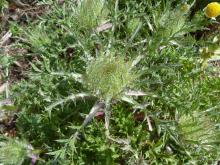
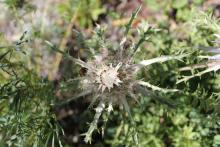
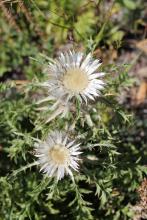
Myriad flowers on Gypsophila oldhamiana x2; Ratibida pinnata; Savia glutinosa x2: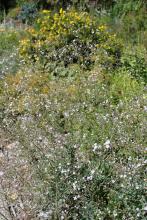
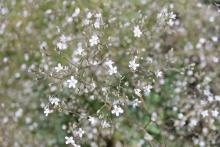
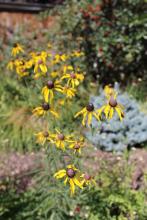
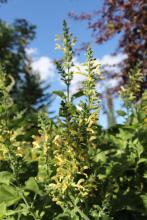
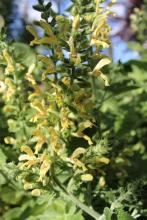
Re: What do you see on your garden walks? 2012
Still looking good, Lori- we've had a couple of frost warnings already, though no frost here, I think..
the wild Castillejas here usually have some bloom until killing frost; there were lots ( though I wont try to name) flowering from the foothills through to high elevations when we went out the other day...
Re: What do you see on your garden walks? 2012
Artemisia filifolia is a bit of a revelation - I've never seen an artemisia before that you could say is actually attractive in flower! (I now wait to be proved wrong). This is one I would certainly like to grow. We are slowly changing the face of our front garden and the artemisia would fit well here! So far not much has been planted but there is Salvia apiana (possibly not really hardy enough) and a Sphaeralcea species. It has been inspired quite a bit by American gardens and by a desire to 'break the mould' of the typical British garden, mainly because of our very dry climate here in Kent.
Re: What do you see on your garden walks? 2012
Artemisia filifolia is indeed a spectacular plant!
Tim, it struck me that the remnants of the conventional lawn border around the unconventional gravel bed might well be sacrificed one day for other benefits - extensions of the gravel bed gardening space and walkways, while at the same time, freeing up lawn-mowing time for more productive gardening?... Why would I not be surprised if it's in the future plans? ;) ;D
Re: What do you see on your garden walks? 2012
Colchicum agrippinum
Nice one!
Re: What do you see on your garden walks? 2012
You are quite right Lori! But I still have to convince my wife. I would really like to do away with the lawn and gradually develop that sort of planting shown in some of Panayoti's pictures - a gravel walkway between the plants. The history of the garden though means I will never capture such a natural and restrained planting, but we are keen to propagate from as many of these plants as we can.
Re: What do you see on your garden walks? 2012
A pine barrens aster; Petrophytum caespitosum in bloom; and Zauschneria more floriferous than ever!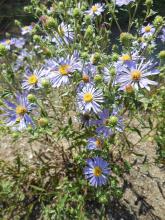
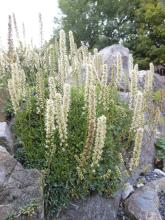
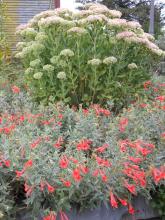
Satureja montana; Hibiscus syriacus 'White Chiffon'; and an Allium, Sedum, Phlox medley.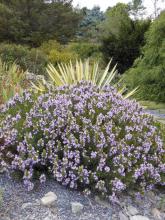
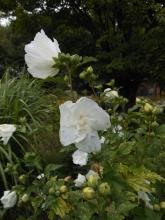
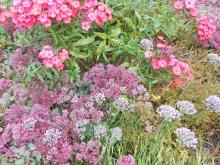
Suicide Newt! Either I interfered or this newt (eft) was lucky I was up early!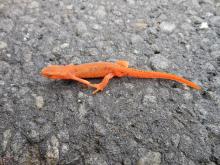
Re: What do you see on your garden walks? 2012
Absolutely glorious, Michael! :o :o
Would that be a red-spotted newt? So much for protective coloration... :rolleyes:
Re: What do you see on your garden walks? 2012
Yeh; protective coloration not so useful in the automobile age. This will probably tell you more than I could from what I know:
http://en.wikipedia.org/wiki/Eastern_newt
They are quite common in the summer woods here.
Re: What do you see on your garden walks? 2012
Wonderful plants, Michael, especially the petrophytum with the zauschneria not far behind. The last is so welcome at this time of year.
Re: What do you see on your garden walks? 2012
I shall be sure to collect lots of Artemisia filifolia this autumn--it is a very graceful plant. I am very fond of the Artemisias--probably because it was my mother's first name! And I like silver plants (and they like me). I am also very impressed with Michael's Petrophytum--I had some fabulous gnarly old specimens at my old garden, but this garden ithey are still a bit young (although four or five are bloomning). Still beastly hot here--but the cooler nights and shorter days seem to bring out a lot of autumn bulbs despite not having rain...Isaac, do take a turn West!
Re: What do you see on your garden walks? 2012
Finally downloaded some images...alas! Nothing alpiny. My rock garden does have a lot blooming, but not so photogenic apparently as the xeriscape.
1) a view of Westridge--my xeriscape dedicated to North American plants. Mostly wild sunflowers and the backlit tower of Giant Sacaton grass (Sporobolus wrightii).
2) Backlit young Cylindropuntia whipplei 'Snow Leopard'--vicious but indispensible
3) One of my many favorite Muhlenbergias, this one is M. torreyi (fairy ring muhly is the common name)--they are too young to form rings yet--but what a wonderful foil to the cacti! Artemisia filifolia in the background (again)
4) Salvias and annual Cleome serrulata on the xeriscape with morning backlight
5) A better shot of Salvia greggii 'Furman's red' with Nasella tenuissima behind it glowing.
6-9) are a series of shots of Lobelia fulgens x cardinalis, showing it in different angles and two different lights. This is one of the spectacles of the garden, and the other morning I woke up and saw a sunbeam lighting up just it, so I had to go and photograph it, and now you have to look at it! I love brilliant reds in the garden...
10) Aha! there is one more pic--this is our poor vegetable garden, almost completely draped in Ipomoea--Jan Fahs (my companion) refuses to weed it out--it is awfully lovely in the morning. But what about my veggies?
Re: What do you see on your garden walks? 2012
Really nice, Panayoti, especially with the morning light! I like the westridge a lot- I need to do something like this where I can make some larger plants happy, but have to pick a good spot for it, still struggling a bit with issues of scale and proximity between larger plant beds and rock gardens etc...
Re: What do you see on your garden walks? 2012
A few flowers from just under a week ago
Potentilla nepalensis Ron McBeath I have a couple of forms of this species now, and really like the flowers; this one I think I have sited a bit better, and the more upright plants around it (Veronica, Achillea etc) seem to be keeping it a bit more vertical. The other one I have (Miss Wilmott) is sprawled a couple of feet in each direction- I think it might be best planted under an open shrub..
Geranium himalayense The big flush of flowering is much earlier on our extensive patches of this, but there is occasional rebloom; this particular patch has been mowed twice- once after flowering and a couple of weeks later when my friend thought it was supposed to be mowed all the time...lol; The young foliage is perhaps nicer than the flowers, of which I really don't like the colour...
Echinacea- I'd have to go check the rest of the name; supposed to be white, not sure if it will ever get much past this stage this year.. I bought this as an end of season $1.00 plant some weeks back, it was still very healthy, with one bud which has very slowly got to this point..
Re: What do you see on your garden walks? 2012
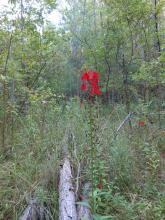
Wow! Let There Be Light! Wonderful images Panayoti! The sun never sets on the rock garden! Nice to see some proof of this theory.
Re: What do you see on your garden walks? 2012
Is this also Lobelia cardinalis, Michael? Equally striking in its natural setting! This is one I definitely need to test for hardiness :)
Re: What do you see on your garden walks? 2012
Is this also Lobelia cardinalis, Michael? Equally striking in its natural setting! This is one I definitely need to test for hardiness :)
Panayoti, a beautiful Lobelia!
I am sorry but Lobelia cardinalis and hybrids doesn't like my climate :( Too wet in winter I suppose :-\
However I'm intended to try at my summerhouse.
Cohan, I like the colour of G himalayense flowers! ...and P nepalensis ;)
Re: What do you see on your garden walks? 2012
Thanks, Trond. I'm not sure if the Geranium colour comes through fully in my photos- I like violet flowers, or blue, or pink, but these are a kind of almost fluorescent shade I just don't like up close-one of the few flower colours I don't like (along with the funny muddled colours of hybrid daylilies and hibiscus :-X ) from farther away they are just 'purple' :) I think I've shown pics of the whole beds in flower? The P nepalensis I like a lot- this hot pink and the other is a mixed orangey colour..
I thought L cardinalis was a sort of swamp plant in nature? though I could be mixing it up with something else...
Re: What do you see on your garden walks? 2012
I thought L cardinalis was a sort of swamp plant in nature? though I could be mixing it up with something else...
No you are right! But it doesn't seem to like the changing wet - cold - mild - wet weather here during winter.
Re: What do you see on your garden walks? 2012
Fabulous plants, Panayoti!
Michael, with great rock gardens, as Panayoti and you both have, your saying is definitely true!
I lusted after Lobelia cardinalis for many years but don't recall ever having one winter over (or only weakly, if it did). First off, plants that were sold around here in those days that were named L. cardinalis were often actually hybrids of tender species, and seemingly doomed. Even presumably-true L. cardinalis from seed hasn't wintered over though. However.... if other people around here do find it to be hardy, I've love to hear about it (and so be encouraged to try it again!)
Re: What do you see on your garden walks? 2012
Fuchsia procumbens 'Wirral'
Fuchsia procumbens 'Wirral', flower detail.
Re: What do you see on your garden walks? 2012
Fuchsia procumbens 'Wirral'
Fuchsia procumbens 'Wirral', flower detail.
That's a pretty cool plant, Michael! Is it small? what sort of conditions do you keep it in?
Re: What do you see on your garden walks? 2012
It is a creeping plant about two inches(5cm) high. At the moment it is in a pot as I am not sure how hardy it is yet, but I will try it out in the garden next summer.
Re: What do you see on your garden walks? 2012
Michael - how on earth do you get it to bloom? I have had one (from a cutting from New Zealand) for several years in a pot - lots of foliage but only during it first year were there any blooms. It gets 20 20 20 fertilizer once a week in summer. It is in a "hanging" pot - perhaps it needs to climb? Have actually set up some string trellises for some of the non-performers and they look much better but now, with fall coming on and less daylight, it may be too late for blooms this year. Fran
Frances Howey
London, Ontario, Canada
Zone 5b
Re: What do you see on your garden walks? 2012
Frances, It is in a soil-less compost with slow release fertilizer. I wasn't aware that there was a problem flowering it, probably won't flower for me anymore now that I know. I will blame you if it don't ;D ;D ;D
Re: What do you see on your garden walks? 2012
A friend has said me than its variegated Fuschia procumbens flowered more and better than its green one. She keeps them in'doors during winter ;)
Re: What do you see on your garden walks? 2012
I had Fuchsia procumbens for some years in a pot (outside in summer, inside in winter) and it flowered sparsely. I decided to plant it out - shouldn't have done it. It disappeared, probably due to frost in winter.
Re: What do you see on your garden walks? 2012
After reading about your F.procumbens, Michael, I went outside to have another look at mine and, lo and behold, there was one flower. Is there something about the air in New Zealand and Australia that creates flowers which do well only there?? I have the luxury of being able to winter over some of my plants in a greenhouse nearby and, in the case of this fuchsia, it didn't help. Although I suspect that the some of the plants that get the "greenhouse treatment" pick up more bugs inside that when they are outside - in summer, that is...something like our hospitals. Fran
Frances Howey
London, Ontario, Canada
Zone 5b
Re: What do you see on your garden walks? 2012
After this almost non-stop drought we've been having (and are still) this summer, it is heart warming to see some of the survivors- a couple of ferns, Adiantum pedatum and a Wood Fern, plus some nice Thalictrum rochbruneanum- not sure I can get them all onto this one e-mail. Up until the new growth appeared on the ferns, it looked like there had been a fire. Fran
Re: What do you see on your garden walks? 2012
After this almost non-stop drought we've been having (and are still) this summer, it is heart warming to see some of the survivors- a couple of ferns, Adiantum pedatum and a Wood Fern, plus some nice Thalictrum rochbruneanum- not sure I can get them all onto this one e-mail. Up until the new growth appeared on the ferns, it looked like there had been a fire. Fran
Good to see some survivors, Fran!
Re: What do you see on your garden walks? 2012
Ferns are remarkably drought tolerant! They can seem completely dessicated but revive when they get water. Th rochebrunianum is one of my favorits too!
Re: What do you see on your garden walks? 2012
Miscanthus 'Gold Bar' seems to be hardy in zone 4, at least for the last four winters... Not sure if it will ever get very big, though.
As is the Cinnamon vine (Discorea batatas) complete with bulbils, and climbing on a Meader persimmon.
Three cultivars of Japanese Forest grass...
Hakonechloa macra 'Albo Striata'
Hakonechloa macra 'Aureola' and 'All Gold'.
Aster sericeus. The second photo also shows the silver seed stalks of Echium russicum.
Part of a garden, showing Jeffersonia dubia, Brunnera 'Jack Frost', a couple of hellebores, Hakonechloa macra 'All Gold', a couple species impatiens (balfourii and glandulosa) and a cultivariant of Chamaecyparis pisifera 'Sulphurea Nana'.
Re: What do you see on your garden walks? 2012
Some nice colours and textures, Rick!
I can't quite tell from the photo, what sort of plant is Miscanthus- a grass?
The 'cinnamon yam' I think was said by Richter's Herbs to be hardy for at least one grower in z3 in Alberta; I killed one a couple of years ago, but can't quite remember how/why -- I don't think it was winter, maybe it took me too long to find a permanent spot for it and it expired in the small pot, long before winter...lol I'll have to try again when I have a spot pre-prepared! Do you harvest the tubers?
Re: What do you see on your garden walks? 2012
Rick, is the Miscanthus 'Gold Bar' a named form of Miscanthus zebrinus? I have the latter and they are remarkably similar. Miine is at the 5' mark and doing well. It seems hardy so far (4 winters, but not what I call normal winters as far as cold goes).
Re: What do you see on your garden walks? 2012
The pic of the Gold bar miscanthus isn't very indicative of the genus. Most of the species cultivars normally grow 3-6ft. Gold Bar hasn't shown up here until the last several years, and I haven't seen any hardly any larger than mine yet. Certainly no flower heads. I use to have a few different kinds, but they take up so much room that I now only still have 'Flamingo'. It's kinda behind with the white fluff in the far right in this fall 2011 photo.
Zebrinus is a Miscanthus cultivar, too. Both come from Miscanthus sinensis, and Gold Bar is a section originating from M. sin. 'Strictus'. Zebrinus leaves are more than half green with yellow horizontal bands. Gold Bar is 50% or less green, with the remainder yellow, less vigorous, more compact, and shorter. Unlike Zebrinus, I am not even sure if it flowers. At least, you never seen pics of it flowering.
In my zone 4 climate, Zebrinus is hardy, but in some winters, clump will reduce severely. Consequently, division is seldom needed. With most miscanthus cultivars, plants must be divided every 3-5 years if you want to keep the size in check. Gold Bar is thought to be less hardy.
Re: What do you see on your garden walks? 2012
Rick, what are the trees you are showing in your photo above?
Re: What do you see on your garden walks? 2012
Rick, what are the trees you are showing in your photo above?
Pic taken 30 Nov 2011. From left to right:
Pinus sibirica
Chamacyparis pisifera thyoides 'Heatherbun'
Pinus strobus 'Densa'
(senna seed pods above)
Thuja occidentalis 'Warreana Lutescens'
Pinus strobus 'Wintergold' (foreground branch)
Re: What do you see on your garden walks? 2012
Wow, very nice, Rick! The Chamaecyparis and Pinus strobus are especially striking!
I wonder if the Chamaecyparis would do OK here? Has anyone out there tried it?
I noticed that some sites refer to a cultivar called 'Heatherbun' (one word) as Chamaecyparis thyoides, an eastern North American species... a different plant from yours, I take it?
Re: What do you see on your garden walks? 2012
I looked in the World Checklist of Conifers and you are correct, Lori, and the thyoides cultivar is what I have. Note that the official description is round-topped, which mine was for many years, and I had contemplated taking it out many times because of the bland outline, but never got around to it. After 13 years it is getting some character, and I like it much more.
I have tried a couple other C. thyoides dwarfs here in zone 4, without much success. The tree is native to wetter areas in the east. Back in 1996 I bought a dwarf named Chamaecyparis pisifera 'Glauca Nana'. Well it was hardly a dwarf, and when it coned I discovered it was not that species at all, and was actually this blue form of C. thyoides (the tree). Every year it winterburns, and some years very severely, but it always recovers nicely. It kinda has an alpine look for us here in the "flatlands". Here it is in the center of the photo. Peaking up in the foreground is the Qinghai spruce (Picea crassifolia).
I neglected to comment on the Cinnamon vine. Four years ago someone offered me some bulbils in a trade. I planted them in a few places, and I only noticed them emerge in one area, and they didn't return the following year. I though I had lost them all. But now this season I found this one in a another of the places! So I am far from using it as a edible crop. I suspect the Apios americana I received this year will react similarly, as I have no constantly moist areas for it to be happy in. From what I here, that may be a good thing (!).
Re: What do you see on your garden walks? 2012
Chamaecyparis thyoides is hard to get here, however I grow several other of the genus. The problem is, they are no dwarfs any longer! Neither are the other conifers I have.
Cunninghamia lanceolata has no hurry but has reached almost 3m now. Metasequoia glyptostroboides is far quicker. I can't see the top any longer although the stem is very slender. Also the Sciadopitys verticillata has increased the growth speed and is 4-5m tall and very slim. The picture lies. (The dead tree is a birch I have killed - it was getting too big)
I got this redwood (Sequoia sempervirens) as a cutting some years ago. Wonder how it looks in 1000 years :o Taxodium distichum isn't yet like those I encountered in Florida! The Wollemi pine (Wollemia nobilis) is my last acquisition (from Kew Garden). This Aussie has survived 2 years outside till now!
Had a walk in a forest of Monkey Puzzle trees (Araucaria araucana) in Bergen last week!
Re: What do you see on your garden walks? 2012
Some nice trees, Rick and Trond! I have very few spots where I'd like to plant anything taller than about 5-7m. I did stick a few Acer rubrum seedlings in the edges of the natural forest here, and have a couple spots where native birches are dying that I might be able to put something- I have seeds of Honey Locust (I think? forgetting the Latin just now.. seeds are a few years old, hoping they'll still germinate...),, there are no pea trees at all here- I don't count Caragana arborescens as a tree, regardless of what the specific name says, and wouldn't want it on my acreage...
Re: What do you see on your garden walks? 2012
This is my favorite topic on the forum, so many good things to see and learn about here. I can't tell you all how many times I started to prepare a posting here, then ran out of time and thought to myself "I'll post something next weekend", and on and on it goes.
So here are some garden walks scenes from last weekend and this weekend.
Left: garden scene with one of my selected Epimedium hybrids that has red leaves all season long, brighter red in late summer. Pulmonarias and Corydalis lutea surround.
Right: great late summer foliage on Pulmonaria seedlings, red-brown tinged leaf tips on Cypripedium parviforum var. pubecsens.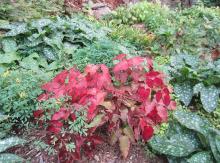
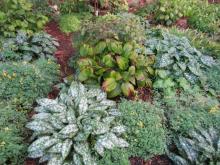
Left: Gentiana clausa, regular blue form, from along the Nashua River about 1 mile from my house. In cultvation, it grows larger and more floriferous.
Right: Gentiana clausa alba, a robust white form, now a mature plant 30" tall x 30" wide, each stem with 4 verticillasters or whorls of bloom.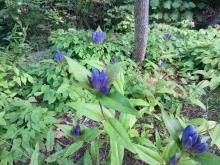
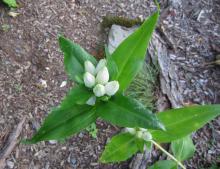
Left: Kirengeshoma palmata is still going strong, although foliage got tatty with 6 weeks of drought. The flowers are a late season delight.
Right: Kirengeshoma koreana, planted as a perennial nursery fine last year, is still small, less that 2', with enlarging yellow egg-like buds that have stayed as buds forever, and the first thick waxy bloom opened today (my photo is from last weeks while still in bud). I wonder is this species will stay smaller, it certainly is much later blooming.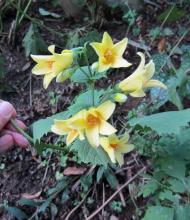
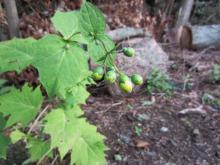
Left: Ariseama seed fruits are setting, this one in an impressive extra-robust form of Arisaema triphyllum x tashiroi.
Right: Two seed cones on Arisaema sikokianum, still green and maturing, amazingly surviving the fall of an ancient massive Sugar Maple just 2 meters away and surviving the trampelling of two tree cutting crews to do the cleanup.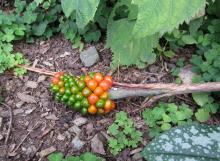
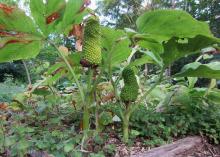
Left: Agastache - 4' tall hybrids from High Country Gardens that have been in splendid full bloom for months.
Right: Patrinia rupestris, all those that were planted on enbankments seeded into low-lying paths, for more moisture perhaps, very pretty toothed foliage and abundant yellow flowers late in the season.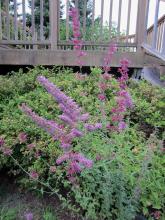
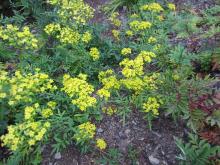
Re: What do you see on your garden walks? 2012
That's the thing about dwarf woody plants, Trond. They may be half or less the normal size, but they never stop growing. You're showing a lot of interesting normal sized species, and I never tire of that most excellent Sciadopitys. :o And those Monkey Puzzle trees are AWESOME !!!
I've heard that the Wollemi pine isn't taking to human cultivation very well in general. A lot of individual growers (not production growers) seem to be having problems. Kudos to you, Trond!
Honeylocust (Gleditsia triacanthos [inermis]) are nice trees, and with the "no leaf raking" in the fall, I've wondered why they are not chosen more. Nectria canker is supposedly a problem, but not in my area.
My neighbor just had an old River birch removed. I was kibitzing with him while the deed was being done, and ended up having the guy come over and remove my big Green ash. (With the Emerald Ash borer only 40 miles away and closing, it's only a matter of time before it dies anyway.) Now I have a rare opportunity: room for another full size tree!
Mark, that red epimedium is a show stopper. It might be too red for me, but I can see how the general public would go ga-ga over it! I was at another chapter member's garden last week; their kirengeshoma was seven naked sticks. Mark, those Arisaema sikokianum fruit heads are enormous! :o I grew some from seed once. For reasons unknown, they all succumb the third winter. Wouldn't mind trying again sometime...
Did I mention yet that my Agastache aurantiaca (planted in 2011) never returned this year? I hadn't cut it back at all for winter, as per your advice.
Re: What do you see on your garden walks? 2012
Great show Mark! Rick, I am really taken with the Aster sericeus...and all those conifers are stunning. I have a few 'dwarf' chamaecyparis which are no longer so dwarf as I like! Money puzzle have been tried outside here but only survived one winter, and that was with lots of protection.
Just survived Tropical Storm Leslie...hit here this morning with 75 mph winds...lots of fallen trees all over the city and I lost electricity for 11 hours. My garden was spared thankfully but I have yet to see the damages at our Botanical garden...tomorrow will reveal all.
Re: What do you see on your garden walks? 2012
Just a few things in the garden. Zauschneria has started blooming in a natural crevice on the back side of the cliff. Seeing that makes all the work cleaning out the crevices and preparing them worthwhile. In the upper crevice garden daphne and astragalus are reblooming.
Re: What do you see on your garden walks? 2012
Your Zauschneria, Ann, looks like a form of Z. californica. You must obtain Z. garrettii which starts blooming much earlier (June here--and still in bloom!)...Our astragalus are long done blooming--it has been terribly dry, although the rain has been steady today finally after a month and a half of no rain...aaaah!
Your garden, Mark, must be awesome! I really hoped I'd get to Boston in July, but didn't work. Maybe next year?
Re: What do you see on your garden walks? 2012
Is there a form of Zauschneria named after Wayne Roderick? That seems to ring a bell. Is Z. garrettii hardy? The nice thing about this one, apart from the color, is that it blooms when most things have finished.
Re: What do you see on your garden walks? 2012
Anne and Panayoti - I've just written a short piece trying to wake up gardeners again to alpines for 'Gardens Illustrated', stimulated by Peter Korn's sand garden. But I also said I thought that American gardeners were really leading the way, and that there is such a wealth of plants from the States that we just don't know about! I won't hold my breath for a sudden upsurge of alpine gardens in the UK but it would be great if landscape designers sometimes became miniaturists!
Re: What do you see on your garden walks? 2012
Todd- good to hear you escaped damage, hope the BG is okay..
Anne- that natural cliff face is wonderful :)
Tim- good work- even if you can plant a seed in just a few minds :)
Re: What do you see on your garden walks? 2012
The fun never sets on the garden. These look like chickens (?). Hmmmph! I did the "buck buck buck-caaaaak" just
enough to herd them away from my rockeries... I guess. I can't complain too much; they left me breakfast!
Re: What do you see on your garden walks? 2012
Funny! No chickens here- just grouse ;D
Re: What do you see on your garden walks? 2012
That reminds me, I saw my first sharp tail grouse at Schaefer Prairie a few weeks ago.
Most Thursdays, some in our Chapter head out to the Minnesota Arboretum to tend the rock garden there. Today was no different. The arboretum staff helps with some of the maintenance, but we do all the planting. Today we were brought some needed rock mulch to spread. I guess I wasn't thinking very far ahead: you only see about half of the garden.
Re: What do you see on your garden walks? 2012
Nice place Rick, good partnership btwn the club and staff..
Our grouse are all Ruffed; there theoretically could be others (Spruce maybe) but I've never seen any.. Ruffed Grouse are one of those species that have done well around human altered landscapes. Ours are quite bold, and besides seeing them often in the semi-natural forest on the acreage and farm, they are often right in the yard- on the apple trees right by the house, around the bird feeders, walking around the mowed areas...
Re: What do you see on your garden walks? 2012
Is there a form of Zauschneria named after Wayne Roderick? That seems to ring a bell. Is Z. garrettii hardy? The nice thing about this one, apart from the color, is that it blooms when most things have finished.
Anne, I was just checking for a discussion on FB, and Alplains lists garrettii as z 4..
Re: What do you see on your garden walks? 2012
Zauschneria garrettii is certainly hardy here. I've been growing the cultivar 'Orange Carpet' since 2002. I finally started moving pieces of it around this year, as the location of the original plant is starting to get somewhat shaded.
Re: What do you see on your garden walks? 2012
Nice place Rick [the arboretum], good partnership btwn the club and staff..
Funny you should say that, Cohan. We do work on our relations with the arboretum. We convinced the higher ups that the Head Gardener should go to the every 10 year alpine conference in England. Our club contributed to his expenses, too. It was a very good move on our part, and has reaped good benefits. But...
We used to have a September picnic and meeting at that arboretum every year until about six years ago. I was program director then, and set up all the meetings. Six years ago the arboretum changed their picnic shelters policy and we could no longer reserve it for our meeting use, even though most of us were members of the arboretum along with the club itself, too. The only thing reservable is a room and we aren't allowed to bring food. Well, we weren't very happy, but that was the way it was and were forced to go elsewhere.
Now, just a few days ago, the staff was asking why we didn't hold meetings there anymore (!) :rolleyes:
Re: What do you see on your garden walks? 2012
Rick- bureaucracy....lol
Lori- I was pretty sure you were growing it... do you think the cultivar is hardier or substantively different from the species?
Re: What do you see on your garden walks? 2012
Lori- I was pretty sure you were growing it... do you think the cultivar is hardier or substantively different from the species?
Sorry, I don't know. Named varieties may be selections from the wild that have particular properties, or one that's just had a variety name slapped on it to enhance public appeal... no idea if that might be the case here. (At any rate, I doubt it was selected, if indeed it was, for hardiness in zone 3. ;) )
I tried Zauschneria californica in a trough once and it did not winter over... I wouldn't take that isolated experience as necessarily meaningful though.
Re: What do you see on your garden walks? 2012
I'm very impressed by that planting at the Minnesota Arboretum - we have nothing like that round here that alpine gardeners could get involved in, though I wouldn't mind some help in our garden; we would lay on tea and cake! Seriously I wonder at the lack of proper partnership that occurs between professional bodies and highly absorbed 'amateurs' - there should be huge benefits that work both ways, not least in getting more and more people to learn more about plants and consider gardening in more adventurous ways. The RHS in London no longer holds regular Shows in it's Halls throughout the year, though they are obviously used commercially by others, and this in a city of 10 million people or more - somehow new gardeners no longer come to them any longer and much more glitzy Shows elsewhere work better. I still think of gardening as being glitzy on the surface, OK, but holding so very much more underneath, which the Specialist Societies help maintain.
Re: What do you see on your garden walks? 2012
Some miscellany in the garden:
Geranium vlassovianum, a Morningcloak and a nicely colored lily bulblet I found while reloacating Lilium nanum bulbs.
The aptly named Sedum obtusifolium. Cuttings responded phenomenally with just a little fertilizer. The original cutting on the upper right in all pots. Second pic: a mature plant (mid July), just 4 inches high. (Echinocereus coccineus in the background.)
Re: What do you see on your garden walks? 2012
Seriously I wonder at the lack of proper partnership that occurs between professional bodies and highly absorbed 'amateurs' - there should be huge benefits that work both ways, not least in getting more and more people to learn more about plants and consider gardening in more adventurous ways.
Off topic but you might find this interesting; Mind that beekeeping has more advocates than rock gardening and involves a lot more money. I don't know this man and I'm not, at present and to my knowledge, in his situation. Successful amateurs are, too many times, shoved under the rug by pro "wannabees" who have to, at all cost, maintain their "standing". This letter is a warning: it goes on still.
http://kirkwebster.com/index.php/my-apology-to-eas-march-2012
Re: What do you see on your garden walks? 2012
Cimicifuga ramosa is a spectacular encore to another great season in the garden.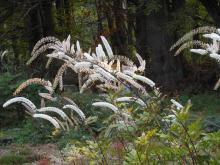
Gentiana triflora -they seed around; I hope; more- from a colleague in Sweden (1999) and 'Clara Curtis' daisy.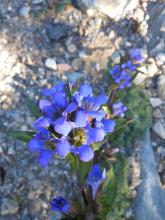
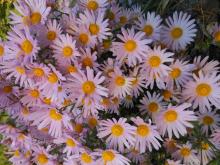
Energy to spare in Dryas grandiflora and Sedum cauticolum in splendid isolation: It makes a nice ground cover too!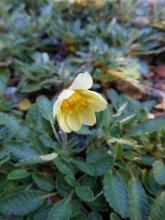 [
[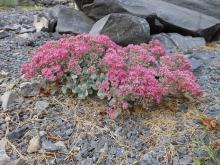
An "olde stand-by" Chrysanthemum in The Plunk. This is a blatant admission of impending fall color, pushing it a bit maybe, it still feels like summer.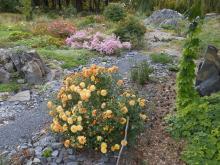
The season of garden interest is so not over yet!
Re: What do you see on your garden walks? 2012
The Cimicifuga against the backdrop of the trees is really lovely!
Here, in spite of warm days, it very much feels like fall-- the shade is getting deeper and more extensive, and barely warming up anymore, as the sun gets lower and the trees shade more and more of the yard...
This view is not a garden, but rather a more or less natural area (nothing planted) a little way behind the house...
Re: What do you see on your garden walks? 2012
Michael: Think I might also have "Clara Curtis" daisy. Looks almost identical - mine is a sprawler, which is OK with me where it is, and a long-lasting cut flower as well - perfectly hardy here. Nice. Fran
Frances Howey
London, Ontario, Canada
Zone 5b
Re: What do you see on your garden walks? 2012
Colchicums on Cactus Park. Tidyness plus a dry summer means no slugs and a spectacular display of these beautiful flowers.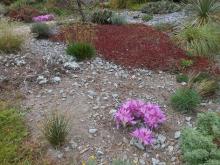
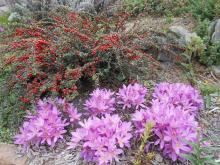
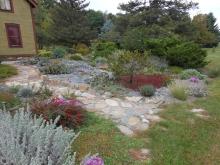
I was quite impressed enough by the strong splashes of yellow on a Wyoming (Laramie Mountains) roadside that I collected
this plant. I believe I have grown two others in this genus as well, but I don't know what they are. This is the only one that appears strongly stoloniferous. The other two are more tufted and grow to 30 cm or more "out of character". One from a New Mexico roadside (South of Magdalena Mountains but widespread) with a thready divided smooth skinned green leaf and scads of small yellow composite (Packera-like) flowers; the other from the mountains east of Cuba, New Mexico has a very silvery and fernlike leaf. These would appear of "short lived" habit unlike that pictured.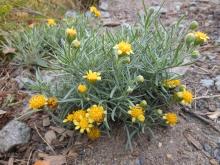
Re: What do you see on your garden walks? 2012
Michael: I am really mystified by your composites from WY and NM: don't recall seeing anything quite like them. I hope you can get a pinch of seed (have lots to trade with): your garden really looks smashing. Our colchicums are at peak form right now too. Cooler nights, but days still pleasantly toasty. The Botanic gardens (where most of these pictures were taken) is really awesome: had to share!
The plants are labeled under the pix: just a few that struck me yesterday on a stroll around work. The grass in the rock garden (Muhlenbergia reverchonii) is the star of the lot!
Re: What do you see on your garden walks? 2012
Those really are awesome, Panayoti. I can't even see any leaves on the eriogonum, just flowers!
The Calamagrostis brachytricha (Korean Feather Reed grass) is remarkably adaptable, growing shorter in your pic, a little taller in my garden, and 6ft. at a friend's house. All depending on the environment it lives in, much the same as Big Bluestem (Andropogon gerardii) that grows from 3 to 8ft.
Re: What do you see on your garden walks? 2012
Michael- I'm especially captivated by that little composite- with its almost marigold like flowers as opposed to daisies! What about Chaenactis species?
Another thought: Raillardella argentea
http://www.alplains.com/images/RailArgent.jpg Some interesting Pyrrocoma possibilities too- uniflora v gossypina has similar flrs, but not leaves; So many nice Compositae :)
Panayoti- great garden views as always, jealous of the huge rocks, and love the Scutellaria colour combination in particular :) The Zauschneria sp is interesting- any idea of hardiness? The name is promising...lol
Re: What do you see on your garden walks? 2012
Panayoti; I thought you might know that one straight away! Cohan; thanks for the link. They really are quite showy but maybe considered a bit "dumpy" (a speculation). These seem like the kind of thing agriculturalists might frown upon as weeds; and they are just DYCs after all. However, when a plant asks to be grown; I find it hard to resist some times! As is the case with so many nice small plants from the west; I don't think viable seed is set here. Panayoti; Eriogonum seems a viable genus here; not always easy to grow; and tending to winter burn, but they are resistant to pests. If Eriogonum wrightii sets good seed in your gardens; please send me a pack. It looks like a gem.
Re: What do you see on your garden walks? 2012
I don't mean to forget the white ones!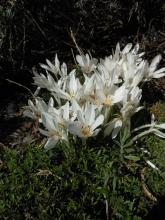
Orostachys iwarenge is one tough customer! I also have it in a small cast iron frying pan, with a drainage hole poked in the bottom, for over a decade now. It is never fed or watered!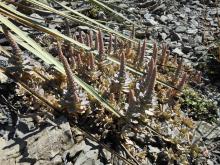
both of these are from seed of a single plant of Escobaria sneedi var. 'leei'. It must have crossed with another Escobaria species. The second photo is a light colored form of Gentiana angustifolia. I used to get terribly envious when I saw pictures of Czech gardens where these grew in huge clumps along side the blue ones. Now after some tense moments (and a few patient years) it looks as though I might finally be growing it well! The plant normally flowers in spring.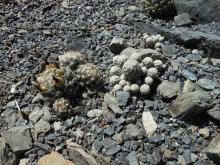
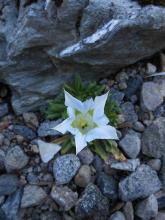
Re: What do you see on your garden walks? 2012
Michael- I'm growing more and more fond of various composites, regardless of the priorities of some agriculturalists which I do not always agree with. eg--the native Delphinium glaucum is considered a weed here by some, due to toxicity to some livestock, a stance I reject completely, as with Antennaria and others that can be 'invasive' [again a word I reject for native plants] when pastures are overgrazed- clearly the problem is overgrazing, not Antennaria. Meanwhile, terrible invasives such as clovers and grasses used as forage are not considered a problem- even though they displace native plants.... For me, to be classed a weed, it must be an exotic, even if natives can grow in beds where not wanted and need removing..
That is some serious variation on those Escobaria!
Re: What do you see on your garden walks? 2012
Panayoti, the Eriogonum wrightii is beyond sensational! Is there a variety of it called "subscaposum"? I had this one for quite a few years, forgot to admire and
praise it one year and it left for the garden.
Re: What do you see on your garden walks? 2012
I've just seen a Scutellaria very like Panayoti's on Mojmir Pavelka's Euroseeds site, except I think it was a form of the very variable orientalis. Wish I could step over to Denver every couple of days, there seems to be so much to see. Instead I shall add this plant to the Vernonia lindheimeri leucophyllus and a great picture I found of Pulsatilla pratensis nigricans taken by Todd and keep a close eye out for seed.
These two pictures are a bit of a cheat as they were taken this time last year at Edrom nursery on the Scottish borders. Autumn gentians are a dream in the south (at least grown like this) but they are glorious. Here they are almost like a lawn!
Re: What do you see on your garden walks? 2012
Wow- those Gentians certainly do seem to be right at home there!
Re: What do you see on your garden walks? 2012
What a sight for sore eyes those gentians are, Tim! I well remember my last visit to Aberconwy (I was headed towards Bodnant and noticed their sign--little suspecting what I was in for!). I am amazed that these grow well for us too--in special soil, of course, and divided regularly.
I think Scutellaria pectinata is often lumped under the other taxon as a subspecies: it is very distinct to my eyes (and only blooms in late summer). I have grown it for a long time at home, but Mike Kintgen has finally really got it going several places in the Rock Alpine Garden, so I suspect it is here to stay.
I notice I missed a few items at DBG, and haven't shown anything from my home either--there's still lots to see!
1) We finally found a spot where Begonia evansiana is really happy and it's in full bloom still (this is the white form--we must move our old but less vigorous pink ones nearby)...
2) The flower on "Devil's Shoestring'--which has been blooming for months--Nolina lindheimeri from the Texas Hill country--amazes me how hardy plants are from down there.
3) Geranium harveyi is usually much larger than this by now, and loaded with flowers--but this year my big plant died and a number of seedlings are showing up around the garden. I keep hoping we are selecting for hardier and hardier forms--one of my favorite silver plants.
4) This is a hybrid Hylotelephium bred at Bluebird Nursery by Harlan Hamernik: he gave us a flat with dozens of seedlings--which I planted at my girlfriend's house. This one has grown without supplemental water during a dry year!
5) Another Jovibarba heuffellii--can one have enough? These have been blooming for months.
6) My garish show of Chrysothamnus nauseosus (dwarf form) with Salvia greggii 'Furman's Red' on my xeriscape at home--I grow nearly a dozen Salvias in the greggii/microphylla group on this slope in every shade of red, pink, rose, purple and even yellow. They are superb garden plants in dry gardens here.
7) A Woodland salvia from the Himalayas that alwasy blooms late: Salvia nubicola.
8) Zauschneria arizonica at Sandy Snyder's garden--a monster in the genus that can get 4' tall and even wider in a few years.
9} Zauschneria californica in a wonderful tall, willowy form at Mike Kintgen's magical private garden...
Re: What do you see on your garden walks? 2012
Been so busy, and traveling for work, that its hard to keep up, but wanted to chime in here after seeing so many beautiful plants and garden scenes.
Rick: I really like the Sedum obtusifolium you show us, one I'm not familiar with. Too bad about the Agastache aurantiaca not returning, even after NOT cutting it back for the winter, I too share similar experience. This year I have just 2 flowering plants of hybrid A. aurantiaca x rupestris.
Michael, love the photo of Cimicifuga, mine look much the same, not only are the giant floral plumes spectacular, the cotton-candy scented flowers perfume the entire garden. Naming on these things is a mess, and is one that I completely disagree with; I go by Flora of North America that keep "Cimicifuga" intact, plants that have dry follicles in seed, as opposed to lumping them into Actaea :rolleyes:, a genus whose seeds are borne in berries. In general, C. ramosa is considered a synonym of simplex, but then again, The Plant List lists 15 synonyms for "Actaea simplex"! I will stick with calling it Cimicifuga simplex. Michael, do you get wasps on your Cimicifuga plumes? Here, not only do they attract bumble bees in profusion, but also wasps of many sorts. Here's my take on Actaea/Cimicifuga:
http://nargs.org/smf/index.php?topic=1049.msg17758#msg17758
Michael, Sedum cauticolum is an awesome species, great in foliage, growth, and late flowering. Your photo demonstrates well that is isn't just another sedum!
PK, love the Ajania, these are but lovely Tanacetums from another land ;-)
Muhlenbergia reverchonii is awesome, as is Scutellaria pectinata, holy moly! I've grown Eriogonum wrightii v. wrightii years ago, easy to grow, mine flowered but didn't even begin to approach 1/20the the size of your luxurious plants, I'm totally jealous. Your inclusion of Hosta tarda demonstrates just how useful and attractive some of the late flowering (and compact) Hosta can be in the rock garden, hazzah. The image you post of Geranium harveyi re-instills plant lust for this S. African species. I tried growing it a couple times, each time lasting only a couple years; if only it would persist and produce that gorgeous foliage, who cares what the flowers are like. I have also failed magnificently a couple times with the other hardy S. African Geranium; G. magnificum. I'm interested in the late season Salvia; currently growing the light yellow-flowered and sticky-glandular S. koyumae, so I've taken note of Salvia nubicola that you show; always good to learn of another late season bloomer.
Re: What do you see on your garden walks? 2012
Some plants are still in flower - or they have a second blooming
Lonicera henryi - a large evergreen climber but the flowers are not the showiest! Primula capitata(?) is still in flower. Some rhodos rebloom in the fall. The Agapanthus is still flowering forthe third month! I have not dared to plant it out in the garden although I know some forms are quite hardy. Unfertilized seeds show a very red colour to attract birds. (Do anybody want seed - it is a white-flowered species - last picture.)
Re: What do you see on your garden walks? 2012
I have an Ajania still, from the one and only time I visited Geoff Charlesworth's Sandesfield garden. It has been persistent but never encouraging much attention other than "wow; it's still here!". Mark, You are right about the Sedum cauticolum. I imagine it could be used in large drifts in order to color up entire hillsides at this time of year given the proper care. The Cimicifuga is indeed a good bug plant. It is a very busy plant. I notice wasps, hornets, bumbles and honeybees. It seems favored by things that sting! I'm not surprised these critters like it as it does smell delicious. Just a few spare plumes now. Everything is gradually setting up for the cold weather. I like busy plants!
Re: What do you see on your garden walks? 2012
As for taxonomy: Just really cool stuff. indeed I've taken to calling Zauschnerias Epilobiums (only on occasion) and Senecios Packeras. I also know there's been alot of other changes quite recently. Agree or disagree OUR species has come along. It probably sees things it didn't just a few years ago. We even have gene sequencing now! That's like the "new taxonomy"; a nice tool like a stone ax was way back then. It is OK to politely bury the past. It's been going on for quite some time now.....
Re: What do you see on your garden walks? 2012
I can't imagine hundreds of plumes of Cimicifuga in our dry climate - must be a stunning sight. The idea of spreading seed into wilder parts of the garden is very appealing and fascinating to see what might develop.
Michael's picture of Sedum cauticola reminded me of visiting Cally Gardens in the South-west of Scotland last September - this species did really stand out, (shows how much natural species are often neglected at the expense of newly bred varieties).
Taxonomy seems like learning several different languages at once; OK if you can manage to talk to the people you want to, about what you want to talk about! I've always found the relationships between plants fascinating but really complex to get to grips with, and continuous changing of names doesn't necessarily help!
Re: What do you see on your garden walks? 2012
Trond- lots of great colour there :) are you having nice weather? looks a bit sunny..
Tim-that Sedum is splendid! I'm more interested in natural species in general- there's so much great variety in nature I just don't feel a need for hybrids; Cultivars selected from natural seedlings are a different issue, though my idea for many plants would be a variable seed grown batch from wild seed; I'm no purist though, I do have various garden hybrids etc, just because of availability!
Re: taxonomy, I agree, Michael, I have no problem using 'new' names, if and when I remember them; my only complaint is that as a lay person, it's not always easy or possible to even know what criteria the changes are based on, in order to have any useful opinion on the subject- and I do not assume that just because someone wrote a paper or a book that theirs is the right or only view...
Re: What do you see on your garden walks? 2012
Trond- lots of great colour there :) are you having nice weather? looks a bit sunny..
Sunny - yes, for 3 1/2 day! The weather was marvellous last weekend + Monday. Now we are back to the autumn normal - rain - a glimpse of blue sky - more rain, maybe thunder; windy - calm etc :-\
Re: What do you see on your garden walks? 2012
Shortia galacifolia -- currently 4 blooms this year .
Please excuse the cracked pot --i really need to get this plant into the garden proper somewhere.
Cheers Dave.
Re: What do you see on your garden walks? 2012
Exquisite little plant! Even with our dry Kent climate I am toying with the idea of making a high humus bed for plants like this and small Ericaceae. But we would probably need a misting mechanism through hot spells in the summer. They are just such delightfully 'different' plants.
Re: What do you see on your garden walks? 2012
Shortia galacifolia -- currently 4 blooms this year .
Please excuse the cracked pot --i really need to get this plant into the garden proper somewhere.Cheers Dave.
It is a cute little thing! From seed?
I had several seedlings some years ago but they died in a very dry spell the first summer I planted them outside :(
Re: What do you see on your garden walks? 2012
Shortia galacifolia -- currently 4 blooms this year .
Please excuse the cracked pot --i really need to get this plant into the garden proper somewhere.Cheers Dave.
Cute thing! How large is the pot? This is a genus I only know from the forums...
Re: What do you see on your garden walks? 2012
Cohan and Hoy
The Shortia would currently fit into the palm of your hand but has in the past filled the pot --i keep on trying ,not all that sucessfully to grow on the severed runners ---It's a plant i've had for many many years ,purchased- i think.
Tim
Maybe this might have a liking for your conditions .
Anchusa cespitosa --pic taken yesterday.
Cheers Dave.
Re: What do you see on your garden walks? 2012
Love the Anchusa- really unusual form!
Re: What do you see on your garden walks? 2012
Nothing near so interesting here!
Seeds of Paeonia officinalis; Euonymus nanus 'Turkestanica'; rose hips; bur oak; Silene schafta; Hylotelephium 'Diamond Edge':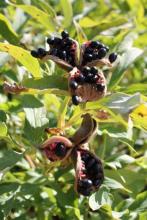
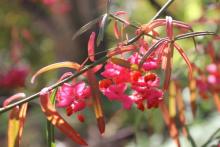
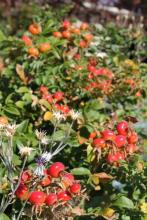
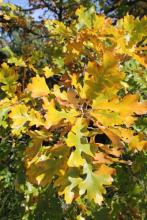
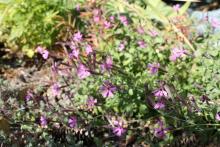
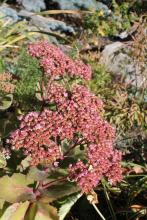
Re: What do you see on your garden walks? 2012
Shortia: I have tried this in the garden:Not the easiests thing to grow.. even among the Diapensias: I think. This is a decent case for open science; I think.... but never mind me.
Re: What do you see on your garden walks? 2012
Lots of colour still, Lori! We also have the Euonymous, at its finest of the year in seed! which I've mentioned is sprawling around in an apple tree, now as tall as I let the apples get, which is as high as I can reach with semi-long pruners..
I'm jealous of the oak- any oak! and the Silene looks very nice, not least for the late flowering...
Re: What do you see on your garden walks? 2012
Today is the first day since last weekend it doesn't rain!
Went out to picture some plants not damaged by the heavy showers.
Almost all my Clematis are still in flower. Here are two different kinds: 'Ernest Markham' or a similar hybrid climbing in a Actinidia arguta which threatens to become too big and a heracleifolia type among other weedy plants ;D The heracleifolia hybrids are semishrubs and late flowering.
Corydalis/Pseudofumaria lutea has selfsowed and the 3 months old seedlings flower continuously!
Also the Cyclamen hederacea has just started flowering.
I have two kinds of annual Impatiens. One gets more than 2m/7ft high and the other barely reaches 1m/3ft. They selfseed a lot but the seedlings are easy to remove and I always let a few plants grow to flower and seed.
Lilium rosthornii is very late and the flower colour is very pale this year.
A Malva or something similar is still producing flowers despite the rain.
Re: What do you see on your garden walks? 2012
I planted a few seedlings of one of those annual weedy Impatiens, from my cousin who had hundreds of them coming up, but I guess I chose the spots poorly and nothing came of them...lol
The leaves on that Cyclamen are excellent! Very nice Lily flower too..
Re: What do you see on your garden walks? 2012
Cohan, tell me if you want some seed - or acorns ;)
Re: What do you see on your garden walks? 2012
Hoy, what is the name of your purple blue Impatiens ? A very nice one I did'nt know !
Re: What do you see on your garden walks? 2012
Acorns? what kind do you have? I don't think many oaks are hardy here, but really I'd only want any that stay small- I don't want any more shade..lol
Re: What do you see on your garden walks? 2012
We had an especially fine sunset tonight with a rainbow and low warm light, and many of the plants seem to join in with rich colours and cyclamen flowering. The pictures don't really do it justice, the whole garden was bathed in a golden light!
Re: What do you see on your garden walks? 2012
Tim, your gardens never cease to tantalize...
Hoy, what is the name of your purple blue Impatiens ? A very nice one I did'nt know !
Yes, I thought that one was particularly nice, too. As a point of information, Impatiens species apparently do not cross easily. Just last Saturday, Nick Turland, from the Missouri Botanical Gardens and one of the speakers on the NARGS speaker tour, presented two talks at our Chapter meeting. (He is also co-director of the Flora of China Project.) He says impatiens are not promiscuous at all.
I also had dinner with Nick that evening. It was just him, one other Chapter member and me. What a treat to have so much one on one time with such a man! :o
Re: What do you see on your garden walks? 2012
Great views, Tim- the first border especially shows a rich tapestry of texture and colour :)
Rick, interesting about Impatiens..
Re: What do you see on your garden walks? 2012
Hoy, what is the name of your purple blue Impatiens ? A very nice one I did'nt know !
Nicole, sorry, I have no name. Got seed from Chris Chadwell some years ago. Do you want seed?
Acorns? what kind do you have? I don't think many oaks are hardy here, but really I'd only want any that stay small- I don't want any more shade..lol
Cohan, no oak stays small here! Maybe except those that freeze back or are damaged by strong winds and tough weathers!
Re: What do you see on your garden walks? 2012
Your autumnal colors, Tim and Hoy, are enchanting. We have a little bit of fall color starting--and I expect it will accelerate this week when temps drop near freezing at night: there is even the possibility of snow. Typical Colorado weather! Meanwhile, there are lots of plants still blooming and even the annuals are glorious...
1) Bulbine abyssinica has been blooming all summer--and still has fresh flowers on it! This is a high Drakensberg collection and totally hardy.
2) This dwarf Chrysothamnus nauseosus is growing in the meadow just west of my house: that's my girlfriend, Jan, in the distance. This is thriving despite the hottest year on record, and one of the driest of recent summers. Probably seeded from my garden.
3) Crocus cancellatus (slightly out of focus)--one of my favorite autumn species.
4) Eriogonum allenii was still attractive, but since seed was beginning to fall, I harvested it right after I took this picture (you can see the edge of the seed bag on the left.) That's a good 3-4 months of bloom!
5) A miniature form of Harpochloa falx from High Country Gardens. A hardy South African grass.
6) I( think I posted a picture of this Muhly last time--but this is a better picture of it in the Rock Alpine Garden. The most spectacular ornamental grass we grow (Muhlenbergia reverchonii)
7) and 8) two pictures taken at different times and angles of my patch of Muhlenbergia torreyi, the Great Plains fairy ring muhly that forms huge fairy rings in the wild on slopes.
9) I have finally got a good yellow form of S. x jamensis to grow for me in my dry garden: this blooms for months and combines well with other xeriscape perennials and succulents.
10) A closeup of the pink Schizostylis coccinea--I believe 'Mrs. Hegarty', which I love. Wish it didn't need it so moist!
Re: What do you see on your garden walks? 2012
Hoy, I would be very glad to receive some Impatiens seeds ! :D
Re: What do you see on your garden walks? 2012
Panayoti, is the Schizostylis coccinea hardy for you? I like the pink much better than the intense reds. The wandering curls of the three part stigma is quite interesting and attractive.
------------------------------
What do you get when you cross Melica ciliata with Bouteloua gracilis?
--- Harpochloa falx... (at least that's what it looks like to me. ;))
Re: What do you see on your garden walks? 2012
Cohan, no oak stays small here! Maybe except those that freeze back or are damaged by strong winds and tough weathers!
Well, freezing back is likely here ;) though my property is sheltered from the worst winds...
Re: What do you see on your garden walks? 2012
Picea omorika 'Treblitzch' and same, taken from the other side with the fall color of a dwarf Balloon flower (Platycodon grandiflorus) and past their prime (!) flowers of Lespedeza bicolor.
The Yeddo Euonymus (Euonymus hamiltonianus var. sieboldianus), rivals the best euonymuses for fall fruit, in my opinion. Very nice for inside the house, too.
Admittedly not the best pics here. The green leafed American Smoke tree (Cotinus obavatus) makes its fall color change over from the deep maroon to bright orange-red. The Ponderosa pine (Pinus ponderosa), at least in my yard, holds the old needles on the trunk form many years. Other brown needles in the pic are normal fall senesence, as the needles only last for 2-4 years.
Forsythia mandshurica 'Vermont Sun' (Mandchurian Forsythia) has almost round leaves, uncharacteristic of the genus. On the sunny side of the bush, yellow fall leaves get a red blush.
Re: What do you see on your garden walks? 2012
Good stuff, Rick- the Euonymus is showy! I need to take cuttings of mine (not the same, I'd have to look up the name again- E something turkestanica, I think, or similar), if that's feasible, and plant some in an open area where it can do more than scramble through an apple- charming as that is, it's not that visible.. What is going on at the base of yours?
Re: What do you see on your garden walks? 2012
Rick, the Euonymus is a winner! Strangely my ponderosa pine doesn't hold its needles, they all fall once they're brown.
Re: What do you see on your garden walks? 2012
Here are a few flowers in my garden today. The last two are on Western University's campus. Fran
Frances Howey
London, Ontario, Canada
Zone 5b
Re: What do you see on your garden walks? 2012
Rick - that Euonymus is astonishing! Does it always fruit as well as that? And I am intrigued by the Forsythia - they are planted so widely in gardens here that they tend to lose some appeal.
Re: What do you see on your garden walks? 2012
Our coldest night so far, Rocky Mtn House (30km west) was forecast for -8C, and Red Deer (60km east) was forecast at -5C, so not sure what we got, but there was very heavy frost! A couple shots, more later...
Achillea millefolium cultivar- I have several shades of pink now from pale to nearly/red, and really want some yellows/oranges- saw a really awesome mustard/pumpkin shade growing at the Saskatchewan Crossing this summer..
A willow, I think my mom said it was Blue Fox arctic willow, or something like that.. about a metre and half tall..
Prunus tomentosa.. these are nice looking shrubs all season, too.. not sure how tall they'd like to get, but the moose prune them every winter, they stay under 2 m...
Re: What do you see on your garden walks? 2012
Nice Anemone, Fran; Magnolia is a surprise to me !
Re: What do you see on your garden walks? 2012
Very odd those Prunus leaves, Cohan - sort of rugose?
No frost here yet and I hope it is still a month to the first freezing temperatures as a lot of plants still are trying to flower (too much rain).
Your plants look spring fresh, Fran!
Is the Magnolia late or early :o
Re: What do you see on your garden walks? 2012
Just a few late bloomers although I found a couple of Primula japonica today. in bloom by the strean garden.
The zauschneria has been blooming almost a month and is really lighting up the natural crevices on the back of the cliff. The Heterotheca jonesii
just has a few blooms now but has been flowering all summer long.
Re: What do you see on your garden walks? 2012
Regarding my Yeddo Euonymus (Euonymus hamiltonianus var. seiboldii),it's kinda funny. Yes, I think this is the best display ever, but not by that much. However, earlier in the year I wondered what it would be like because there seemed to be less flowers than normal, and the flies that are attracted to them didn't seem to be out in droves like yesteryears. (My neighbor nicknamed it the Fly Bush. :D) This is what it looked like a week before.
From that it would seem pretty obvious that some photographic trickery went on to get the previous high in the sky pic of the fruit against the blue sky. There's a story to that...
The giant shrub is near my lot line and the plant grows larger than I had ever anticipated. These past two years I have had to cut it back by almost half (each year) to keep it from encroaching on the neighbor's and also doing some pruning to balance it a little on my side. This drastic pruning seems to have spurred a lot of sucker growth that I am sure would continue into the neighbor's yard. So yesterday I cut it all down and treated the stumps with triclopyr. This is how I got that "high in the sky" photo:
There were about ten major stems coming from the base.
Trond, the provenance of the Pondersoa pine is the South Dakota Black Hills. It's a disjunct population from the species' main distribution in and around the Rocky Mountains of North America. Above eight feet it doesn't seem to be holding the dead needles on the trunk as well, and the branches have always dropped their dead needles. Center stage in this pic is Styrax americanus (American Snowbell), but you can see the Pinus pondersoa in the background. The yellow-turning brown to the right is an older Lespedeza bicolor, and underneath that is Thuja occidentalis 'Filiformis'.
Tim, that Forsythia mandshurica is the only forsythia I grow. Unlike the other types that are hardy here, it stays quite tidy. In fact, it has definitely seen better days for natural shapeliness. The shrub is actually twelve years old, and experiences significant shade from a River birch. I have only renewal pruned it once. The species has a little fewer, but larger flowers and blooms two weeks earlier than intermedia cultivars. Consequently, its bloom time overlaps with F. x intermedia, yet late frosts that will damage intermedias leave mandshurica unscathed. This pic was taken in mid March 2012, but spring came 3 weeks early this season.
Re: What do you see on your garden walks? 2012
Anne- hard to beat that Zauschneria!
Rick, that's some serious surgery!
Trond, the texture of the Prunus tomentosa is heightened by the frost, but they are textured leaves, and smaller than the other Prunus here as well..
Here are a couple more Prunus-- the first is a red/dark leaf cultivar of--? looks more or less like a chokecherry to me (maybe taller, I have to prune it constantly, it wants to be a good sized tree, it seems, but too close to the houses for me to want any more shade!) but my mom says it was some kind of plum; I must have pics somewhere of it in flower, but neither flowers nor fruit are showy as i recall- it's all about the leaves..
Second is one of our small fruiting plums.. neither of these produce much if anything fruit-wise- I think maybe their flowering time is not well enough in synch with each other and/or the other Prunus sp around if those can pollinate... maybe some other cultural or climate issues..
Re: What do you see on your garden walks? 2012
Swamp Azalea (R. viscosum); Rosularia pallida rings in the greening of the buns; Vaccinium corymbosum backs up a Gaylussacia from Deer Leap in Vermont.
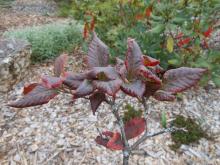
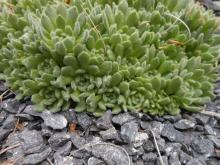
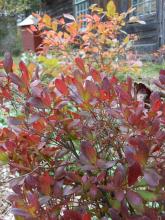
Autumn light through trees on my back line. It's been raining a lot lately but today was one of those perfectly humid, still, warm Autumn days when everything was just right for this gardener.
A walk down the rocky garden path.
Another good-doer Chrysanthemum; a late bloomer and Gentians responding to dampness after a dry summer. I hope this doesn't mean I won't see them in spring!
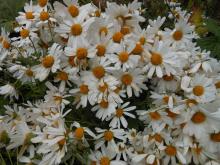
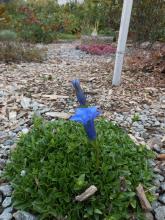
Mazatxotol! (Mazatlatl) That's what I presently dub the viscous, sweet, fizzy bright pink plok that these cactus pears are liable to soon become: Liquid laughter!
Re: What do you see on your garden walks? 2012
Nice fall views, Michael- great colour on Gaylussacia, and love the rocky path view! I appreciate the light through the trees, on this property it'll soon be almost all I have for winter!
Re: What do you see on your garden walks? 2012
Still from thursday's heavy frost, Geum coccineum I like our native Geums for their vigorous looking leaves both late and early in the year, and this seedling from this spring seems to have that trait too :) hope to see flowers of this and seedling montanum next year?? Though they were planted out rather late, so maybe not, montanum are tiny, too...
Next, Diervilla lonicera, planted out last year and coming along nicely.. wondering if this will get too large for the nearby rock garden? I do have to move Achillea siberica v camschatica near this, as it's flopping over onto the rock garden...lol...
Re: What do you see on your garden walks? 2012
Cohan, the geum you show: what are the dimensions? It certainly is cute.
In Minnesota, Diervilla lonicera is rhizomatous, spreading underground, and grows up to 3ft. I'm not sure it would be a good thing to have near a rock garden.
Re: What do you see on your garden walks? 2012
Good tips on the Diervilla, Rick, I'll keep an eye on it- there is a bit of space between it and the rock garden, though not a lot...
The Geum coccineum is a seedling from this spring and is maybe 4 inches diameter at most.. according to this site, should be around 15 x 12inches at maturity, I'm assuming the 15" is flowering stems.. I didn't plant them in the rock gardens, but rather in a new sort of 'sub-alpine' meadow berm! with a couple of Hieraciums, Pulsatillas etc..
http://www.wildgingerfarm.com/Geum.htm
Re: What do you see on your garden walks? 2012
Rick, so when your Ponderosa pine does keep it's needles it shows a juvenile trait? Makes sense.
Cohan, interesting with all the different Prunuses. We have only two native ones here, P. padus and avium; the latter makes a huge tree.
Re: What do you see on your garden walks? 2012
Trond, we also only have a couple natives- pennsylvanica and virginiana, but I guess quite a few are grown in gardens since many are very hardy.. We also have sand cherry growing (forgetting species right now) and they are very different again- small and floppy, with very different leaves..
Re: What do you see on your garden walks? 2012
Rick, so when your Ponderosa pine does keep it's needles it shows a juvenile trait? Makes sense.
I see what you are thinking, Trond, but it's hard to believe a tree that I planted as a one foot, few year old seedling with no visible juvenile traits would suddenly change its mind. In the first four feet of growth, it did not do this. And, if it was a juvenile trait, wouldn't we expect it to be even more pronounced in the branches, rather than the main stem? I have never seen juvenile foliage of Pinus ponderosa, but I would think it would be along the lines of Pinus pinaster, which are sold here in the complete juvenile stage as decorative little inside pine trees for Christmas time.
Re: What do you see on your garden walks? 2012
In Minnesota, Diervilla lonicera is rhizomatous, spreading underground, and grows up to 3ft. I'm not sure it would be a good thing to have near a rock garden.
Agreed... It gets to about that height here too. Kind of interesting in fall when it turns bronzey, but the spreading habit is getting to be a bit much where ours is. It dies back variably through the winters here... sometimes not at all. It can be cut to the ground in spring with no ill effects, if there is a lot of die-back. ,
Re: What do you see on your garden walks? 2012
Rick, I didn't mean the monophyllic juvenile foliage as seen on those Xmas trees (we have them here too ;D) but as you say, any such trait if juvenile should expectedly affect the branches too.
BTW I have seen the native pine (P sylvestris) with monophyllic juvenile foliage up to a foot high - but you have to grow it under glass with perfectly controlled environment. The juvenile leaves are the same structure as you find as small scales at the base of the double (or more) needles of mature growth. This pair actually sits on a small twig. Each and every pair of needles also have meristematic cells between them when young and can produce a fullgrown branch if necessary like when a shoot is eaten by elks in spring ;D
Re: What do you see on your garden walks? 2012
Your "By the way" is very interesting, Trond. I suppose then, that this is also what happens when pine candles are shortened in the spring to reduce annual growth, and new buds appear the same season. I had never investigated exactly where the new bud begins life, and just assumed it was from either latent buds or the cambium.
Re: What do you see on your garden walks? 2012
Yes, Rick. All buds are formed in leaf axils by meristematic cells originating from the apical meristem. The (vascular) cambium is a lateral meristem producing secondary growth of vascular bundles etc.
The scales of the young pine candles are modified leaves and as such have meristematic cells at their "foot". These cells produce the bundle of needles on a short twig - and this twig has when young meristematic cells able to produce a new (latent) bud. It is easy to see if you take a closer look ;)
Re: What do you see on your garden walks? 2012
Thanks, Trond. Always interesting to hear the back-story on things.
--------------------------------------
Late flowering materials always tend to surprise me. I look at the buds and I think there will never be enough time to bloom, but then, there they are. Such a plant, this Aconitum sp. Usually a darker purple shade, It is much lighter this season, I think due to our late drought. But I like the green tones this year.
And I keep saying how beautiful bulbs can be...
Lilium 'Super Tsing', Lilium Gluhwein®, Lilium 'Zeus'
Anemone hupehensis 'Pretty Lady Emily' probably won't survive here, but I have to try. Emily was my Mom's name, and in her elder years she was often described with the words: pretty lady.
Dianthus callizonus puts out its last flower for the season.
Re: What do you see on your garden walks? 2012
Another one from Rowe Mesa in New Mexico; a vigorous woody stemmed daisy about 30 cm. tall. Looks very Heterotheca like.
It does not set viable seed but I was able to break off a chunk of the caudex to perpetuate it.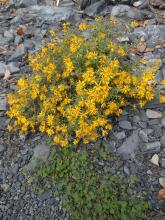
Allium thunbergii is among the last to bloom before cold weather. Crocus speciosus is another. These are on the flat but
they really do better in a warm raised bed here.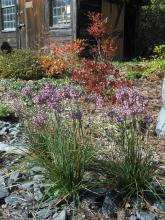
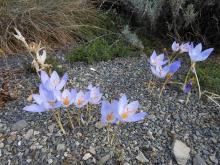
Escobaria vivipara fruit will turn a darker red soon.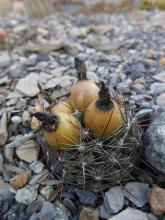
Areneria alfacariense is a slow growing gem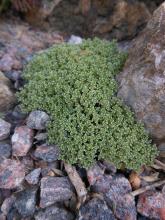
These three were taken locally: a scant taste of Aster variety in our region: A Pellaea sp.! on Split Rock preserve. I
can't recall ever having seen this genus here despite years of rambling about. Really quite exciting indeed what an any-
old-day hike can bring to light: Adirondacks from Clark Road; first frost last night here; just a touch of snow on the high peaks.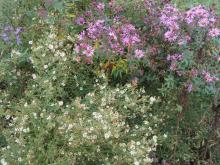
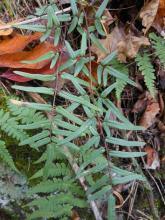
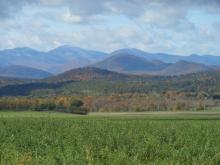
Re: What do you see on your garden walks? 2012
Nice Anemone and Aconitum, Rick! The bulbs are interesting- nature is full of beauty, even where no one can see it!
Michael- nice views- you guys still have a lot more than me- just a few flowers here as we are much nearer to all out winter, even though the snow of the other day melted and next few should be warm.. Congrats on finding the Pellaea! I found some ferns this year on the farm that I've never seen before, so I was excited too!
Re: What do you see on your garden walks? 2012
Michael, I'm wondering if your heterotheca-like plant could be Heterotheca villosa? I couldn't tell from the picture if the stems and leaves were hairy. H. villosa is about 12" tall and multi stemmed and almost bushy looking. I grew it once from seed and I recall it being extremely floriferous. A nice plant but H. jonesii works much better for me, perfect size for the crevice gardens.
Re: What do you see on your garden walks? 2012
Interesting to get an appreciation of the underground beauty, too, Rick. From my records, it doesn't look like I've tried Anemone hupehensis here (probably because Anemone tomentosa 'Robustissima' was already covering enough ground) - I take it it's not considered as hardy?
Your garden is still looking fantastic, Michael! I'm astounded at how much longer the season is down there too.
Yes, I agree with Anne - the yellow plant covered in flowers does look like it could be Heterotheca villosa, from what can be made out. It does occur in New Mexico, according to USDA Plants (one can do a State Search - although USDA Plants is too general to say if it occurs in the exact area), although there are also a number of others in the genus that also occur there.
Here's a closer picture of a much less photogenic one growing along our sidewalk by the alley (out in the worst driest clay, where it's prone to being stepped on... and even driven over. This spring, I noted that it's woody branches had been broken off at the ground, from being driven over or from shovelling snow perhaps... but it wasn't fazed - it actually branched out much more vigorously and fully from the severed stems. A very tough plant! I grew a few of these from a bit of seed collected from along the highway in west-central Saskatchewan.):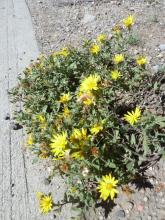
If you could post some closer photos, Michael, perhaps it could be ID'd with certainty?
**Another edit: Here is a site that shows some excellent photos of Heterotheca(Chrysopsis) villosa:
http://em.ca/garden/native/nat_Chrysopsis%20villosa.html
Re: What do you see on your garden walks? 2012
A wedge of warm air from the south in advance of a cold front had bees, flies, wasps, and butterflies all getting a last
taste of summer at the onion; busy plant! Sedum sieboldii is another last bloomer some years struggling on into the snow
but it looks like easy going this year.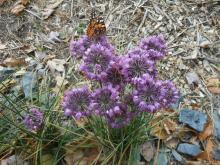
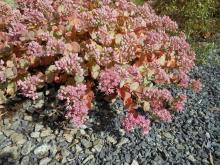
Re: What do you see on your garden walks? 2012
I wish my Allium thunbergii 'Ozawas' would bloom like that. It will be another two or three weeks before it begins. But Allium thunbergii f. album, given to me by a fine forumist here, is blooming nicely.
Chosen for its drought tolerance and outstanding fall color, Cotinus obovatus has been in fall color since the third week of September. This pic taken yesterday :o.
Aster ericoides 'Snow Flurries' is actually past its prime, but sitll lasts and lasts. Second pic with some friends: Lilium 'Black Beauty', Hylotelephium 'Herbstfreude' (Autumn Joy), and the silver seed spires of Echium russicum.
Re: What do you see on your garden walks? 2012
Obviously still a lot of interesting plants on the northern half of the globe!
Re: What do you see on your garden walks? 2012
Really like the Cotinus. This species is not much grown here, but looks even better than coggygria for autumn colour.
This Actaea (pachypoda 'Misty Blue') has been a striking plant through the year for its silvery-green leaves. The combination of fruits and red stalks is very eyecathing even on a young plant like this - I wonder if the seed will breed true?
Re: What do you see on your garden walks? 2012
Love those cyclamen at the base, too, Tim. The leaves are so vivid!
Cotinus coggygria has poor fall color here. Some cultivars have none. Cotinus obovatus is susceptible to verticillium wilt, and a couple years ago in a wet summer my tree had a bout with it, but recovered well. I had removed about a fourth of the tree. Verticillium wilt is very prevalent in my area. I don't even try to grow Asian maples anymore. The American Smoke tree grows in a very dry part of the yard, so I wonder if the fungus just isn't normally there.
Re: What do you see on your garden walks? 2012
Nice scenes, Michael, Rick and Tim! Your "bear sighting" reminds me that woolly bear caterpillars used to be common when (and where) I was a kid... we see them very rarely here now. Love the Cotinus, Rick, and the Aster ericoides looks like a really good form (I've got a wild one in the front yard that is quite a dud in terms of flowering - should get rid of it, really).
Well, there's nothing so picturesque here anymore, but I guess I'll show these anyway.... even this will be gone soon!
Cotoneaster colour; Aster sedifolius; peony foliage; Hylotelephium 'Autumn Joy'; first flowering of Asyneuma canescens; and 'Waterlily' colchicums: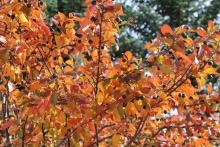
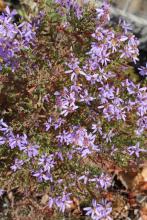
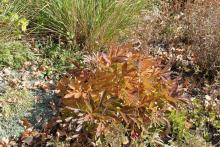
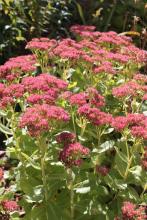
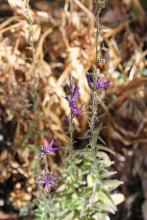
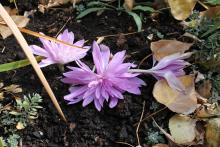
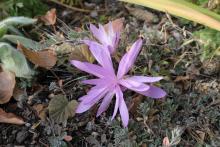
Re: What do you see on your garden walks? 2012
The snow didn't last long Lori? Still some colours in your garden! My 'Waterlily' colchiums are totally flattened due to heavy rain :-\
Re: What do you see on your garden walks? 2012
I wish my Allium thunbergii 'Ozawas' would bloom like that. It will be another two or three weeks before it begins.
Wow, I can't believe how long the season is in your area!
The snow didn't last long Lori?
We've had two brief bouts of snow now, with it melting the next day, but starting today and all next week, the daytime highs are forecast to be zero at best, with snow, so this may be the end of our extended fall. It's snowing now.
Re: What do you see on your garden walks? 2012
Yesterday was 17 or 18C, today's high is -1, still -2 at noon, probably 8-10cm of snow on the ground, and all week forecast to be below freezing as Lori mentioned- probably a bit colder here than in Calagary..
1-crab apple
2- Salix (non-native-large pussywillow)
3-wild trees in the yard- mainly Betula in front
4-Philadelphus, Malus etc between the houses
5-Tilia cordata
6-wild trees in the yard- Lonicera involucrata and Amelanchier alnifolia
7-native Picea glauca (and one planted blue spruce!)
8- the blue spruce with Sorbus (always forget which sp is which- its the one with fuzzy buds)
Re: What do you see on your garden walks? 2012
I thought it would be fun to see a couple of the same trees/shrubs shown above on Saturday covered in snow, in shots taken on Friday on a sunny warm fall day..
1- Tilia cordata
2- Lonicera involucrata ( I know this has has a change of genus, I just never remember it!) with Amelanchier alnifolia; this is a little wild grove maybe 10 m from the house
3- Sorbus with blue spruce
Re: What do you see on your garden walks? 2012
Cohan, that kind of weather change is rare here where I live at the coast - now we have had 8-12C for weeks, mostly rain but a few days with some sun. However, in the mountains and inland it is not uncommon although +18 would be something to write about!
Snow-covered trees have their charm too ;)
Re: What do you see on your garden walks? 2012
While walking around the gardens at Rocky Dale Gardens where I work I took a few shots of 'Deer Leap' the cliffs overlooking the gardens, when it started to sprinkle. The sun then peeped out and presented me with the most gorgeous rainbow!
Re: What do you see on your garden walks? 2012
Looks like a beautiful setting, Amy, even without the neat double rainbow!
Re: What do you see on your garden walks? 2012
Looks like a beautiful place to work, Amy, both with and without rainbows!
Re: What do you see on your garden walks? 2012
Beautiful weather here today for the first time in weeks. However I was busy tidying up in the garden while my wife went for a little sunday stroll.
I had time to take a stroll in the garden though!
The unknown annual Impatiens is still in full flower and so is Lilium poilanei, still a small plant though. The orchid Vanda is flowering now for the second time (inside now!) after spending the summer months in the garden.
Some shrubs like Enkianthus campanulatus and Euonymus elata are draped in full autumn splendour!
Re: What do you see on your garden walks? 2012
Wow Trond! :o That is quite spectacular! I was checking out all my Cyclamen today too and while most are sending out lots of nice leaves there aren't many flowers. :(
Re: What do you see on your garden walks? 2012
I especially like the enkianthus picture. This is an underpraised shrub with good flowers and excellent fall color.
Re: What do you see on your garden walks? 2012
Beautiful place, Amy!
Trond- esp like the Cyclamen in the red leaves :) Looks very mild there stiil, but then it always is by my standards ;D
I do like the trees draped in white- snow or frost, it is one of my very favourite tree looks of the year!
Re: What do you see on your garden walks? 2012
It's extremely rare for us to see both ends of a rainbow "touch the ground". I think I have experienced it only once. Amy, I remember saying to myself the last time you showed Rocky Dale Gardens: "what a great place to work!"
Trond, I don't think I would have even tried taking a photo like that one with the cyclamen. The shadows, I thought, would make it too busy and the subject, lost. You found just the right time of day for it to work out perfectly! Or, is that your shadow...? The leaves are incredible, of the cyclamen, and the maple, etc. What kind of maple?
Is the Lilium poilanei potted or in the ground?
---------------------------------------
After a month of color, Cotinus obavatus is dropping leaves, while Viburnum x 'Juddii' and V. carlesii begins their fall color in the same way the Cotinus did.
Trond, you've inspired me to try some sun pictures of Euonymus, and their not so bad...
Euonymus bungeana 'Pink Lady'
And I had lots of fruiting branches when I cut down the E. hamiltonianus var. sieboldianus on 12 October, so I made a bouquet for the front door. This is what it looks like now, being exposed to the sun and elements for eleven days (21 October) - on the right. The left vase is the bouquet shown earlier, same age, but kept in the garage in mostly dark, and no direct sun.
Re: What do you see on your garden walks? 2012
Great colour on the Cotinus! Viburnums are grown a lot here, some really blazing fall colours.. I only have the native V edule still, tried a few others from seed a few years ago, but got nothing :(
Euonymus looks great too, I should look for some more of these. I always prefer sun shots when possible, but I love high contrast.. my new camera has a setting that is supposed to even out extreme highs and lows- seems good in principle, but wasn't working for my taste, so I turned it off..
Re: What do you see on your garden walks? 2012
Wow Trond! :o That is quite spectacular! I was checking out all my Cyclamen today too and while most are sending out lots of nice leaves there aren't many flowers. :(
Thanks Amy ;D The white cyclamens were late to emerge but have flowered for a long time now and show no signs of giving up either! They are all from seed.
I especially like the enkianthus picture. This is an underpraised shrub with good flowers and excellent fall color.
Thanks Anne, I have 3 or 4 enkianthuses. They are always good doers in fall and have nice flowers in spring!
Trond- esp like the Cyclamen in the red leaves :) Looks very mild there still, but then it always is by my standards ;D
I do like the trees draped in white- snow or frost, it is one of my very favourite tree looks of the year!
Thanks Cohan! Yes it still is quite mild but not unseasonally so. However the weather forecast says colder weather next weekend but no frost yet!
Trond, I don't think I would have even tried taking a photo like that one with the cyclamen. The shadows, I thought, would make it too busy and the subject, lost. You found just the right time of day for it to work out perfectly! Or, is that your shadow...? The leaves are incredible, of the cyclamen, and the maple, etc. What kind of maple?
Is the Lilium poilanei potted or in the ground?
---------------------------------------
After a month of color, Cotinus obavatus is dropping leaves, while Viburnum x 'Juddii' and V. carlesii begins their fall color in the same way the Cotinus did.
Trond, you've inspired me to try some sun pictures of Euonymus, and their not so bad...
Rick, it is not mine, the shadows are of shrubs and trees nearby. The sun is to my right side. The maple is a Japanese one but I don't remember the name.
The lily is in the ground. I will let it stay there too if the weather doesn't turn too bad!
Your pictures aren't bad either, Rick!
Enkianthus spring flower show:
Re: What do you see on your garden walks? 2012
Hoy, I would be very glad to receive some Impatiens seeds ! :D
In the mail today!
Re: What do you see on your garden walks? 2012
What a bright rainbow Mike! Good on you for catching it so well!
Re: What do you see on your garden walks? 2012
It is a double one too!
Re: What do you see on your garden walks? 2012
Some great fall colours! Sorry I have not been around much...I am spending too much time on the rock garden group on facebook...I don't need to resize my images there so it is so much easier to post.
A few plants blooming/fruiting at work...Allium virgunculae, Gaultheria miquelliana and in our alpine house, Oxalis commutata and Cyclamen graecum (these latter two are not hardy and have to be brought indoors in winter)
Re: What do you see on your garden walks? 2012
Todd Boland: Here's one for you. Primula marginata going all out like its already April!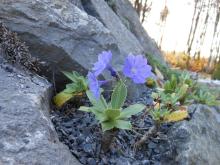
A couple angles on foliage; Sedum, Peony and Fothergilla -probably 'Mount Airy'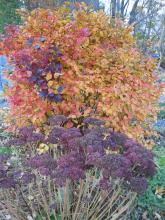
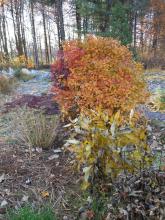
Re: What do you see on your garden walks? 2012
Amy O. we must have caught the same weather system on Oct. 21; lots of great rainbow action!
Re: What do you see on your garden walks? 2012
Thank goodness my P. marginata are all tight overwintering buds at the moment.
My Acer palmatum 'Omure yama' is in peak colour at the moment.
Re: What do you see on your garden walks? 2012
Michael- I always like sky views (nice clouds!) and the rainbow over fall foliage is great too :)
Todd- lots of good flowering there still- everything's white here! The Acer is especially nice..
Re: What do you see on your garden walks? 2012
Well Lori, seemingly you have been outside anyway today?
For the first time in weeks I have been inside all the day doing some homework although it didn't start raining before 3PM :-\ Now it is too late, it is pitch-dark.
Re: What do you see on your garden walks? 2012
About the same as mine, Lori!
Re: What do you see on your garden walks? 2012
It seems like every year I watch and wait in anticipation of the fall witchhazel bloom. And every year I think the flower buds are so small that it will take "forever" for them to open, and all of a sudden - poof! ;D
Re: What do you see on your garden walks? 2012
Amazing how much difference a week can make.
Crocus photo today, Corydalis BlacKberry Wine, Allium thunbergii, and Aconitum 1 week ago.
Charles Swanson NE MA USA
Re: What do you see on your garden walks? 2012
Rick, which witchhazel is that (fun semantically asking that ;) )
Charles, nice stretch of Allium thunbergii there. Regarding the Aconitum, I had posted an unknown Aconitum species on Facebook that the local garden club members share around here, and it looks just like your plant. After an hour of research, I think it looks like Aconitum carmichaelii 'Arendsii', I'm sure that's it.
Re: What do you see on your garden walks? 2012
Hey Mark,
Think this one (Aconitum) came from Herronswood. Not clear from the picture, but it's 5 to 7 ft. I'm planning to try everyone I can find, as they are quite seriously deer-proof. Most not that easy though, either suffering from fungus or summer dryness (or both).
Charles
Re: What do you see on your garden walks? 2012
Cool flowers, Rick! I thought I had some healthy seedlings of wild Hammamelis, but not sure if I lost track of the pot or what, I don't think I saw them this year ??? Definitely can't imagine any plants that start flowering at this time of year- even if we weren't in an early stretch of winter..
Charles- interesting about the Aconitum- I had a small plant from a friend in Poland planted fall 2011, it came up in spring and was promptly eaten by something, but came back and grew for a couple of months, till it was eaten again- no sign of it after that :(
Re: What do you see on your garden walks? 2012
Rick,
That Hamamelis virginiana is a lot nicer than what we have wild around here. Is it a cultivated variety?
Charles MA USA
Re: What do you see on your garden walks? 2012
Well something ate 3 of the 4 umbels on one of my Allium thunbergii f. album, a rabbit I would suppose. I guess they are not oniony enough. :D
There is something irresistible about members of the Hamamelidaceae family. Rabbits seem to search them out. I had very special seedlings growing from native seed here, and the first night I put them out they were eaten. Same with a fothergilla plant, too. Maybe this also goes for Lauraceae, too, as sassafras were promptly eaten also.
That's a Hamamelis virginiana, Mark. I got it as a plant mail order from Girard's back in 1982. The photo is labeled now.
Re: What do you see on your garden walks? 2012
Charles, this Aconitum (carmichaelii 'Arendsii') seems easy and tolerant of varying conditions, it see it in various yards around here. Mine is 6' tall, a few shoots a bit shorter. I'm with you, so far as looking for more species, very interesting plants.
Rick, too bad about the rabbit munchings, that is so irritating. We have two rabbits in the yard this year, and they loved Vernonia lettermannii nearly to death, ate it to a stub early in the summer, it grew out and was budded up, then they ate it to a stub again, will have to protect with wire mesh next year. Young tree seedlings seem to be very tasty, had a devilish time a few years back getting maple species seedlings to survive nibbling onslaughts.
So, my Hamamelis x intermedia 'Jelena' is NOT, its actually H. virginiana, glad to have a correct ID on it.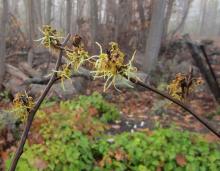
This might be a lame attempt at protecting developing seed pods on my Allium thunbergii 'Alba' from two days of soaking downpours from Hurricane Sandy, happening as I type this message, but I put plastic bags over the heads and zip-tied them. Just ran outside (with 50+ mph gusts) and so far they're holding up okay. For a couple other items I wanted seed on, I covered the plants with large heavy inverted pots, weighted down with boulders and bricks.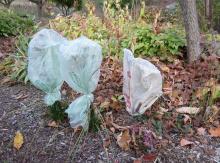
Re: What do you see on your garden walks? 2012
I found the first flowers of my Hamamelis virginiana about a week ago, although it is quite a few years since I planted it. The flowers are not very impressive yet and smaller than Rick's but I hope they'll improve the years to come!
Aconitum 'Arendsii' is the commonest garden aconitum in Norway I think! But all Aconitums and Delphiniums are prone to slug damage, at least in my garden :-\ I have tried several species from seed and they are prompt devoured. I always suspect slugs (and snails) but rodents are possible too but not rabbits (cross fingers).
Re: What do you see on your garden walks? 2012
Yes, yours would be H. virginiana, Mark. I don't think there is any other species that blooms in the fall. And of course, it's the wrong color for Jelena. My shrub gets a fair amount of direct sun that really doesn't increase flower size, but does increase flower numbers.
I hope those bags hold, Mark. I see you have one pinned down with a stick. A wise move, I think. My region from the beginning has been predicted to be one of the areas least hit by climate change, and so far, I think that's been true. I'm not envious at all for your storm of storms out east, and I heard a prediction of 3 feet of snow in Virginia, too.
Re: What do you see on your garden walks? 2012
I think Virginia already got the 3 feet of snow..
Rick, this area also seems to be (so far) avoiding some of the extra extremes (this climate is extreme enough without climate change!) many other areas have had- our winters have been near normal when others have had excessivley warm/dry or unusually cold winters, no serious summer heat waves or droughts either (in the last few years at least, but then ups and downs of moisture are not out of the normal)..
Trees going down on lines always seems to be a big problem when those big storms come- here, at least in the countryside, they try to keep all trees pruned well away from lines, so we don't see much of that, but in more heavily populated areas, with trees larger than most are here, I guess it's not possible..
Re: What do you see on your garden walks? 2012
Right, Cohan. Trees that are impressively big here in Minnesota are just run-of-the-mill further south. I can imagine that the difference is even more so where you are.
Re: What do you see on your garden walks? 2012
I admit to having a few plants in pots --far too many :-[ :-[ --mostly duplicates of easy bulbs that grow well in the garden--however a number are more specific and need to be under cover in winter as an aid to control moisture levels---i find pots easier for photographing -For all of the above though, the main reason is that my garden is 'chocka block',(full),and i haven't yet resolved the battle between purchasing plants/sowing seed verses lack of space--although that day is not far ahead .... ;D
Cheers Dave.
Well ---yesterday i solved some of the space issue .... for the meantime ;D
I was forever trimming back some large shrubs on the west side of our driveway ---namely a large Rhodo 'christmas cheer', a good sized pink Camellia and a vicious rambling rose which had grown up into the surrounding trees and was leaning over the entrance way catching the top of the truck each time i drove in.
I was in some ways sorry to see them go .
15 minutes with the chainsaw then a couple of rather full loads to the tip where it all will be chipped into mulch .
Then I sort of lucked things a bit --while pulling out the roots of a honeysuckle about half a metre inside the cleared area i came across a railway sleeper --then i found another further on and realised that this was the edging line of the original bed --in the end i located and dug up 13 sleepers--they show a bit of deterioration having been buried on their side into the ground for at least 20 years ,but will do .
There is a little weeding ,then the fun part begins --I'll probably be able to plant out about 70 seedling Trilliums ,divide /move a few Hostas from elsewhere , as well as a few different Epimediums and a number of native ferns at the far shaded end ,hoping to keep everything well below a metre in height .
Cheers Dave.
Re: What do you see on your garden walks? 2012
Here's a couple shots taken through my back 'doting window' today. I am presently in the process of taking down the
perennial plunk; first photo and to right in second (The Fothergilla will remain unclipped; but I've considered removing
it; see view below). Some folks leave spent perennials up, and that is fine as they are decorative, but taking them down
gives me opportunity to well trample rodent infested ground and check for rogue weeds that may have taken a bet on hiding
there. All the clippings will be left on the bed. The adjacent lawn is being religiously raked. Lawn is lawn; plunk is
plunk, and shade is shade (shade at left in photo 2). Fallen foliage is encouraged on the shade bed; discouraged on the
lawn; and tolerated on the plunk. It is not tolerated on the rock gardens! This leaves me with plenty of mosey "work" at
this time of year; ensuring that the alpine beds go into winter free of fallen leaves -just as the plants there would have
it if they had not been removed from their breezy homes. However, I suppose, the main reason for taking the perennials
down in this garden is twofold; One, the view of the rockeries from the subject window is cool. It daily reminds me of
some of the high points in my life in a small yet glorious sort of way when it is set upon a level and clear foreground,
and, two; several thousand snowdrops will appear here in April. They will appear through the desiccated remains of the
leveled perennials as if upon a mountain tundra after the winter's thaw.
Re: What do you see on your garden walks? 2012
Good job, Dave! It's always exciting to have new gardening space, isn't it?
Great views, Michael. I see some beautiful stonework in there!
Re: What do you see on your garden walks? 2012
Yip for sure Lori .
Divisions of 5 different Hosta's are already in, the same number of Epimediums as well --will start on the 'others' tomorrow after work if i have the energy . :-\
Cheers Dave.
Re: What do you see on your garden walks? 2012
You make it sound so easy Dave! Gives me added impetus to get on clearing some of the overgrown parts of the garden. I have similar plantings of woodlanders under rows of apple trees, several of which need some concerted work.
Michael - I am incredibly envious of that naturalistic background to your garden. We live in suburbia so no such 'genius of the place'.
Re: What do you see on your garden walks? 2012
Lots of work, Dave! Good to have some new planting space- I know I'd have a hard time removing mature shrubs if they were still looking good, but sounds like a good choice.. The only yardwork possible here now is snow removal and tree cutting...lol
Michael- nice views! I forget, is the wooded area at the back, part of your property? Good to hear what you do for winter preparations and the whys of it; My plantings are mostly very new (apart from old perennials here before I moved back) so I'm still figuring out what needs to be cut back etc. So far I have not cut back anything, though I had meant to do a few before the sudden lasting snow put an end to garden activities..
Re: What do you see on your garden walks? 2012
An update from here: http://nargs.org/smf/index.php?topic=1009.msg20214#msg20214
(Actually, this was a full week ago.)
The end of the Cotinus, Cornus mas, Vv. x'Juddii', carlesii. Viburnum x 'Juddii' foliage.
Now in real time, a painted styrofoam trough makes a nice background for Orostachys iwarenge. I've never thought of Fibigia clypeata as being polka-dotted.
Some things just keep going and going, like the Energizer Bunny. ;D
Syneilesis aconitifolia seedhead with Corydalis ochroleuca and Fargesia rufa in the background. Digitalis lanata and Bouteloua gracilis.
Re: What do you see on your garden walks? 2012
Really nice to see those seedheads Rick. I've always thought that these could form the basis of a good book on seeds and seed-sowing, but I've never got the camera out and worked on this. The detail of some plants seedheads (like Dictamnus) are fascinating.
Re: What do you see on your garden walks? 2012
Kristl Walek is working on such a book. I'm not sure what all will be her main emphasis, though. But I could certainly collaborate if you're in need of examples of various seed receptacles. A feng Shui specialist would be horrified walking into my house. "Dead" materials are everywhere... ;D
Re: What do you see on your garden walks? 2012
I Tried to post this earlier today, with no luck- either the snow interferes with internet (cell phone towers) reception, or more people using smartphones and internet due to weather- bad connections .. hopefully will work now..
Nice views Rick! Great to see the texture and colours of the different seasons.
It seems so long ago that we had those autumnal scenes- and in fact its 3 weeks ago today that we switched to winter white - definitely the earliest that has happened since I moved back in 07. We had a little melting this week, but that too is a distant memory now with at least 20cm of fresh snow yesterday and today, and still coming down..(a few more inches on these beds now)
A couple more views from the day before winter,
Ribes I think this is a European plant grown in gardens- denser than native species, but to me inferior in all other ways (flowers and fruit are both tiny even by Ribes standards, leaves usually not that exciting in shape or colour) but this fall it had the best colour I remember..
Dasiphora (Potentilla) fruticosa I don't know if this is a cultivar or more or less natural material, planted here years ago by my mom or aunt; part sun location in average to moist native soil, it is around 3-4 feet high sprawling through a fence..
And the way things look now- a couple of views from last night of the rock beds in front of the house; These are taken hand-held with ambient light from the outdoor house lights; not exciting shots, but still impresses me what cameras can do now!
Re: What do you see on your garden walks? 2012
Autumn is a beautiful and very important time in the rock garden. Here's just a taste of the splendor!
First; rock is important to rock gardeners. Without the rocky backdrop, this is just another photo of Allium thunbergii. 2: It hasn't bloomed yet but Acantholimon litwinovii is a charmer. 3: Sedum (aizoon?) looks like this all winter. I don't know any other plant that produces this effect as well as this one does.
4: A smattering of Androsaces. 5: pink tint in Bailey's Lace Cactus 6: Sage Brush growing points become a soft silvery green and very compact.
7: Eriogonum umbellatum 'porteri'. 8: Vaccinium 'Hamilton' in front of Scirpus caespitosus. 9: One everyone in the Northeast should grow and cherish; Hepatica (americana) shown here in an unusual rock garden setting.
Re: What do you see on your garden walks? 2012
More autumn colored goodies: Hudsonia ericoides in Spruce Moss; Eriogonum caespitosum; and Pyxi.
Kabschia Saxifrages are at their very best now; Seed stems on Orostachys iwarenge; Areneria tetraquetra in front of Eriogonum sp. from Fishlake cow meadow in Utah. The Eriogonum is a fine ground cover but very shy to bloom.
I started in spring with a photo of this little patch of mesic alpine turf. Primula 'Peter Klein' was in bloom then. Just autumn hues now, diagonal from bottom left Cassiope sellaginoides 'globularis'; Lonicera crassifolia and Loiseleuria procumbens; Arcterica nana in autumn hue and flower buds ready for spring; Rhododendron williamsianum. The last are Saxifraga 'Foster's Red' and a tiny little Heuchera I found in the Lemhi Mountains maybe H. rubescens. Too many pretty vignettes to ever post!
Re: What do you see on your garden walks? 2012
Cohan : I thought with those last photos that you had made contact with the Mars Curiosity project!Weirdly atmospheric in the snow.
Michael: lots still of interest there.
Maggi
Re: What do you see on your garden walks? 2012
I put plastic bags over the heads and zip-tied them. Just ran outside (with 50+ mph gusts) and so far they're holding up okay. For a couple other items I wanted seed on, I covered the plants with large heavy inverted pots, weighted down with boulders and bricks.
I use plastic milk crates to protect small plants. Not the ones that you buy; they will break down in the sun. The ones that the dairies use are nearly indestructible. I got dozens of them for free from the local dairy. The bunnies won't go near them.
Re: What do you see on your garden walks? 2012
Maggi- you're right, there is little of earthly reference in those night snow photos..lol
Michael- still very many interesting things there! Even if I've prematurely entered the part of the year where simply seeing a patch of bare earth is exciting.....lol
Re: What do you see on your garden walks? 2012
Some of my Anisotome latifolia are flowering in the garden . Their native habitat is on the subantarctic islands far to the south of New Zealand where they are an integral part of the megaherb ecosystem . Unlike their cousins on the NZ mainland (where white is the predominant flower colour ) the plants of the subantarctic islands have coloured flowers as well as interesting foliage . I can only grow a few species as some struggle in our warmer summer , colder winter and drier overrall conditions
Re: What do you see on your garden walks? 2012
I do like it! Although it looks a bit coarse it is stately and handsome with interesting leaves and flower colour. Is it monocarpic or perennial? What do you mean by cold winters? I wonder if it could survive in my garden where the summers are cool, the climate moist and humid and not too cold winters (usually not colder than -8-10C).
Re: What do you see on your garden walks? 2012
Not a lot of temperature variation on those islands by continental standards. Macquarie Island's record high and low are 14.4C (58F) and -9.4C (15F) since 1948 when recording began.
http://www.bom.gov.au/climate/averages/tables/cw_300004_All.shtml
How old are those Anistome? Are they still increasing in size, year to year? How do they look late in the summer... a bit bedraggled?
Re: What do you see on your garden walks? 2012
Gorgeous species, Jandals! They're very tall plants, aren't they?
Re: What do you see on your garden walks? 2012
Howdy Trond - they might do well at your place . I first grew them when we lived in the mountains and there they had to put up with -15C during the winter which wasn't a problem for them . I'm currently chatting to Rosa in the Orkneys where she is building a garden as a memorial to the Orkney Island people who the NZ government gave a chance to settle on the Auckland Islands . They figured same latitudes different hemisphere . Rosa is already growing some plants from the Auckland Islands and I will send her a few more seeds
Hi Rick - The smaller plants in the foreground are progeny of the larger plants in the background . The larger are going to flower too but seem to be 2 weeks behind the younger ones . The larger plants are 10 years and the newbies are 4 years from seed
When I pick the seed in late summer I don't just cut the stalks off because I worry about the center of the plant filling up with water . I just cut the smaller branches off and leave the stem to gradually rot . So they do look a little bedraggled . In late winter I can remove old seedheads , old leaves and renew their compost . Hopefully I've given a link to the Campbell Island weather info . Brief rain on 325 days a year and a little cool and breezy
http://en.wikipedia.org/wiki/Campbell_Island,_New_Zealand
Thanks Lori . I love them too , they are a bit coarse - just like me . The older plants are nearly 4 ft tall . ( yeah , I know , just like me Mr.Toole - Don't say it )
There are 2 more species about to flower and I will post them when ready . Years ago I tried growing almost all the species from the islands and alhtough I germinated all the Pleurophyllum species they were not happy and none flowered which was a real shame
http://www.google.co.nz/search?q=pleurophyllum+speciosum&hl=en&prmd=imvn...
Re: What do you see on your garden walks? 2012
I've seen pictures of Anisotome latifolia before but never really got a proper feel for it - those are great photos. It would be quite easy to imagine it growing on Orkney in company with Myositidium and Pleurophyllum maybe?! Campbell Island must be a sort of botanists nirvana!
Re: What do you see on your garden walks? 2012
Hei Jandals!
Thank you for the info and the links.
Campbell Island seems to be nice place as the the climate is a little drier than here! However we have more sun . . . .
I have never been to Orknøyene (Orkney) (although I have visited Færøyene (Faroe Islands)) but I presume the climate is not very different from here.
A question, where is it possible to get hold of seeds from these plants - both Anisotome and Pleurophyllum - I have seldom seen them in any seedlists?
Re: What do you see on your garden walks? 2012
Fantastic! I suspect those islands but that plant looks pretty big. I might have some trouble feeding it here. So; what is it; bird duff?
Re: What do you see on your garden walks? 2012
Thanks Lori . I love them too , they are a bit coarse - just like me . The older plants are nearly 4 ft tall . ( yeah , I know , just like me Mr.Toole - Don't say it )
:-X
Re: What do you see on your garden walks? 2012
The islands are a botanists nirvana Tim and expensive to get to . Lots of flower colour . Some of the gentians have red flowers . The other umbelliferae I grew was Anisotome antipoda (pink flowers) but in 15 years they never flowered and eventually died off .
I think I still have your address Trond and will send you some seeds in February so that you can sow them fresh . If anyone else wants some seeds just let me know .
Michael , I find that regular additions of a good organic compost really help but they don't like summer heat coupled with high humidity
Re: What do you see on your garden walks? 2012
Thanks, a lot Steve! Think I owe you some beers already! BTW, the Clematis seeds germinated like cress ;D
Re: What do you see on your garden walks? 2012
Cool plants, Steve! Those islands sound pretty interesting- to actually walk among those megaherbs would be very cool!
Re: What do you see on your garden walks? 2012
A rocky garden moon.
[attach=1]
[attach=2]
[attach=3]
November 25
Re: What do you see on your garden walks? 2012
Nice shots, and beautiful rocks!
Re: What do you see on your garden walks? 2012
Cool plants, Steve! Those islands sound pretty interesting- to actually walk among those megaherbs would be very cool!
Yes! When does the next boat go? 8)
Re: What do you see on your garden walks? 2012
A rocky garden moon.
Do you mean you try to create a moonscape? My first thought was icebergs ;) Very cool :o
Re: What do you see on your garden walks? 2012
No, completely incidental; back late from duties to the ever refreshing garden and I saw this so I had to run for the camera -which worked great on flash and focus until it got cold! :(
Re: What do you see on your garden walks? 2012
An interesting observation regarding Zephyranthes spp.
I am laughing right along with you when you see how puny these seedlings are... they were an afterthought, and obviously didn't receive the care they deserved, but...
They have served a purpose, at least, when I neglected to rescue them from my pot menagerie before temperatures plummeted outside. These small 1.5 inch pots endured two successive nights of 17F (-8C). Photos taken eight days after. Arranged from the least damaged to the most affected:
Z. minima
z. drummondii
Z. citrina
Z. primulina
Z. rosea
Re: What do you see on your garden walks? 2012
Managed a walk around the garden very early this morning before the rain set in for the rest of the day. :( and while a number of the Meconopsis are over this Meconopsis baileyi alba still has a number of buds to come.
Cheers Dave.
Re: What do you see on your garden walks? 2012
Rick- I wonder if any of those affected have enough below ground to recover? I have some SA bulb seedlings I let get a bit too dry recently, watching to see how some of those will recover- or not..
Dave- nice Mec! Rain is a distant memory here...
Re: What do you see on your garden walks? 2012
Memory of rain isn't that faint although now the colour of the precipitation has changed to the same colour as the meconopsis! I prefere the meconopsis though ;)
Re: What do you see on your garden walks? 2012
Today, 2 December 2012: Two inches of snow and -2C. A very late flowering ling strive to flower still while the Saxifrage rests and spares it strength till a spring display!
Re: What do you see on your garden walks? 2012
Cactus Park on Friday; Cotoneaster apiculatus seedling; 'Color Guard' Yucca and Satureja.
Cactus Park on Sunday (today); Geranium dalmaticum and Sage Brush. It looks like another Champlain Valley winter in progress. Next might be severe dry frost on bare ground -after 50+ balmy degrees expected on Tuesday, of course, but I hope not for the sake of the living things here.
Re: What do you see on your garden walks? 2012
Nice Geranium, Michael! Now you and Trond are only about a month and a half behind us ;D
Re: What do you see on your garden walks? 2012
Guess that means i'm 6 months ahead or is it behind ? you Cohan ........ Grin
Anyway here's a pic looking up into a Codonopsis flower --It would be interesting to see this under ultraviolet light, revealing an insect's eye view .
Cheers Dave.
Re: What do you see on your garden walks? 2012
Excellent picture Dave.
Re: What do you see on your garden walks? 2012
Nice Geranium, Michael! Now you and Trond are only about a month and a half behind us ;D
Well Cohan, I hope I'm not that much behind you when the spring arrives ;)
Dave, which one is it? Here is Codonopsis clematidea from 2011:
Re: What do you see on your garden walks? 2012
Quite the coincidence guys (Dave and Trond), that you each have taken remarkably similar photos of a Codonopsis flower, they look like the same species, both very nicely photographed and showing off the intricate detail of the flowers. :)
Re: What do you see on your garden walks? 2012
Beautiful Codonopsis, Tond and Dave! Realistically, I will always be behind all current members (until we get members in the arctic or antarctic!) when it comes to climate- so the only thing I can be ahead in is advancing winter...lol
Here are a couple of views from my 'garden'- though all the trees are native, and self sown; Then a view of one of the new rock gardens; I built these up quite a bit (though the underbase is mostly soil, so it will sink for sure) for drainage for plants that like to stay rather dry. The side effect of that is that they will get much less snow cover- especially this particular planting, which is in a drier part of the yard which gets less snow cover to start with. I know snow isn't vital or even good for all plants, but I think some insulation can't hurt when those -30/-40C winds blow, and this site is fairly exposed in one direction, though I'm working on closing that gap and other exposures around this planting with shrubs and berms!
To the left of the photo, which is north, is a non-rock berm for natives that like it dry (the planting is between two large spruces) but it's somewhat more organic soil than in the rock beds... My hope is that the berm will slow winds and catch snow; The more exposed direction is the opposite way- our driveway comes in from the south-east, and that is the only real gap in our windbreak of trees and/or forest all the way around the acreage.
Re: What do you see on your garden walks? 2012
A couple more rock garden views- these taken at night a couple of nights ago, showing the two rock gardens in front of the house- these get much deeper snow cover, since they get some of the snow shovelled off paths as well, especially the first one, which has paths on 3 sides, and a winter woodpile on the 4th!...
Re: What do you see on your garden walks? 2012
Thanks Michael ,Trond, Mark and Cohan :)
I raised it from seed as Codonopsis clematidea --it has a sprawling growth habit.
Cheers Dave.
Re: What do you see on your garden walks? 2012
Saxifrages gussied up for the season etc. December fourth 2012 was a fine day to be out in the garden. The last photo is a Sclerocactus glaucus seedling good through two winters so far.
And these: Dianthus simulans, a wooly thyme and Goldthread: And a tiny Iberis from friends in Quebec that always sets buds in the fall.
Re: What do you see on your garden walks? 2012
Very colorful, Michael
Re: What do you see on your garden walks? 2012
Besides the excellent plants, your vistas are always very well chosen, Michael- expansive views that make your property seem endless! The stone paths are lovely too :)
Re: What do you see on your garden walks? 2012
One of the problems with troughs in a very exposed garden is that they don't seem to have a very long lifetime. The first pictures show what's happening with a trough (hypertufa) that I've had many years. The plants of note are the white form of Astragalus spatulatus, Phlox pulvinata (ice blue form) and Hymenoxys acaulis caespitosa. They perform beautifully every year so this is a trough I want to keep. I moved it and damaged a corner in doing so. Replaced the corner by cementing a stone that looks like the head of a wolf, depending on how much imagination you have. Now the side of the trough is also wearing down.
The last two pictures are of a trough that Maichael Peden made which is all cement, I think. It is incredibly heavy, but is sailing through the winters with no problems.
Re: What do you see on your garden walks? 2012
Michael, festive color on those Saxes, nice, but it's the late senescence of Allium thunbergii that always amuses me, with that charmingly gauche color combination of pinkish-purple drying florets and orange stems. The Eriogonum color is awesome as well, truly all-season plants.
Anne, beautiful troughs, I can imagine how impressive these are in full growth and flower.
Re: What do you see on your garden walks? 2012
Charming and gauche... you don't hear those words conjunctively used very often. ;D But I have to agree, it's quite accurate in this case.
Fall/early winter brings out the colors in lots of the cool plants. While a "normal" person sees this time of year as drab and colorless, there is a good deal of vibrant examples here.
Ann, I had no idea there was a propensity for multiple flushes of western phlox spp. I just thought the few times that I have seen such examples were anomalies. The troughs are wonderful.
Micheal, was the Schlerocactus from seed? And at what point did you plant it out?
Such exquisite work on those troughs of yours that Ann showed. As a companion to this topic:
Styrofoam Trough Innovations
would you consider starting a new topic with those troughs, perhaps labeled "Hypertufa and Cement Trough Innovations", and explain your method?
Re: What do you see on your garden walks? 2012
Cohan, Anne et. al. thanks for nice comments. One of my aims here has been to display my "common man's" garden and a garden that is not intensely managed; ie. tons of compost, fertilizer, and mass plantings involving the constant addition and removal of material. I wish it to be a partnership with nature with ME as an ACCEPTED partner! The blue spruces in the photos are quite popular around here -those are on the neighboring properties ;) The path photo was chosen to hide the house across street -Ah! tricky! -although it is not a bad looking little house.
Anne, IMO that is fantastic material you grow in those troughs! I often wonder how a solid concrete vs. a hypertufa trough might differ in cultivation, the solid trough presumably being less amenable to the immediate loss of water (water tables etc.?); less permeable; less "airy". That, and all my troughs have a single drain hole. You may be on front line of any testing along these lines. Sorry the troughs aren't a bit more mobile ;D but well conceived concrete is extremely durable; that's why I did it the way I did. Is the coin still there? (BTW -love your repair job.)
The Sclerocactus was grown from Mesa Garden seeds (I also planted S. parviflorus). A general (developing) "philosophy" here is: get it out of the pot and into the garden as soon as possible or it is toast! That plant must have been quite a bit smaller when it was first put out. Planting seedlings seems to work well for a lot of things here including cacti -but one must remember to keep watch over them.
Re: What do you see on your garden walks? 2012
And here's another quick endorsement of fall planting/propagating; It works really quite well. It's a little late here because ground can freeze and heave in some situations, but , being reminded by the "International Rock Gardener" that I had Potentilla nitida -though never bloomed in a dozen years- wanting to stretch its toes in new conditions, I went out and ripped up a couple of small "Irishman's cuttings" from my waning plants yesterday to plant in my new limestone rockery. I still think I may see a blossom some day :-\
Re: What do you see on your garden walks? 2012
With Michael's comments added to Tim's about P nitida being shy to flower, I am now a bit anxious to know what if anything my young plants will do... will be watching keenly this year...
Re: What do you see on your garden walks? 2012
A few more treasures in winter garb: Areneria hookeri from 2009 seed; A favorite little thing -Sphaeromeria capitata; Potentilla nitida; Eriogonum caespitosum spare blooms for many weeks!; An old Minuartia from the high screes NE of Cortez, Colorado (Paronychia, Dianthus, etc. too); Acantholimon litwinovii color progression and A. ulicinum -still just green -(Moltkia too) interesting to note the difference in winter strategies of not just these, but of other evergreen plants as well.
And, of course, moss which finds this time of year most delightful.
Re: What do you see on your garden walks? 2012
These all look great, Michael! I agree, it is very interesting to see the different strategies plants use to solve similar problems..
I have a couple of tiny bits of Arenaria, which I think is hookeri also.. they grew rather fast in the pots, then once in ground slowed down/compacted very dramatically- I thought it was lost at first, but they are still there (or were- who knows what is under the snow? ;D )
Re: What do you see on your garden walks? 2012
One of the problems with troughs in a very exposed garden is that they don't seem to have a very long lifetime.
I have a couple of hypertufa troughs that are spalling at the top - when they were made, some additional mix had to be added to top them up, apparently (so the cause of the structural weakness seems clear). The other troughs made at the same time have been fine. We also had one trough, since dismantled, that was made from a hypertufa recipe that DH found on the internet and used very much against his better judgement - it was soft and crumbly almost from the start; from the texture and from the excess of brown concrete dye we added, we referred to it as "the chocolate brownie trough". ;D We've had our oldest troughs for 17 years now without damage - the oldest are finally starting grow lichen on them. :)
Anyway, just wondering how long did it take for your troughs to start showing damage, Anne?
Re: What do you see on your garden walks? 2012
Roughly in the 10 to 15 year range, Lori. The concrete troughs I got from Michael Peden remain absolutely perfect. They are very rough on the outside as you can see from the pictures and that makes them look very nice. My favorite troughs are 1) a real stone sink from Ireland and 2) troughs I got at Berkshire when Sally Cummings was bringing them from a company in England. They are not real, light enough to pick up and twirl around with one hand before planting and so far indestructible. Naturally, the company is no longer making them. Attaching a picture of one of them.
Re: What do you see on your garden walks? 2012
It would be wonderful to have real stone sinks! I imagine shipping it home was a bit of a feat, or did you find it locally?
Wow, the Berkshire troughs sound amazing - even empty, ours weigh a ton.
Hey, you can't post a photo of a beautiful trough without telling us what's planted in it! :o :D
Re: What do you see on your garden walks? 2012
The stone sink (will try to remember to photograph it tomorrow) was part of a display the year the Philadelphia Flower Show had Ireland as a theme. I talked to the fellow who made the display and we had a meeting of the mind and the trough became mine. It was a birthday, Christmas and everything gift to myself for a few years!
The plants in the trough pictured include: Daphne x hendersonii 'Ernst Hauser', Astragalus purshii, Oxytropis sp (grown from seed as an astragalus and never could identify it), Aquilegia jonesii, Penstemon thompsoniae desperatus, Douglasia nivalis, Phlox pungens, Phlox sp, Lewisia brachycalyx, Paronychia sessiliflora, et al. The trough is almost 4' long and it's 18" deep in the interior. Everything loves this trough and I'm convinced it's the depth. It full sun until late in the afternoon.
Re: What do you see on your garden walks? 2012
Interesting to see and hear about the various troughs, looking forward to the pic of the stone one!
Re: What do you see on your garden walks? 2012
Somebody has to start a separate trough thread :o Or does it exist already? Then make two: What does my trough look like now! and How I make my troughs ;)
I am collecting ideas for my own trough(s) ;D
Re: What do you see on your garden walks? 2012
That's a great idea - we are only just getting more seriously into growing plants in troughs, and Anne's example (and the plants in it) is wonderful. I am especially interested in trying more ericaceous species this way, which don't do well in the garden but could be much better located and looked after in troughs. There are interesting examples in old AGS Bulletins, including edging paving slabs with rocks and actually cementing rocks together to make containers!
Re: What do you see on your garden walks? 2012
Tim, that's the great thing about troughs. You can make a specialized mix that will keep certain plants happy. That's really difficult to do in the garden if what the plant needs is contrary to your natural soil conditions. I like to group plants that need similar soil, water, and exposure. The only other qualification is that they are plants that really please me and that I want to grow. It's rare that I'm able to water troughs so most of mine feature dryland plants.
Re: What do you see on your garden walks? 2012
Goat Plant! I found this Prenanthes-like plant in the Magdellena Mountains but it varies widely in the Southwest. Its foliage smells decidedly like billy-goat, so; Goat Plant it is. I clip the 25 cm stems back in fall and each time there is hard frost this interesting winged pattern appears on the stems. The next photo is a view from east to west along the spine of the Great Cordillera. from a recent spreading of shale back to the white garden is some 70 feet or so.
R. 'Ken Janek' and 'Springwood White' Erica are two plants that will be fantastic come spring but only if the winter is kind.
Re: What do you see on your garden walks? 2012
Funny how even a dead looking prenanthes like plant can be interesting - and not even in relation to the aforementioned winged patterned frost (which is fascinating): I assume the leaf blades senesced, fell off and blew away, while the petioles dried and remained...
I don't think I have ever seen that on a herbaceous plant before.
Re: What do you see on your garden walks? 2012
Nice views, Michael! As a bit of a composite aficionado, I'd love to see a photo of the goat plant in growth/flower if you have one..
This time of year, its just exciting to see bare earth/rock, so the cordilleran view is nice too ;D When you mention spreading shale- do you regularly re-top the area?
Re: What do you see on your garden walks? 2012
Finally got out and photographed the irish trough, or stone sink. It was delivered by a pickup truck and 4 football players (using a coouple of 2x6s), moved it into position. It is in this position to stay. Not a good time of year to photograph it and it's only half planted still.
Re: What do you see on your garden walks? 2012
Sorry, I don't know what happened to the photos. I'll try again. Computers are a mystery to me.
Re: What do you see on your garden walks? 2012
Masterfully done, Anne, and befitting of your awesome garden as a whole.
Kinda peaceful and Zen like, too.
Re: What do you see on your garden walks? 2012
Beautiful trough, Anne! the planting is looking good so far- I do like the outcropping, it is rather zen at this stage as Rick says..
Re: What do you see on your garden walks? 2012
I really l;ike the outcropping,too. It's necessary since this is a shallow trough. I'm convinced that the deeper the trough, the better, like a mini raised bed. In my climate everything freezes solid. The irish trough has such thick walls but that's still not enough protection from freezing. I use rain covers on some of the troughs, designed by Mark Mazer of NARGS. They are open on the ends and arched over the trough. They get lots of sun and wind but no drenching rain. You do have to brush the snow off the top or it will bow down. The top is made of plexiglas (I think). I wish Mark would weigh in. They are so marvelously designed and I'll put a picture on soon. I haven't installed them yet for the winter.
Re: What do you see on your garden walks? 2012
Funny how even a dead looking prenanthes like plant can be interesting - and not even in relation to the aforementioned winged patterned frost (which is fascinating): I assume the leaf blades senesced, fell off and blew away, while the petioles dried and remained...
I don't think I have ever seen that on a herbaceous plant before.
Rick; I recall the leaves and petioles do not fall from the stem. As I said, I clip all back so what remains is the (older seasons growth) stems. This is doable because all top growth dies, only buds on the caudex remain. The ice wings seem to emanate from the dead stem itself which really is weird as I cannot figure where all the water comes from. It must be coming from the earth below; a sort-of "frost finger" effect. I had a picture of the plant but computer ate most photos (that weren't posted to NARGS!) prior to June. I was out this morning shooting frost formation on a few other plants so may post those. If my goat-plant survives winter; I'll strive to get a photo up. It is interesting, I think, botanically and that it thrives here being from such a southern area.
Re: What do you see on your garden walks? 2012
The redundant hardiness of some plants is quite fascinating- hinting at interesting pasts!
Speaking of interesting pasts, I was looking at Dasynotus daubenmirei in the Alplains catalogue,
Dasynotus daubenmirei (Boraginaceae) (40x40,Z4,P,L,3:8w) ......................................... 15 seeds / $6.00 15083.12 (W) Idaho Co., ID, 4920ft,1500m. A superb member of the Borage family producing multiple stems clothed in sparsely-hairy, oblanceolate leaves and beautiful clusters of snow-white, inch-wide flowers
photo:
http://www.alplains.com/images/DasyDauben.jpg
This plant is discussed in the Jan 2012 issue of the International Rock Gardener online magazine, where it is mentioned that it is believed to be a relic of Cenozoic forests, a 'paleoendemic'
Quite fascinating, though from a little google searching, I did not find out too much about what sort of ancient forests those would have been- the Cenozoic is a long period! and I don't imagine the reference is to the sub-tropical forests that would have covered the area early on.. still, very interesting, and enough to make me want to grow this forest opening plant :).. maybe there should be an 'armchair botanising for Boraginaceae' thread ;)
Re: What do you see on your garden walks? 2012
... maybe there should be an 'armchair botanising for Boraginaceae' thread ;)
Well, you could start one. :)
Re: What do you see on your garden walks? 2012
lol-- not sure I'd have any further entries, though...
Re: What do you see on your garden walks? 2012
Has to be armchair botanising for me the next days. Although it is mild now (+7C) we have a lot of snow. Farther south they were hit hard by the gale and a train and several hundred cars were caught in the snowdrives. Hundreds of people had to stay all night in the cars. If this had happened in the mountains nobody had rised an eyebrow but this is in the lowland and in the mildest part of the country :o When I was out driving last night it reminded me more of a mountain crossing than a trip to the airport!
Re: What do you see on your garden walks? 2012
Euonymus hamiltonianus var. sieboldianus fruit. All harvested on 3 October.
15 days later:
The left, dried in relative darkness in the garage, the right is an outdoor dried bouquet remaining at my south facing doorstep.
Picea asperata and Liriodendron tuliperifera seed heads.
Gymnocladus dioicus and Pinus strous 'Wintergold'
Re: What do you see on your garden walks? 2012
So, you do have snow too, Rick! Nice trees ;) Think I still have to wait some years for my specimen to flower!
I hadn't time to picture my snowclad trees - no daylight when I had time and no snow left on them when I had daylight :-\
Re: What do you see on your garden walks? 2012
Some more frost action; still no snow :( still no cold :) Saxifrages; 'Hamilton' Cranberry; Androsace sempervivioides -special because it came from seed set here; and Shortia. The drawing is three (four) sided pyramid rock crevice garden concept: I know -way over the top. May I build you one? LOL!
Re: What do you see on your garden walks? 2012
Hi Michael, how come you have frost action without cold? :o
Now the cold is back here after a few mild days. The hellebore is later than usual but has managed to free itself from much of the snow. The Farrer viburnum is late too but has flowered and new buds are forming. It is still snow patches in front of my house.
Re: What do you see on your garden walks? 2012
Here, the frost comes at night, then disappears when the temperatures rise during the day. So far, we are having a non-winter. Joe had to cancel a ski trip to Vail in early December because of lack of snow. I check the garden every day speaking sternly to plants showing signs of ignoring the shutting down for winter process. Last week I found a Gentiana dinarica bloom (measely and not fully open, but still...).
Re: What do you see on your garden walks? 2012
Nice views, Rick and Michael, Rick- do you have lasting snow?
Anne- you just need to book those ski trips a bit farther north- the ski season started weeks early at many places in Alberta! And the next few days the mountain parks will be some of the warmest places in the province (apart from hot spots like Lethbridge and Calgary!). Our normal daytime this time of year is -6C, today we are forecast to be -7/8 and then -15/-19C daytimes for the rest of the week; still, nights only -19 to -23C, and we could have -30/-40 this time of year..
Re: What do you see on your garden walks? 2012
Before climate change, we always had continuous snow through the winter. Now, who knows? Last season, the severe drought lasted right through the winter, and I think we had more winter days without snowcover than with. Now the bulk of the snow seems to pass just to the south of me. So, southern Minnesota and Iowa get the snow I would usually get. They are getting a blizzard right now.
I feel sorry for the children here, when I think of the loads of fun we had as kids sliding down hills, grooming the runs, building snow forts, etc. On the other hand, nowadays they probably would much rather play with there video games, anyway.
Re: What do you see on your garden walks? 2012
Rick,
Your garden looks great. That ponderosa really is narrow at this point. Your tulip tree flowered very heavily.
John
Re: What do you see on your garden walks? 2012
My mother talks about really large amounts of snow when she was younger (snowdrifts nearly to the top of power poles! But I wonder if it was a matter of less forest cover so more severe drifting), but in my lifetime we've never had that- we usually have reasonable cover in mid winter but it can vary from nearly bare in parts of mostly coniferous woods to closer to a couple of feet in low/wetlands.
Fortunately in recent years with so much wild weather around, we have not been far from 'normal' summer or winter...
Re: What do you see on your garden walks? 2012
Hi John!
Glad to see you've made your debut here. Welcome!
When the leaves drop in the fall, I always find that the Liriodendron bloomed more heavily then I had thought. ....this season especially.
Re: What do you see on your garden walks? 2012
No more doting on the little plants in this garden this year.
Re: What do you see on your garden walks? 2012
But still a few hours left in this year to dote on the big plants in this garden!
Veiw of back yard after snow; Rhodopolis; Sage Brush by lamp post and ladenus Taxus
Re: What do you see on your garden walks? 2012
Michael, seems you still have full winter over there!
The winter did leave us last week here but we will have it back later for sure :-\ Today I managed to get outside between the showers. Not much to see though and everything is completely soaked. The Cyclamen (hederifolium) is still in leaf despite the cold we had and the hellebores try to flower as soon as they can (H. niger hybrid and foetidus).
Re: What do you see on your garden walks? 2012
Trond, I enjoy news of happenings in your tropical (comparatively) garden. There are stories of success with Cyclamen in the region though I'm apt to start an argument with those story tellers :rolleyes: Cyclamen in my garden so far have departed along with the most tender of the avian set around the time the first snowflake falls. The Helleborus foetidus types may burn to death if we get a real winter with little snow though I find H. orientalis, having a strong below ground component, quite tough. The weather folks here are saying the snow we have now (15 inches) is apt to stick around a while. A gentle mass of arctic air, deemed "modified" is to send a few ripples over us and temperatures at night are expected to drop to below zero F. Totally different than last winter so far!
Re: What do you see on your garden walks? 2012
Thanks Michael, it's vice versa too - I believe you have much warmer summers than I have ;)
We had rather nice weather today but working I couldn't enjoy it. At this time of the year I leave home before sunrise and get home about sunset but I had 3/4 moon shining when driving this morning ;D Now it is back to rain again :-\
Re: What do you see on your garden walks? 2012
Michael, the only cyclamen that makes it here is C. fatrense, which came from Dick Redfield many years ago. I've tried C. coum (didn't even make it through a single winter), and C. hederifolium. Cyclamen fatrense blooms in August (if memory serves), and is long lasting in the garden.
Re: What do you see on your garden walks? 2012
How does purpurascens do in eastern NA gardens? It certainly has no issues with cold- I think Lori has had it for some years, and I've had a number of seedlings outside for a couple of winters (not a long term endorsement yet, I know) though of course we have very different climate issues from you folks down east..
Re: What do you see on your garden walks? 2012
Yes, my two old plants of Cyclamen purpurascens (from Gardens North seed in 2004) are still doing OK here. Last summer, I finally moved some of the seedlings around, out from underneath other plants, to where they are visible at the front of the border. The size of the corm underneath the one old plant is quite surprising (it was exposed at the ground surface).
This account suggests that C. fatrense is a plain-leaved form of C. purpurascens:
http://www.cyclamen.org/purp_set.html
I'd also recommend giving this species a try, if you're interested, Michael. I haven't had any overwintering success with C. coum or C. hederifolium.
Re: What do you see on your garden walks? 2012
How does purpurascens do in eastern NA gardens? It certainly has no issues with cold- I think Lori has had it for some years, and I've had a number of seedlings outside for a couple of winters (not a long term endorsement yet, I know) though of course we have very different climate issues from you folks down east..
I've had great luck with C. purpurescens, coum & hederifolium here in Vermont with no extra winter protection, but in very well drained soil. The coum is self-sowing too!
Re: What do you see on your garden walks? 2012
After visiting with Nina and Jack Lambert many years ago, Nina gave over 50 Cyclamen coums in all sizes. I tried them in many different areas in the garden, in varying soils, exposures etc. Not one made it through the winter. She gave me many more the following year with the same result.
I was told by a Czech grower that C. fatrense was not a form of C. purpurascens. The leaf is not absolutely plain, it does have some [no-lexicon]minor[/no-lexicon] marbling. At any rate, it has been hardy here for many years, the others (hederifolium, coum) have not. C. hederifolium actually made it through a few winters but gradually dwindled.
Re: What do you see on your garden walks? 2012
Anne, do you grow Cyclamen purpurascens? I find it iron-clad hardy here, and as well, forgiving of hot dry weather too, reliably flowering starting mid summer and lasting into early autumn. Some of the marbled and silver leaf forms are outstanding. I scratch in the seed, and they come up by the hundreds.
Re: What do you see on your garden walks? 2012
Well, there you have it! If it will grow for Amy, Anne and Mark then it will certainly grow for me! This could be a case of trying too hard; killing plants. No arguments: I'm looking for peace in 2013 as well as for exciting gardening adventures :)
Re: What do you see on your garden walks? 2012
Interesting to hear how well Cyclamen purpurascens does in Mark's and other gardens. Here it is a very choice and not so reliable plant, and doesn't generally seed around, though very lovely. We do exceptionally well with C. hederifolium, which I always thought one of the hardiest of species, but even graecum will grow outside whilst rarely flowering well. The most beautiful species (I've always thought) is repandum, but this doesn't like our hot dry summers.
Re: What do you see on your garden walks? 2012
A few points here taken from Chris Grey-Wilson's "Cyclamen: A Guide for gardener's, Horticulturalists and Botanists" (Batsford 2002) in respect of Cyclamen purpurascens.
In respect of C. fatrense = C. purpurascens he says:-
"In my monograph "The Genus Cyclamen" 1988 I was very dismissive of the related C fratense described in 1971...... from the Fatra region of Slovakia. ASt that time I had not had the chance to observe either the dried type specimen nor better still, any living material. However, I have since been able to observe live collections from several sources and I have now come to the conclusion that this plant cannot be distinguished on botanical grounds; it's prime distinguishing feature is the plain unmarked leaves but such forms exist elsewhere in the species range. However the plant in question behaves rather differently in cultivation and is, for that reason, best identified as the Fatra Form. The earlier confusion results mainly from the claim of the original authors that C fatrense differed from C purpurascens in having plain not marbled leaves. However the Fatra Form is a far more uniform plant in the wild, all the individuals in the limited region in which it is found with plain leaves. The leaves are noticeably more matt rather than shiny green and with a more scalloped margin, and the flowers are often somewhat larger on average, though they fit within the overall dimensions of C purpurascens. As these variants are in many ways rather minor ones, I am unable to accord the plant even with varietal status"
He goes on to say "that the Fatra Form is a rather better garden plant than the more widespread forms of C purpurascens, being both more prolific in flower and, in favoured sites, seeding around. In the eastern USA, where Cyclamen grow rather poorly compared to many places in Britain, the great exception proves to be the Fatra Form which thrives in healthy colonies in several of the gardens that I visited in 1994. The only conclusion I could draw was that it favoured the acid soils of the region.........."
In his own British garden Grey-Wilson does not appear to find C purpurascens easy and suggests tubers should be deeply planted (6-8 inches) "and capped with a generous mulch of bark chippings or pine needles". Of American growers he mentions Gerald Fisk "who clearly enjoys great success with this species in his Chicago, Illinois garden"
Re: What do you see on your garden walks? 2012
Mark, the only cyclamen that has survived for me is what I know as Cyclamen fatrense from Dick Redfield. Dick was very insistent that it was different from C. purpurascens (which I don't have), and since his knowledge was really encyclopedic. I've always accepted it as such. It's a lovely plant whatever the name. I tend to become very fond of plants that do well for me and I'm very fond of this one.
Re: What do you see on your garden walks? 2012
Tim, the Cyclamen hederifolium and coum leaf forms are pure delight!
David, I find it surprising about Grey-Wilson advice to deeply plant C. purpurascens (6-8 inches), mine always rise to the surface with 1/2 of the tuber above ground level! It's somewhat unnerving observing that behavior, as I worry they will dessicate in our summer heat, and if no snow cover, could be winter killed, but it seems to be what they want. Mine are also growing on a steep hillside, so moisture never lingers there, the area becomes quite dry.
Anne, given that I'm a couple hundred miles to the north of you, I have to imagine C. purpurascens should be hardy and grow for you. I can save seed this summer.
Some views of Cyclamen purpurascens planted under Magnolia 'Forrest Pink', in one view there was a bumper crop of Magnolia seed littering up the cyclamen and trillium bed beneath ;), a view of self-sown seedlings (all green ones). I started out with all-green leaf ones, then got some silver and marble leaf types, and now get all kinds of seedlings.
Re: What do you see on your garden walks? 2012
That was very helpful, David. Thanks.
I have now come to the conclusion that this plant[C. fatrense] cannot be distinguished on botanical grounds...
but on cultural grounds...
-------------------------------
C. purpurascens growing in Minnesota gardens have their crown at or just below the soil surface, for the most part. I've always imagined that those "above grade" simply heaved up with frosts, but they do equally well. A few grow C. hederifolium, and they look very healthy, although I've not seen them in flower.
Re: What do you see on your garden walks? 2012
Thanks, Mark. I'll look forward to trying the seed.
Re: What do you see on your garden walks? 2012
Hope you all had a Happy Christmas and New Year. Thought you would like to see what I saw while walking around the neighborhood. The snow fell on Boxing Day and, with gatherings from all over the neighorhood, provided just enough snow for this 18 ft. high fellow. Cars are stopping day and night for picture taking causing quite a traffic jam on the street. A real delight. Oh, Oh, I forgot to resize so will send it to you separately. Fran
Frances Howey
London, Ontario, Canada
Zone 5b
Re: What do you see on your garden walks? 2012
And here he is - I hope. Fran
Frances Howey
London, Ontario, Canada
Zone 5b
Re: What do you see on your garden walks? 2012
Not sure if I'd like that in my "garden" :D, but it's pretty impressive.
--- Excellent branch work, too!
Re: What do you see on your garden walks? 2012
I had two Cyclamen purpuracens which i bought from a nursery for the last 4years. they grew into large plants. in fact one year there was no snow cover but they still survived. year before last both the corns started to show above the ground.One of that rotted .I think it is because of the drainage issue.the other one is fine. I got seeds from the NARGS seed exchange and from green ice nursery 2 years ago and now i have about 6 more plants .
Re: What do you see on your garden walks? 2012
And here he is - I hope. Fran
Frances Howey
London, Ontario, Canada
Zone 5b
Oh, do you think he is out walking in the night? Not sure if he is still there ;D
Re: What do you see on your garden walks? 2012
That is an incredible snowman Frances - how an earth did they get the midrif and head on top of the base? One very cold year here we used icicles hanging from the greenhouse for arms - quite effective!
This is the most remarkable specimen of Garrya elliptica that I've ever seen, growing in the mild south-west at Dunster, near Minehead in Somerset (this is also close to Porlock where several famous gardeners including E. B. Anderson had or have gardens). John Richards relates how Wayne Roderick was surprised how hardy this Californian shrub is in British gardens, and Robert Nold in his book 'High and Dry' speaks of several other species, especially flavescens. I've never heard of these grown in the UK, I wonder if they are much in the US?
Re: What do you see on your garden walks? 2012
Tim, that is a nice specimen! I've seen Garrya in England and have wanted to try it at home. Once I got the chance but then we got the worst winter in decades and it died :-\
Re: What do you see on your garden walks? 2012
Tim - don't know about Garrya elliptica being grown in the US. However, back in 2000AD, inland from Los Angeles and high up where there were still patches of snow on the ground, we discovered one growing in the wild - I have always been intrigued by this plant/tree with the stunning catkins and really should have taken some seeds from it. Fran
Frances Howey
London, Ontario, Canada
Zone 5b
Re: What do you see on your garden walks? 2012
Mark, some nice leaf forms on the C purpurascens!
I have some from garden seed from John W in Nova Scotia, some from regular and some from 'white' leaf plants, still small though I had some flowers last year; I also have a lot of seedlings from wild Austrian seed from Johannes Hoeller (hope I got that right without looking it up) some of those have been in the ground for a winter and a half and there was some flowering this year.. I planted out some more this year in various spots so we'll see how they go.
Fran-I think that's probably the same snowman we saw on tv- they used a framework of plywood boxes filled with snow and of course a ladder..
Tim- love the Garrya.. I think I've seen seed at Alplains- oops, no, that's flavescens...
Spiegel wrote:
[quote=Spiegel]
After visiting with Nina and Jack Lambert many years ago, Nina gave over 50 Cyclamen coums in all sizes. I tried them in many different areas in the garden, in varying soils, exposures etc. Not one made it through the winter. She gave me many more the following year with the same result.
I was told by a Czech grower that C. fatrense was not a form of C. purpurascens. The leaf is not absolutely plain, it does have some minor marbling. At any rate, it has been hardy here for many years, the others (hederifolium, coum) have not. C. hederifolium actually made it through a few winters but gradually dwindled.
[/quote]
This is a test of the new NARGS Forum interface.

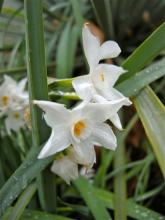
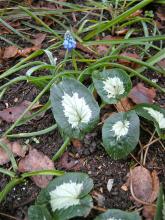
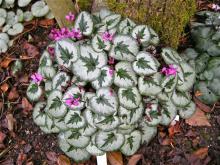
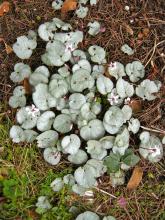
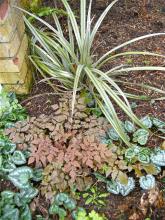
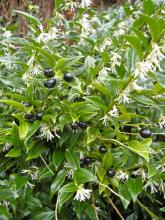
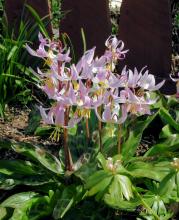
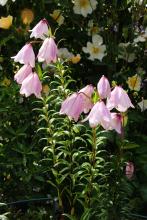
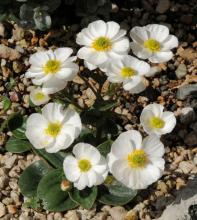
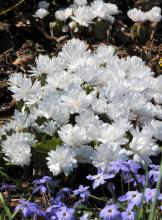
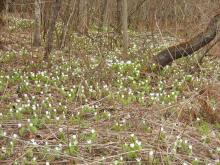
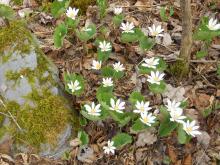
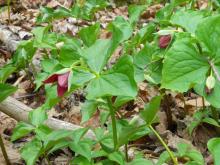
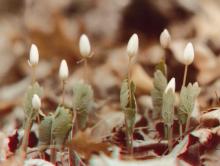
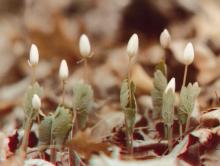
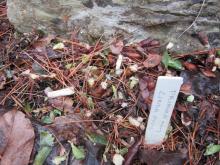
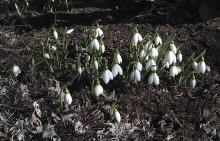
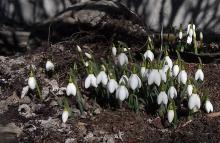
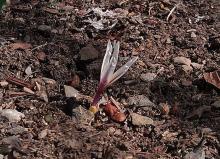
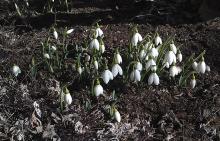
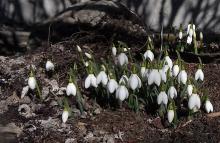
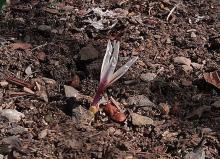
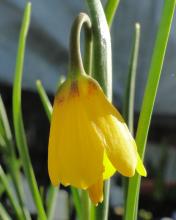
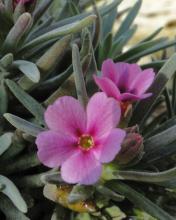
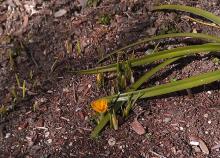
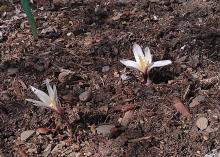
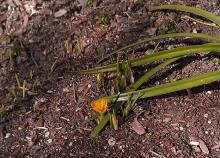
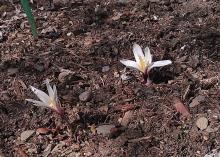
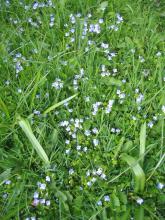
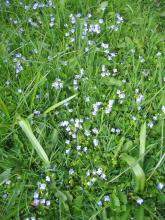
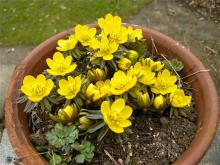
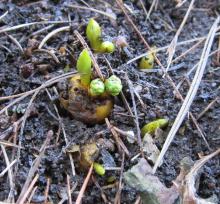
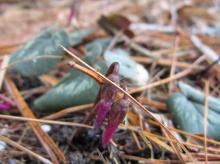
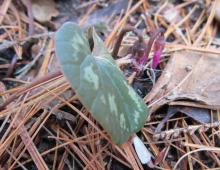
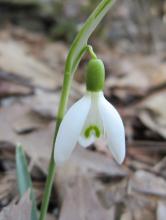
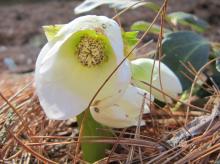
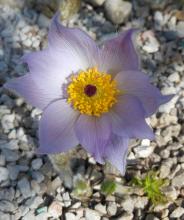
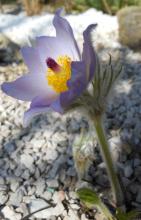
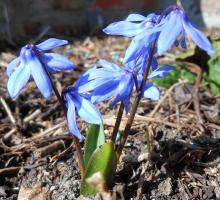
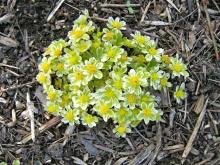
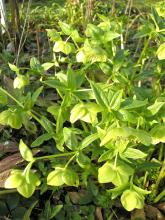
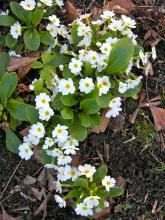
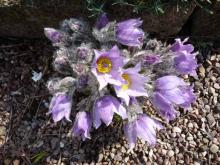
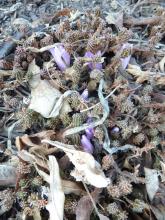
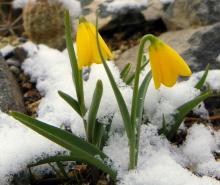
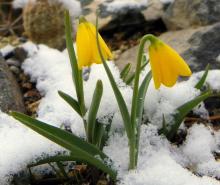
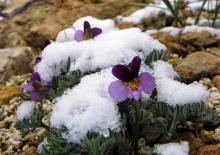
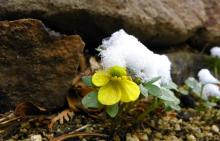
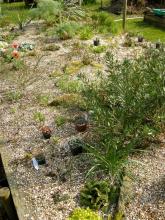
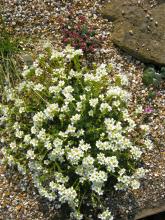
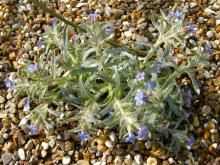
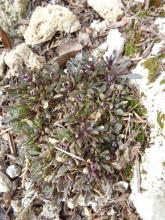
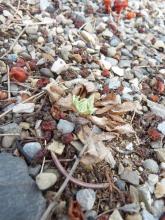
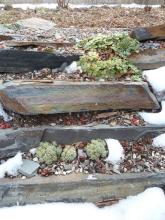
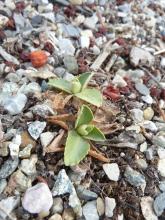
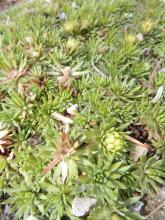
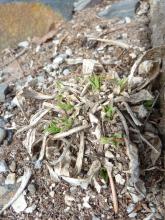
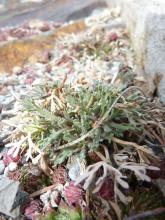
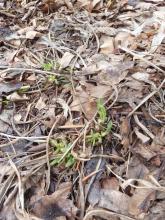
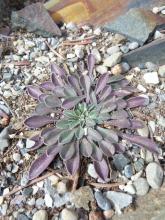
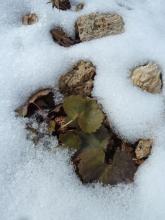
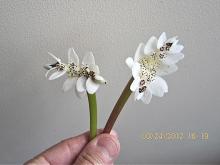

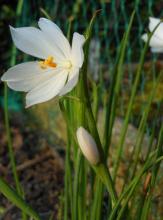
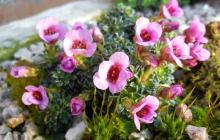
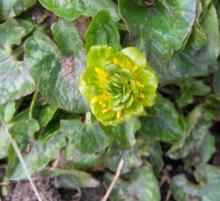
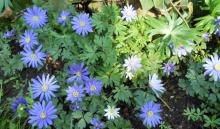
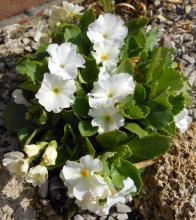
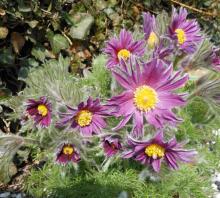
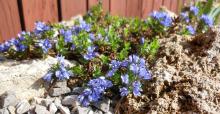
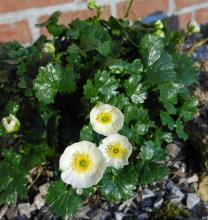
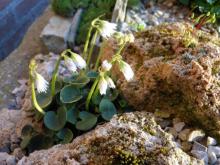
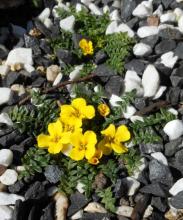
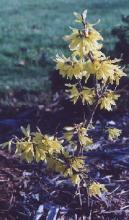
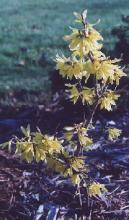
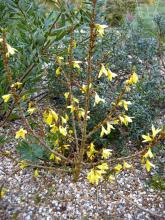
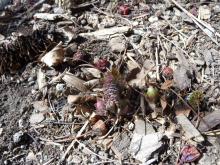
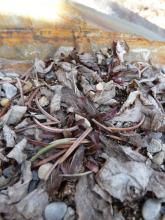
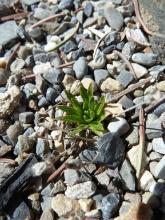
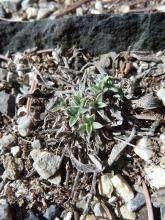
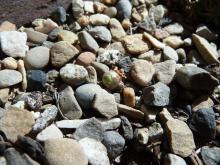
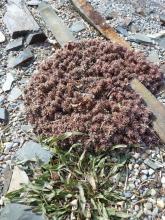
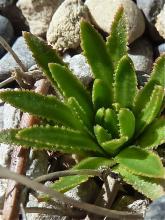
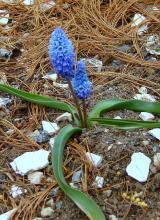
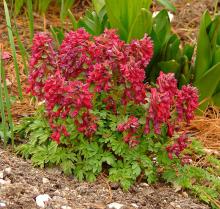
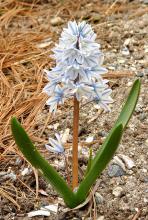
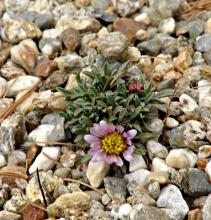
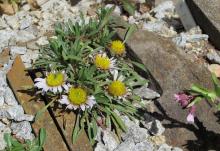
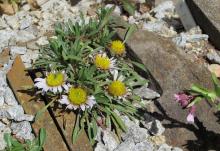
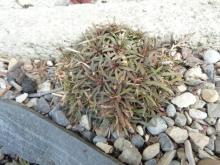
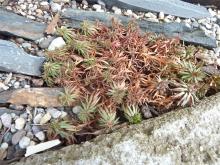
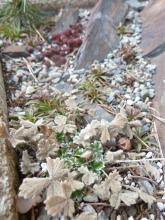
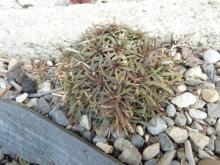
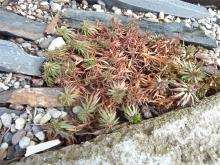
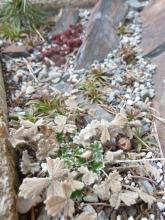
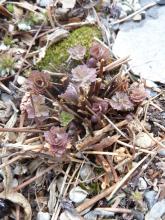
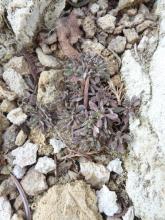
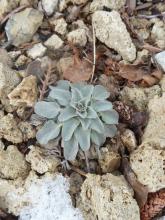
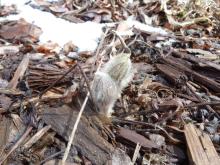
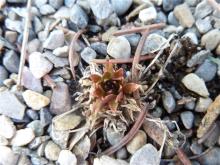
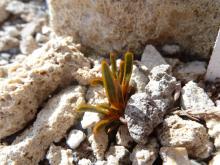
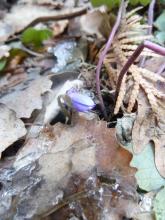
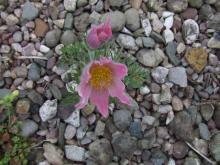
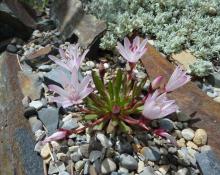
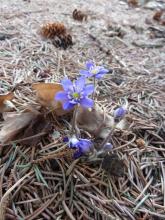
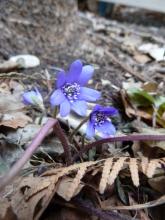
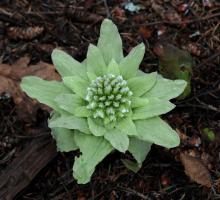
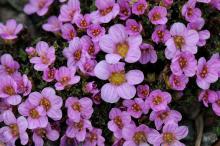
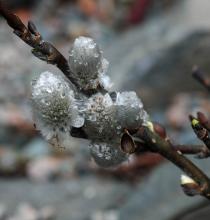
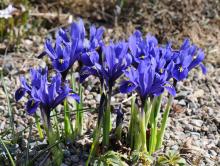
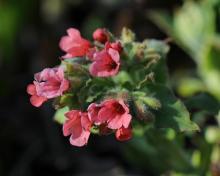
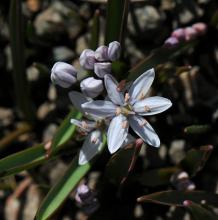
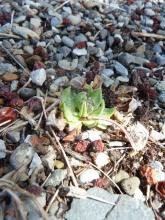
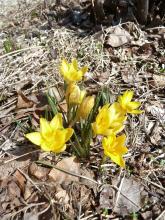
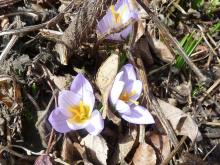
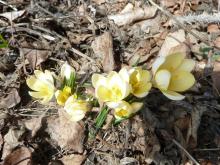
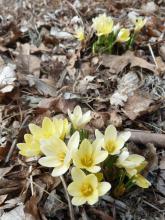
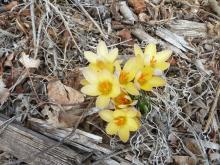
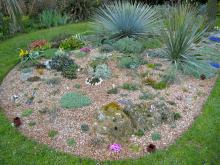
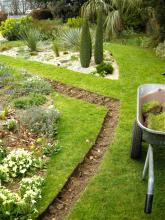
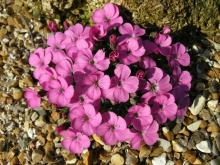
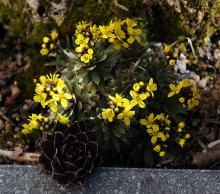
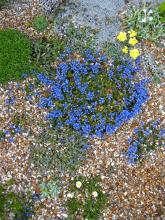
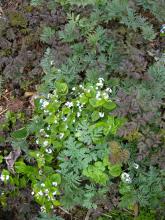
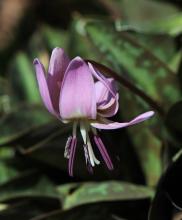
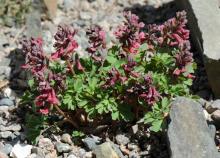
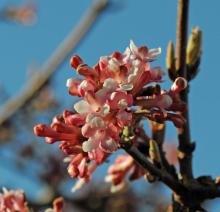
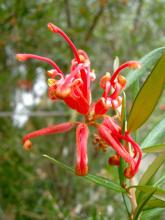
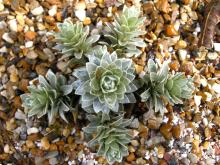
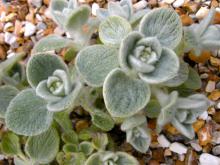
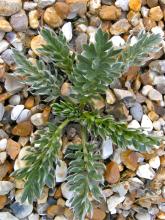
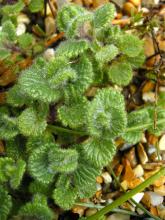
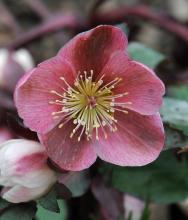
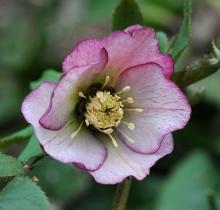
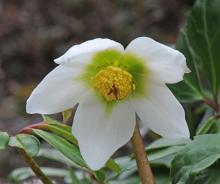
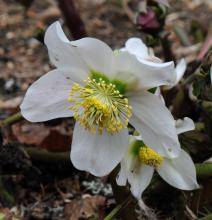
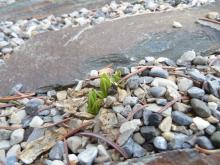
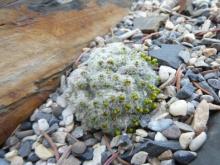
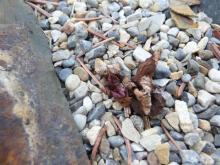
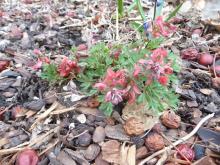
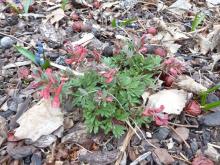
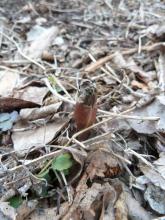
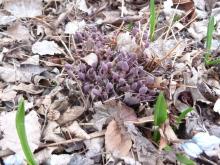
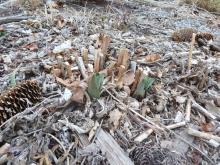
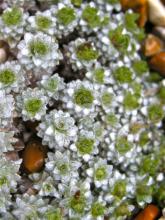
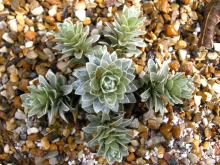
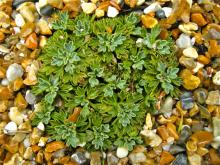
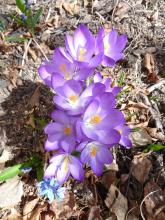
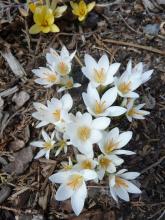
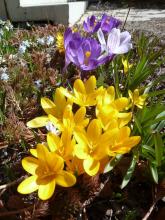
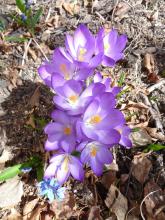
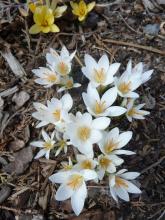
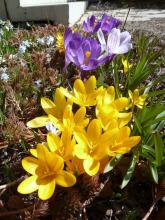
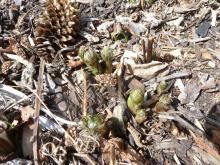
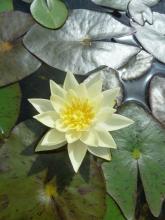
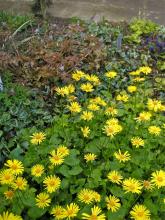
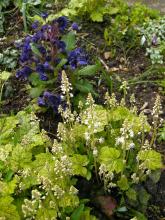
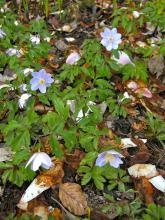

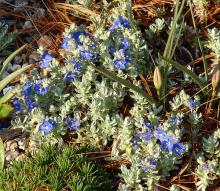
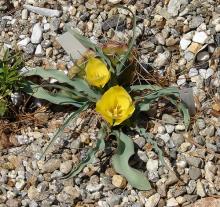
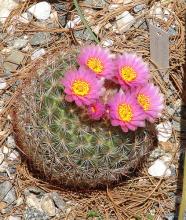
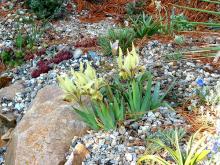
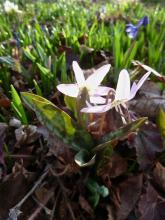
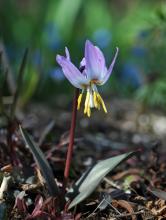
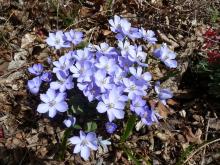
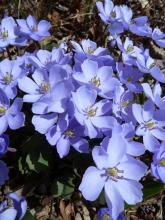
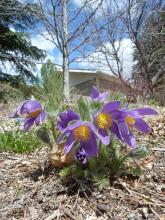
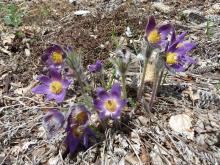
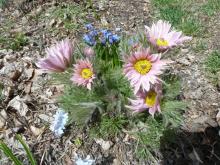
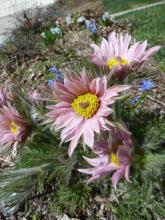
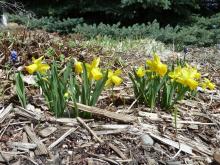
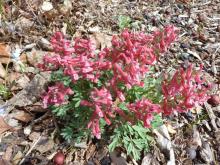
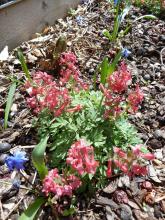
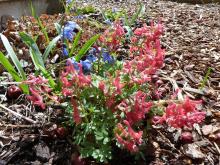
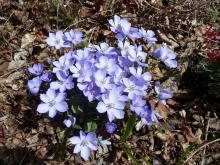
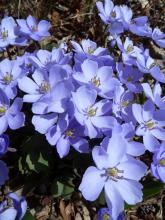
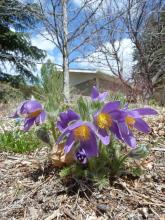
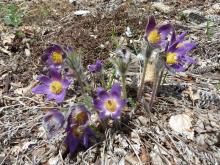
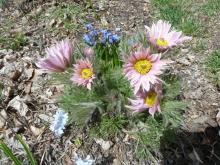
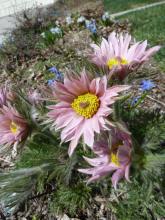
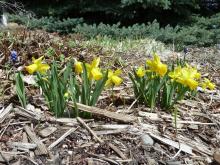
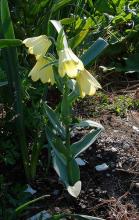
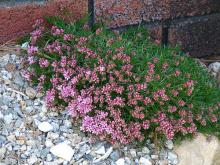
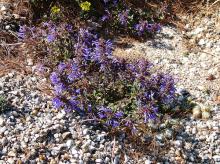
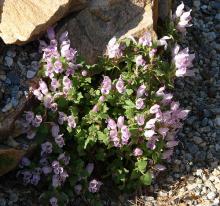
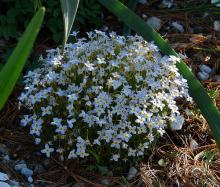
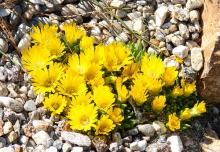
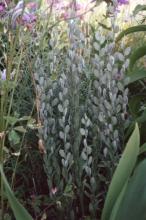
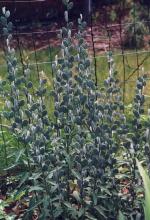
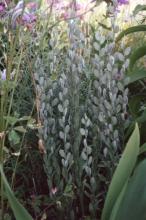
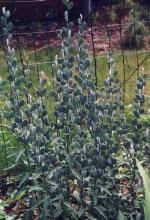
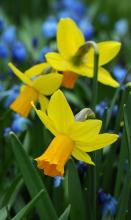
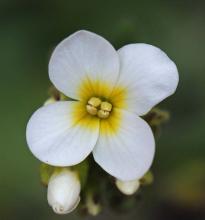
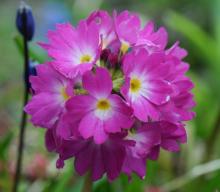
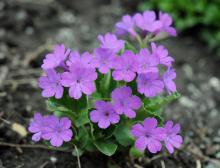
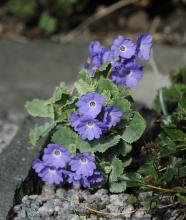
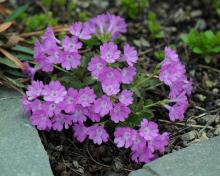
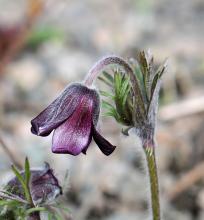
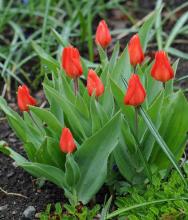

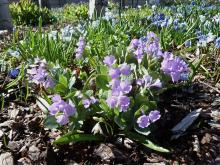
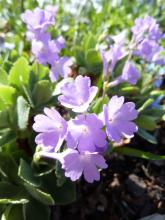
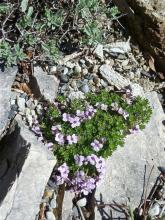
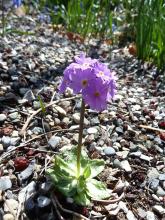
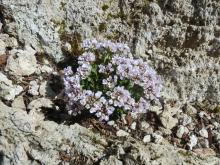
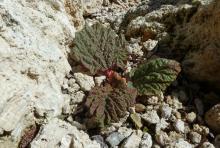
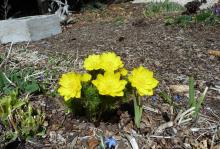
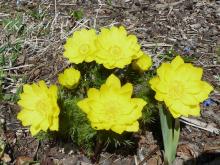
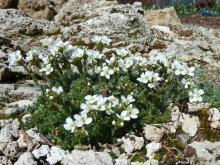
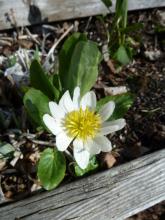
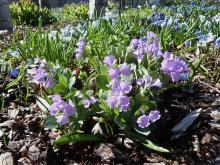
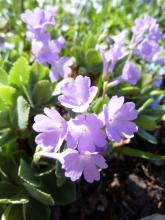
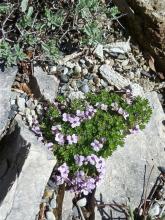
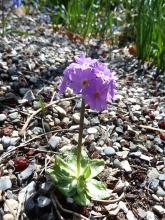
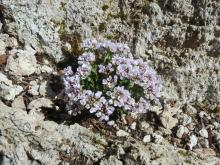
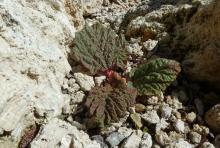
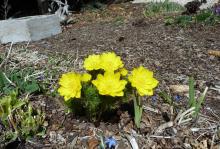
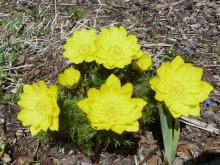
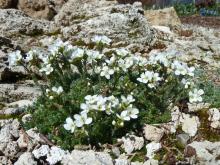
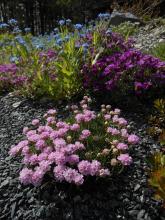
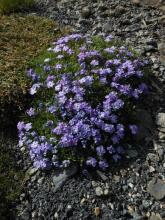
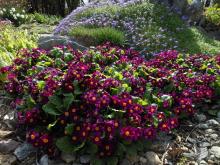
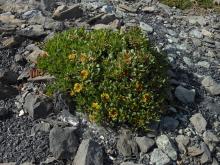
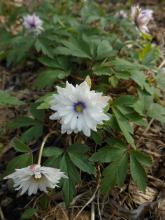
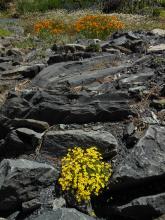
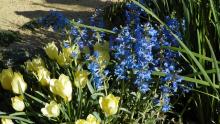
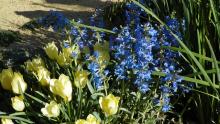
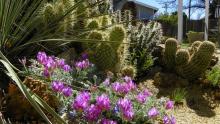
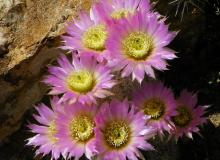
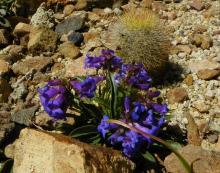
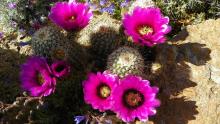
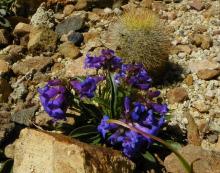
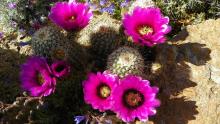
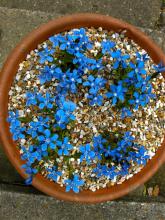
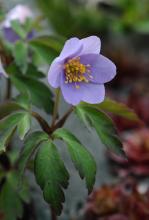
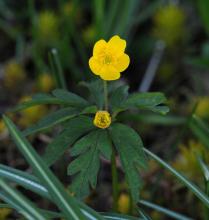
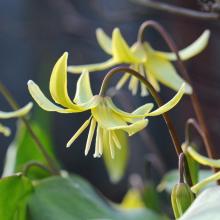
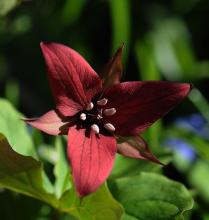
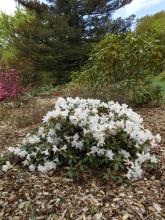
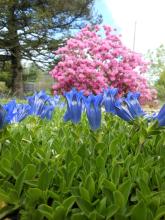



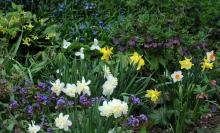
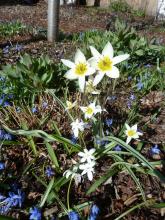
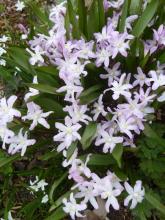
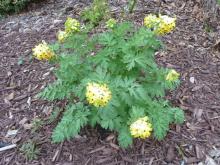
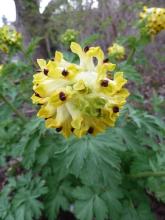
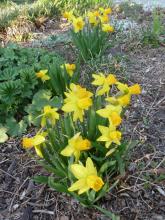
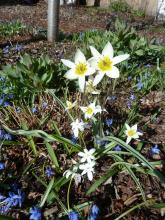
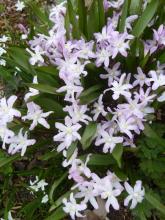
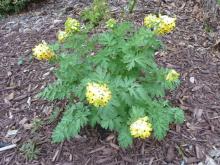
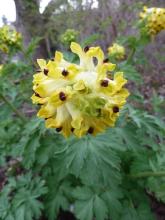
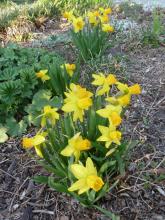
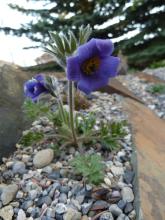
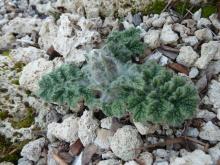
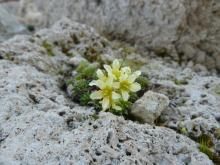
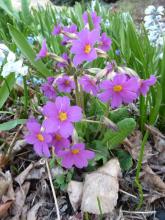
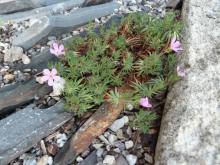
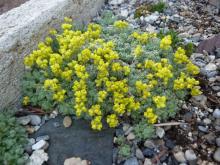
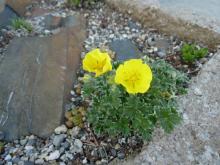
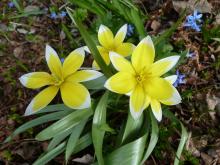
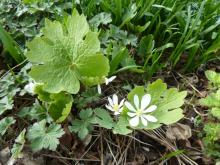
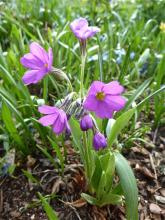
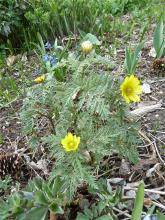
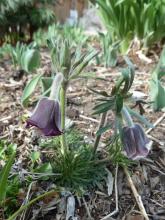
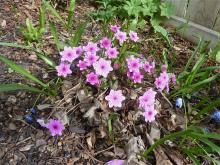
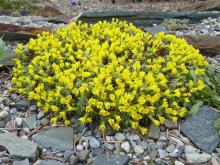
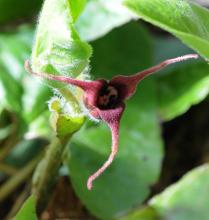
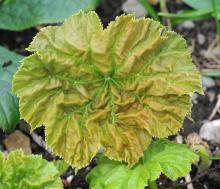
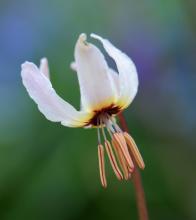
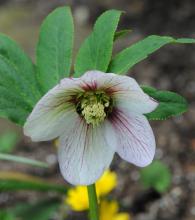
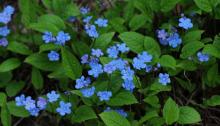
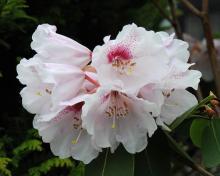
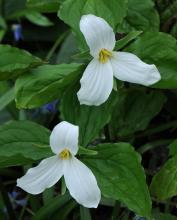
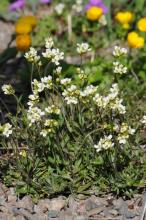
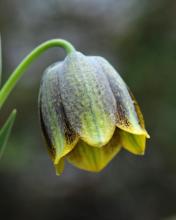
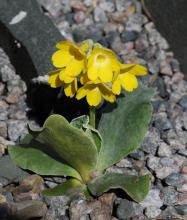
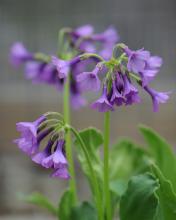
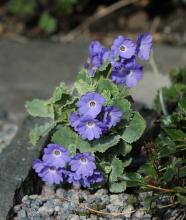
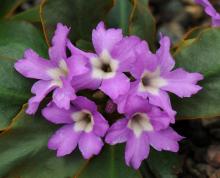
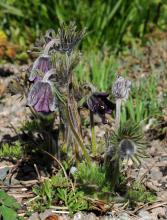
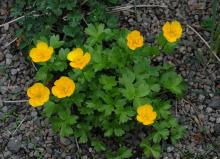
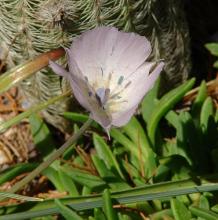
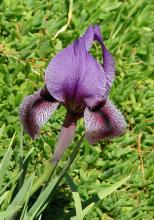
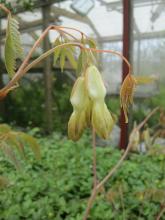
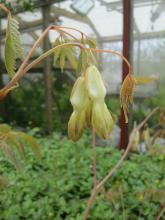
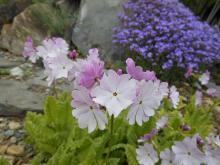
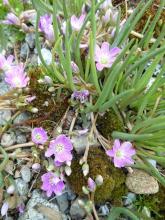
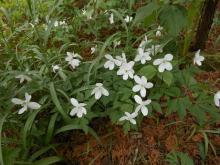
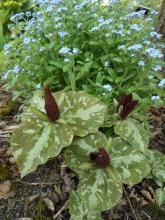
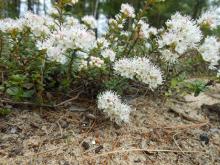





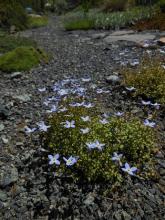
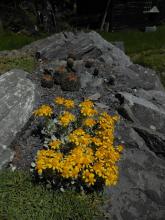
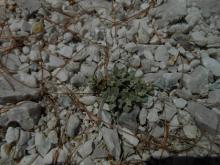





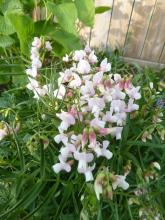
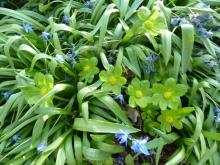
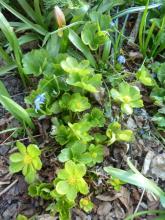
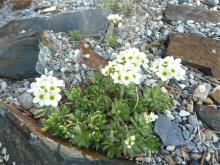
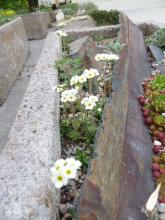
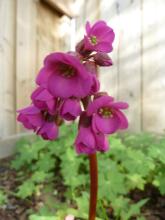
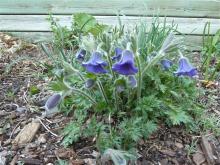
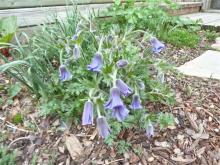
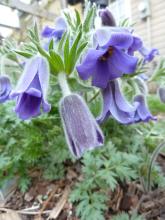
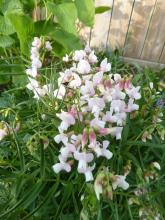
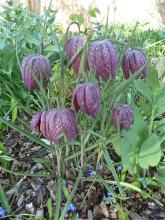
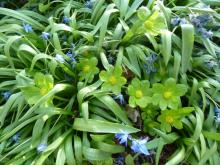
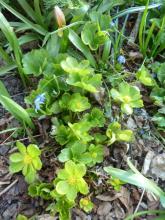
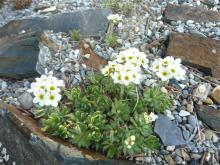
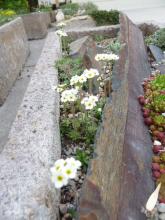
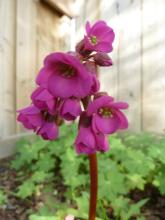
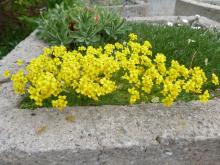
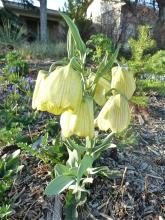
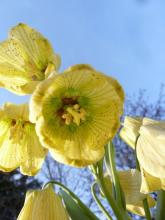
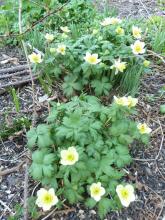
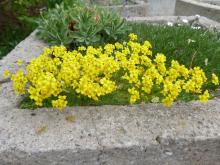
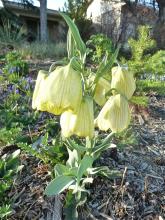
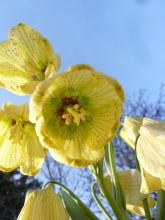
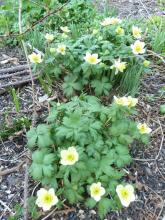
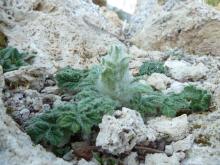
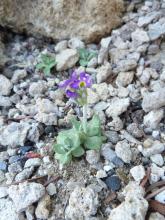
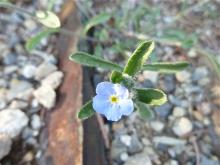
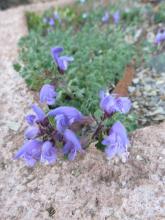
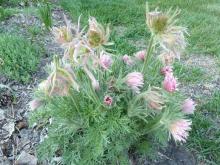
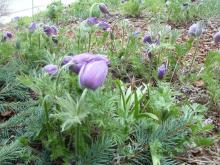
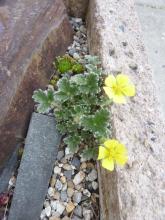
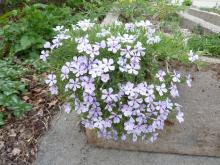
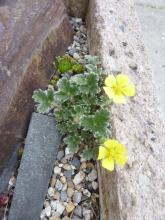
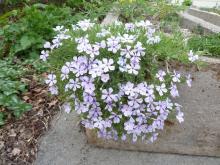
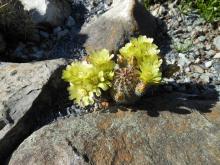
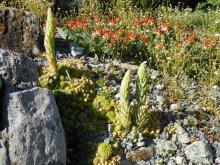
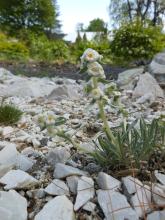
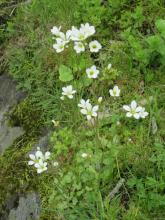
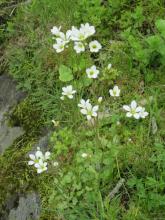
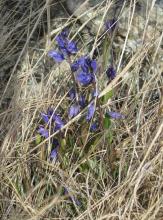
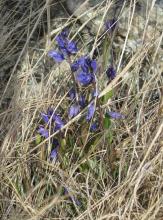
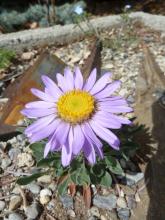
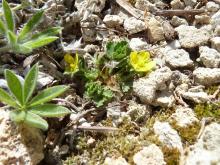
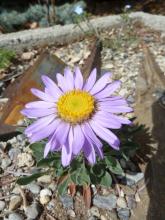
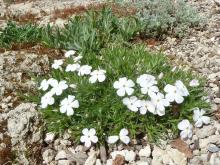
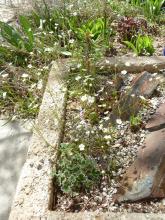
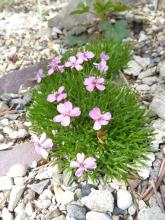



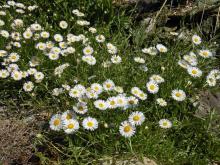
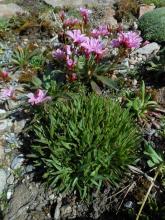
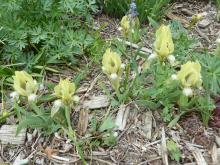
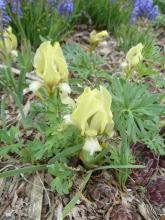
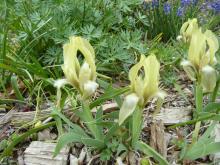
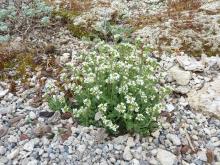
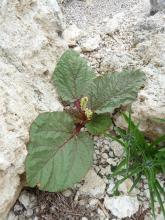
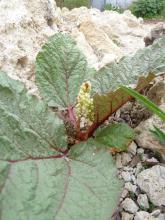
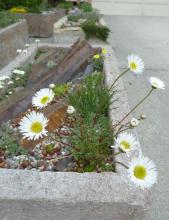
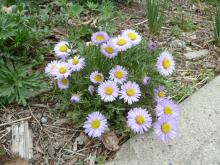
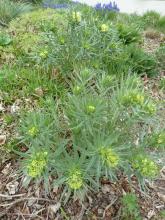
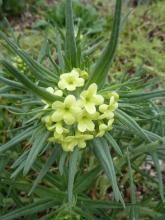
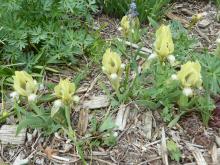
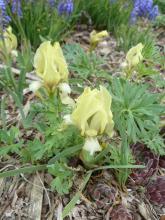
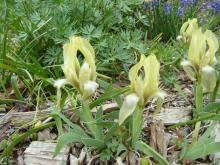
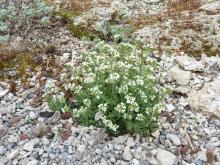
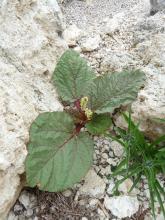
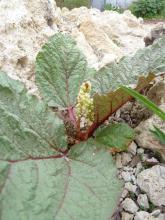
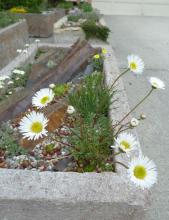
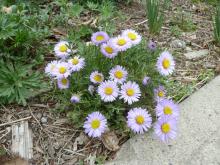
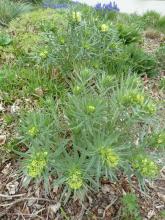
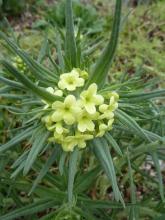
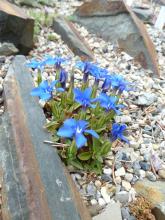
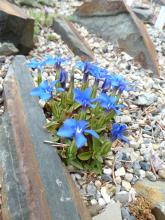
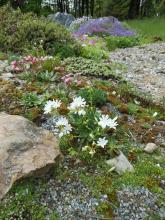
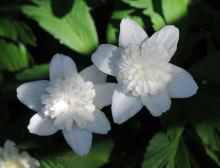
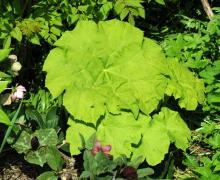
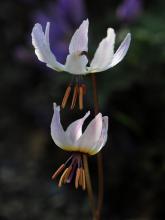
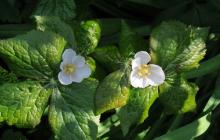
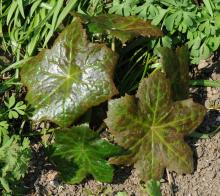
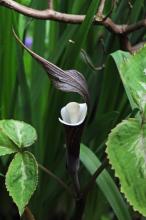
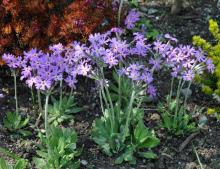
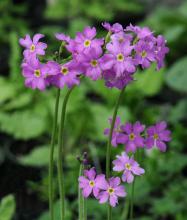
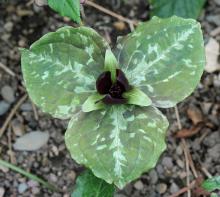
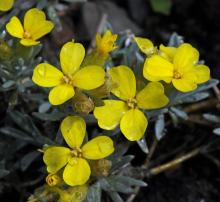
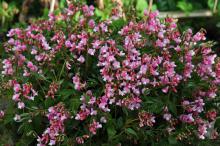
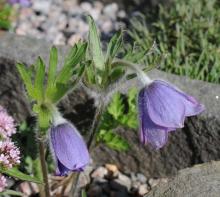
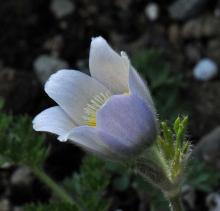
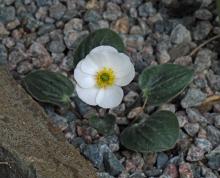
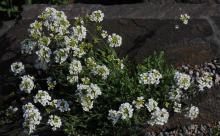
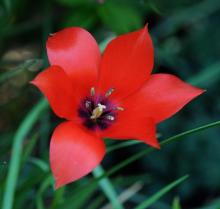
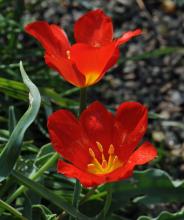
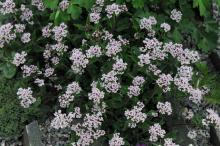
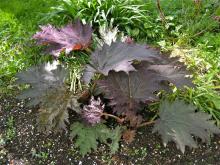
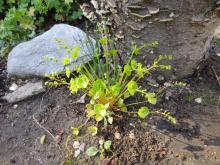
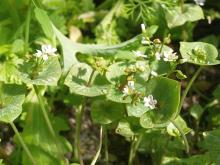
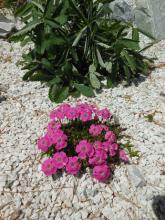
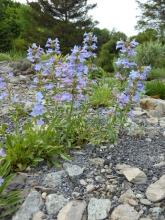
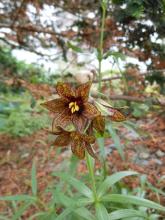
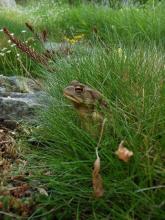
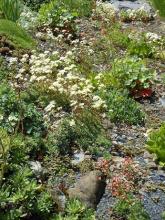
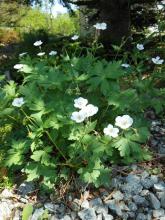
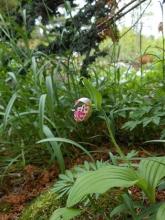
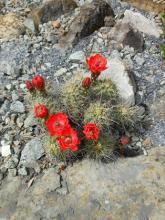
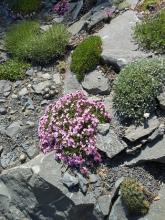
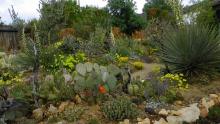
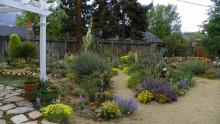
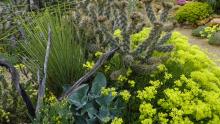
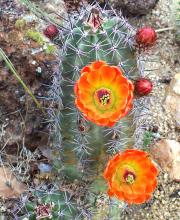
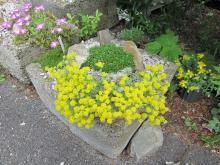
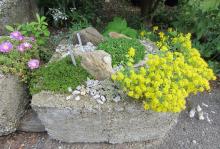
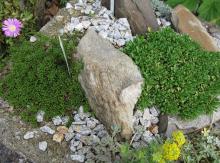
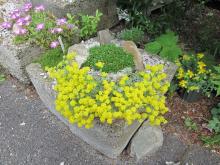
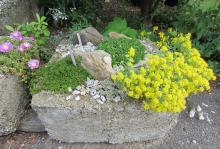
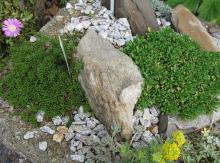
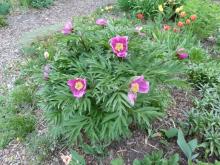
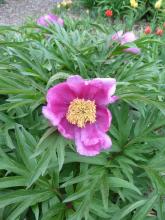
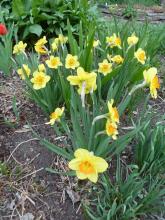
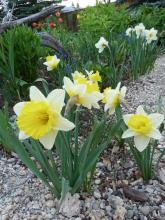
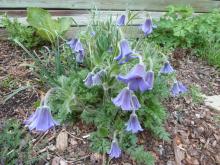
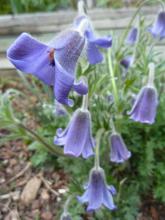
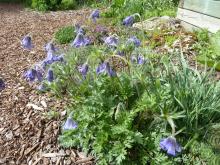
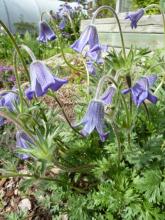
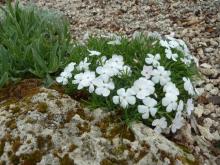
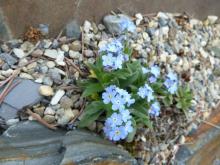
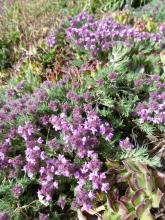
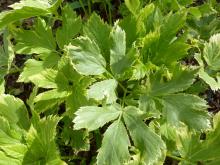
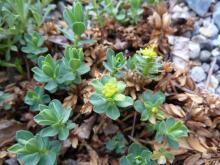
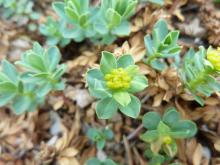
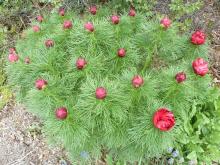
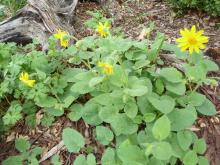
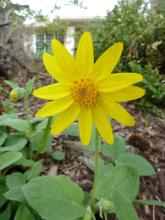
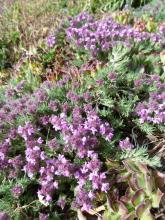
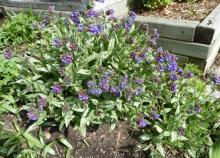
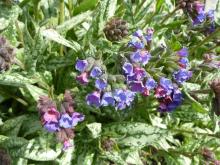
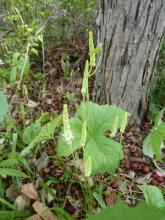
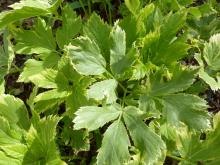
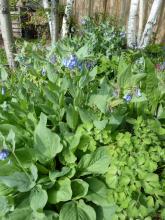
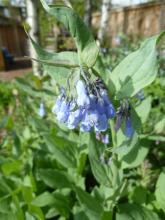
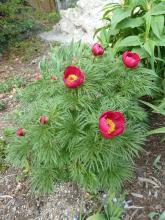
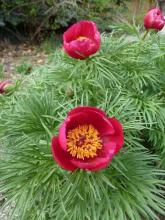
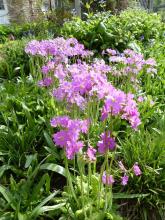
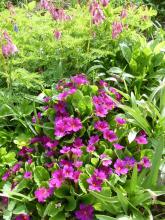
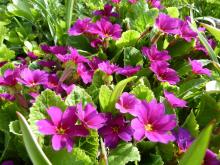
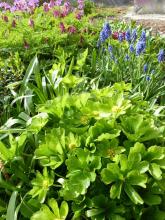
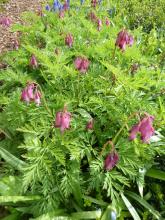
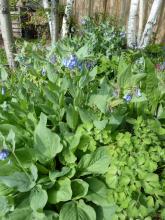
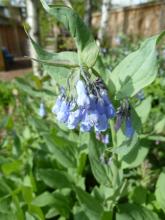
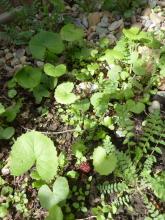
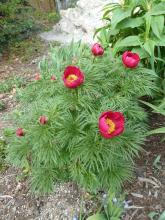
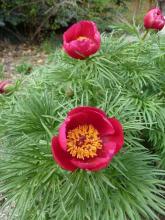
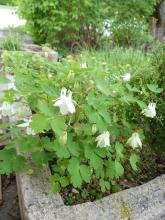
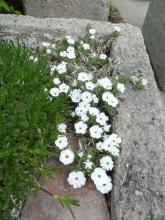
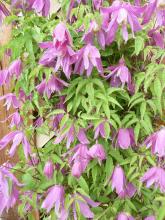
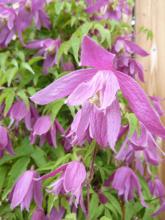
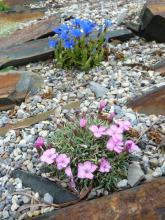
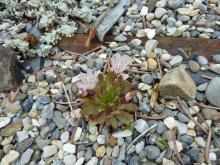
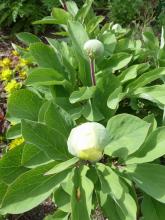
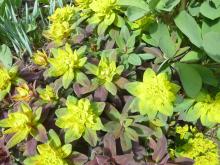
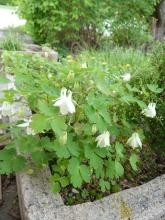
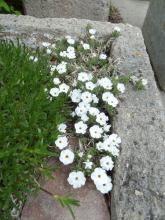
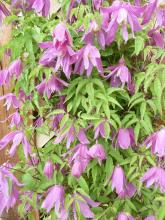
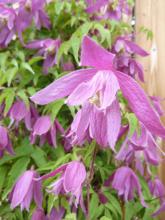
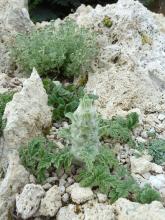
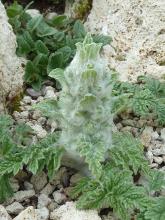
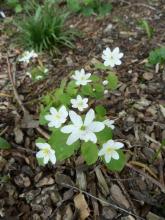
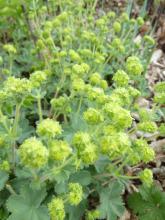
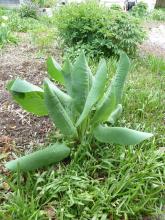
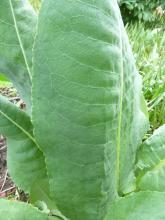
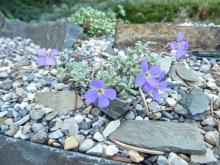
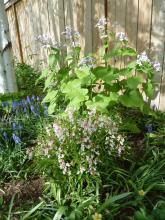
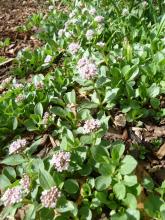
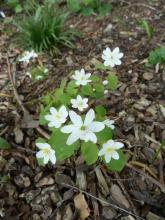
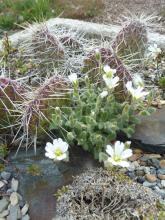
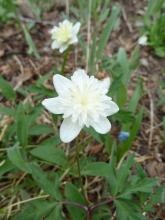
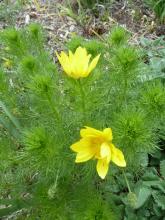
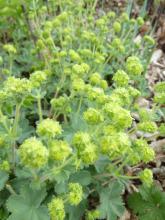
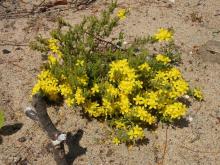
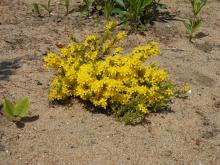
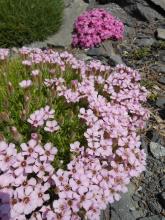

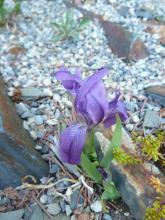
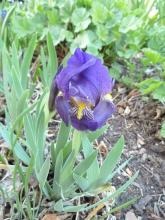
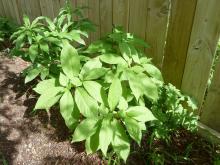
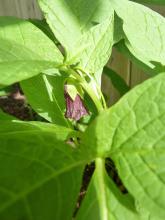
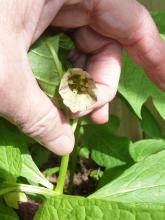

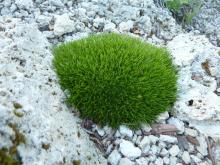
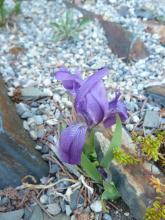
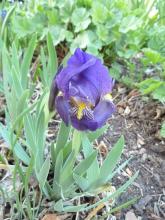
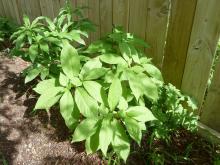
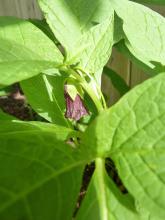
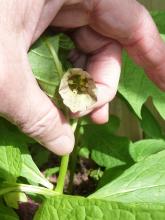
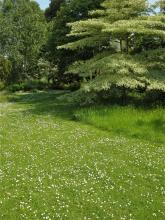
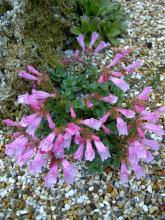
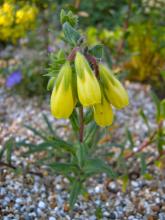
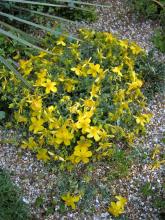
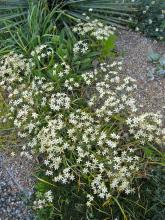
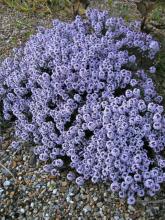
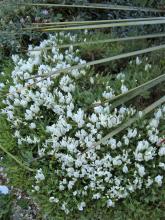
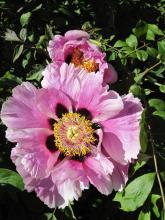
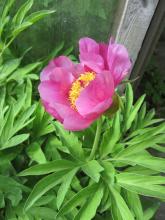
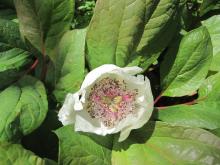
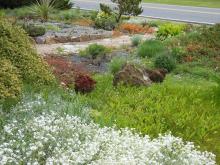
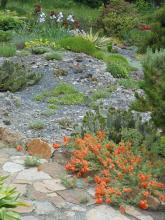
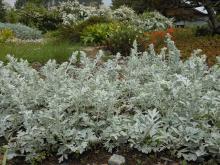
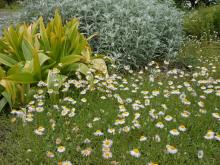
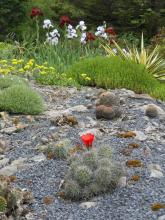
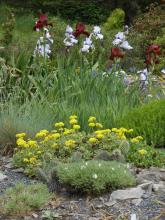
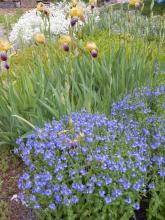
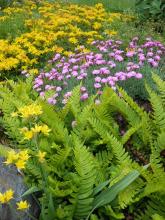
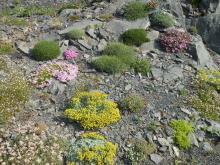
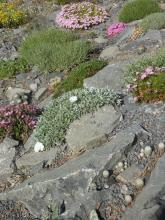
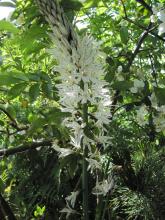
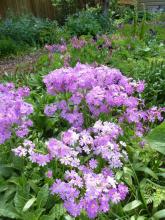
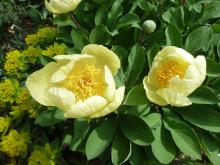
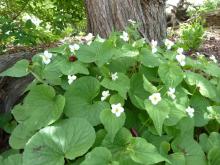
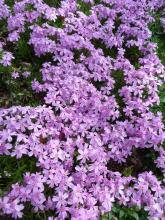
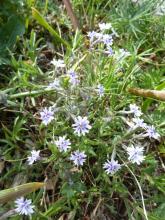
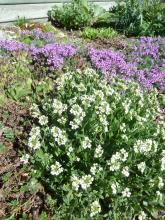
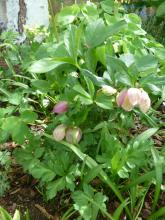
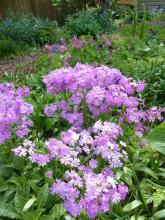
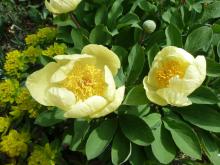
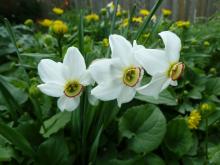
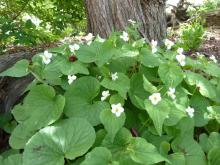
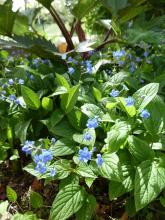
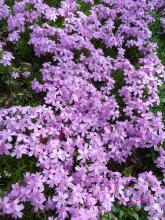
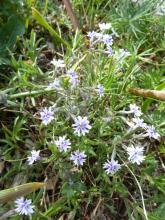
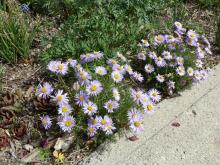
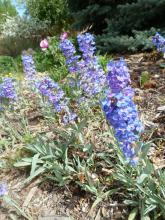
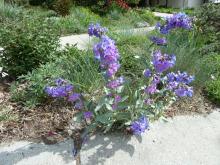
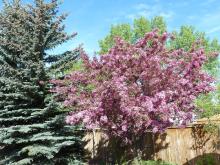
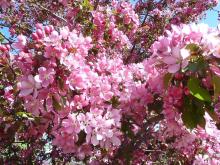
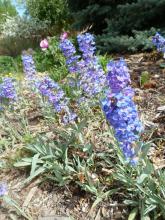
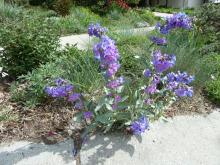
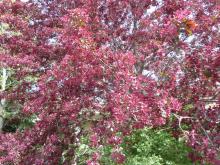
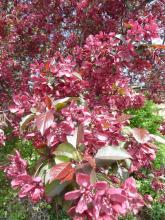
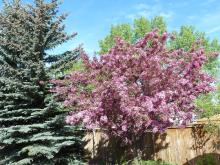
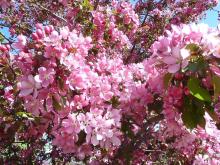
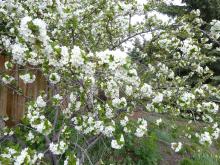
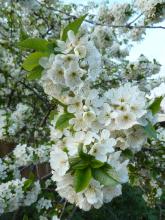
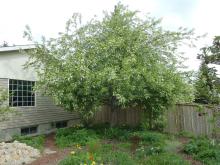
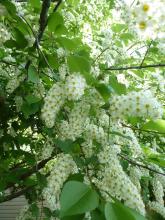
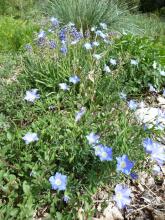
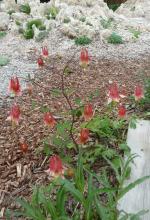
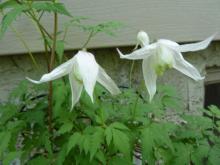
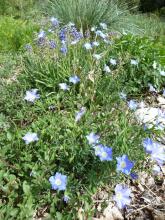
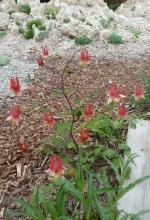
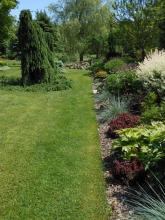
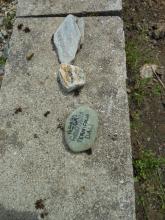
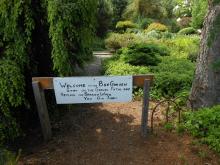
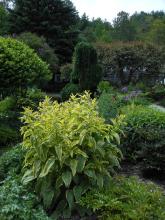
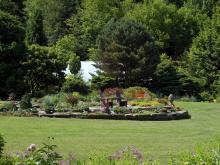
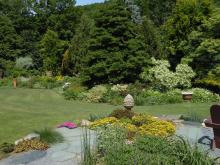
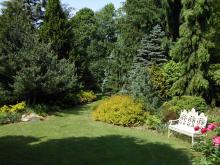
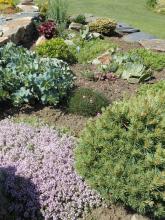


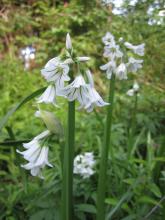
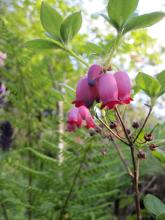
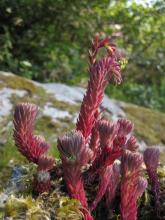
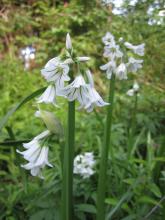
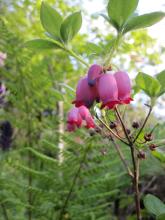
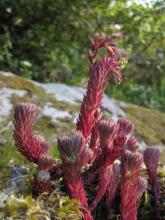
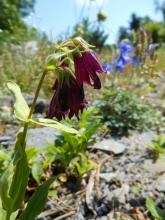
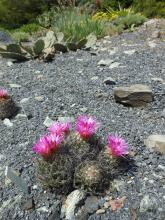
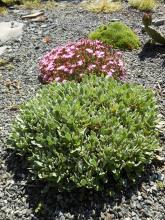
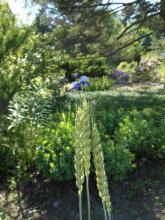
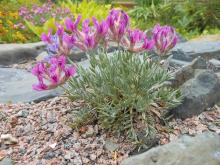
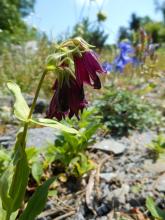
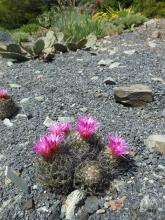
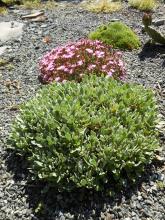
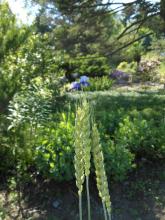
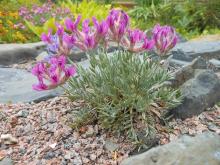
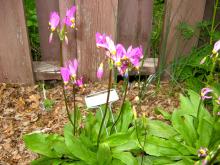
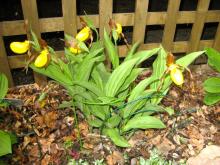
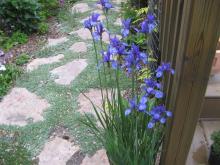
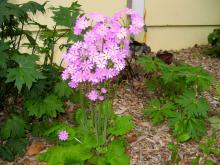
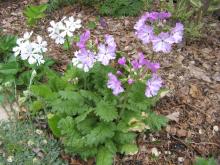
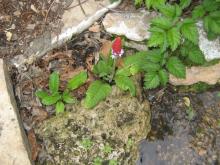
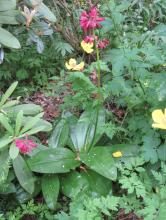
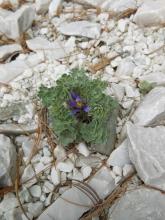
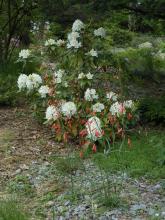
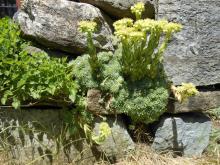
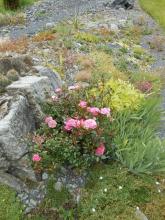
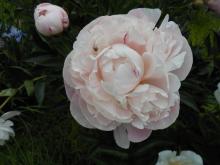
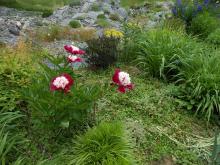
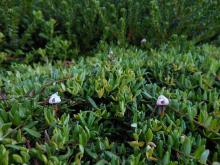
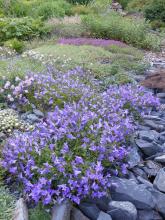
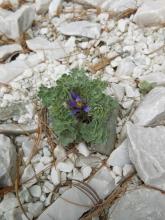
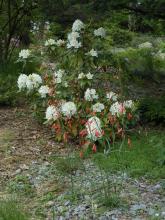
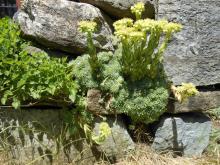
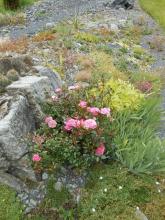
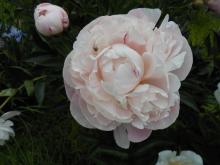
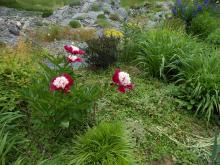
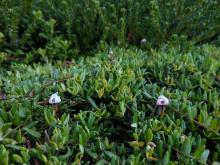
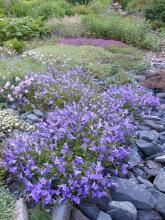
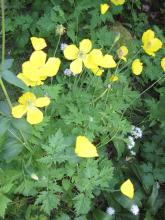
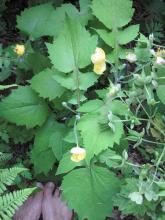
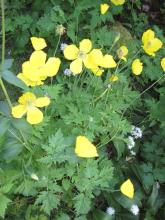
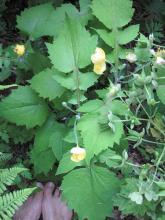
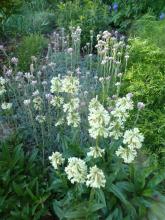
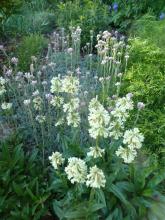
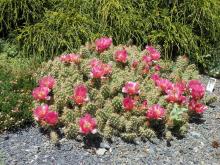
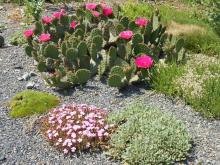
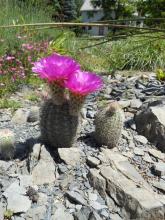
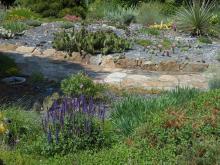
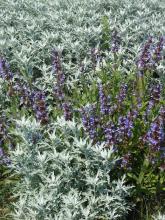
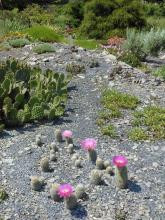
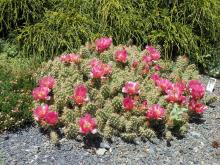
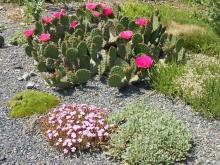
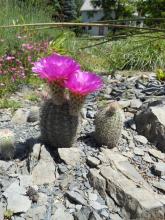
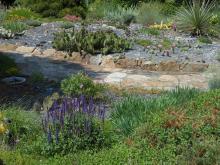
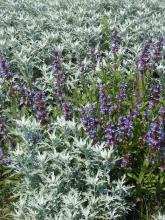
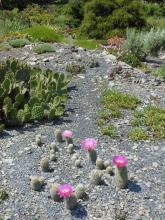
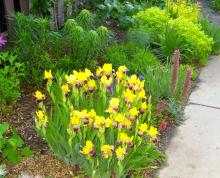
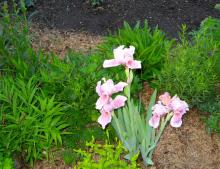
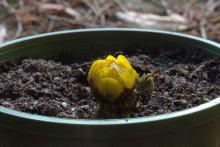
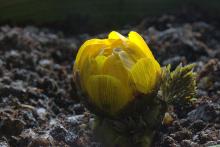
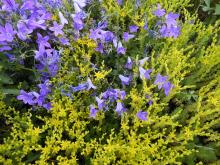
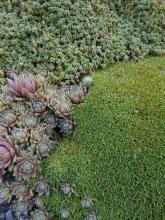
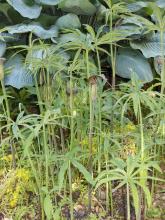
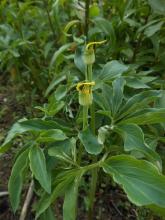
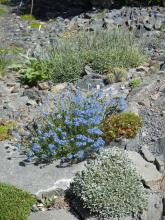
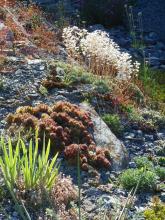
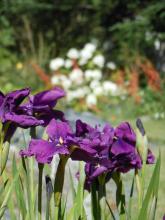
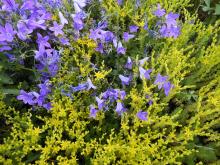
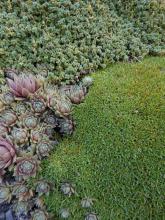
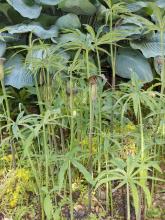
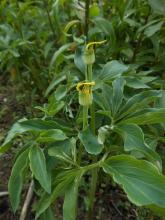
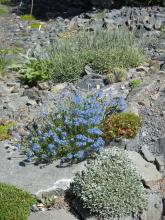
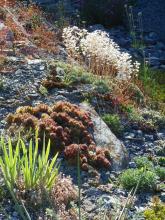
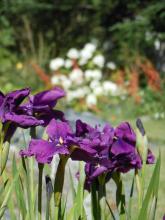
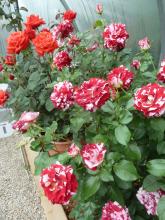
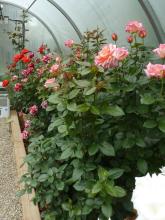
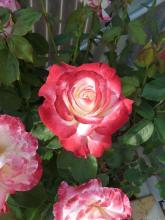
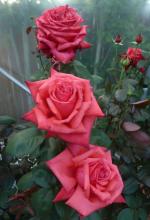
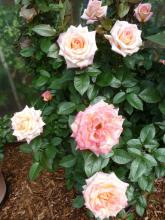
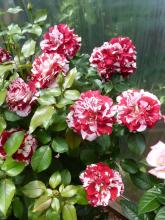
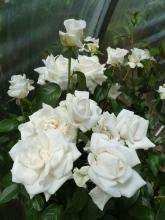
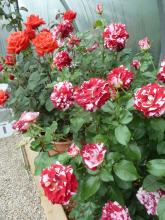
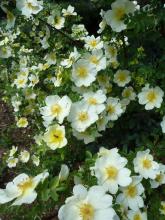
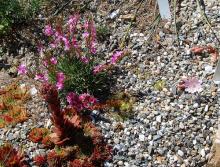
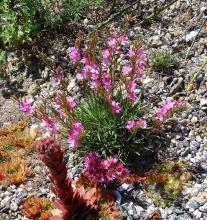
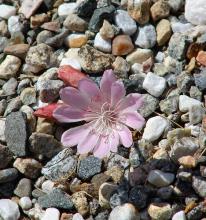
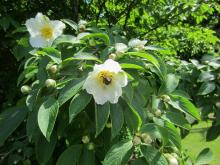
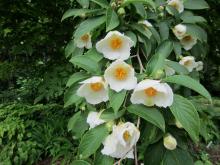
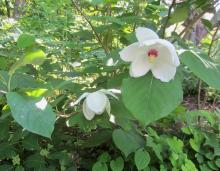
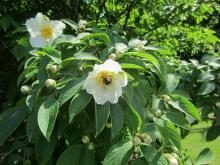
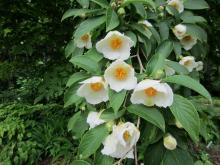
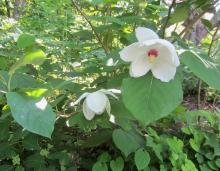
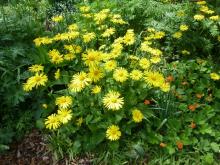
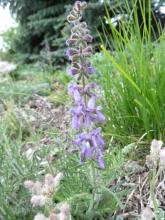
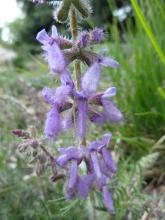
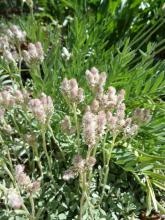
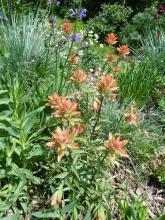
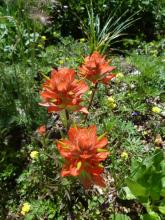
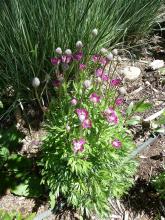
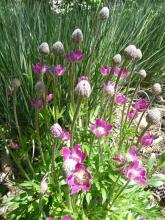
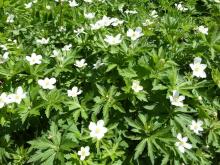
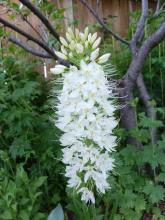
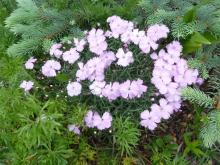
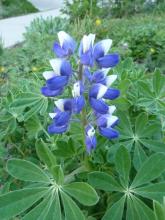
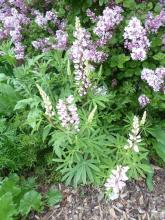
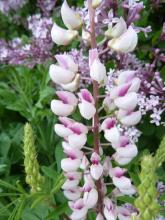
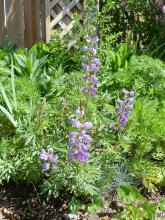
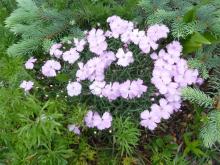
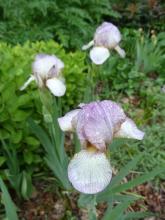
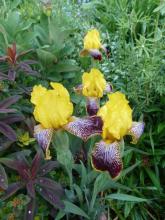
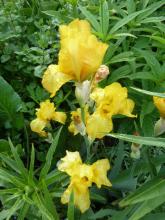
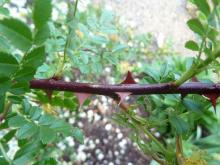
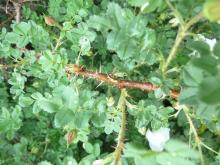
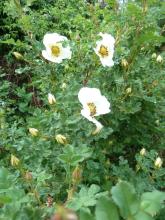
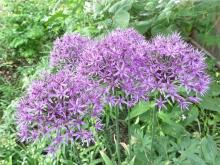
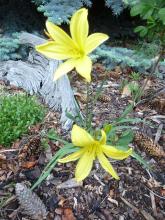
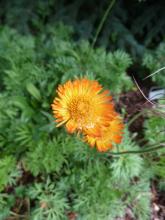
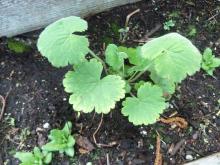
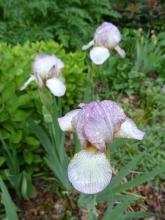
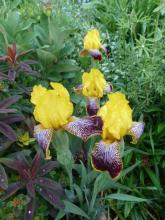
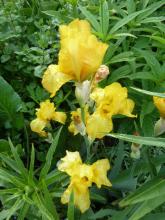
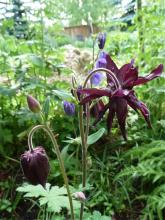
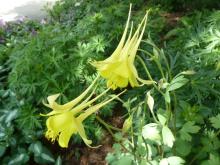
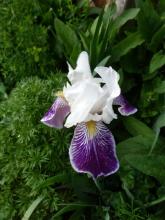
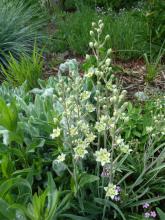
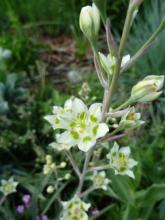
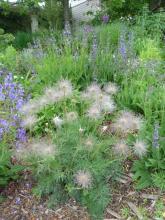
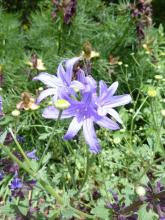
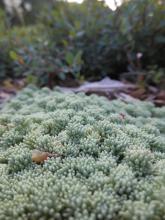
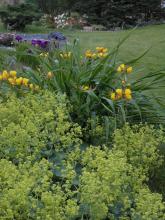
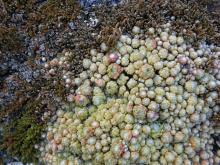
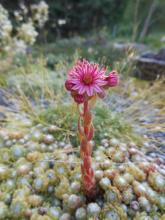
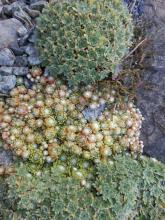
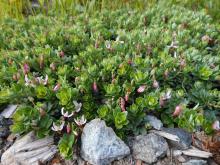
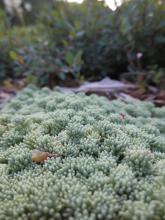
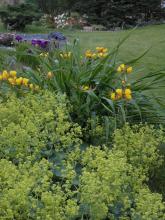
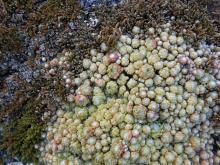
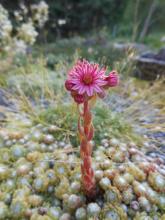
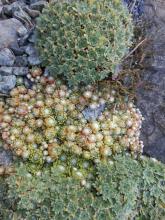
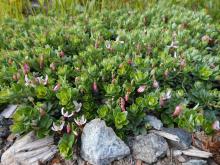
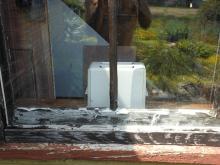
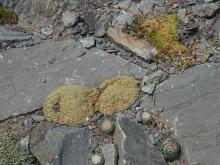
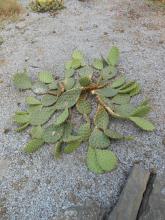
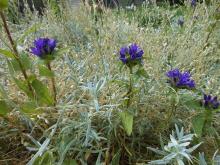
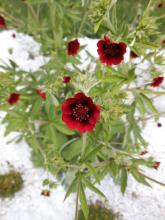
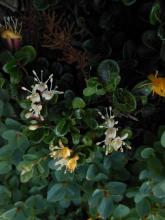
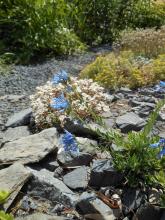
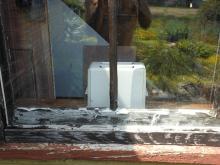
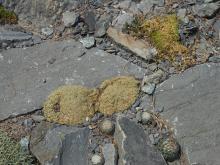
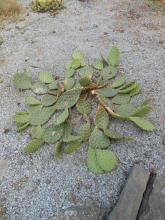
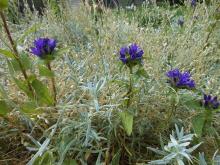
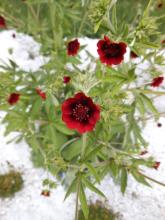
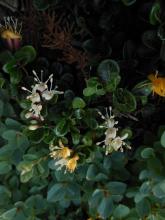
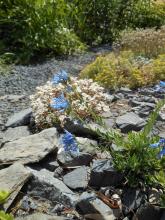
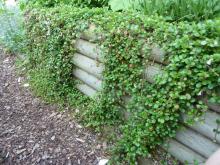
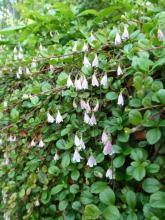
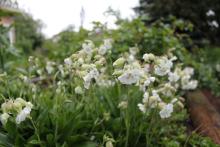






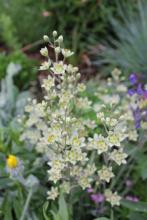



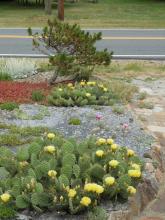
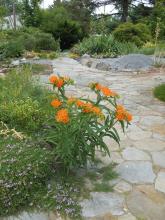
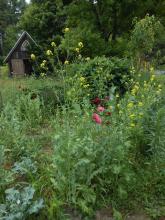
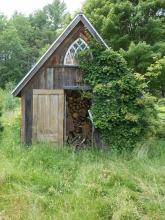
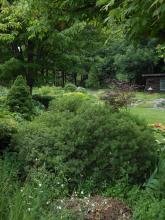
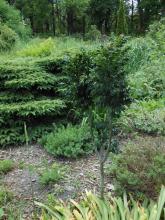
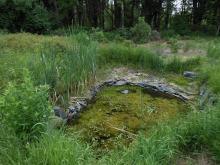
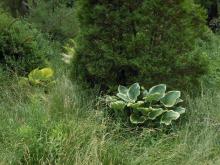
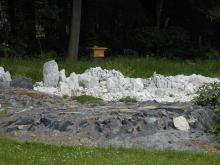
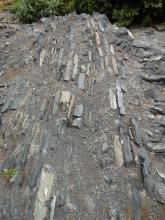
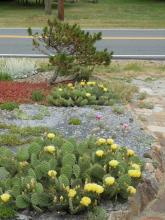
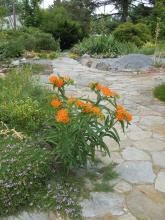
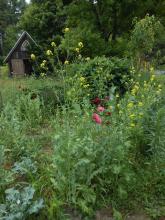
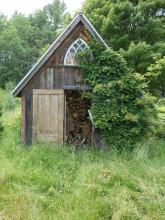
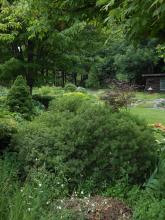
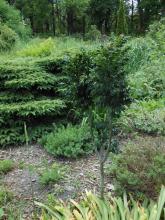
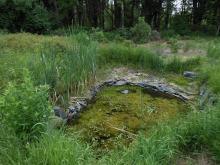
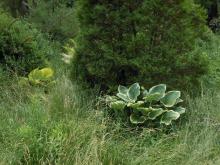
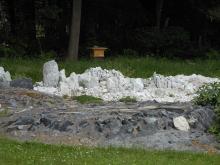
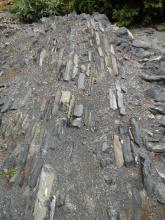
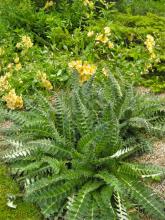
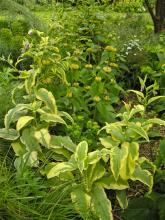
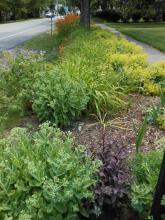
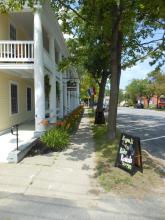



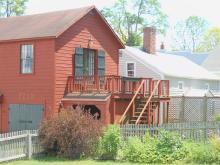
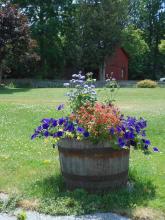


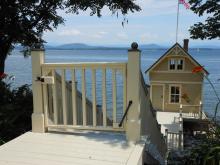
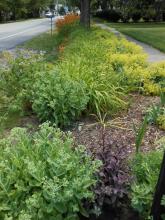
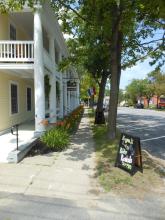



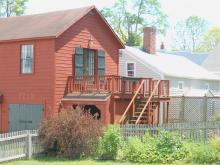
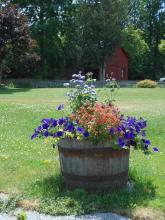


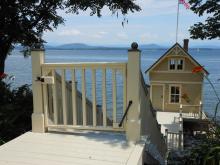
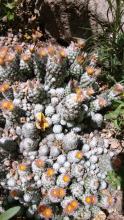
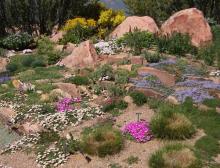
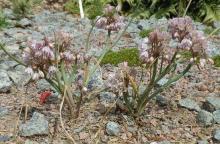
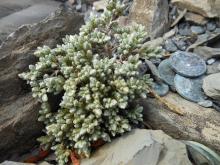
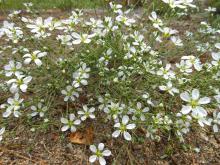
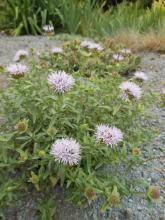
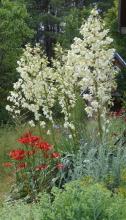
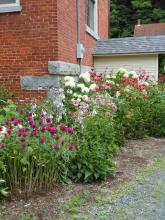
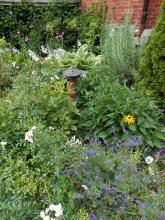
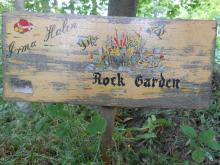
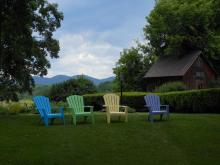

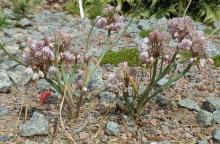
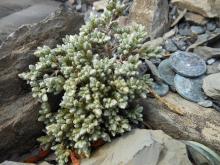
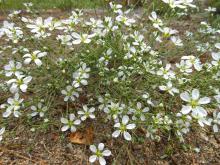
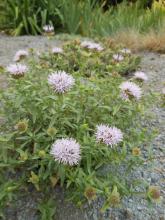
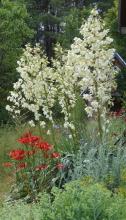

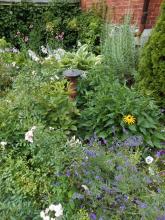
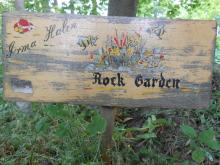
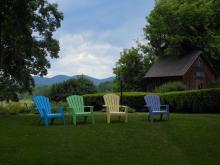

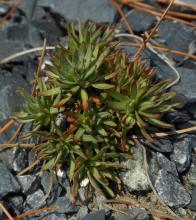
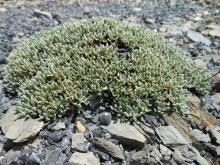
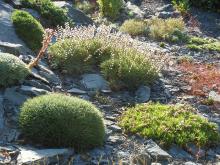
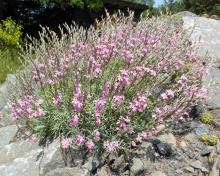
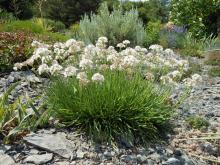
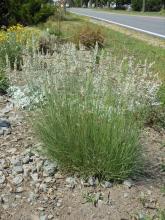
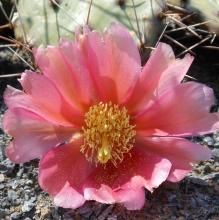
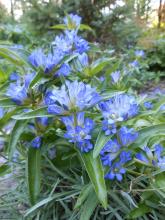
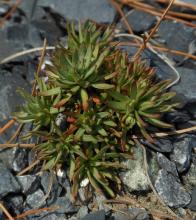
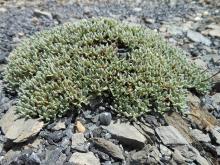
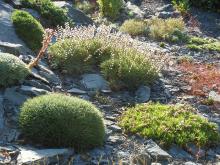
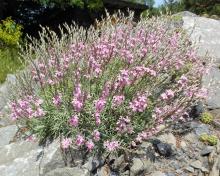
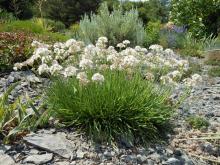
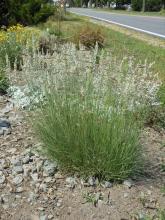
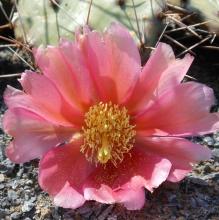
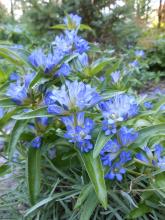
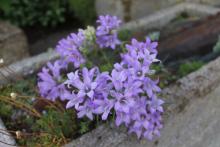
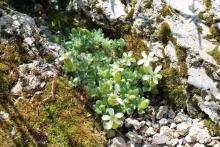






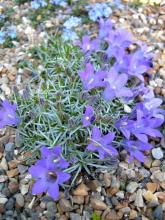
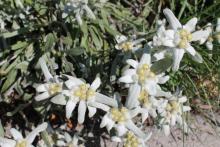
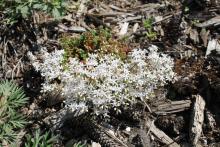
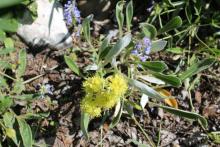










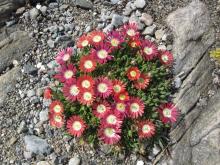
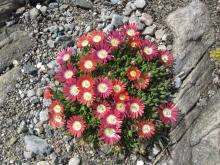
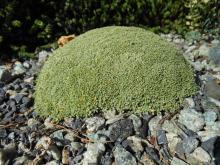
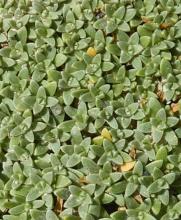
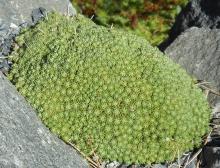
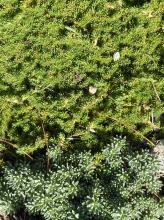
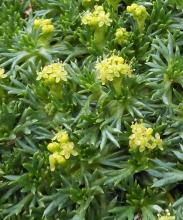
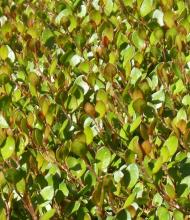
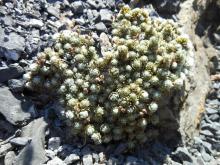
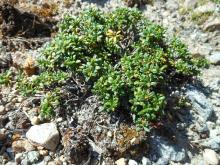
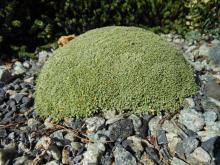
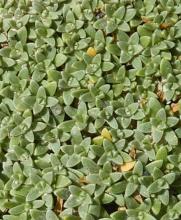
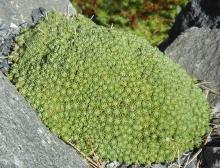
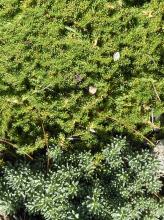
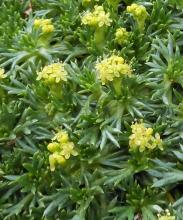
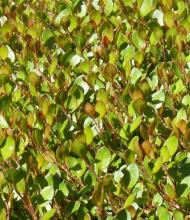
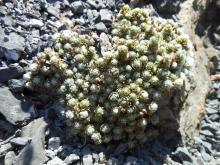
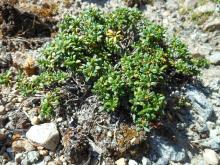
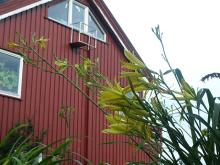
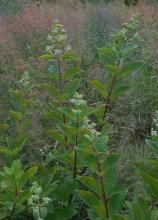
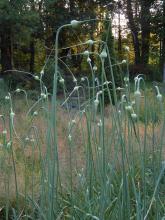
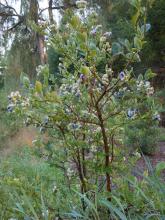



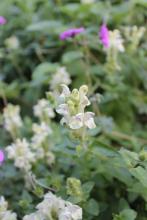




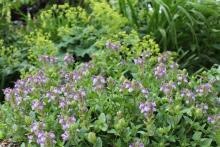

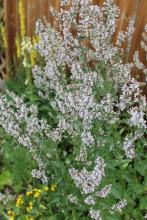
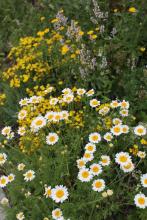










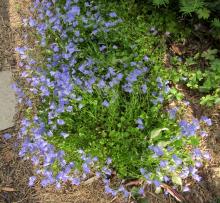
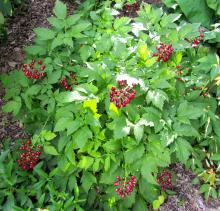
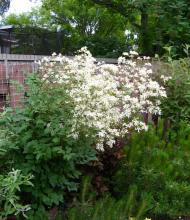












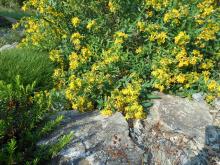
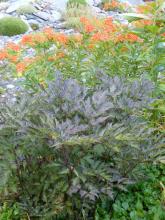
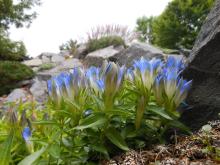
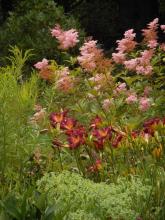
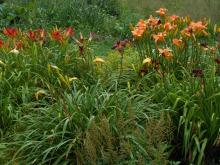
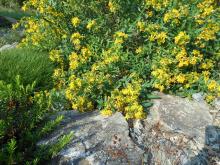
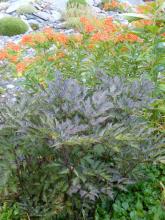
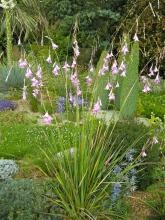
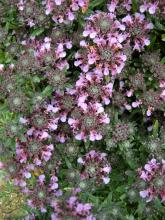
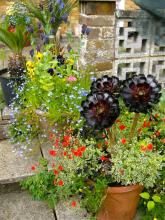
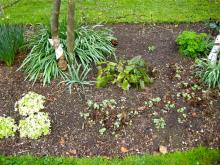
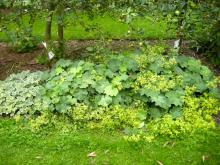
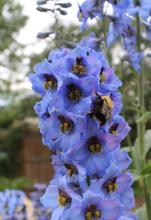
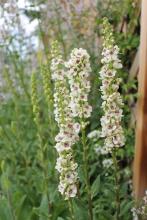
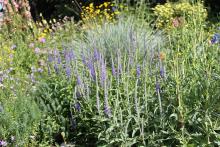
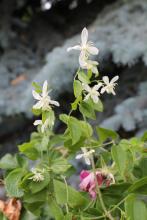
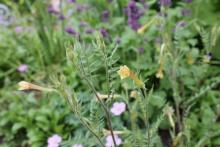










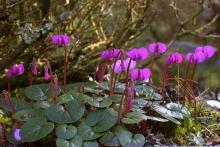






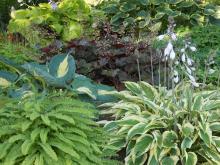
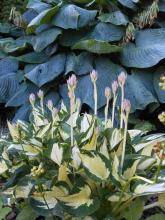
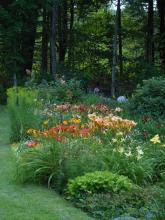
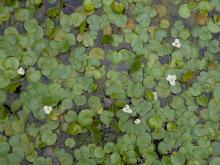
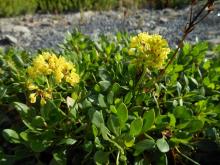
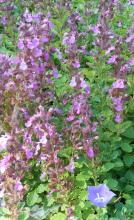
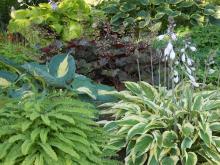
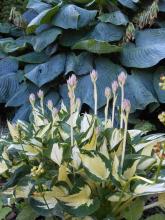
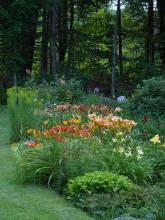
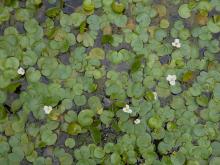
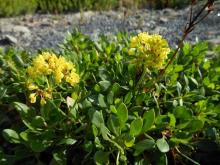
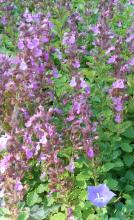









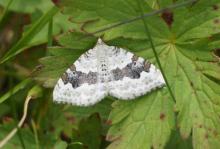
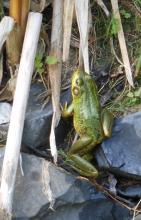
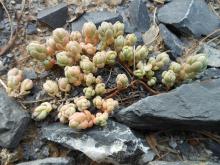
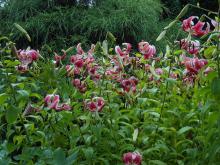
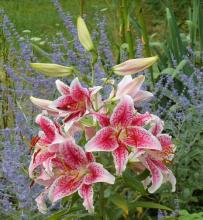
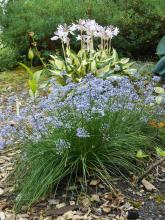
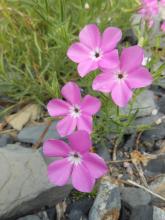
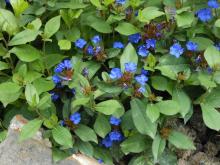
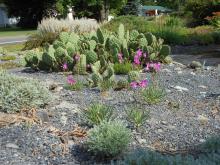
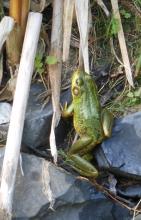
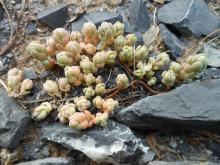
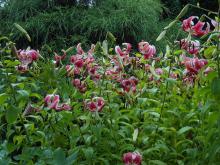





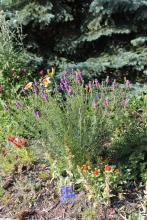
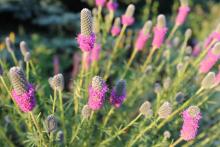
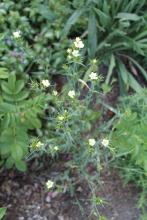
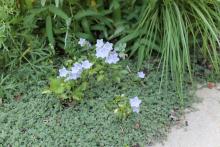
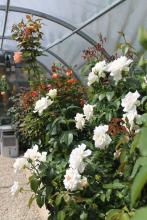









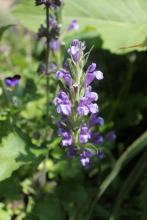
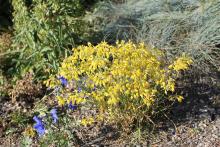
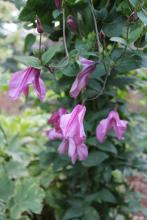
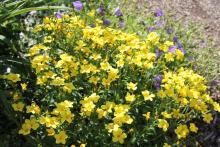
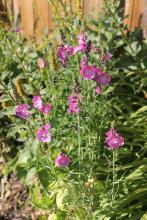






















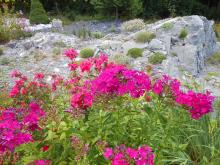
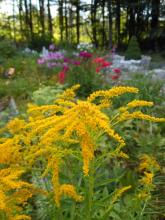
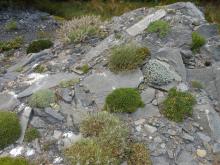
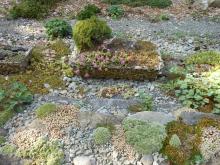
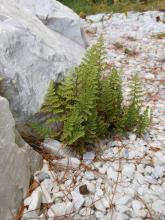
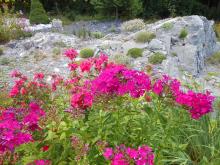
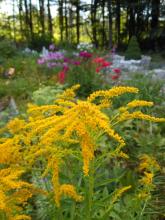
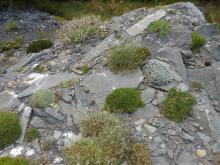
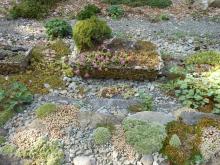
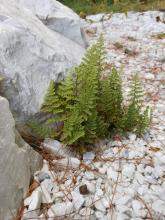
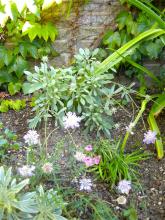
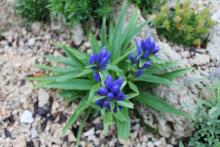
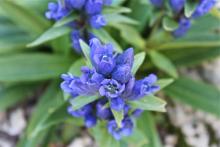
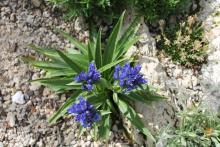



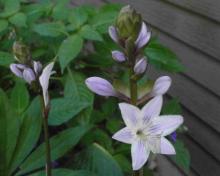
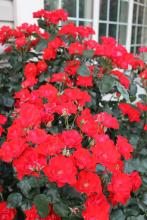
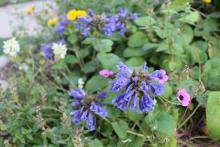





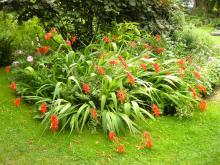

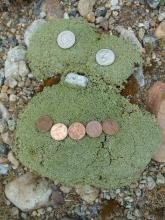
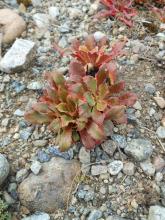
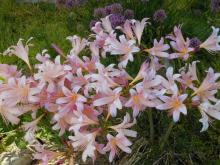
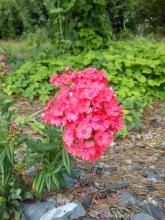
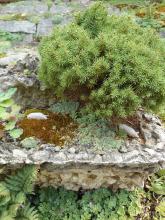
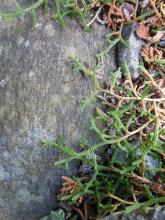
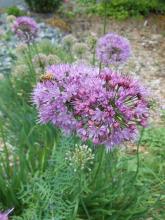
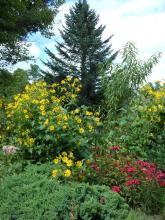

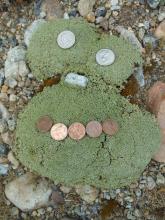
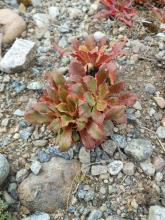
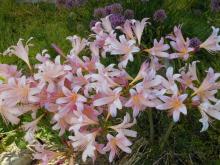
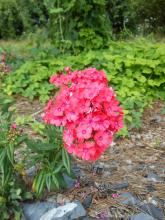
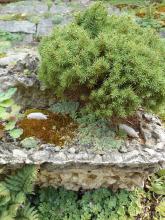
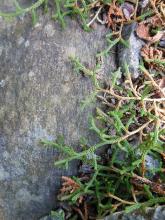
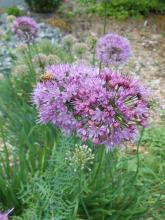
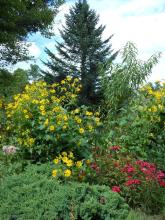
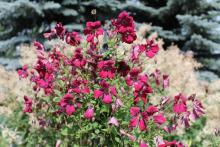










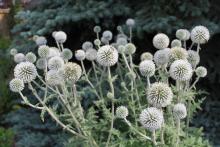






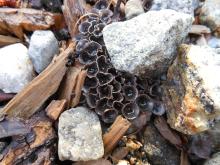
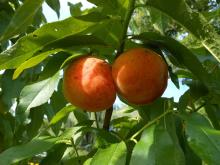
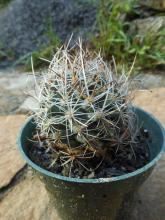

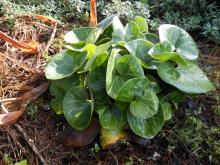
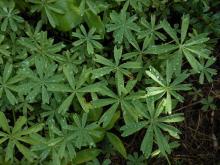
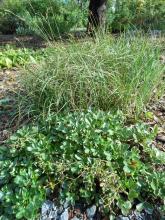
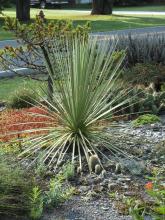


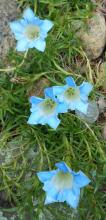
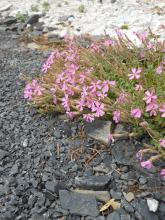
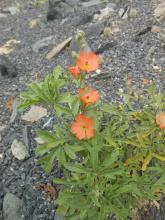
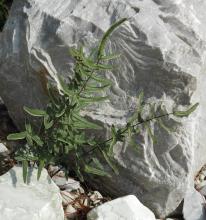
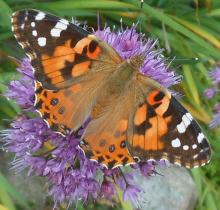
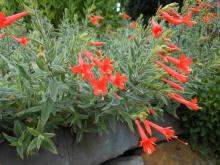
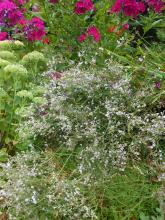
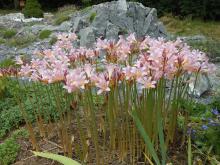
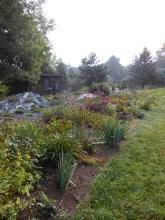
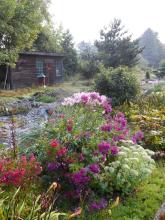
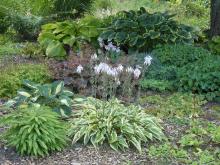
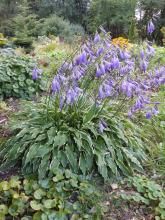
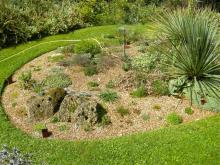
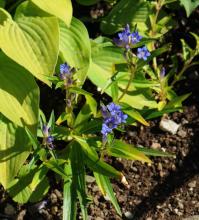
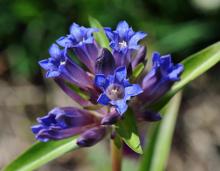
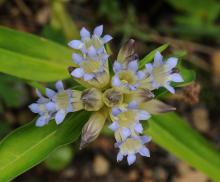
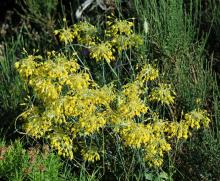
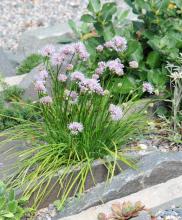
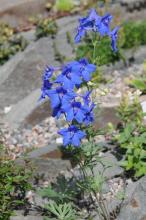
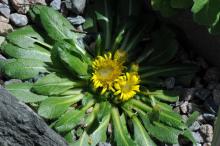
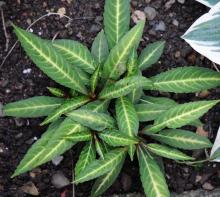
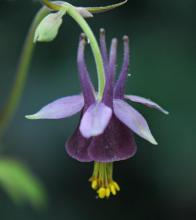
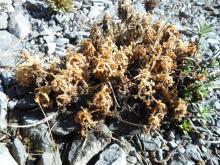
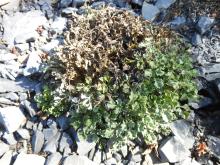
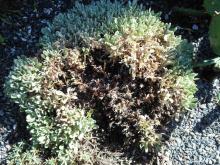
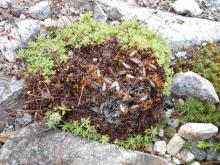
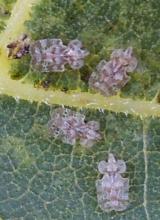
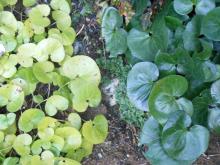
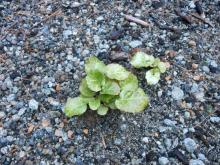
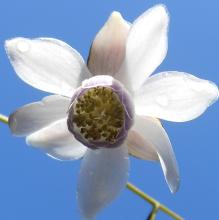
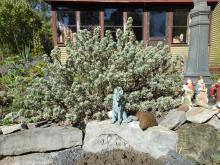
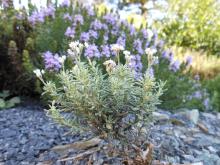
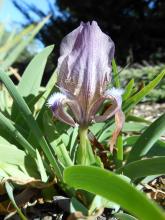
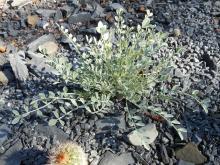
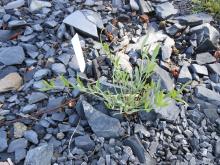
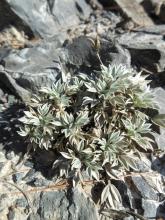
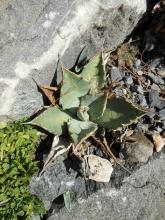
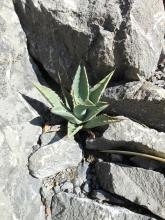
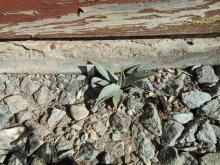
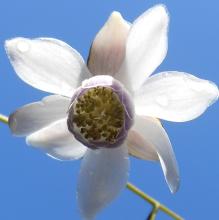
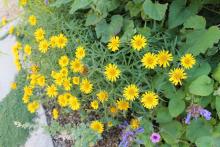
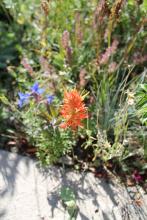
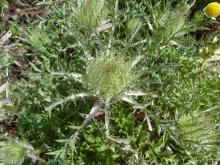









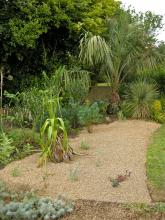
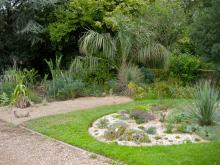
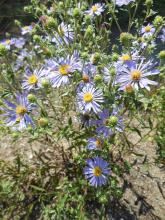
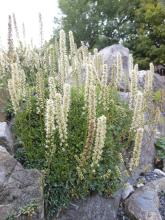
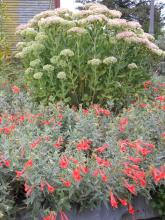
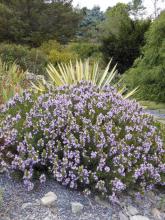
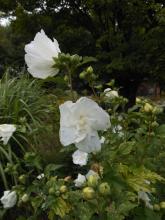
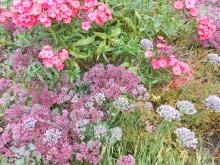
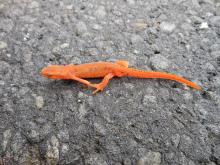
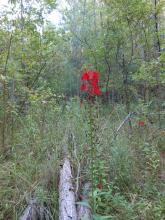
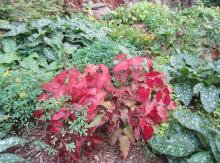
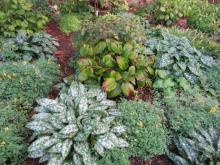
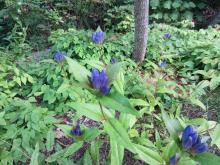
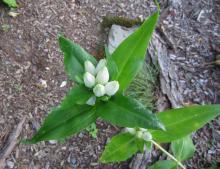
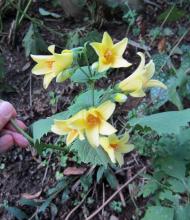
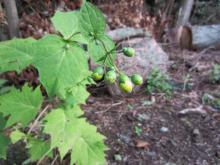
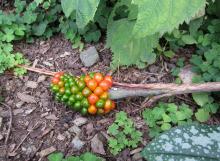
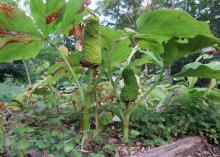
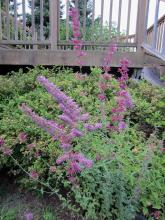
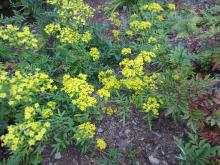
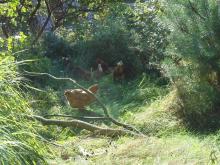
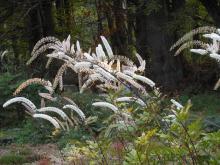
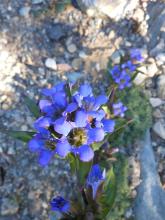
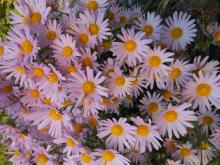
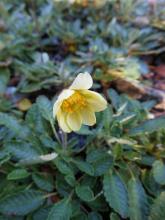
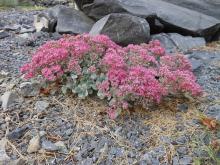
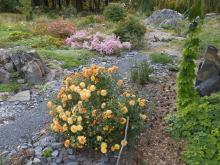
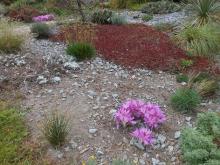
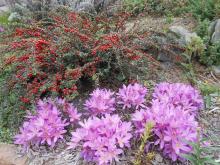
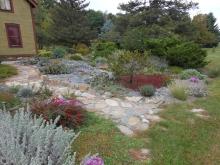
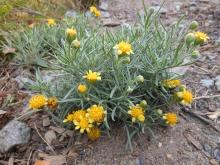
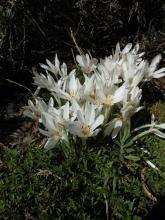
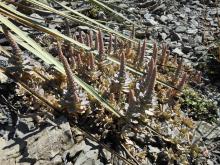
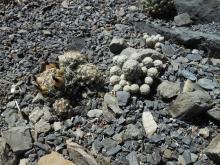
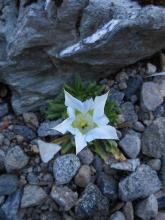
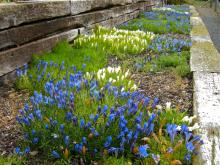
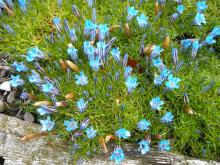
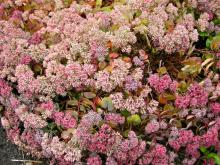
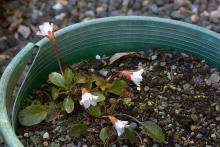
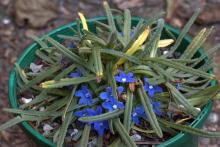




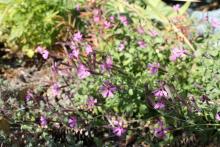

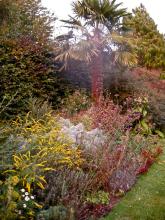
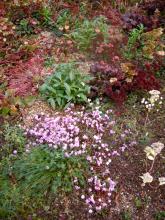
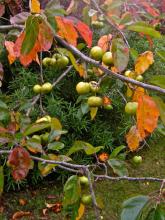

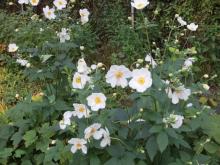
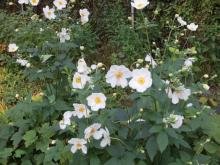

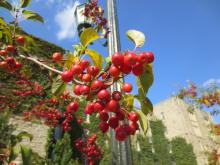
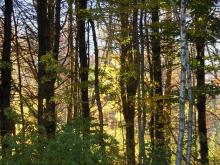
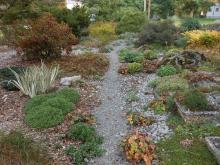
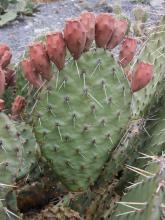
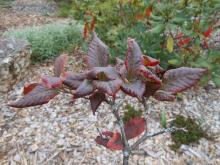
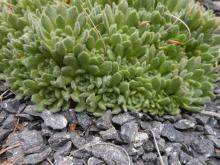
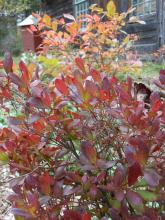
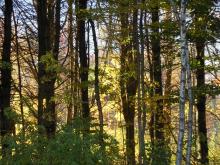
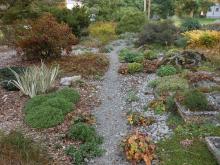
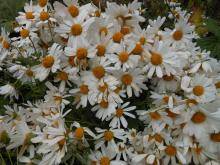
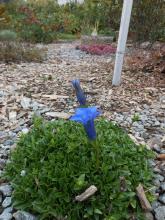
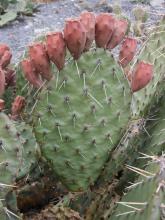
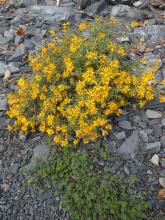
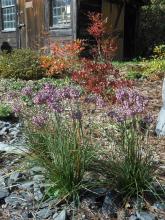
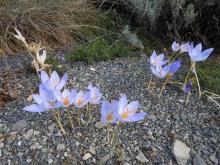
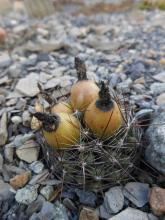
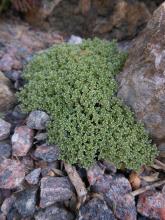
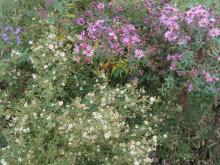
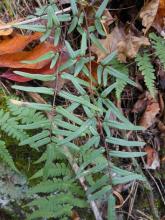
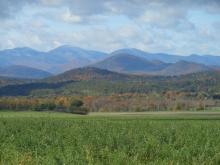
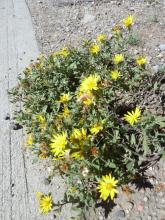
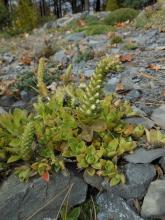
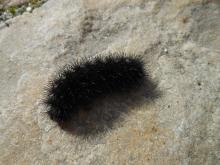
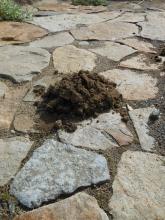
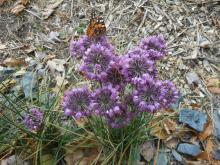
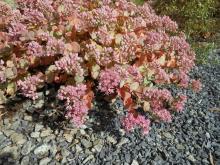
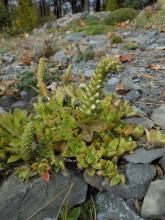
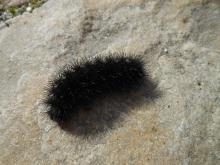
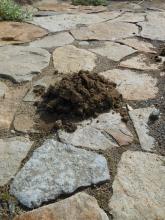
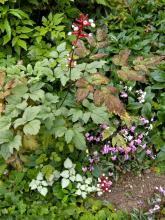







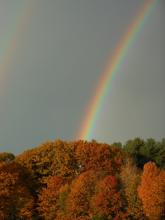
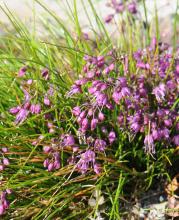
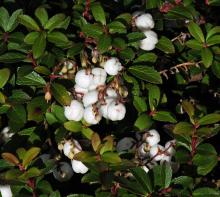
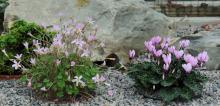
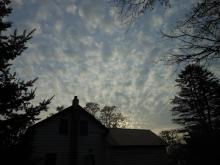
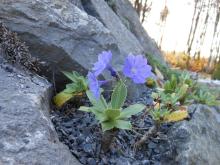
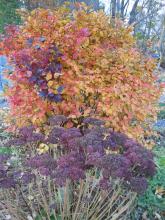
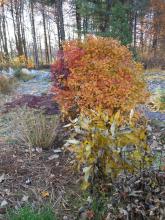
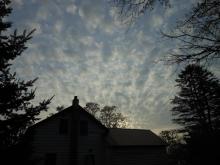
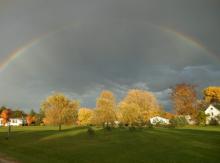
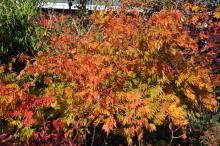
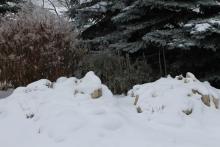

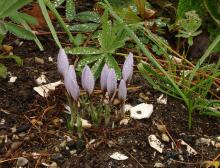
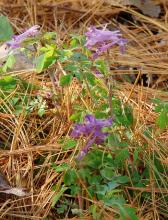
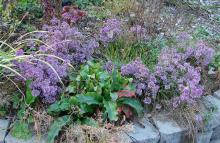

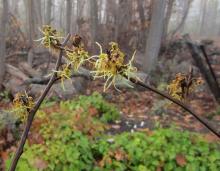
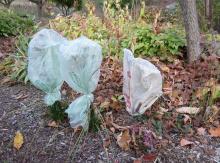
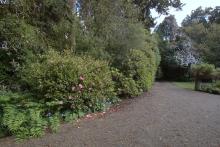
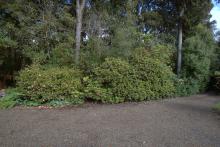
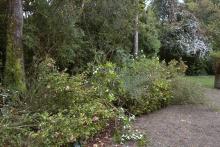
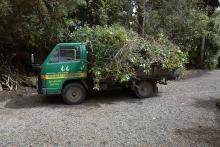
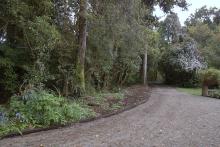
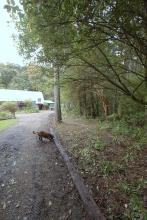
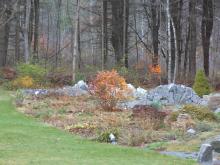
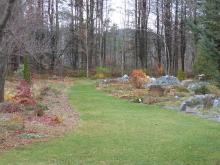
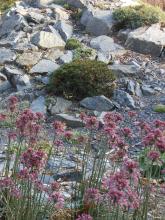
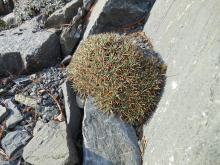
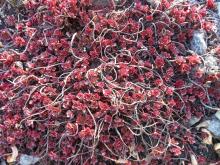
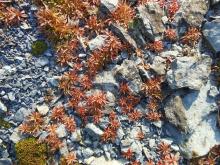
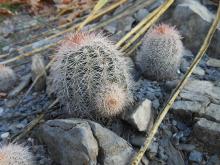
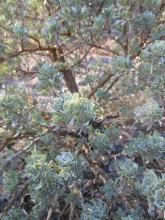
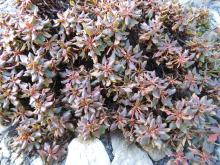
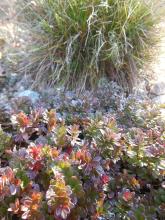
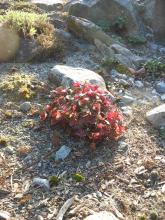
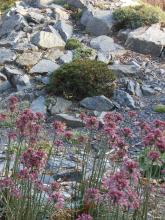
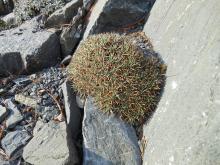
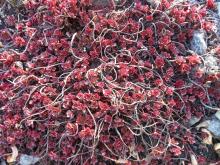
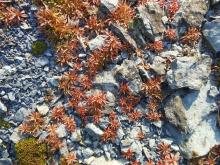
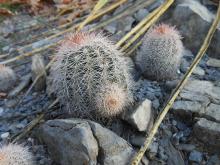
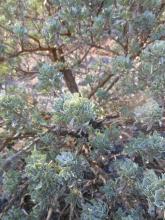
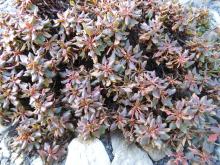
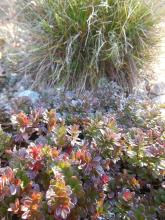
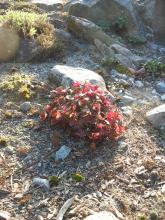
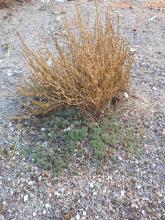
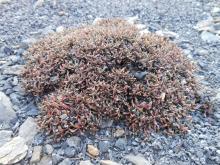
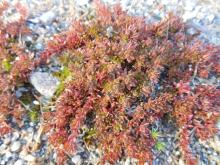
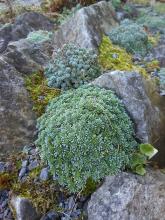
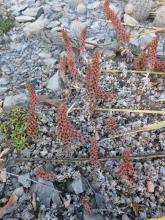
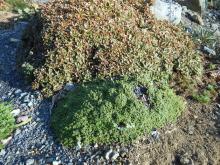
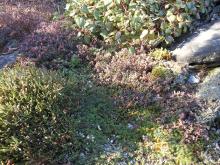
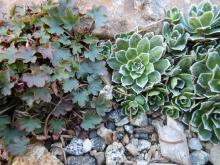
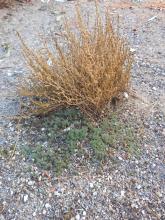
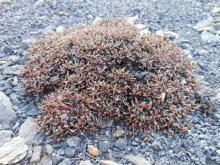
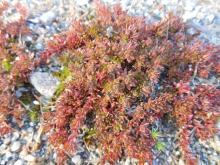
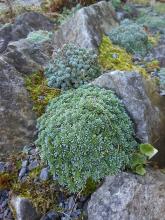
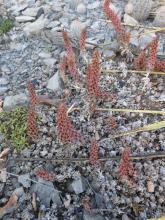
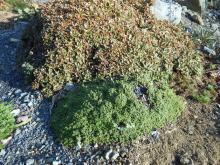
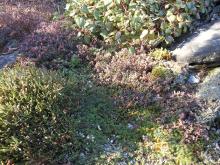
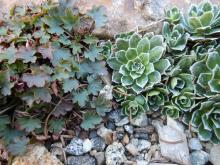
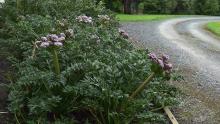
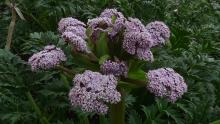
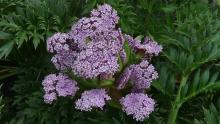
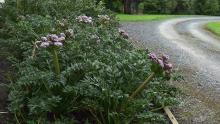
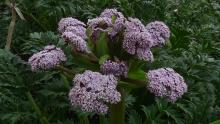
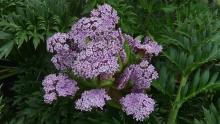
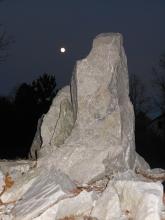
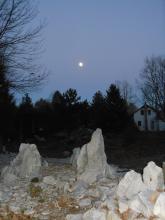
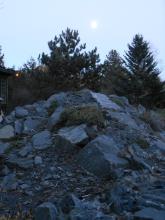
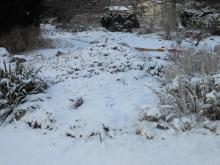
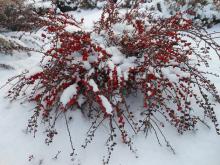
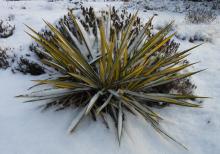
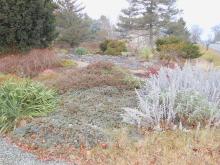
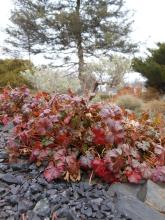
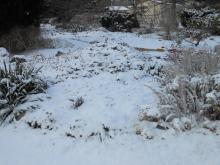
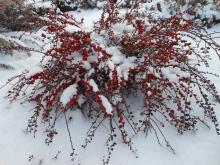
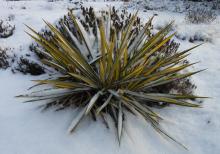
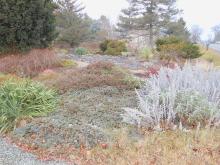
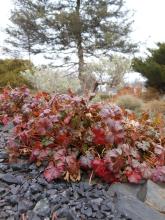
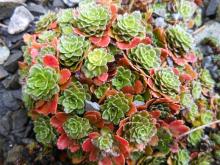
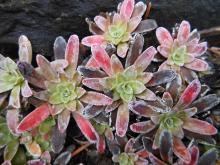
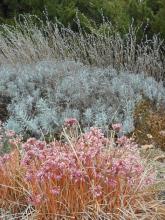
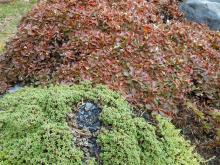
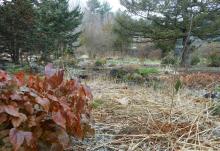
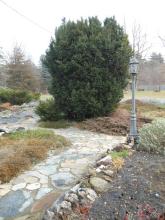
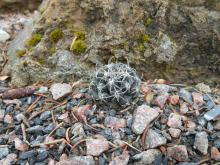
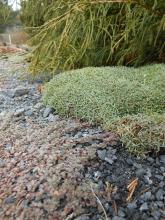
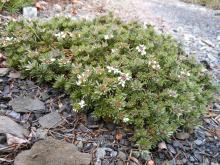
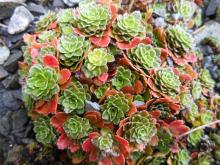
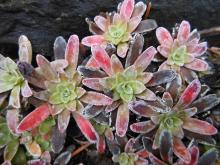
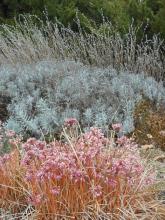
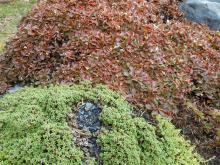
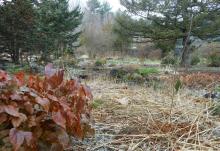
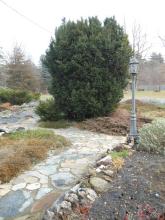
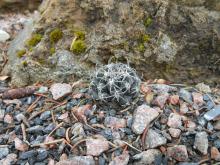
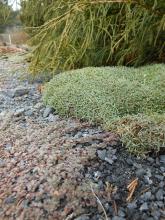
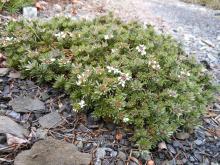
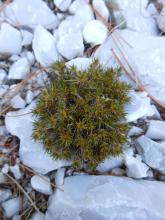
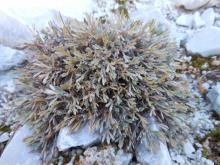
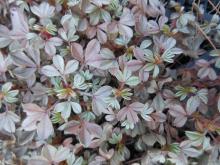
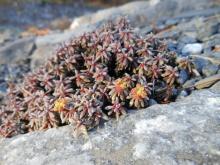
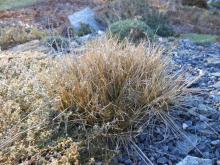
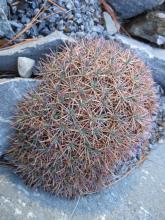
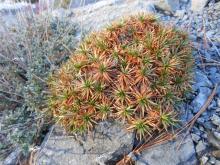
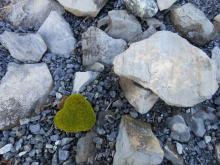
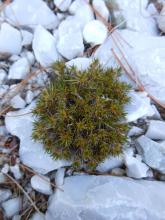
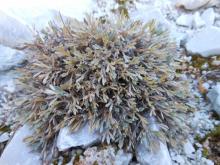
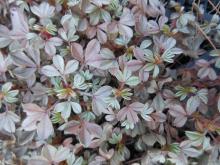
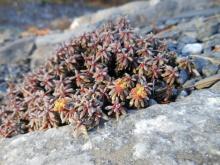
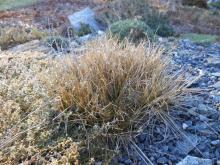
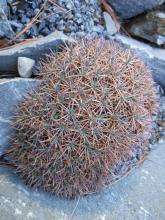
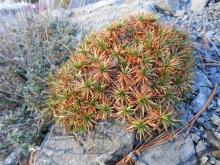
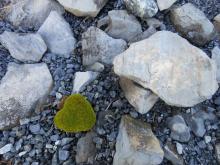
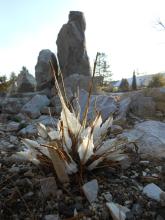
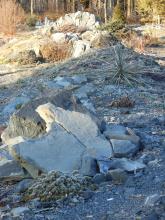
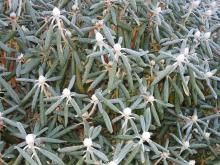
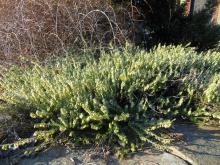
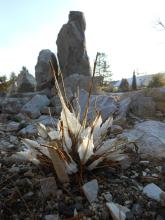
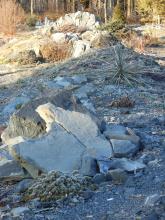
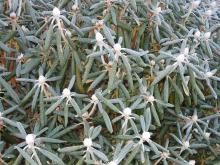
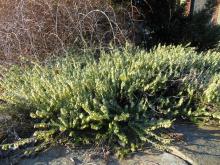
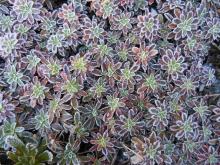
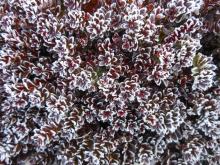
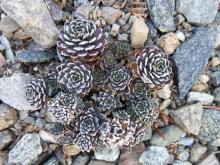
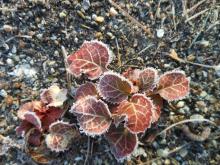


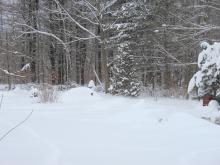
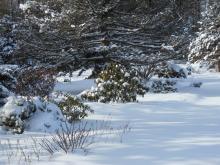
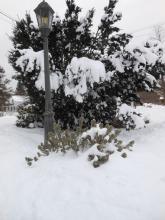
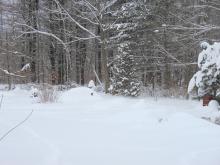
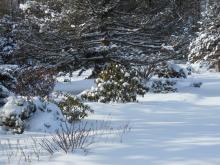
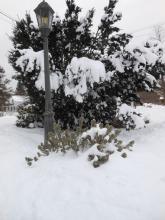
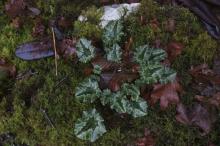
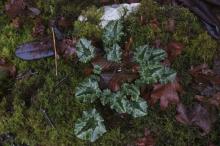
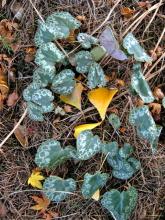
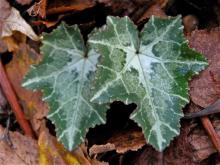
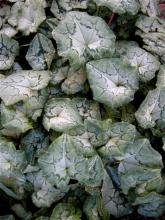
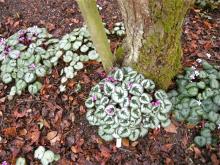
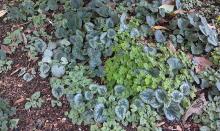
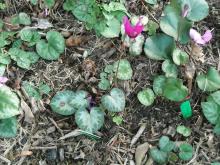
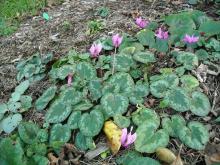
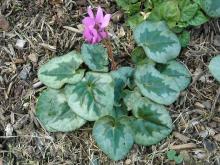
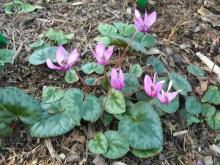
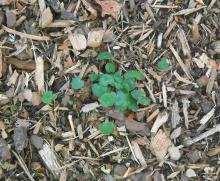
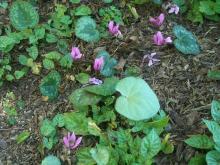
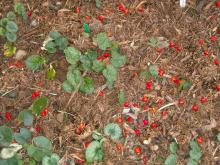
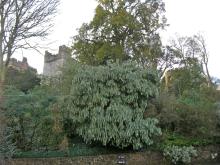
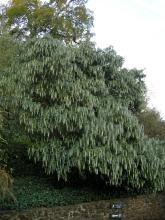
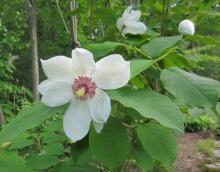
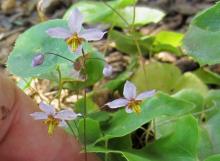
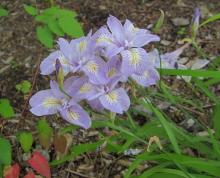
Especially vibrant cyclamen leaves, Tim!
I thought those were water droplets on the corydalis leaves, but googling shows my error: http://www.perennials.com/seeplant.html?item=1.167.580
Very impressive!
A friend showed me a corydalis with similarly shaped green leaves in an old botany professor's yard. (I don't remember it having that cool dotting, though.) The man doesn't remember what it is. I saw it out of bloom last year, and I remember saying to my friend: "You saw it blooming and you're sure it is a corydalis?" That corydalis (and the rest of the yard that includes one of the heavily divided leaf hellebores sp.) is on my slate for investigation this spring...